Derek Dean's resolve in the compilation of this page with no prospect of financial gain, just the satisfaction of being involved, tells you a great deal about the man. The same can be said for every single contributor to this site, of couse....I take my hat off to everyone involved, for this site would be a lot poorer without them. In Derek's case, the task of recording the individual histories of the 'Britannia' class locomotives has been a mammoth undertaking, and there have been times when the pair of us - just two bungling old geezers with a mutual love for trains and railways - were on our arthritic knees by the sheer size of it all. So my hearty congratulations to him in completing the full histories of the following locomotives on this page...
70000 BRITANNIA - 70001 LORD HURCOMB - 70002 GEOFFREY CHAUCER - 70003 JOHN BUNYAN - 70004 WILLIAM SHAKESPEARE - 70005 JOHN MILTON - 70006 ROBERT BURNS - 70007 COEUR-DE-LION - 70008 BLACK PRINCE - 70009 ALFRED THE GREAT - 70010 OWEN GLENDOWER - 70011 HOTSPUR - 70012 JOHN OF GAUNT - 70013 OLIVER CROMWELL - 70014 IRON DUKE- 70015 APOLLO - 70016 ARIEL - 70017 ARROW - 70018 FLYING DUTCHMAN - 70019 LIGHTNING - 70020 MERCURY - 70021 MORNING STAR - 70022 TORNADO - 70023 VENUS and 70024 VULCAN. Please note Nos 70025-70054 are featured on the next page.
Born in 1946, Derek started train spotting with his brother Roger at the now-closed Monument Lane station, Birmingham, where he fondly remembers the '1 o'clock Brit' on the 9.30am Manchester-Birmingham, usually
 worked by 70004 William Shakespeare. As he grew older he became a regular visitor to the Western Region's Snow Hill and New Street on the London Midland Region.
worked by 70004 William Shakespeare. As he grew older he became a regular visitor to the Western Region's Snow Hill and New Street on the London Midland Region. Since taking early retirement as a HGV Mechanic in 2005, Derek's knowledge of all things power-driven led him to making a start on correcting the many anomalies he found in books and magazines regarding the BR Class 7MT Britannias. His research has taken him more than 3 years, and I was pleased he agreed to pass on his findings here.
 However, Derek's main reservation was that, whilst the first group of Britannias are indeed very interesting, and in some cases diverse, the third batch of engines are somewhat mundane by comparison, and so whilst he felt confident of filling a page with information on say, Nos 70000-70024, it would be tricky to give the same result with 70045 to 70054. This is because the list of modifications diminished as they were put into the
However, Derek's main reservation was that, whilst the first group of Britannias are indeed very interesting, and in some cases diverse, the third batch of engines are somewhat mundane by comparison, and so whilst he felt confident of filling a page with information on say, Nos 70000-70024, it would be tricky to give the same result with 70045 to 70054. This is because the list of modifications diminished as they were put into the  building programme and only half of these changes were required on later batches. Nevertheless there are many more photos of these later builds, primarily because enthusiasts began to realise that extinction was on the horizon, so perhaps the additional photos will remedy the imbalance. I'm sure his meticulous research will become a valuable source of reference on the Internet...
building programme and only half of these changes were required on later batches. Nevertheless there are many more photos of these later builds, primarily because enthusiasts began to realise that extinction was on the horizon, so perhaps the additional photos will remedy the imbalance. I'm sure his meticulous research will become a valuable source of reference on the Internet...Upon nationalisation of the 'Big Four' railway companies in 1948, the Railway Executive of the British Transport Commission (BTC) announced its preference for developing future steam motive power rather than dabbling with unproven diesel traction. This led to the Locomotive Interchange Trials of 1948, supervised by RA Riddles, then member of the BTC's Railway Executive, who, along with ES Cox was responsible for the design and construction of twelve new classes to be numbered in the 70-80,000s and 92,000s in the fleet. In 1951, the 'Britannia' Class 7MT Pacific became the first of twelve new British Railways Standard types to appear. Designed at Derby and built at Crewe, with sections designed at Brighton, Doncaster and Swindon, the basic ethos was simplicity in construction, lower coal consumption, and longer mileage between classified repairs.

The naming of steam locomotives is a fascinating subject both historically and in the general sense, since it tells us a great deal about changing attitudes; this is especially the case when you consider the diversity of the names selected today.
Harking back to the 'Big Four' railway companies, the names then chosen were based on their potential value in terms of publicity and in the creation of a favourable image to the travelling public. A good example of this was the naming of the first Stanier 5XP 'Jubilee' locomotive, No 5552, which was turned out in a gloss-black livery with chromium-plated brightwork and named 'Silver Jubilee' to commemorate the Silver Jubilee of King George V and Queen Mary in 1935. The remaining members of the class were named after countries belonging to the British Empire, followed by celebrated naval heroes and famous Royal Navy ships, including No 45700 which was originally named 'Britannia' after HMS Britannia, one of six ships of the Royal Navy to have borne the name 'Britannia'; indeed the famous Naval Shore Establishment at Dartmouth was named 'HMS Britannia Royal Naval College' until its name was changed to HMS Dartmouth in 1953.

In fact the 'Britannia' name is famous worldwide; the Latin name is derived from the Greek term 'Brettaniai'; a collection of islands with individual names. The origin of the name dates back to ancient times when the warmongering Roman Empire invaded the island in AD 42 and established a province called 'Britannia' bordering on 'Caledonia' in the north; the land known today as Scotland.
It wasn't until 1707 that both Kingdoms of England and Scotland were joined together and the name
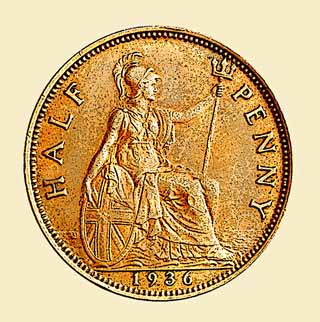 'Britannia' was adopted as a new national identity.
'Britannia' was adopted as a new national identity. A female personification holding a trident and shield came to symbolise this unity; a representative image of British imperialist power depicting Britannia seated with a shield and trident first appeared on Roman bronze coins in the 1st century AD; it appeared on British coinage in the 17th century...click on image left to visit Wikipedia's page.
However the name suggested by renowned railway photographer, Bishop Eric Treacy, for the first BR Class 7MT Pacific locomotive 'Britannia' was met with some resistance, because as mentioned earlier, the name had already been given to an ex-LMS Stanier 'Jubilee' Class 5XP.
However the 1948 Locomotive Naming Committee's three senior railway officers: ES Cox, George Dow and chairman Derek Barrie, decided that a class of locomotives featuring the names of celebrated British historical figures, ex-GWR Star Class locomotives and Scottish Firths, should go ahead.
In order to avoid duplication No 45700's nameplates were removed in 1951 and the engine named after HMS Amethyst, the Royal Naval vessel involved in the Yangste River incident of 1949. Built at Crewe Works in April 1936, No 45700's shed allocations included Newton Heath, Blackpool, Bank Hall, Derby and Warrington; withdrawal came in August 1964. Both historical nameplates (above and below) went under the hammer for £6,500 each at a Great Western Railwayana Auction in May 2014. Click HERE to visit the fascinating GWRA website...highly recommended.

Getting back to Derek's in-depth research into the history of the BR Standard Class 7MT 'Britannias', the interest shown by modellers has spurred him to create a series of articles that will be of particular interest to the most discerning model engineers - and artists too, for that matter; in fact anyone seeking to create an accurate record of the class should benefit. We start here with the Engine Brakes Hoses...

ENGINE BRAKE HOSES: The first 19 Britannia Class engines were built with a medium length stanchion pipe for the brake vacuum hose on the front of the locomotive as well as on the rear of the tender...see image '1' below.
These could be seen on Nos 70000 to 70018 in their formative years, but were gradually modified from the early months of 1952 up to the start of 1955, with the tender hoses similarly treated...see image '2' below
The flexible ends to these hoses were blanked off by a secure clamping device which pulled the pipe flange down onto a stout rubber seal attached to the lower section of the stanchion pipe on the early types, but on the modified type, a stout bracket was bolted to the buffer beam and this held the hose securely onto a sealing ring, which was further protected by a securing pin attached to a short chain. Also the flexible hoses were formed of nylon-reinforced rubber section protected by coiled wire. The vacuum ejectors were steam operated and the reservoir tank was situated under the cabin floor.
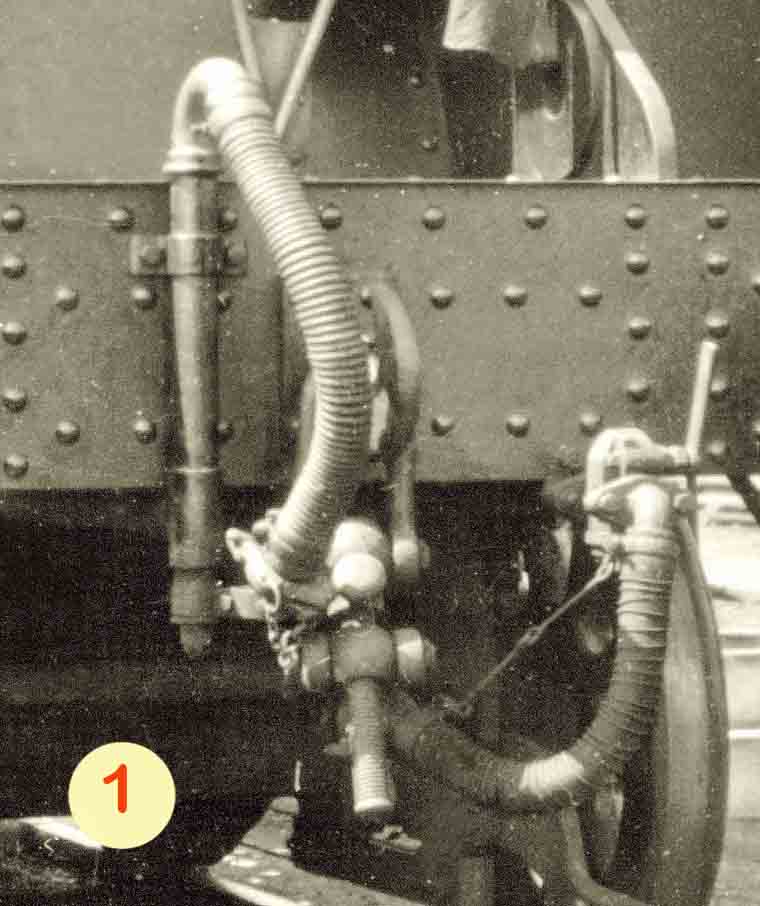
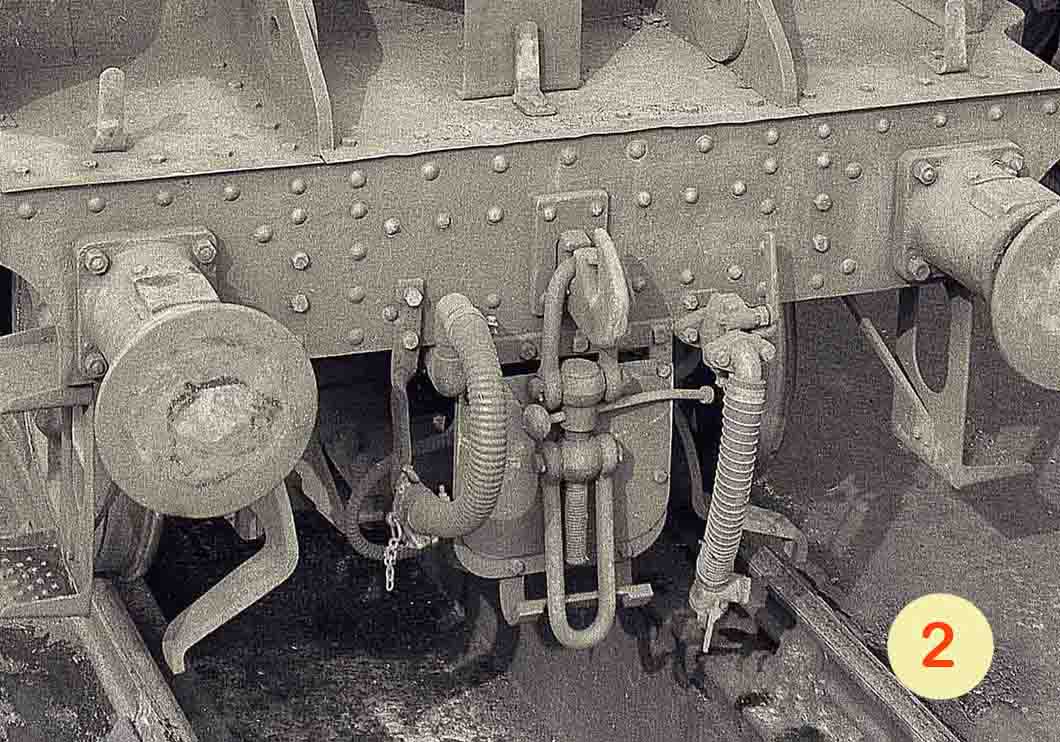
Continuing with Derek's step-by-step account of all 55 locomotives in the class, this page deals with the 1st batch: 70000-70024, constructed between January and October, 1951. The 2nd batch Nos 70025-70044 and the 3rd batch Nos 70045-70054 are dealt with on the next page...

(Above) British Railways poster - 'Forging Ahead - The First British Railways Standard Express Locomotive' - was painted by Terence Cuneo in 1951, and depicts BR Standard Class 7MT No 70000 'Britannia' leaving London Paddington station with an express train. In the background is a King Class locomotive in the early BR blue livery. The painting is a fitting tribute to the doyen of the class, but Cuneo's choice of location is somewhat misplaced; surely 70000 would have been better shown on its home territory heading a GE express out of Liverpool Street? This link will take you to the NMSI Collection website featuring the railway paintings of Terence Cuneo whose career spanned more than half a century, by which time he had established himself among the highest echelons of twentieth century British art. The NMSI family is comprised of four award-winning museums, each with their own diverse identity: the Science Museum, the National Media Museum and, of course, the National Railway Museum (NRM) at York which houses the world's pre-eminent railway collection.

(Above-Below) Driver A Bird is checking the oil on a BR Britannia class at Stratford Works in 1961. Engines were lubricated using a 'total loss' system in which the expended oil spilled onto the track. A locomotive used roughly one pint of mineral oil for each axle for every 100 miles travelled (about 1 litre for every 300 km). There were up to sixty lubrication points on a large steam locomotive, and replenishing the oil could take an hour. These are just two images from the 'Liverpool Street Photos Collection' which are now available from the archives of the National Railway Museum at York. The NRM has a collection of 1¾ million photos covering the history of Britain's railways from 1850 to the present day; the archives are currently being digitalised to make them available to a wider audience and preserve them for the future; a visit here is highly recommended.
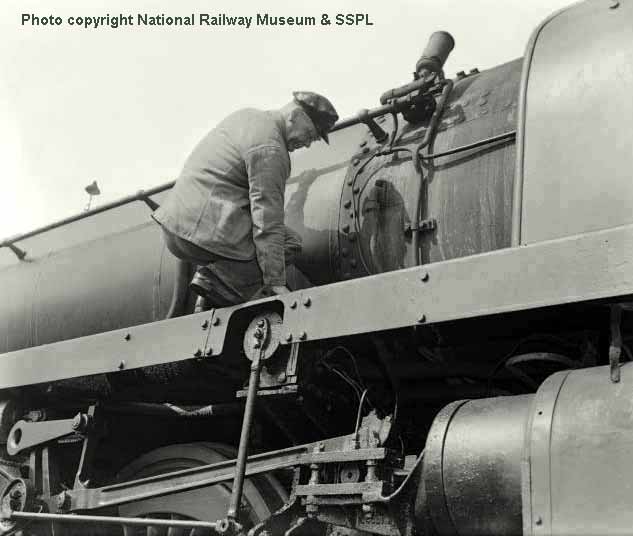

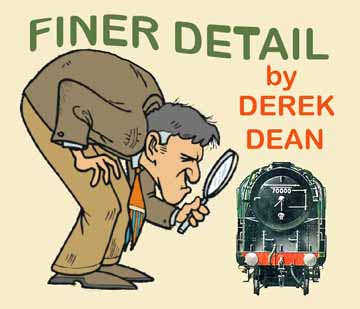 (Above) With reference to 'Silver Sidelines' (Ray) enquiry on the 'RM Web Blog' regarding the sliding hatches on the Britannias' cab roof, it is indeed difficult to find any definitive dimensions to help any modellers make the correct decision, but Keith Long's image of BR Standard Pacific No. 70000 'Britannia' clearly shows that the sliding hatches are of the wider variety and five other views of other class members do show that this was the consistent size used. Also of note on the cab exterior is the deflector glass (insert) that is fixed between the two larger windows and is contoured outwards to protect the crew from dirt and dust...click on image to enlarge.
(Above) With reference to 'Silver Sidelines' (Ray) enquiry on the 'RM Web Blog' regarding the sliding hatches on the Britannias' cab roof, it is indeed difficult to find any definitive dimensions to help any modellers make the correct decision, but Keith Long's image of BR Standard Pacific No. 70000 'Britannia' clearly shows that the sliding hatches are of the wider variety and five other views of other class members do show that this was the consistent size used. Also of note on the cab exterior is the deflector glass (insert) that is fixed between the two larger windows and is contoured outwards to protect the crew from dirt and dust...click on image to enlarge.(Below) Derek's in-depth analysis of the BR Class 7 'Britannias' includes a description of the various modifications carried out on each locomotive during their careers; to assist visitors identify the sections described this 'click-on' numbered guide is inserted at several points in the text down the page.
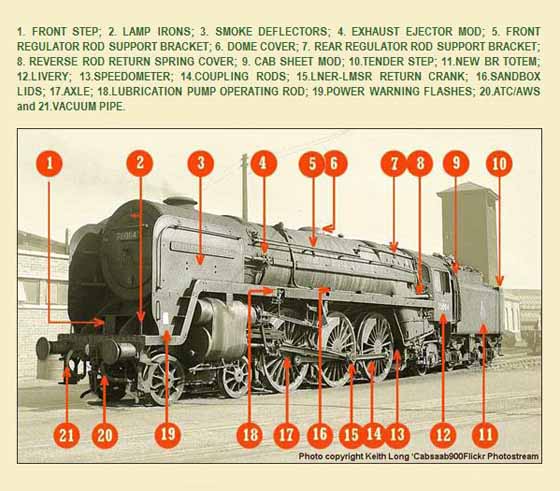
Built at Crewe Works, and completed on January 4th 1951 to Order No E479/220, withdrawn from service at the end of May 1966 - but, of course, destined for preservation.
ALLOCATIONS: after two weeks of stringent testing, she was sent to Stratford MPD (30A) to begin earning some revenue, and following what was to be a well-trodden route, 70000 moved on to Norwich MPD (32A) at the end of January 1959, followed by relocation to March MPD (31B) during September 1961. After a number of months in store at March, she was allocated to Willesden Depot (1A), but only for a period of 8 weeks, for 70000 found favour at Crewe North MPD (5A) from 25th May 1963. When Crewe North closed, she moved to Crewe South shed (5B), dated 19th June 1965, but eventually (and finally) onto Newton Heath MPD (26A).
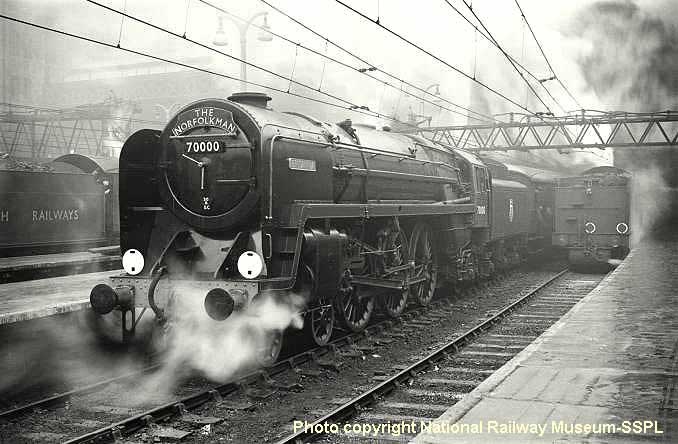
(Above) This evocative image from the NRM's archives shows 70000 Britannia awaiting departure from Liverpool Street station with the 'down' 'Norfolkman' on 2nd February 1951. The National Railway Museum at York has a collection of 1¾ million photos covering the history of Britain's railways from 1850 to the present day. The NRM's archives are currently being digitalised to make them available to a wider audience and preserve them for the future - more images like this can be found on the NRM's 'Liverpool Street Photos' page here. A visit is highly recommended…links on the NRM's website will take you to an extensive collection of railway travel posters and other images from the Science Museum Group collections here. Sales of postcards, notecards and framed or unframed decorative prints help towards funding the work of the National Railway Museum.
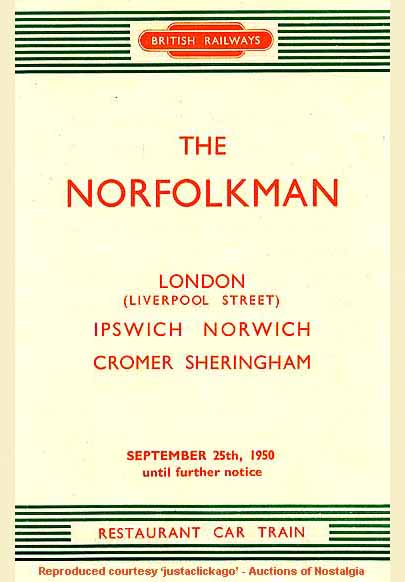 MODIFICATIONS: 70000 had not been long in service, actually less than two weeks, before a problem occurred, 'the engine had no power' it was reported. The fitter in attendance found that a piston had broken, but what had caused such a catastrophic defect had yet to be surmised.
MODIFICATIONS: 70000 had not been long in service, actually less than two weeks, before a problem occurred, 'the engine had no power' it was reported. The fitter in attendance found that a piston had broken, but what had caused such a catastrophic defect had yet to be surmised.According to Cecil J. Allen, in his book on British Pacific Locomotives, in reference to this problem: 'several cases of breaking the cast-iron piston heads occurred in quick succession on 'Britannia', that is to say the pistons were replaced, before the exact cause was rectified, and the cause was the low dome (item 6) on the boiler allowing water into the steam chest, which would find its way into the cylinders, resulting in damage.'
Also the cast-iron pistons were swopped for cast-steel ones, a type first used by Nigel Gresley on the LNER. This brought about disruption and much anguish, but the remedy was relatively straightforward, to raise the dome and the level of steam intake in relation to the water level. This knowledge was applied to all engines yet to be completed, and those others built with the low dome, nos. 70001-70006 were quickly rectified.
 The axle modification (item 17) was done as a matter of due course, although no defect occurred on 70000 in service. This would seem to have been carried out at Crewe Works, dated December 1951. 70000 then continued in service without incident until May 1952, when it was found that a mainframe had fractured, and she had to enter Stratford Works for Repairs.
The axle modification (item 17) was done as a matter of due course, although no defect occurred on 70000 in service. This would seem to have been carried out at Crewe Works, dated December 1951. 70000 then continued in service without incident until May 1952, when it was found that a mainframe had fractured, and she had to enter Stratford Works for Repairs. Some engines had a problem with the Reverse Gear jamming, and in February 1953, 70000 had the reverse gear recuperating spring modification (item 8) done. Shortly after this the fluted coupling rods (item 14) were changed to the stronger (but heavier) plain rods, and Stratford fitted one of their front step modifications (item 1) with the somewhat weak support at this time.
During 1955, 'Britannia' entered Crewe Works, and came out with a tender (platform) step (item 10) fitted, also the flexible cab sheets (item 9) were added, the vacuum pipe (item 21) had been altered, and the support bracket had been fitted to the forward Regulator Rod (item 5)...continued below.
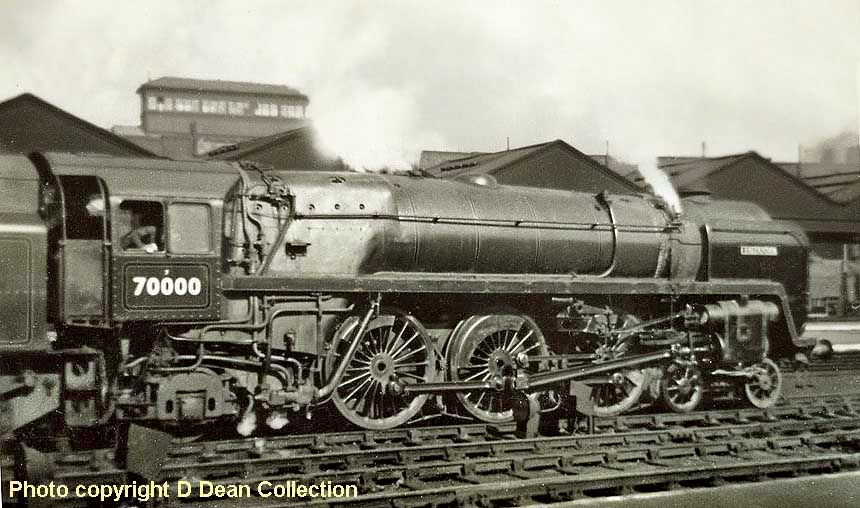
(Above) 70000 Britannia, the class leader seen in pristine condition at Liverpool Street Station in London, while waiting for its train to be brought in, and sounding her distinctive chime whistle. The date is August 1951, and the new timetables are in full swing with 13 Pacific locomotives to choose from, now that their 'teething problems' have been sorted out. 70000 is as built except for the low dome (item 6) modification, because the original caused much consternation in the early weeks of service. The hollow axles (item 17) (designed to help with weight saving) can be clearly seen in this view, and also the fluted coupling rods (item 14) (another weight saving idea) should be noted, which were mostly changed in the first couple years of service. Also of note is the recuperating spring (part of item 8) which is not covered as yet, and the small bolted cover plate, which is still in prime position on the mechanical lubrication unit (item 18). The nameplate would have been of raised brass letters with red backing. The distant signal box was that of Broad Street Station, which closed in 1986
(Below) A sight for sore eyes; 70000 'Britannia' looking resplendent at Harwich Parkeston Quay Station, early in 1953, and waiting to return to London Liverpool Street Station, whilst sporting 'The Hook Continental' headboard that she carried many times before on the GE section. Visible modifications are the Low Dome (item 6); the Axles (item 17) having been repaired; the front coupling rod (item 14) changed to a plain version; whilst the vacuum pipe (item 21) is original, and the 'tyres' on the drive wheels have been changed recently. Harwich Parkeston Quay Station was opened in 1883 and the Main buildings were a hotel. It was originally named Stour Quay and was in fact named after CH Parkes, the then Chairman of the Great Eastern Railway.
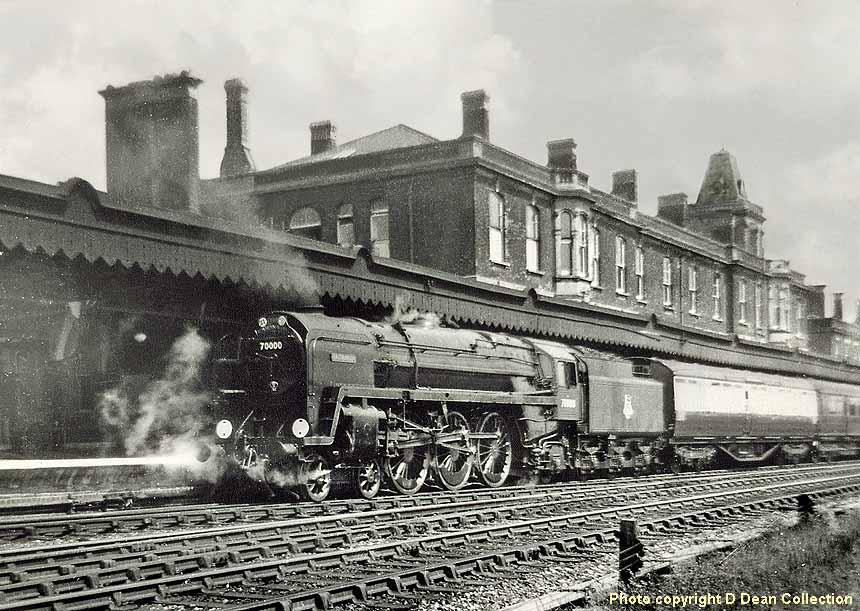
At the end of 1956, 70000 appeared from Doncaster Works with the full modification of the front step (item 1), and it was not until June 1958 that she was adorned with the new British Railways emblem (item 11), whilst the modification for the Smoke Deflectors (item 3) was not seen until emerging from Doncaster in January 1959. The modification to the sand box lids (item 16) was not carried out on 70000, as with many of the earliest built engines, but the AWS equipment (item 20) was added during another visit to Doncaster, emerging at the end of September 1959. Yet there were still more to come: the Speedometer (item 13) was eventually fitted in March 1960 (with 70000 more than 9 years old), the power warning plates (item 19) were also added in 1960, the LNER Return Crank (item 15) lasted out till April 1963, being replaced with the LMSR version, and the lamp irons (item 2) were repositioned late in 1965.
SERVICE RECORD: 70000 was immediately put to work on the Norwich services and was soon scheduled to run two trips to the county town of Norfolk, a total of 460 miles. 'Britannia' did not reach the high mileages of many of her classmates on the Great Eastern, partly due to suffering the problems, as mentioned above, and mostly down to being selected as the regular engine for 'The Hook Continental', a Boat Train from London to Harwich Parkeston Quay to connect with the ferry for the Hook of Holland. This was the case for many years for this important service, and she was manned by a crew from Parkeston. She
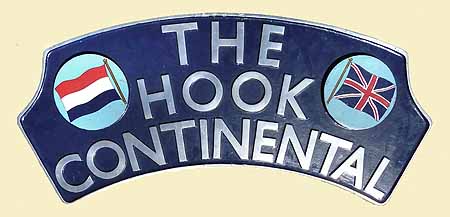 accumulated 57,500 miles during 1954, which is about the highest for 70000, but is way below the mileage accrued by the majority of Britannias on Great Eastern metals. 'Britannia' was a regular visitor to Doncaster Works for repairs, whilst she also was shopped at Crewe Works four times and visited Stratford Works on about three occasions, one of which was for repairs to her mainframe, as mentioned above, and this was quite common on some of the first group of engines. 70000 spent just over 12 years on the Great Eastern section, and the rest of her time was spent on the London Midland Region, mainly from Crewe sheds, from 1963.
accumulated 57,500 miles during 1954, which is about the highest for 70000, but is way below the mileage accrued by the majority of Britannias on Great Eastern metals. 'Britannia' was a regular visitor to Doncaster Works for repairs, whilst she also was shopped at Crewe Works four times and visited Stratford Works on about three occasions, one of which was for repairs to her mainframe, as mentioned above, and this was quite common on some of the first group of engines. 70000 spent just over 12 years on the Great Eastern section, and the rest of her time was spent on the London Midland Region, mainly from Crewe sheds, from 1963. SIGHTINGS: Obvious excitement abounded when 70000 'Britannia' first appeared in January 1951, although she was painted black, and was seen to be unnamed for the first four weeks of her career. She was trialed between Crewe and Carlisle to begin with, and re-entered Crewe Works for her final paint finish of Brunswick Green, lined out with Orange and Black, then made her way to Marylebone Station, in London, for the naming ceremony on 30th January 1951, performed by the Minister of Transport, Alfred Barnes. Early in 1952, 70000 attained the title of 'Royal Train Engine', and for this reason her cab roof was painted white, and as such 'Britannia' was seen at Brookman's Park, hauling the funeral train of King George Sixth, from Kings Lynn to Kings Cross dated 11th February 1952 (the train journey began at Sandringham). In
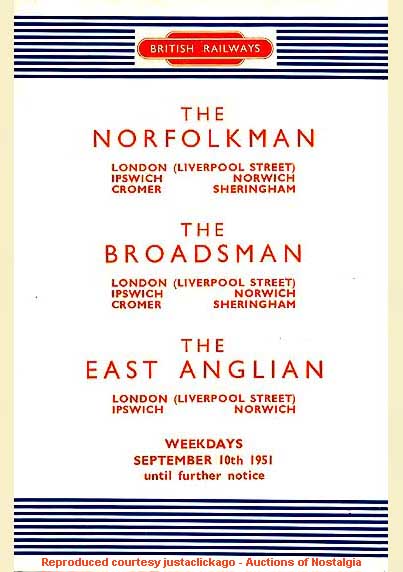 September 1953, 'Britannia' was a display engine at Doncaster Works Open Day, and was seen with gleaming paintwork by many spotters, young and old alike.
September 1953, 'Britannia' was a display engine at Doncaster Works Open Day, and was seen with gleaming paintwork by many spotters, young and old alike. During 1951 and 1952 she was often seen hauling 'The Norfolkman' or 'The East Anglian' expresses between London and Norwich. Soon after this 70000 became the regular engine for 'The Hook Continental' connecting London to the Netherlands. This position as chosen engine did mean that 70000 was usually 'stabled' out at Parkeston, and not so often seen down at Stratford MPD.
In 1955 she was 'shopped' at Crewe Works and was seen returning via the London Midland at Lichfield Trent Valley Station (see below) dated April 1955. During 1957 'Britannia' was seen at Stratford shed, and again with 'The Hook Continental' headboard in position for another trip to Harwich. In 1958 the 'Essex Coast Express' was inaugurated; the new service was advertised as 'to London by Britannia', travelling between Clacton and Liverpool Street with only two stops on the way, at Thorpe-le-Soken and Colchester. The engine chosen was 70000 Britannia, and she was polished to a fault, and Stratford MPD applied the new BR emblem to the tender, because there was to be fanfares and fancy girls at the initial send off, dated June 1958.
(Below) On the London Midland Region, but returning to home territory (the Great Eastern), 70000 'Britannia' is captured at Lichfield Trent Valley Station on her way back from a visit Crewe Works during May 1955. The vacuum pipe (item 21) has now been modified; the tender (platform) step (item 10) is now in position; and both coupling rods (item 14) are now of the plain variety - these were stronger, but also heavier. Also of note: Crewe has removed the shallow front step that was fitted by Stratford to all of their allocated Britannias, but has not yet begun to fit a full specification replacement (this began in 1956).
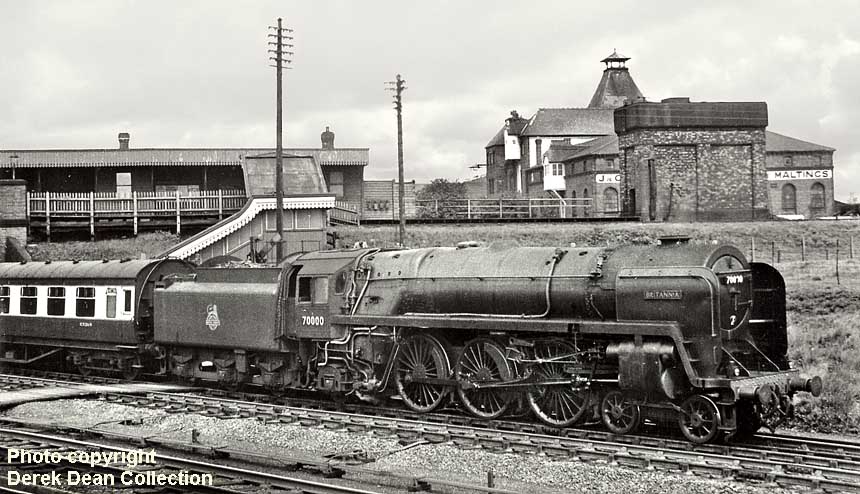
Despite being in pristine condition for the launch of the 'Essex Coast Express' in June 1958, by September 70000 was seen at Sheffield in a very grubby state, having taken over from an electric locomotive, on a Liverpool Central to Harwich boat train. This was a new diagram for Stratford, involving freight to Parkeston, train to Sheffield, and returning the same way. In 1961 she was at York Station with a return working from Yarmouth (see below) looking in good external condition, as she was in October 1964, when chosen to haul a 'LCGB Vectris Tour' to Portsmouth Harbour from Guildford, and returning to Waterloo Station. Finally she was seen in a very much rundown condition at Llandudno MPD, having worked a passenger train from Manchester, during July 1965, and it was noted that the lamp irons were still in their original position, but her nameplates were now missing.
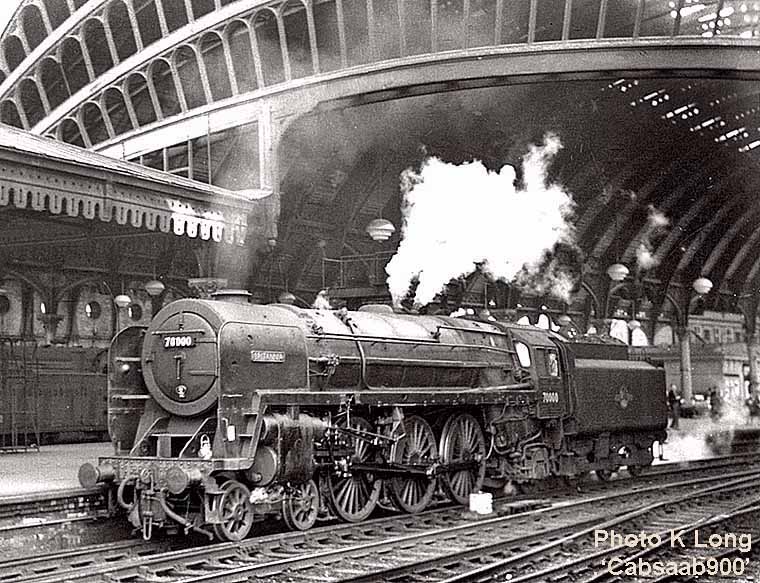
(Above) As already mentioned, 70000 was seen at York with a train from Great Yarmouth on Saturday 23rd September 1961. Here 'Britannia' rests light engine before going onto shed for servicing. Looking in good running order, she has the majority of the expected modifications done by this date, the latest addition being the speedometer (item 13) which was fitted in March 1960 by Doncaster Works. The only other major change in the offing was the LNER Return Crank (item 15) which would be swapped for a LMR type in April 1963. Rather strangely the records show that 70000 went into Doncaster Works again two days after this picture was taken, and had the boiler replaced, amongst other things.
(Below) captured by Rod Blencowe at March MPD, dated 7th July 1962, 70000 casts a different picture altogether here, although reasonably clean, cab sheet is torn, boiler handrail is a little bent, the cover is missing off the exhaust pipe (between the top of the cylinder and the boiler walkway), and the 'tyres' are quite worn down. Most of the modifications are now done; the AWS (item 20) being the most significant, the power warning plates have been added; also the speedometer (item 13) was fitted in March 1960, but the LNER Return Crank (item 15) has still to be upgraded to a LMR type (April 1963). She is showing the March Shedcode (31B), having moved there during September 1961, staying put until May 1963, when she was allocated to Willesden MPD (1A). Classmate 70011 'Hotspur' is also at rest behind 70000, one of 19 Britannias that served from the mainly freight shed, located in Cambridgeshire, and 29 miles north of Cambridge itself...incidentally, if anyone requires traditional photographic prints of Rod Blencowe's shots, or any other photographic services, Rod's email address can be found at the foot of the page.

(Below) Rising Phoenix-like from the ashes, restoration of 70000 is underway at Bridgenorth on the Severn Valley Railway.
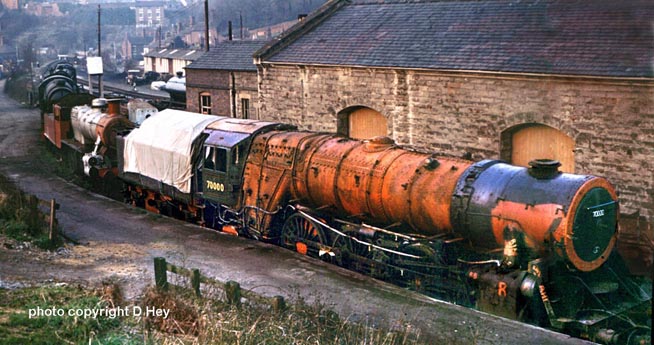
On 16 May 1966 I was aware that a schools excursion would be running from Liverpool to York and that it would be double headed from Bolton to Rochdale. So I went to Castleton North Junction and duly photographed Stanier 'Black 5s' Nos 45290 and 45338. Whilst there I could see a freight passing along from Castleton South Junction towards Castleton East Junction.
The signalman at East Junction box said - It's Brewery to Healey Mills and it's one of those big engines. It's got a stop at Rochdale to detach...'
So I hot footed to Rochdale East Junction and took four photographs of No 70000 'Britannia' as it stopped in the down goods loop and detached Rochdale traffic into the yard...see first two photos below.
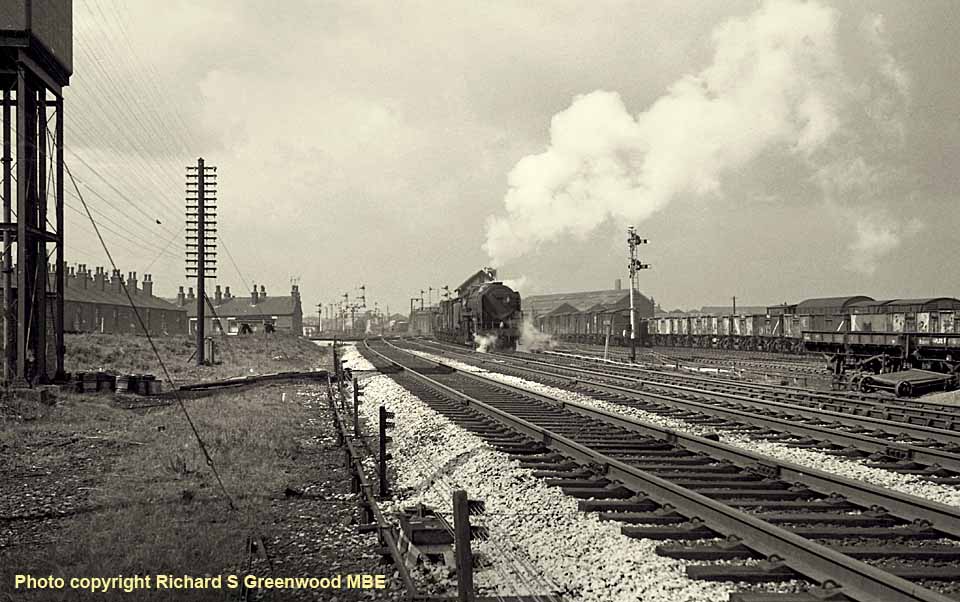
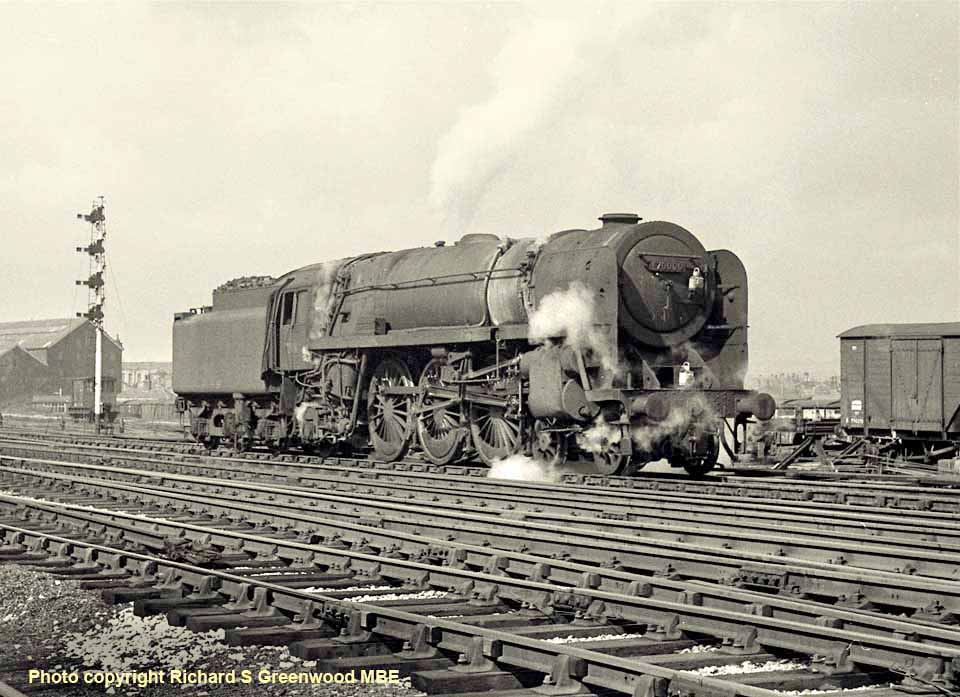
(Below) After setting back onto its train, No 70000 departed for Healey Mills. The locomotive was allocated to Newton Heath (26A) at the time and Newton Heath driver, Trevor Owen, is pretty certain that this was its last revenue working as the Boiler Inspector stopped it when it got back to the shed. No 70000 was officially withdrawn from Newton Heath shed just twelve days later on 28th May 1966 after fifteen years of service.
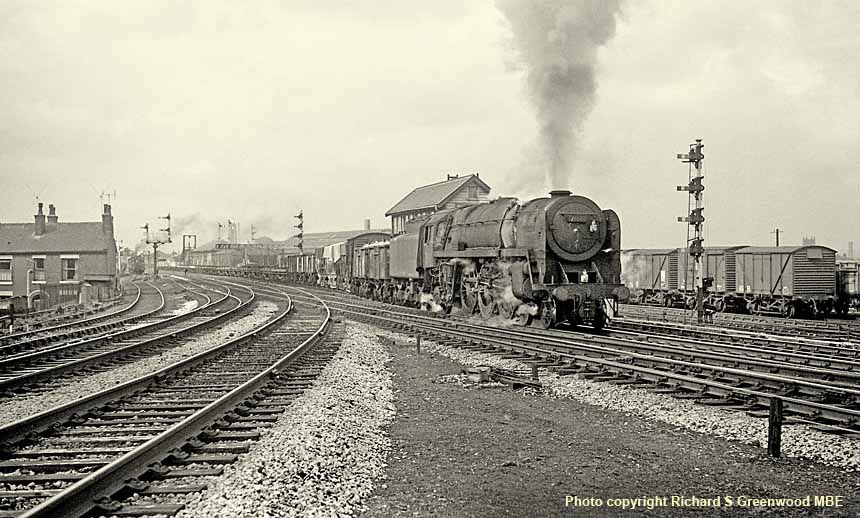
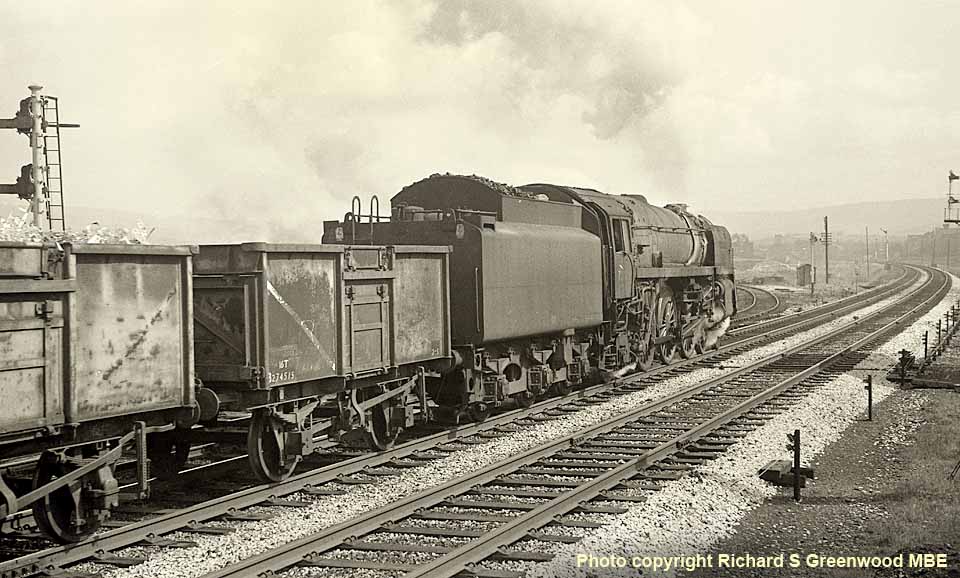
ALLOCATIONS: As with all first eight Britannias, the initial shed chosen was Stratford (30A), followed in January 1959 by a move to Norwich Thorpe (32A) where he joined up with 22 classmates based in Norfolk,
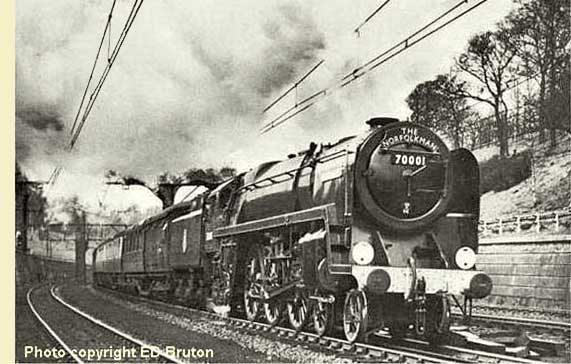 thus copying exactly the same path taken by 70000 'Britannia'. 70001 then joined the strength at March MPD (31B) in September 1961, residing there until the 30th March 1963 before finding a better home at Willesden MPD (1A). However, this turned out to be a short stay, and before the end of the year 70001 was transferred to Aston MPD (2J) in the Birmingham area, before moving on again to his final shed at Carlisle Kingmoor shed (12A), as did many other members of the class.
thus copying exactly the same path taken by 70000 'Britannia'. 70001 then joined the strength at March MPD (31B) in September 1961, residing there until the 30th March 1963 before finding a better home at Willesden MPD (1A). However, this turned out to be a short stay, and before the end of the year 70001 was transferred to Aston MPD (2J) in the Birmingham area, before moving on again to his final shed at Carlisle Kingmoor shed (12A), as did many other members of the class. You may notice in reference to 70001 Lord Hurcomb that I use 'he' rather than 'she'...in my view, the feminine term doesn't sound quite right somehow...
(Above Right) A scene capturing the epitome of the Britannia Class 7: climbing the 1 in 85 section of Brentwood Bank with 'The Norfolkman', a down express, from London to Norwich, as viewed by Eric Bruton on 24th March 1951. The locomotive is 70001 'Lord Hurcomb', one of only 4 of the class as yet constructed, and as such is almost as built; I say 'almost' because the low dome (item 6) modification was done before the engine had entered into service. The train would stop at Ipswich, then would reverse at Norwich, where the Britannia would come off the train, and a lighter locomotive would continue to Cromer and Sheringham.
(Below) This superb study at Stratford shed is a wonder in itself, a wonder that Norman Preedy was able to capture this image without any other locomotive obstructing his view. Dated 20th April 1952, 70001 Lord Hurcomb was just one year old and a resident of Stratford MPD (30A) along with about 400 other locomotives at this time. The photo reveals three modifications have been carried out: the low dome (item 6) had to be done early in life: the hollow axle repairs (item 17) have been completed and the front coupling rods (item 14) have been altered to show a plain rod at the front, but with the original fluted type to the rear. Also the bolted plate in front of the mechanical lubrication unit (item 18) has been left off (well, that was never going to last) thus allowing enginemen easier access to the oil level finder. 70005 was a 30A resident until moving to Norwich at the end of January 1959, spending over 12 years on the Great Eastern section.
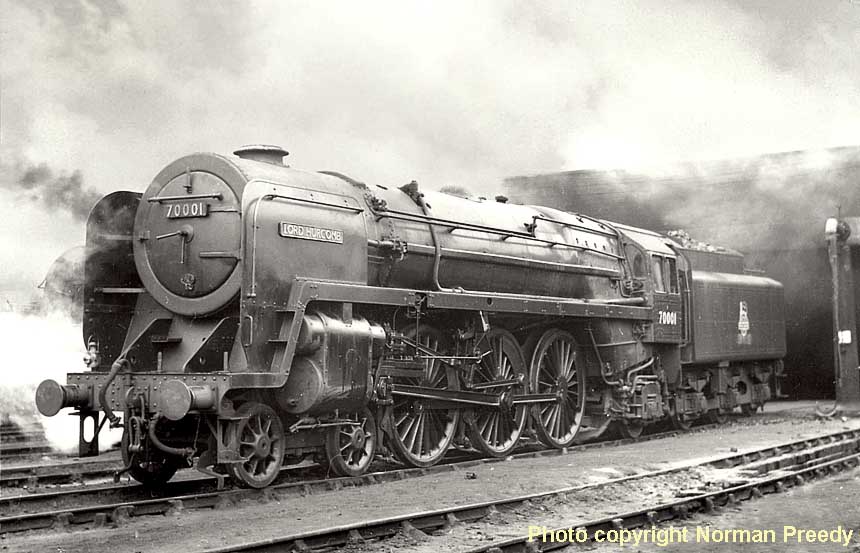
MODIFICATIONS: 70001 was able to benefit from the problems suffered by 70000 'Britannia' (as mentioned above) and was modified before breaking down. Thus we had the rather unique situation where 70001 was released to traffic on the 14th February and back into Crewe Works the 15th for the low dome (item 6) modification to be carried out. Early in November 'Lord Hurcomb' was repaired at Crewe, having been taken out of service due to the Axle problems (item 17) that beset a number of the class from the latter part of October 1951. When back in traffic 70001 was seen to have plain coupling rods (item 14) at the front, but fluted rods to the rear, which was a general policy due to lack of stock of the plain variety, the latter then being fitted at Crewe in May 1953.
As a general rule, the first 15 locomotives built were not modified with raised sand box lids (item 18) and this was the way with 'Lord Hurcomb'. Also the LNER Return Crank (item 15) was not changed. Meanwhile the flexible cab sheet (item 9) was seen from May 1953, and shortly after this Stratford MPD fitted a weak-type front step (item 1) to aid the fitting of headboard onto the top lamp iron position, when hauling one of the numerous titled trains on the Great Eastern.
Also at this time the vacuum pipe (item 21) was altered to its lower position, after which few changes could be detected in the appearance of 70001, until September 1959, when the Smoke Deflectors (item 3) were modified to LMR 1 type (two cups with backing), and the AWS (item 20) equipment was added: this included a battery box which was fitted on the offside boiler walkway, and a vacuum reservoir, mostly to be seen tucked under the cab on the nearside, with relevant pipework along the side of the walkway. The only other change of note was the fitting of the Speedometer (item 13), seen from July 1960, one of 15 locomotives to receive the equipment during 1960.
(Below) A splendid Rod Blencowe capture of 70001 Lord Hurcomb waiting to leave Ipswich Station with an 'up' express for London, and showing that the Axle (item 17) repairs and modifications have been carried out; the low dome (item 6) would have been done almost as soon as the engine was completed, otherwise all else is in original condition, including the reverser recuperating spring (part of item 8) not yet being 'encased' to improve the action of the spring as this was found to be the cause of the reverse gear 'jamming'. Also of note, the large white discs were always used in daylight hours on the Great Eastern section. Date is estimated as March 1952.

SERVICE RECORD: it can be said that 70001 had a truly unremarkable career, with no noted fast runs; no Railtours; no notable accidents either, but was recorded to have covered 78,600 miles in 1954, which is a good average. The naming of 70001 was said to be an 'ostentatious affair', for Lord Hurcomb was at that time the Chairman of the British Transport Committee, and went on to become the President of the RSPB (Royal Society for the Prevention of cruelty to Birds).
Working from Stratford shed 70001 would have hauled the top expresses seen on the Great Eastern Railway: 'The Norfolkman'; 'The East Anglian'; 'Easterling' for example, and worked on the GE section for just over 12 years based at Stratford, Norwich and March sheds. 'Lord Hurcomb entered Crewe Works for repairs at least 5 times (records incomplete), Doncaster Works 4 times, and was seen in Stratford Works on at least 3 occasions, with no out of the ordinary defects being reported. But in his excellent book about life as the Foreman at Norwich MPD, DW Harvey (Bill) has noted that 70001 broke its left-hand piston rod at speed, and was 1 of 5 to do so. This was caused by a loosening of the cylinder on the frame, and another note was in reference to one of the horn guides (these allow the drive axles to move vertically) was found to be cracked on 70001, dated 28th March 1961. Soon after this date 'Lord Hurcomb' was being cleaned at March shed for a special train duty, dated 20th June 1961, but I have not yet discovered any detail of that duty.
(Below) Colchester, some fifty-two miles from London, is the scene for 70001 'Lord Hurcomb' residing on shed, during October 1957, showing off 'his' new full specification front step (item 1), modified at the end of May the same year. Also of note are the new British Railways emblem (item 11); the rear regulator rod support bracket (item 7) has been added, pairing up with the front rod bracket (item 5) done earlier; the lubrication pump operating rod (item 18) is now much shorter, to give extra oil-feed to the cylinders; the vacuum pipe (item 21) which has now been modified. At the front of the locomotive three of the four lamp irons (item 2) are much longer than that positioned at the offside front: these are so to accommodate the large white discs, normally used on the Great Eastern section, also the front buffer beam paintwork is very scruffy, and lastly the front number plate is a false one (compare with Norman Preedy image, seen above).
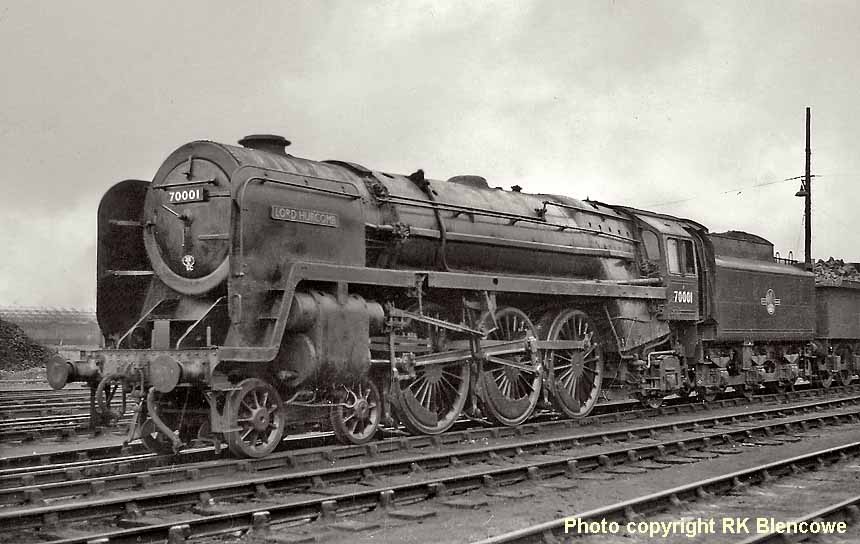
SIGHTINGS: majority of the photographs of 70001 'Lord Hurcomb' show 'his' time on the London Liverpool Street to Norwich services, but precious few thereafter. In May 1951, 70001 was seen with an up express on Haughley Bank, near to Stowmarket; at Haughley Junction in July the same year with the up 'Norfolkman', and at Trowse old cattle station heading south with the 'East Anglian' express, during April 1954. Later on, in 1959, 70001 was pictured crossing St. Olaves Swing Bridge, over the River Waveney, Great Yarmouth, with an express, and seen in good condition (recent ex-works) at that time, whereas when sighted at Banbury Station early in 1963 on a southbound train, the locomotive's external condition was dire, although it must be said that the winter of 1962-63 was truly awful. After this, in June 1963, 70001 was seen at Crewe in pristine condition, proving that the locomotives were only cleaned when going into the repair shops, at around this time.
(Below) This side-on study by Eric Sawford shows 70001 Lord Hurcomb at rest in the yard at March MPD (31B) on 9th September 1962, and looking in quite reasonable condition for the period, albeit with rather thin 'tyres'. 70001 is sporting four power warning plates (item 19) which is unusual; the AWS equipment (item 20) has been fitted and the relevant pipework is extremely neat and tidy along the nearside boiler walkway. The LNER Return Crank was not changed ever, thus 70001 became one of only 7 locomotives (13% of the class) to have done so.
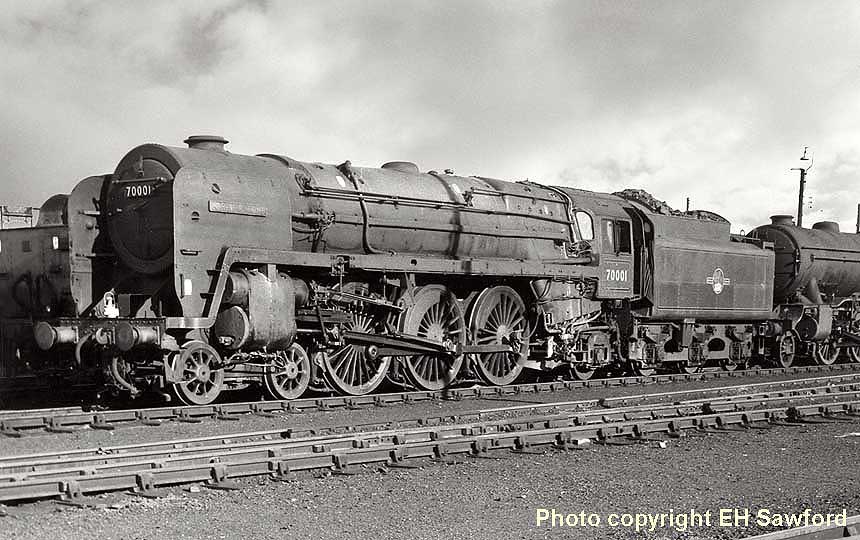
Constructed at Crewe, completed on the 6th March 1951 to Order No E479/220 at a cost of £20,025. Withdrawn on 14th January 1967.
ALLOCATIONS: 70002 started off at Stratford MPD (30A), remaining there some eight years before moving on 4th January 1959 to Yarmouth South Town shed (32D) - a strange choice, albeit lasting a mere three weeks. Then on 25th January 1959, 70002 was allocated to Norwich MPD (32A) along with eleven other members of the class, thereby linking up with seven Britannias already at Norwich shed; a further three Britannias joined them a week later. This created a pool of 22 Britannias based at Norwich, the only Great
 Eastern member missing being 70042 Lord Roberts, which had moved to the London Midland Region at Kentish Town MPD (14B).
Eastern member missing being 70042 Lord Roberts, which had moved to the London Midland Region at Kentish Town MPD (14B). Following what became a regular pattern for the Britannias on Great Eastern metals, the next move on the agenda was to March MPD (31B) on the 25th June 1961 and then to Carlisle Kingmoor MPD (12A) dated 1st December 1963. 70002 was withdrawn in January 1967 and put into store until June before being shipped to Campbells of Airdrie for disposal the same month.
MODIFICATIONS: the low dome (item 6) was modified just after completion, and before any problems arose within the cylinders; this was quite quickly followed by the Axle modifications (item 17), which were completed in December 1951. The vacuum pipe (item 21) was reset by Stratford to the lower position, during routine service in June 1952. Whilst at Crewe Works in May 1953, 'Geoffrey' had the coupling rods (item 14) modified to show four plain rods, instead of two fluted and two plain, and the flexible cab sheet (item 9) was also fitted.
(Below) A fine shot of 'Geoffrey Chaucer' moving away from Ipswich Station with a down express, i.e. going north towards Norwich, dated February 1954, and showing a weak-type front step (item 1) with unique twin support brackets. The vacuum pipe (item 21) has been modified, a cab sheet (item 9) is now fitted, but still no tender step (item 10) has been added.

Shortly after, a unique version of the front step (item 1) was seen, having two support brackets instead of the usual single type; maybe this was fabricated by Stratford shed? Following a Heavy General at Crewe Works in December 1954, 70002 was viewed with a tender step (item 10) fitted, and fully two years later (December 1956) the full front step (item 10) modification was completed at Doncaster Works. The LNER Return Crank (item 15) was never changed on 70002, nor were the sand box lids (item 16) ever altered, but in June 1958 the smoke deflectors (item 3) were modified to LMR 1 design (two cups with backing) and the new BR emblem (item 11) was applied to the tender.
Many of the repairs and modifications for the Britannias were done at Doncaster, and again this was so in March 1960, when the Automatic Warning System equipment (item 20) was added, along with the speedometer unit (item 13), which gave 70002 a different look altogether, when compared to 'as built' in 1951. The power warning flashes (item 19) were added in 1961, and in July 1964 the lamp irons (item 2) were repositioned to comply with safety rulings, regarding to overhead power lines, which were prevalent at this time.
(Below) A fine low-angle shot of 70002 'Geoffrey Chaucer' in ex-works condition at Doncaster Works, as captured by BK Green. The photo shows very well the size of the Britannia boiler, which was based on the William Stanier Coronation Class boiler; also prominent are the newly formed Smoke Deflectors (item 3) which are of LMR 1 type, as fitted to only 25 members of the class, with all of these modified at Doncaster. The British Railways new emblem has also been added at this time, but 70002 is missing the heater hose from the front, right hand side.

SERVICE RECORD: 70002 averaged 85,000 miles per annum when running on Norwich diagrams, such as double trips from London to Norwich, accumulating 460 miles a day with such trains as 'The Norfolkman', 'East Anglian', 'Easterling and 'Fenman'. 70002 entered Doncaster Works 8 times, including six times for servicing and twice for adjustment; visited Stratford Works on 6 occasions, three for service and a further three periods for general repairs; and into Crewe Works four times, for overhauls, coupled with accident repairs and modifications as required. 'Geoffrey' suffered a Mainframe fracture at the end of May 1952, and entered Stratford Works for the welding to be done, which would seem to be the only occasion that this problem occurred on 70002, whereas some engines had to be repaired repeatedly, due to a lack of strength of the frame around the cylinders. 70002 had four boiler changes during his career, and just two changes of tender; also 70002 was stored on three occasions: in October 1951 for 9 days (awaiting axle repairs); in 1963 at March shed before transfer to Carlisle and in 1967 following withdrawal, awaiting disposal.
Geoffrey Chaucer was 1 of only 3 Britannias to be allocated to Yarmouth (32D), the others being 70012 'John of Gaunt' and 70030 'William Wordsworth'; the shed itself was a brick built, twin track through building, and was named Yarmouth South Town, closing in November 1959. 70002 spent over twelve years on the Great Eastern and Eastern Regions, and would seem to have had a very high level of availability. There was a problem with loose cylinder bolts in October 1958, which was corrected at Doncaster Works, but otherwise little else to cause any issue. However, there was a problem in 1964 when 70002 unfortunately ran into a goods train in foggy conditions in the Carlisle area, but was deemed worth repairing and entered Crewe Works for repairs to the offside front during September 1964. Thus in May 1966 he was still able to take a troop train that originated at Elgin in Scotland, from Crewe down to Portsmouth and Southsea, and finished up at Nine Elms MPD (see photo below).
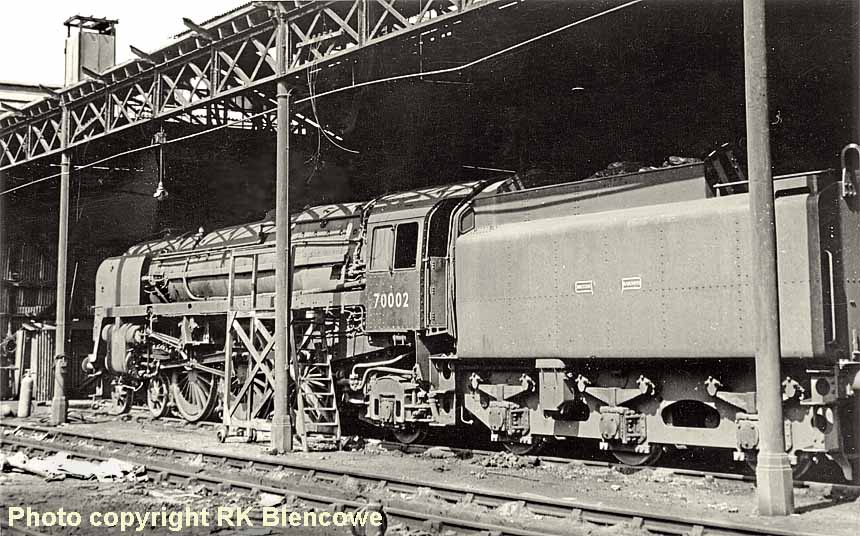
SIGHTINGS: 70002 'Geoffrey Chaucer' was the third BR7 Pacific to be enthusiastically received by Stratford crews; the loco was regularly to be seen on the Norwich expresses such as 'The Norfolkman'; the NRM is custodian of the late P Ransome Wallis's collection, including a splendid photo of 70002 passing Shenfield with the up 'Norfolkman' in May 1951 (Ref: X826/NRM). In July 1951, 70002 was captured on film hauling an eleven-coach continental express through Stratford station, and looking in very fine, clean condition. The following year, 70002 was seen departing Liverpool Street Station with 'The East Anglian' in March 1952, and again on the Liverpool Street Station turntable after bringing in an express from Norwich Thorpe.
70002 was observed at Stratford shed yard amongst piles of discarded ash from multiple smokeboxes, but looking ready for the next task.
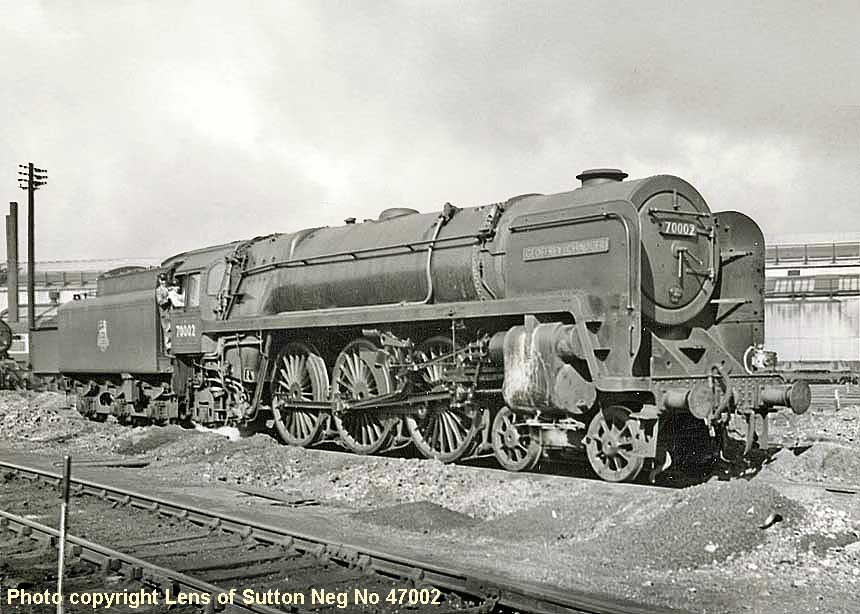
(Above) A nearly-new 70002 'Geoffrey Chaucer' at Stratford shed amongst the discarded ash, which seemed to be a constant feature of Stratford yard. The hollow axle centres are prominent, as is the low dome (item 6) modification. Rather poor appearance for a nearly new engine; the markings on the cylinder are caused by steam vapour leaking from the exhaust joint just above.
(Below) Another good close-up of 70002, this time taken by the redoubtable Hugh Ramsey at Stratford shed, on 23rd March 1961, and showing all the anticipated modifications; smoke deflectors (item 3); front step (item 1); AWS equipment (item 21), etc. The power warning plates have been added recently, and of note is the centre lamp iron (item 2) which is longer than the other two above the buffer beam. Also the nameplates would have had a light blue background, to indicate it was a Great Eastern engine.
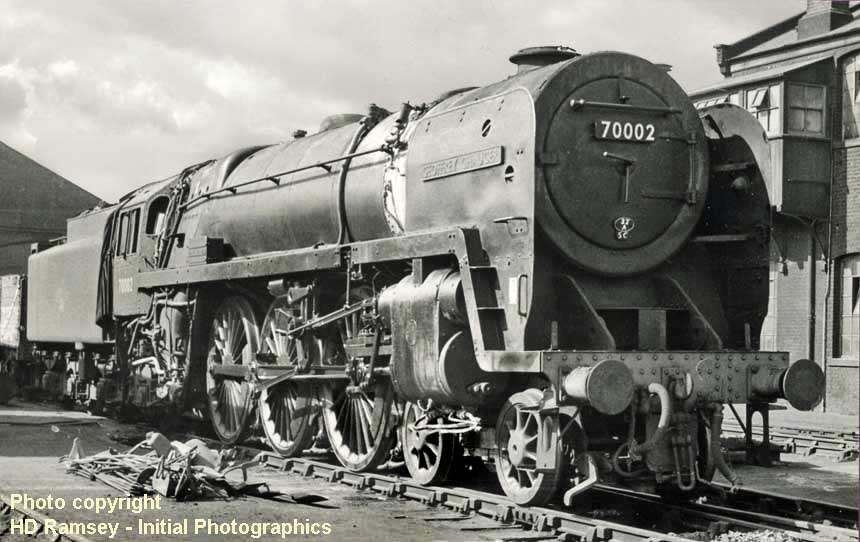
By June 1954 70002 had acquired a cab sheet and a weak type front step (item 1) but not much else had changed visually when photographed at Stratford shed. 70002 was viewed waiting to leave Liverpool Street station with the down 'Norfolkman' on 1st May 1955, having acquired the obligatory platform step on the tender (item 10). 'Geoffrey Chaucer' was pictured in pristine condition inside a less than pristine shed at Doncaster in June 1958; at this time the shed was being re-roofed whereas 70002 was ex-works and sporting newly-formed LMR Type 1 smoke deflectors (item 3), and also the new British Railways emblem (item 11) on the tender, this being almost two years since the emblem first appeared on the tender of 70016 'Ariel'.
(Below) 70002 Geoffrey Chaucer awaits entry to Doncaster Works, as seen by Clive IK Field on 8th August 1961. According to works records, this was for a Non-Classified repair. The lubrication unit (item 18) has a very short drive rod; this would have been changed on shed in an attempt to introduce more oil into the cylinders whilst running. Also of note; the drive wheel tyres are quite new (thick).
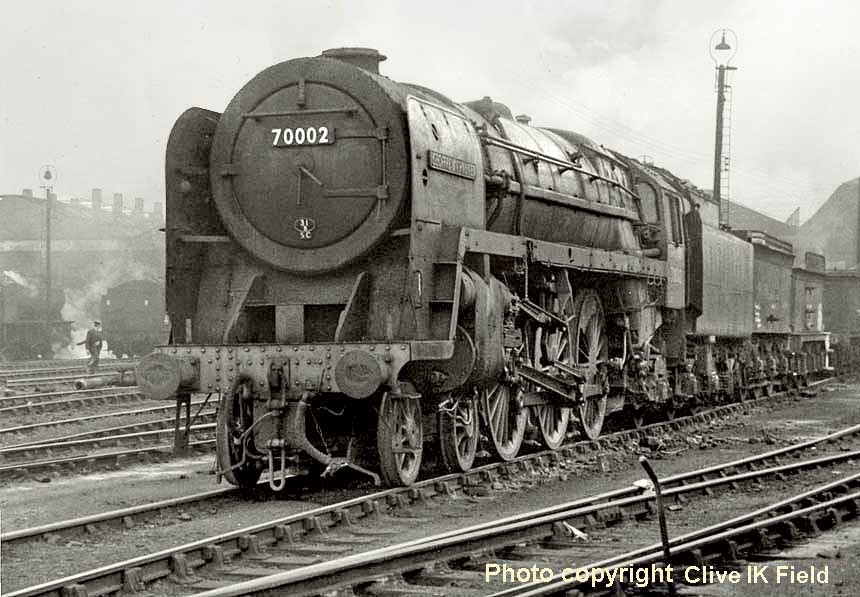
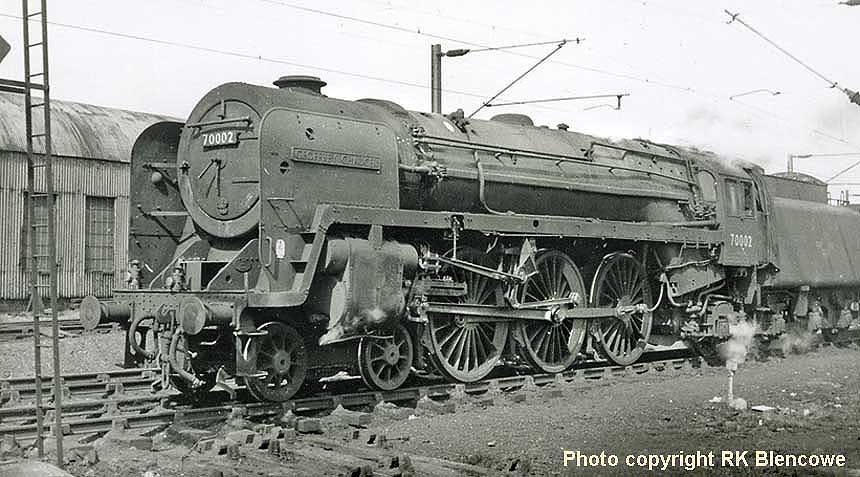
(Above) This photograph by Rod Blencowe shows 70002 Geoffrey Chaucer in Stratford shed yard, which of course used to be a regular occurrence, but now sporting a 12A Carlisle Kingmoor shed code, this is an unusual event.
In August 1964, 70002 was photographed leaving Carstairs with the up 'Royal Scot' having replaced a failed diesel locomotive, albeit he was not looking at his best externally but well in command of the situation. Shortly after, 70002 ran into a parcels train at Carlisle in September 1964, but despite extensive damage the loco was considered worth repairing, thus providing another two years in service.
During May 1966 - and much to the delight of SR spotters - 70002 was observed hauling a troop train for the south coast through Eastleigh. The train had originated at Elgin in Scotland, and was destined for Portsmouth and Southsea; 70002 came onto the train at Crewe, finishing up at Nine Elms shed because Willesden had closed. The following day, 'Geoffrey Chaucer' was booked on a Waterloo to Southampton service, although he was still a Carlisle Kingmoor locomotive.
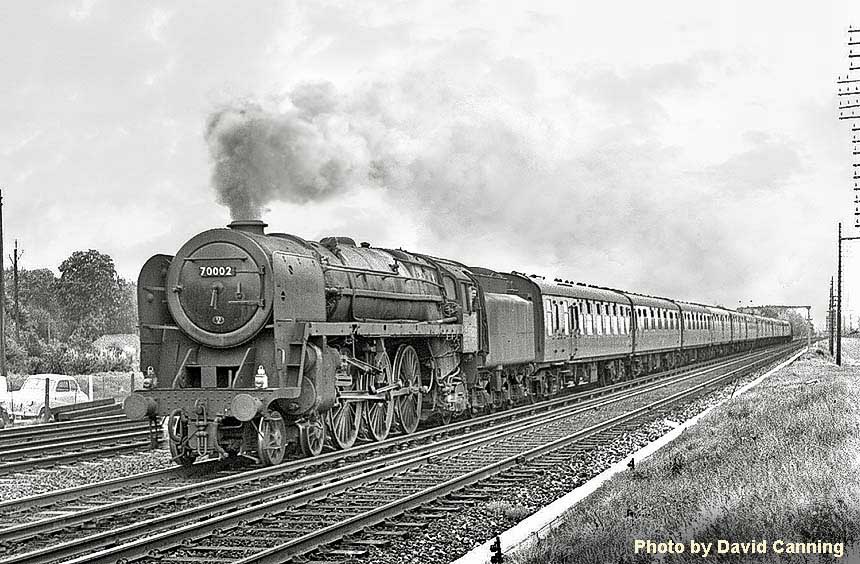
(Above-Below) superb photograph by Dave Canning of Britannia class No 70002 Geoffrey Chaucer passing Worting Junction in May 1966 with a Troop Train originating from Elgin in Scotland. 70002 took over the train at Crewe for the journey south to Southampton and Portsmouth. The locomotive seems to be in reasonable condition and was able to take a train from Waterloo the following day before returning home. (Below) Another stunning panning shot at Winwick Junction by Footplate Cameraman, Jim Carter; this one showing 70002 speeding north with an express freight.

Programme authorised 11th November 1949, built at Crewe Works, completed 10th March 1951 to Order No E479/220 at a cost of £20,025. Withdrawn 25th March 1967
ALLOCATIONS: 70003 followed a very straightforward path as far as shed allocations were concerned; and that was new to Stratford MPD (30A) 10th March 1951, Norwich Thorpe (32A) 23rd January 1959 and onto March MPD (31B) dated 9th July 1961 before relocation to Carlisle Kingmoor shed (12A) the 'Last Outpost' of the Britannia class and pretty much anything else that was still in steam.
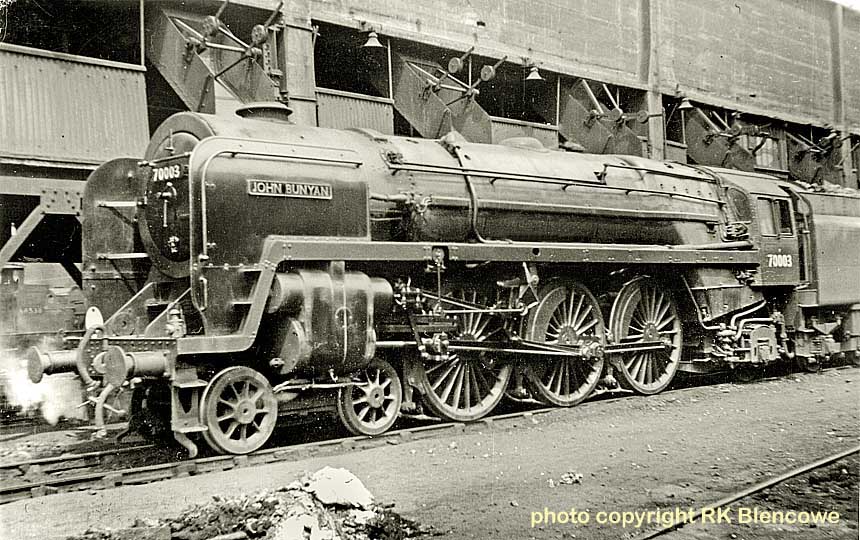
(Above) An evocative image by Rod Blencowe of a very clean Britannia Class 4-6-2 No 70003 John Bunyan on Stratford Shed, dated October 1952. The locomotive is nearly eighteen months old, and the main change to be seen is the modifications to the drive axle centres. The Stratford coal plant was required to be very large and had eight tips on each side with a constant supply of coal being delivered via the central conveyor belt that was fed from an underground store of fuel topped up from a rotary truck tipper. This facility was built in 1922, and required 12 men to operate it fully.
MODIFICATIONS: As one of the first batch 70003 John Bunyan was required to have all the modifications except for the exhaust ejector (item 4), which only applied to Western Region Britannias, and the sand box lids (item 16) which were not altered in any way. When built 70003 had one of the troublesome low domes (item 6) fitted and although this is not recorded as being changed during a Works visit, I believe that it would have been modified either after running-in or at least within two weeks of entering service. 70003 suffered no problem with any 'axle shift' but was duly modified during November 1951 and with the axle repairs (item 17), the coupling rods (item 14) were changed to plain type at the front of the engine and a fluted version to the rear: this was down to a lack of spares at that time, but new plain rods replaced the
 fluted ones in April 1953 at Crewe Works in conjunction with the reverse gear recuperating spring (item 8) being encased and the vacuum pipe (item 21) was altered to the new position. Also at that time the front regulator rod supporting bracket (item 5) was applied to prevent vibration in service.
fluted ones in April 1953 at Crewe Works in conjunction with the reverse gear recuperating spring (item 8) being encased and the vacuum pipe (item 21) was altered to the new position. Also at that time the front regulator rod supporting bracket (item 5) was applied to prevent vibration in service. In 1954 the cab sheet (item 9) made an appearance and this was followed by the tender step (item 10) added by Crewe Works in December. In 1955 Stratford Works made their modifications to the original front step (item 1) with the additional plate, but the full step version was fitted by Doncaster Works in August 1956.
Doncaster continued to maintain 70003 John Bunyan and on his next visit in January 1958 the smoke deflectors (item 3) were altered to LMR 1 type; the new British Railways emblem (item 11) was applied to the tender; and the rearmost regulator rod supporting bracket (item 7) was added to increase stability of the rods in service. The AWS equipment (item 20) was added by Doncaster in March 1959, while the speedometer unit (item 13) did not come into use until early 1960, again fitted by Doncaster Works who also applied the power warning plates (item 19) to remind the crew of the dangers of the live-wires prevalent in many areas. The lamp irons (item 2) were still of GE origin until 1964, when the top iron was moved down the smokebox and switched to a LMR type (much shorter), but retaining the longer irons on the buffer beam until entering Crewe Works in February 1965, when all of the irons were seen to be altered to the standard LMR version; also the LNER Return Crank (item 15) was modified to the LMSR type with the four stud fixing and the BR emblem (item 11) was now of a much smaller size, of a type used mainly on tank engines.
(Below) Seen on a down express for Norwich is Britannia 4-6-2 No 70003 John Bunyan at Cambridge Station in May 1958, by which time the dangerous handrails have been removed from the smoke deflectors, and the appearance of engine has markedly changed. Also of note are the long lamp irons, needed to accommodate the Great Eastern type white indicator discs, and the shedcode which was 30A Stratford, in East London. Another fine image from the archives of Rod Blencowe.

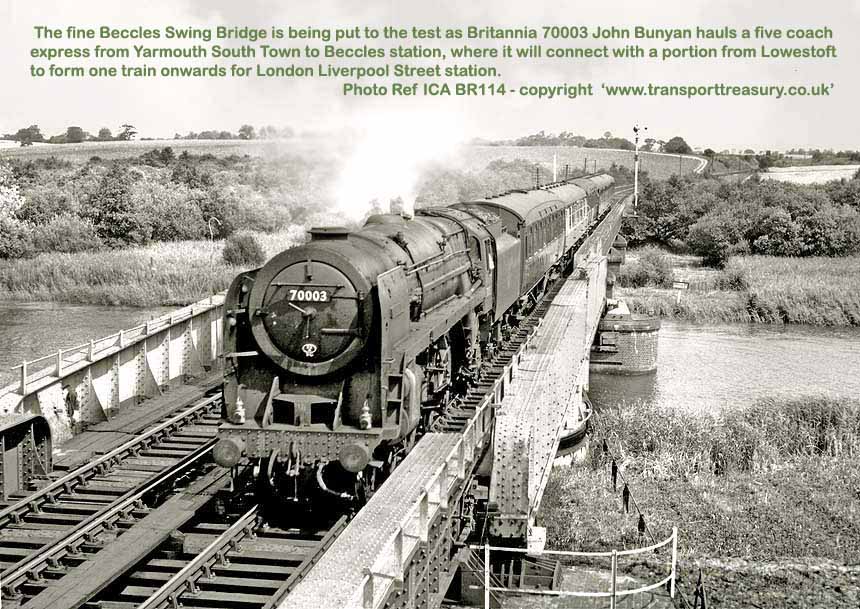
(Above) This lovely image by Dr Ian Cameron Allen is available from the Transport Treasury archives HERE dated May 1959, and shows one of the rivers that were a predominant feature in Norfolk; this being the River Waveney. The fine Beccles Swing Bridge is being put to the test as Britannia 70003 John Bunyan hauls a five coach express from Yarmouth South Town to Beccles station, where it will connect with a portion from Lowestoft to form one train onwards for London Liverpool Street station. Due to the high cost of maintaining such a highly mechanised structure, the Beccles Swing Bridge was to close just six months later; it was one of five operating in the area.
SERVICE RECORD: In 1951 a recorded mileage of 47,000 was returned and was deemed to be very good, given that 70003 John Bunyan did not work for four months of the year and the new Great Eastern timetable was not augmented until June the same year. In 1953 80,000 miles were clocked up and 98,000 in 1955, while 54,500 miles were achieved in 1954 despite spending a total of 13 weeks under repairs. 70003 was recorded as entering Stratford Works four times, Crewe Works on five occasions and a total of eight visits to Doncaster Works during his career. One failure in service noted, was early in 1966 when brake failure caused 70003 to imitate a snow plough near to Hellifield signal box when hauling a freight train.
SIGHTINGS: 70003 John Bunyan looked resplendent standing at Liverpool Street station ready to move off with the down 'Norfolkman' express passenger service to Norwich dated August 1951 and showing no changes from new except for the now higher dome visible on top of the boiler. In May 1953, 70003 was again observed hauling the 'Norfolkman' breasting Brentwood Bank with the down train and seen in beautiful condition yet again. The following year he was noted at rest in front of Jubilee Shed which was a small part of Stratford's vast complex, and seen in company of other Great Eastern types including a 4-6-0 B1 and a 4-6-0 B2 of Stratford shed also. Many views show 'John Bunyan' on titled-trains or specials and so it was in 1956 when pictured powering through Trowse Junction near Norwich Thorpe with the Up 'East Anglian' express heading for London, a journey that both 70003 and crew must have made many, many times over the years.
Soon after relocation to March depot, 70003 was captured at rest in the yard at Scarborough shed, which was overlooked by the local gasworks, and could be seen in a grubby condition reflecting a lack of cleaners available in 1961. That was in sharp contrast to his appearance on the RCTS Commemoration of Steam Railtour held on 31st March 1962, and showed how splendid the Britannia class could look when fresh from Works. 70003 worked the train from London Liverpool Street station to Norwich and was then replaced by a J15 0-6-0 class to cover the Norfolk part of the chosen route. When seen crossing the River Eden bridge in Carlisle, in 1964, 70003 was hauling a parcels train for Glasgow which was a typical task for a Britannia engine at this time - and typically the engine had steam leaking from the rear of the cylinder. In 1966 'John Bunyan' was pictured trying to imitate a snow plough near to Hellifield when the engine's brakes failed while hauling a freight train and became grounded. But shortly after this trauma, in March 1966, 70003 was seen in excellent condition at Penrith heading a sleeper train from Euston to Glasgow, although the service was about three hours late due to heavy snowfall overnight
DISPOSAL: Following withdrawal on 25th March 1967 the engine was stored out of service in the yard at Carlisle Kingmoor until late November and then transferred to G H Campbell's yard at Airdrie and cut up in December 1967.
(Below) All steamed up and ready for the off! Britannia class 4-6-2 No. 70003 John Bunyan was photographed at Carlisle Citadel Station by Ben Brooksbank for Initial Photographics in 1965. The engine is heading south and has all relevant modifications done by now, having joined the majority of the class at Carlisle Kingmoor, dubbed 'the last outpost of steam' as the last of the engines gathered there before final condemnation when Carlisle Kingmoor closed to steam at the end of 1967.
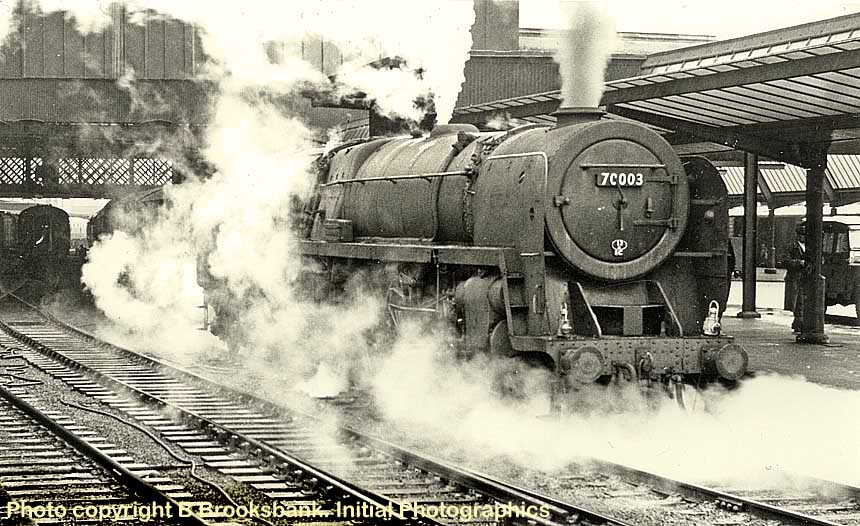
Programme authorised 17th November 1949, built at Crewe Works and completed on 30th March 1951, to Order No E479/220 costing £20,025. Withdrawal was on Saturday 30th December 1967 from Carlisle Kingmoor MPD.
ALLOCATIONS: 70004 'William Shakespeare' was nominally allocated to Stratford MPD (30A), but I am confident in saying that the new engine went directly to the 'Festival of Britain' at Marylebone Station, arriving there on the 2nd April 1951. A move to Stewarts Lane depot (73A) ensued and the engine became a relative fixture there until its transfer to Kentish Town (14B) in June 1958, however this lasted only a short four weeks spell as relocation to Trafford Park (9E) then took place. After a good stint of nearly two years and five months at 9E the Britannia took on a nomadic role and moved around the London Midland sheds; Willesden (1A) for 14 months, Aston (21D) just 8 weeks; back to Willesden (1A) for another 13 months, Carlisle Canal (12C) for only four weeks; then Carlisle Kingmoor (12A) for 7 weeks, yet again to Willesden (1A) this time for 17 months, until taking up residence at Crewe North (5A) until closure brought about a move to Stockport Edgeley (9B) working there for over two years before the inevitable end came at Carlisle Kingmoor (12A) from June 1967.
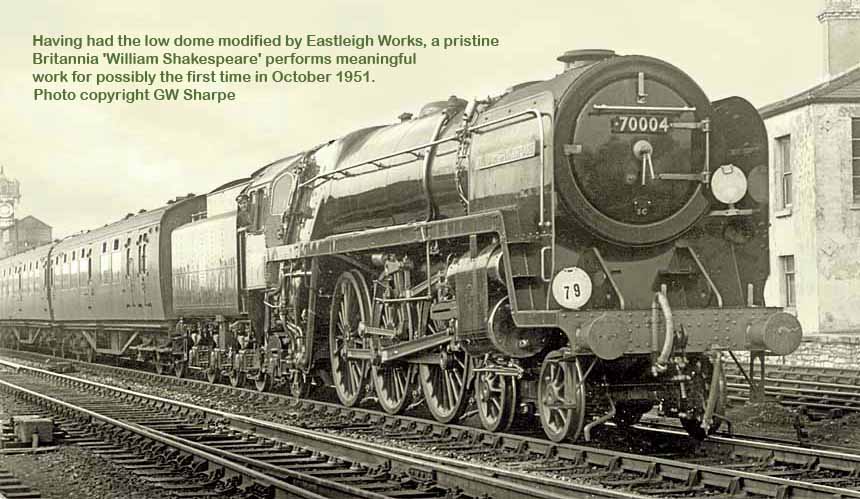
(Above-Inset) Seen passing through Southampton Central station with a boat train, is a very new BR Standard Pacific No 70004 'William Shakespeare' fresh from display at Marylebone station and showing much of that 'exhibition finish' on a sparkling exterior to which has been added two SR type lamp irons and
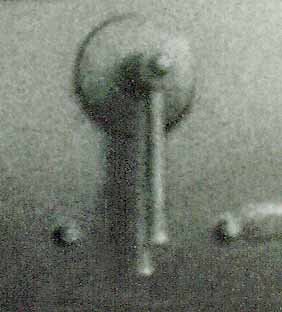 the extra fittings required for the 'Golden Arrow' haulage due to start very soon after this photo was taken.
the extra fittings required for the 'Golden Arrow' haulage due to start very soon after this photo was taken. (Inset) Close up shot of the fixing bolts on the lower part of the smokebox to support the 'Golden Arrow' headboard. The full-sized picture is featured below.
(Below) Since its calamitous incident with bent coupling rods at Headcorn, see 'Modifications' section below, by the time this photo of BR Britannia 70004 'William Shakespeare' was taken in May 1952 the locomotive had settled down and completed many trips without any issue. This wonderfully evocative image from AE West of the locomotive being turned at Dover shows the mix of coupling rods that the engine will retain throughout its service life. The fully regaled engine was a credit to all concerned; the preparation and daily cleaning of the locomotives rostered for the 'Golden Arrow' service improved even further following the arrival of Stewarts Lane's new Shedmaster, Mr Richard Hardy. On the left of the picture is the Lord Warden Hotel established in 1853 and to the right, the covered footbridge leading to Dover Marine Station.
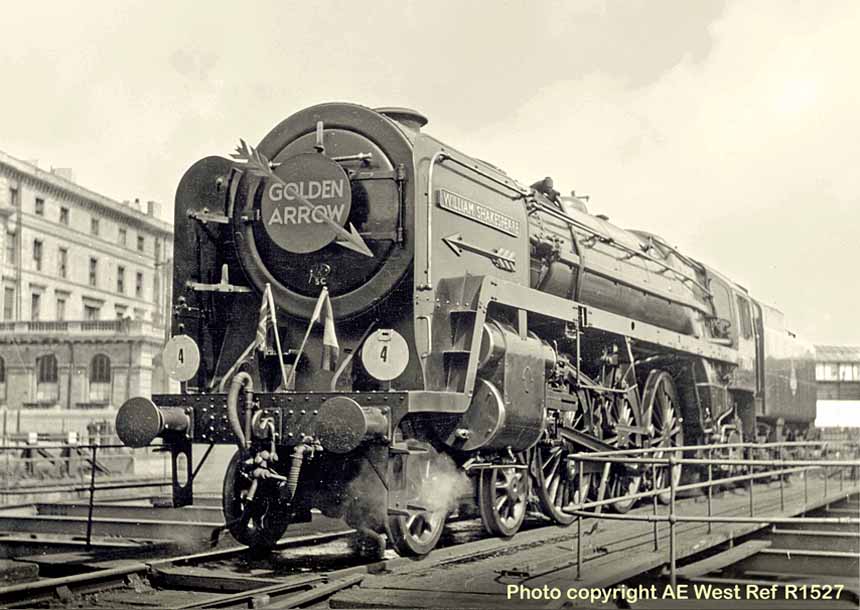

(Above) Almost done! Still of very low mileage and consequently in excellent condition, BR Standard Pacific No 70004 'William Shakespeare' waits to access the coaling stage at its home depot after returning from Dover with the up 'Golden Arrow' in June 1952. Stewarts Lane's new Shedmaster Mr. Richard Hardy would very soon be exerting his influence on the condition of the two Britannia locomotives allocated to the
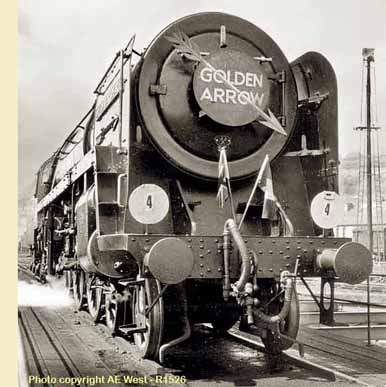 depot - No 70014 'Iron Duke' being the other. The daunting building overshadowing the engine is the old Hamptons Warehouse, which was soon to be rejuvenated and used to stock house furnishings.
depot - No 70014 'Iron Duke' being the other. The daunting building overshadowing the engine is the old Hamptons Warehouse, which was soon to be rejuvenated and used to stock house furnishings. (Inserts) The origin of the 'Golden Arrow' luxury Pullman train began in 1926 when a new all-first-class French Pullman train called the 'Flèche d'Or' first ran between Calais and Paris, with a connecting ferry service to Dover. On 15th May 1929 the Southern Railway introduced a Pullman service of its own, with both the new 'Golden Arrow' and 'Flèche d' Or' trains departed London and Paris at 11.00am; the British train being comprised of ten Pullman cars. At the outbreak of World War II the luxury Pullman was suspended until hostilities ceased and the service
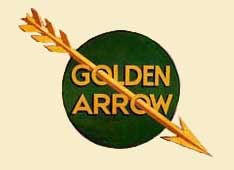 wasn't resumed until 15th April 1946. In 1951 the Southern Region commissioned the design of the 'Golden Arrow' headboard to coincide with the introduction of the new Britannias. The 33" diameter circular steel headboard was painted a shade lighter green than the Brunswick Green worn by the engine, while the lettering and three-flight arrow - measuring 66" from tip to tail - was finished in a gold colour. The tricolour flags were, of course, red, white and blue representing both British and French countries and these needed to be laundered daily; this close-up shot (above right) shows one of the lower retaining brackets, just visible behind the board attached to BR Pacific No 70004 at Dover in 1952.
wasn't resumed until 15th April 1946. In 1951 the Southern Region commissioned the design of the 'Golden Arrow' headboard to coincide with the introduction of the new Britannias. The 33" diameter circular steel headboard was painted a shade lighter green than the Brunswick Green worn by the engine, while the lettering and three-flight arrow - measuring 66" from tip to tail - was finished in a gold colour. The tricolour flags were, of course, red, white and blue representing both British and French countries and these needed to be laundered daily; this close-up shot (above right) shows one of the lower retaining brackets, just visible behind the board attached to BR Pacific No 70004 at Dover in 1952. (Below) Arguably the best sight on British Railways during the 1950s was the 'Golden Arrow' a luxury Pullman Car train hauled by the famous BR Standard Pacific No 70004 'William Shakespeare' as viewed here by BKB Green for Initial Photographics in July 1952, when the names of the Pullman Cars were Aquila, Carina, Cygnus, Hercules, Isle of Thanet, Minerva, Orion, Pegasus, Perseus and Zena. The stock had been built for the 'Festival of Britain' exhibition at London, however the original order was placed much earlier but this was suspended due to the onset of WWII. The train would have been travelling at the regulation speed of 50 mph which was purely down to the experienced judgement of the driver as the locomotive was never fitted with a speedometer, in fact precious few engines in 1952 would have been.
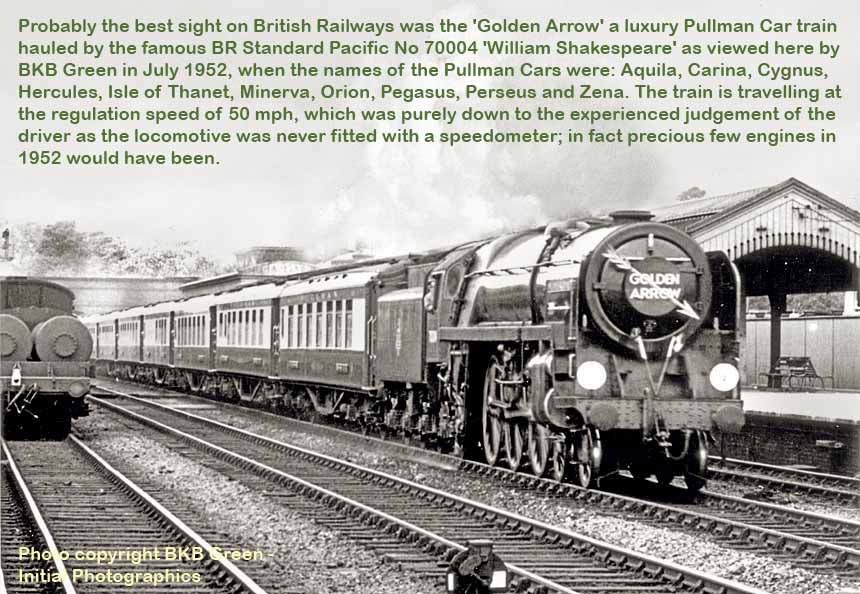
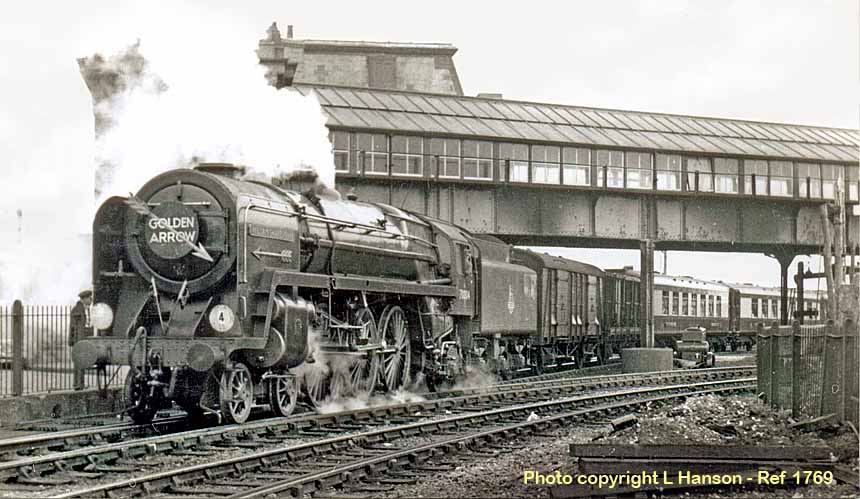
(Above) A stirring sight to behold photographer Les Hanson, as BR Pacific No. 70004 'William Shakespeare' blasts away from Dover with the London-bound 'Golden Arrow' Pullman Car boat train in August 1952. With the steam-operated sanders being put to good use, the decorated engine makes for a memorable image as it hauls the 10 luxury Pullman cars plus at least two baggage vehicles, a combined weight of around 480 tons. The route back to London was determined by the timing of the disembarkation of the train, with four possible paths including via Chatham, which was used regularly.
MODIFICATIONS: Before completion of 70004 a decision was taken to upgrade the already quality finish of a Britannia locomotive to the extreme and the result was deemed the famous 'Exhibition Finish'; the level of polished fittings was surely never bettered, while the highly polished Brunswick Green livery glistened, the wheels and motion rods were burnished, the handrails and grab handles given a chrome finish, as were the cylinder end covers. The locomotive frames were also given treatment not seen before; the outer facings were finished in black enamel, while the inner were given a red enamel coating to give added surface protection. The low dome (item 6) was left in place until the 'Festival' had ended late in September 1951, being replaced at Eastleigh Works shortly after, while both the fixing points for the Golden Arrow headboard on the smokebox door and the small 'arrows' on the smoke deflectors were added after their exact positions were worked out and captive nuts affixed. The opportunity was also taken to fit the required extra lamp irons (SR type) to the lower stays of the smoke deflectors, a necessary requirement when running on Southern metals...continued below.
(Below) Following the death of King George V1 in February 1952, preparations for the coronation of Queen Elizabeth II on 2nd June 1953 were long running. With just two days to go before this historic event, AE West captured a wonderful image of the highly polished and carefully prepared BR Pacific 70004 'William Shakespeare' amid the grubby surroundings of Dover Motive Power Depot. The tender of the locomotive is being replenished at the manual coaling stage in readiness to haul the Royal Train conveying the future Queen and Prince Philip to London for the start of the coronation celebrations.
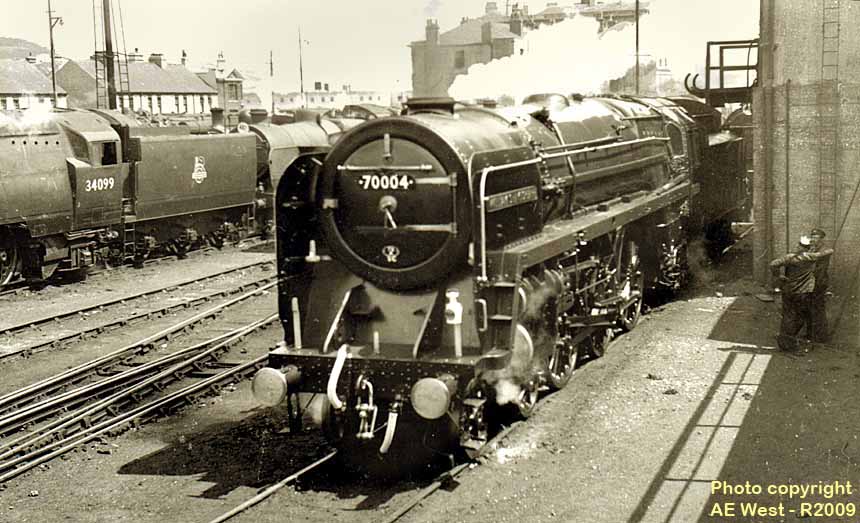
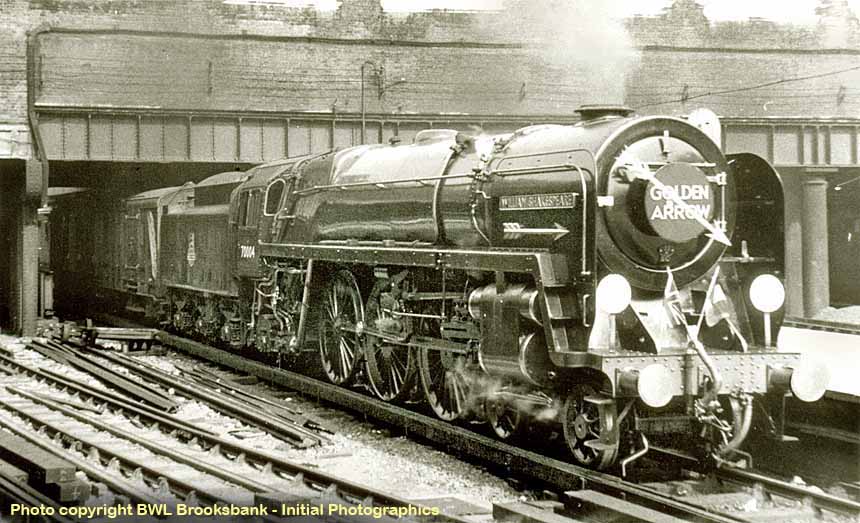
(Above) The much-travelled railway photographer, Ben Brooksbank, roamed all parts of the rail network to record the passing of BR steam, but surely none more memorable than his photo of BR Class 7MT 70004 'William Shakespeare' with full decoration on the 'Golden Arrow', encapsulated here departing platform 8 at London Victoria Station beneath Elizabeth Bridge in September 1953. The exquisitely turned-out locomotive owed much to the Shedmaster at the 'Lane', Mr Richard Hardy, who gained much respect from his staff to which he willingly reciprocated. The polished buffers complement the white discs which are sitting atop the long irons, a remedy to the problem of headlamps 'blowing out' in the cold days of winter, causing the train to be halted by signalmen who could not identify the train.
Unfortunately the first few weeks of actual running were badly marred by a calamitous breakdown for the nearly-new Britannia 70004 'William Shakespeare' when the coupling rods bent while hauling the up 'Golden Arrow' through Headcorn in mid-Kent. The consternation and confusion caused by this setback had severe repercussions as the actual cause was not yet fully understood; the immediate result was that the stricken locomotive was dragged to Ashford for Works attention. A decision was taken to return the engine to base and 70004 was subsequently towed to Crewe Works, where inspections were made and new coupling rods (item 14) fitted. As seven of the Class had failed in a short space of time, all Britannia engines were formerly withdrawn from service pending further stringent investigation. Meanwhile 70004 was back in action, but only for three weeks before undergoing full Axle modification (item 17) at Swindon Works, where plain coupling rods (item 14) were fitted to the front and fluted (original) variety to the rear before resuming duties halfway through January 1952. By the end of 1952 the operating staff was having difficulties with the train lamps extinguishing when hauling the 'Golden Arrow'; this was solved when long lamp irons (item 2) were fitted by Stewarts Lane shed staff, one on either side of the buffer beam.
The year after at Swindon Works, 70004's normal venue at this early stage, a number of relatively minor items were completed, including the flexible cab sheet (item 9); tender steps (item 10); raised sand box lids (item 16) and the front regulator rod support bracket (item 5) was added, although it was fitted in a way peculiar to Swindon, using the handrail for support. The original vacuum pipe (item 21) was revised during a standard visit to Crewe Works at the close of 1954 and much to the chagrin of the staff at Stewarts Lane, the long lamp irons (item 2) were removed and discarded, the burnished buffers were painted over, as were the cylinder end covers. The extra long irons soon returned as they were deemed imperative to the smooth running of the prestigious 'Golden Arrow', while on subsequent Works visits Crewe fitted a full front step (item 1); the original LNER return crank (item 15) was replaced with the Crewe-preferred LMSR type, secured with four set-pins; the nearside lubrication operating rod (item 18) was shortened and the support bracket (item 7) was added to the regulator operating rear rod, while the front support (item 5) was changed to the standard LMR type. These items were completed in early 1957, but very little changed for 70004 'William Shakespeare' over the next two years, only the power warning plates (item 19) being attached by Crewe in April 1959. By this date most of the Class would have had more items modified, but 70004 was not fitted with either the AWS equipment (item 20) or a speedometer (item 13); the smoke deflectors (item 3) were not revised from original and the new BR emblem (item 11) did not appear until late in 1963. The LMR lamp irons (item 2) were repositioned due to safety reasons, but the additional SR irons stayed put to the bitter end. The original livery (item 12) on 70004 'William Shakespeare' remained until 1965, when unlined Brunswick Green paint was applied, but plain black lining was used on the tender and the cab sheets, adapted by the staff at Stockport Edgeley depot.

(Above) From the sublime to the ridiculous; the prestigious Pullman Car train, the 'Golden Arrow' hauled by the exceedingly well presented 70004 'William Shakespeare' was the most glamorous and luxurious train on British Railways, but the long-standing facilities at Folkestone Junction lend themselves to another era entirely, as the crew pick out some suitable briquettes to add to the firebox. Of note on the engine was the missing cab flexible sheet that has been removed for the warmer summer months and will be refitted for the cooler days ahead.
(Below) A superbly presented Britannia Class 7MT No. 70004 'William Shakespeare' is witnessed by the redoubtable BKB Green for Initial Photographics at Folkestone Junction on a fine summer's day in 1954. The locomotive is now displaying 7P6F on the cabside and is ready to move off with the 'empties' down to Dover Marine station in anticipation of the incoming ferry passengers; the stock would have been brought back to the platform by at least three resident engines, usually two Class R1 0-6-0Ts at the head and a third, or even a fourth attached to the rear of the train, thus safely transporting the Pullman Cars down to Folkestone Harbour, where the Britannia was not allowed.
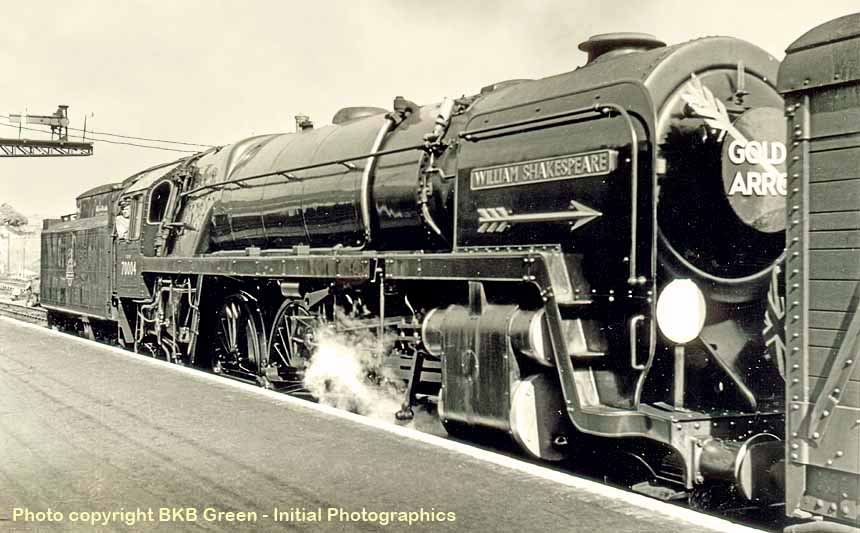
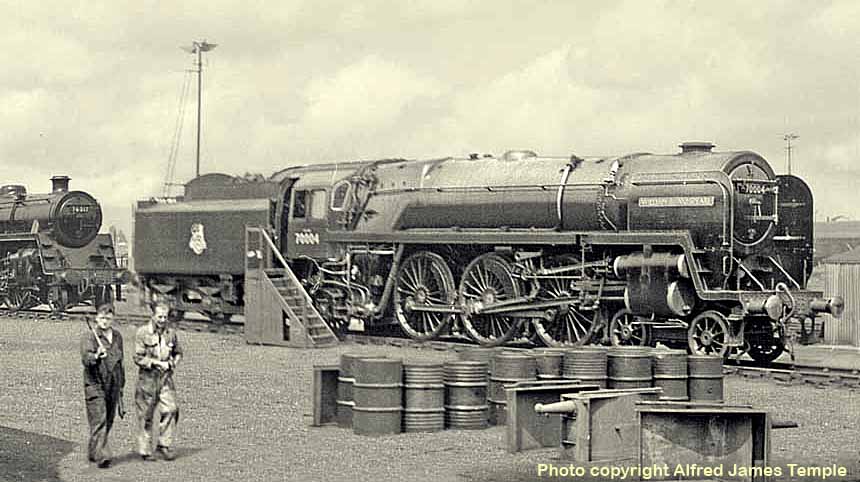
(Above) The expansive yard at Eastleigh Works is the scene for this interesting picture from the Alfred James Temple Collection and records the 'Open Day' that occurred in August 1954 to display the best locomotives available to the Southern Region at that time plus a couple of veterans to add to the mix. One of the two BR Standard Pacific on loan to the Southern Region, No. 70004 'William Shakespeare' is taking a break from duties on the 'Golden Arrow' to be an integral part of the day's proceedings and show how easy it is to gain access to all and sundry on the locomotive when compared to the original Merchant Navy or West Country Pacifics, which were also on display, along with a very new BR Standard Class 4 4-6-0.
(Below) A lovely image from Lens of Sutton Association depicting how the 'Golden Arrow' train was manoeuvred into the starting position at London Victoria station; a ubiquitous Class 'H' 0-4-4T brings the consist from the carriage cleaning works and allows BR Standard No. 70004 'William Shakespeare' to attach at the rear to assist up and over Grosvenor Bridge, then down the incline into platform 8 at the famous old station. This 1955 scene sees the engine under the footbridge, nearest the camera, and the viaduct carrying the Victoria to Wandsworth lines, while the further bridge is a link from Brixton onto Clapham Junction routes.
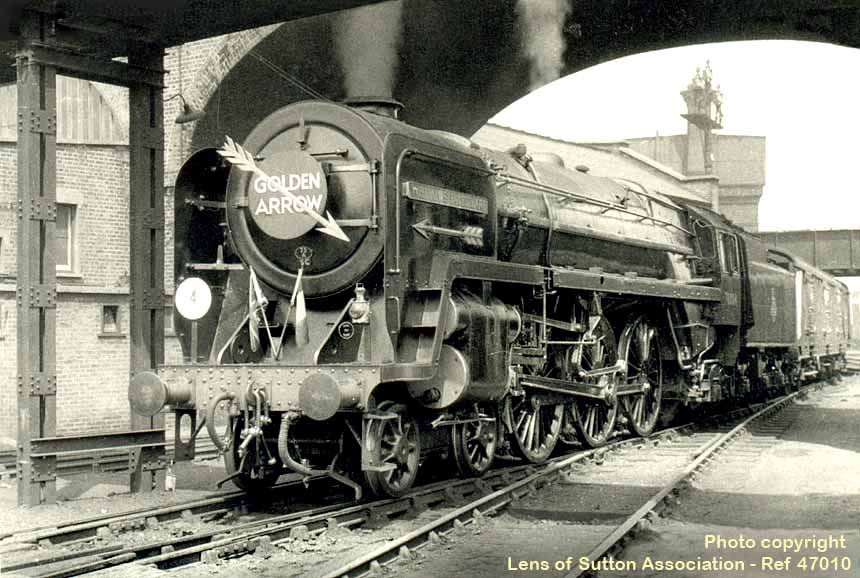
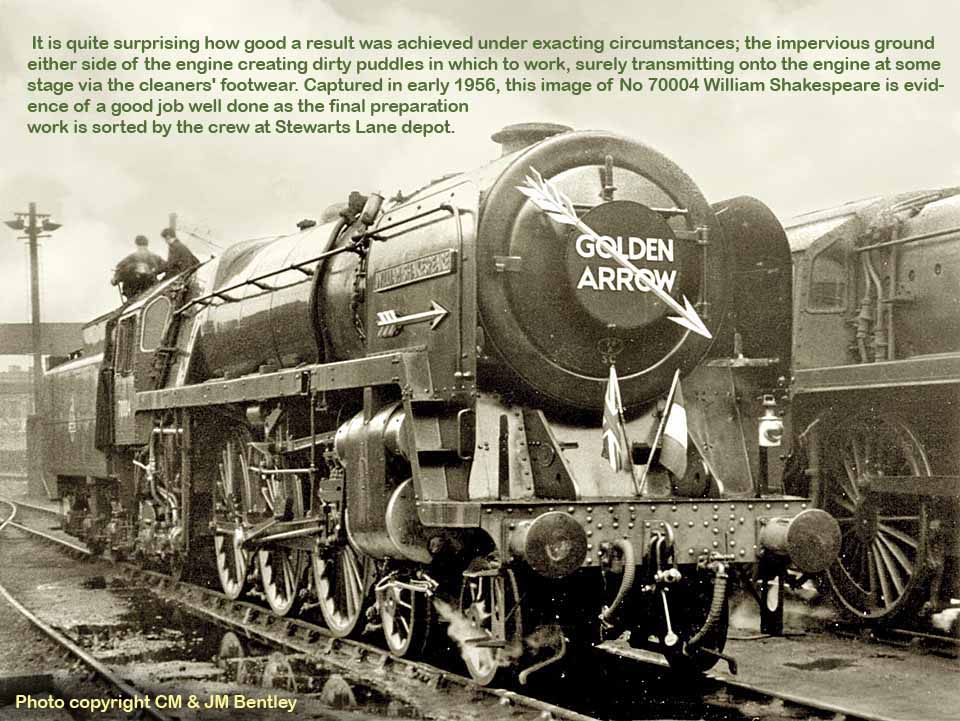
(Above) It is quite surprising how good a result was achieved under exacting circumstances; the impervious ground either side of the engine creating dirty puddles in which to work, surely transmitting onto the engine at some stage via the cleaners' footwear. Captured in early 1956 by CM & JM Bentley this image of BR Class 7MT No. 70004 'William Shakespeare' is evidence of a good job well done as the final preparation work is sorted by the crew at Stewarts Lane depot. In company with the Britannia is a Standard Class '5' 4-6-0 engine, a number of which spent all their short careers working from Southern Region depots, including this one.
(Below) Another fine print from Lens of Sutton Association, showing BR Standard Pacific No. 70004 'William Shakespeare' being prepared for 'Duty 4' at Stewarts Lane depot in London. By this time Mr Richard Hardy had left for pastures new after two and a half years as Shedmaster, but his set daily routines for the two Britannias were still adhered to and his experienced assessment of the two Britannias was that they had 'plenty of guts'; indeed the pair were liked by all especially the maintenance staff and stores people. A few changes had been made since the previous year, but only superficially; front footstep; LMSR return crank and a shorter lubricating rod, nearside.
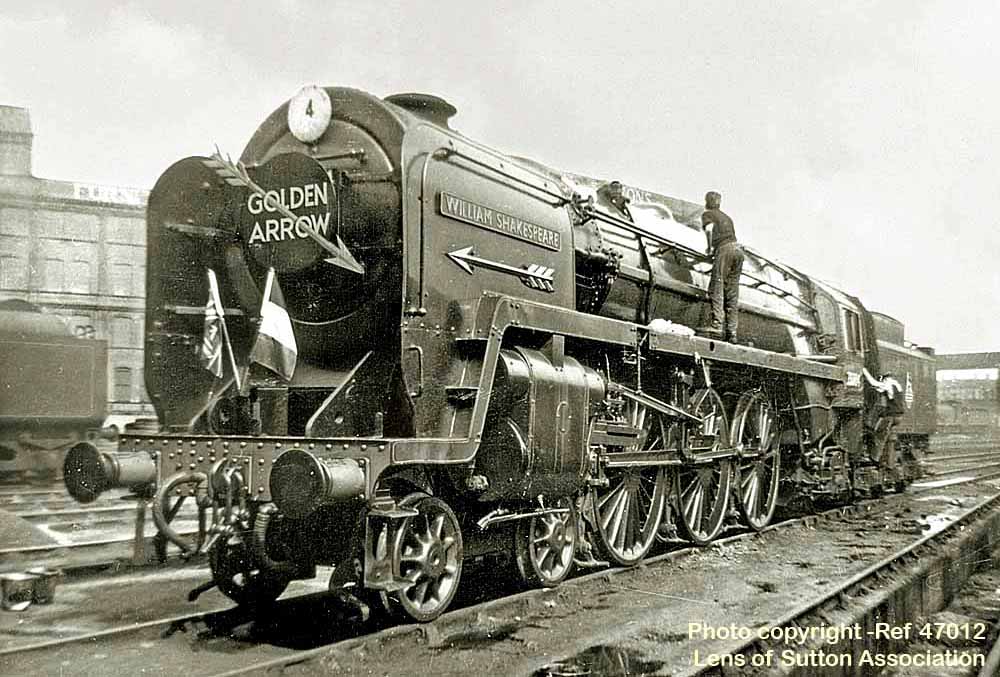
SERVICE RECORD: 70004's service record was unique among the BR Britannia Class 7s, for the locomotive entered five different Railway Works throughout its career; in addition to the normal Crewe and Swindon visits, the locomotive was seen at Eastleigh, Ashford and Darlington. Recorded visits to Crewe Workshops amounted to thirteen, albeit some of them were for minor attention only. Five recorded entries to Swindon Works were for adjustments mainly, but one visit included a Light Casual service when the Axle modification was completed. The embarrassing failure on the 'Golden Arrow' after only a few weeks of running was the reason for entering Ashford, while a slight mishap saw the Britannia visit Darlington Workshops for repairs to the offside front of the engine, including a new smoke deflector sheet, being released in January 1966. Following its the catastrophic mishap with bent coupling rods at Headcorn. 'William Shakespeare' was again in trouble when complaints surfaced concerning oscillations in the front Pullman Cars, and to allay this problem one of the fourgons (baggage cars) was moved from the rear of the consist to immediately behind the engine, which cured the problem thereafter. The engine hit further trouble when hauling a Southampton boat train; the front bogie wheel derailed and the locomotive lurched and jammed against the wooden platform, leaving passengers unable to detrain in the normal way. Because No 70004 was the first choice engine assigned to 'Duty 4' - the luxury 'Golden Arrow' Continental Boat Train - such a prestigious working required an equally meticulously clean and well-prepared engine, and this reflected in 70004's low average recorded figure of only 33,000 miles over the seven year period. Yet the average was only marginally better for the subsequent two years when working over Midland metals. As a result the engine returned the lowest mileage figures of the class overall, yet throughout its career it remained arguably the Class 7MT's most renowned member; the sight of a sparkling, glistening and bedecked locomotive at the head of a Pullman Car Train dashing through the Kent countryside is one that lives long in the memory, not forgetting the similar role dutifully performed by the Southern Region Merchant Navy Class and West Country Pacific engines. The normal route used from London Victoria was Herne Hill, Beckenham, Bickley, Orpington, Seven Oaks, Tonbridge, Paddock Wood, Ashford, Folkestone Junction and Dover Marine, a distance of 77 miles, but one that was a proverbial switchback, with no level sections save for a short stretch at Tonbridge. Aside from the 'Golden Arrow' duty, 70004 'William Shakespeare' was known to have hauled the 'Pines Express' and the 'Palatine' when in service on Midland routes and also noted on a relief 'Irish Mail' train during 1962. The Britannia was selected for six Rail Tours during 1966, partly due its recent overhaul at Crewe Works, though the choice for the Shakespearian Rail Tour was a simple one, the engine was not originally selected for the 'A2 Commemorative' Rail Tour, but had to step into the breach when 60532 'Blue Peter' failed on Honiton Bank.
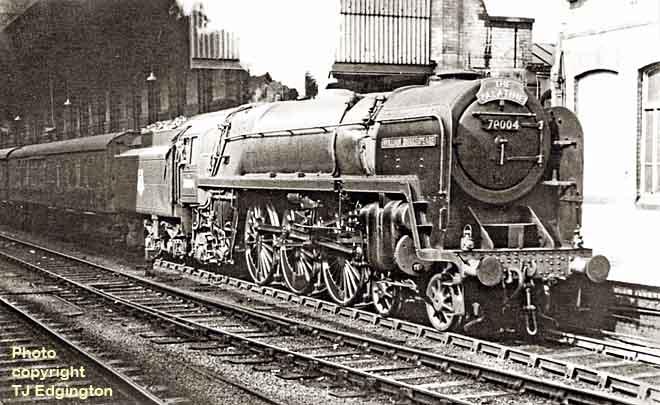
(Above) Photographer TJ Edgington certainly was 'quick on the draw' to witness the arrival of ex-SR allocated BR Pacific 70004 'William Shakespeare' to the Midland route from St Pancras through to Manchester as the Britannia had been recently allocated to Kentish Town MPD in London, having spent the best part of seven years hauling the marvellous 'Golden Arrow' Pullman Car train. The 1894-built train shed is featured as the crew take a breather at Leicester London Road station working the down 'Palatine' towards Manchester Central station.
(Below) Ten year-old Britannia 70004 'William Shakespeare' is seen preparing to return to Crewe from the north end of Shrewsbury Station, having received a Light Casual service at its birthplace where its 'Exhibition Finish' was applied and some aspects of it can still be found by close scrutiny. It is surprising that the tender is still displaying the old style British Railways emblem when most engines have already been upgraded and while the power warning plates have been added, the centre lamp iron is now missing (broken off).
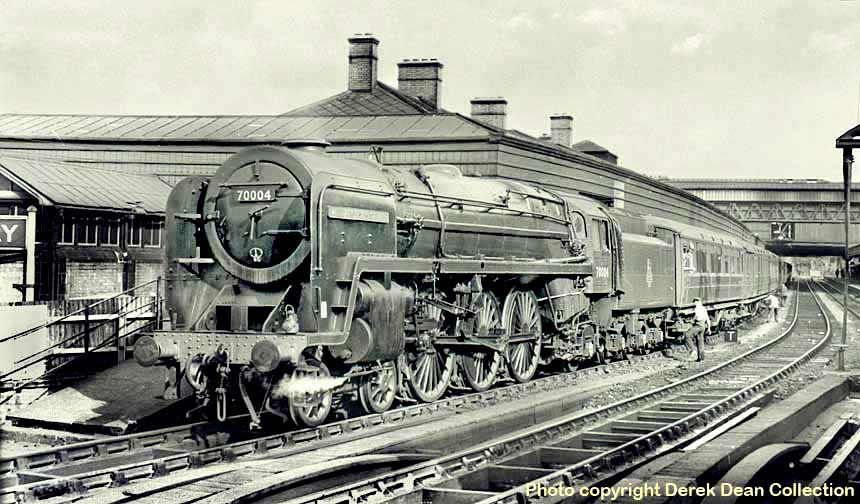
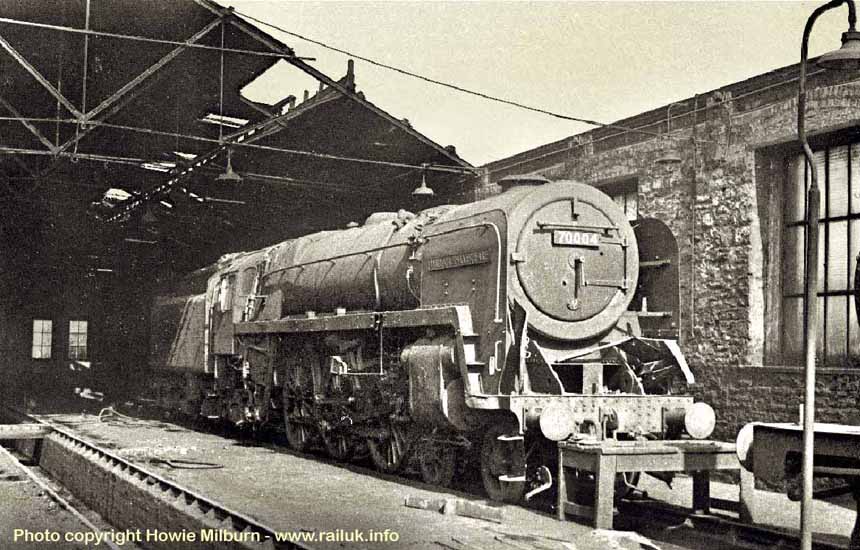
(Above) Many thanks to Howie Milburn, proprietor of the excellent 'Rail UK' HERE, for allowing us to illustrate this rare image here. The imminent closure of Carlisle Canal depot prompted the removal of BR Standard 70004 'William Shakespeare' to nearby Kingmoor MPD. The loss of Canal Road's long-standing allocation of Gresley A3 Pacifics in 1961, saw the arrival of two Britannia engines for a time, but quite why the ex-Stewarts Lane 'pet' was transferred here is a mystery and if the haulage of the 'Golden Arrow' was the locomotive's Zenith, then this picture depicts its Nadir.
(Below) As one part of the LCGB's Conway Valley Rail Tour in September 1966, BR Pacific 70004 'William Shakespeare' was photographed at Prestatyn station by BKB Green. The external appearance of the locomotive is a credit to those enthusiasts who have helped in that regard, also the staff at Stockport Edgeley (9B) for the application of the lining on tender and cabside giving the austere paintwork some distinction. Photographic opportunity was made on this second leg of the journey from Crewe to Llandudno Junction, the engine making way for two Stanier tank engines nos. 42574 and 42644, taking the train on to Blaenau Ffestiniog, the heart of Snowdonia and famous for slate.
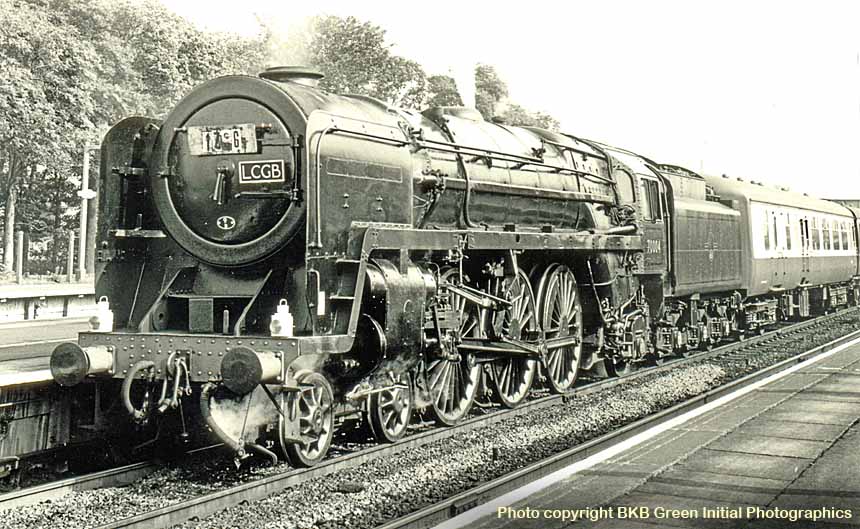

(Above) Mirfield Railway station was part of a major Lancashire & Yorkshire Railway route across the Pennines, but was gradually downgraded, starting with the removal of the overall roof in 1977. Here we see the now unnamed Britannia Pacific 70004 beneath the somewhat basic train shed, having arrived with a parcels train from the Manchester area, as witnessed by prolific photographer S.V. Blencowe in May 1966. Following an altercation with a wagon, the offside smoke deflector sheet was replaced, but it appears that the valance was simply hammered out to a respectable condition, due to austerity measures firmly in place from 1963.
(Below) Very many express engines types saw service from Carlisle Upperby depot, even up to closure of the shed facilities at the end of 1966, which was, after all, just 8 years from being rebuilt as a concrete roundhouse. In all, 19 Britannias were allocated there for some time from the back end of 1963, which was in the middle of that awful winter and there were 11 of those still resident when the shed finally closed. Clive Fields image shows a tired-looking engine nearing the end of its service as Stockport Edgeley-allocated BR Standard 70004 stands at rest awaiting its next duty.
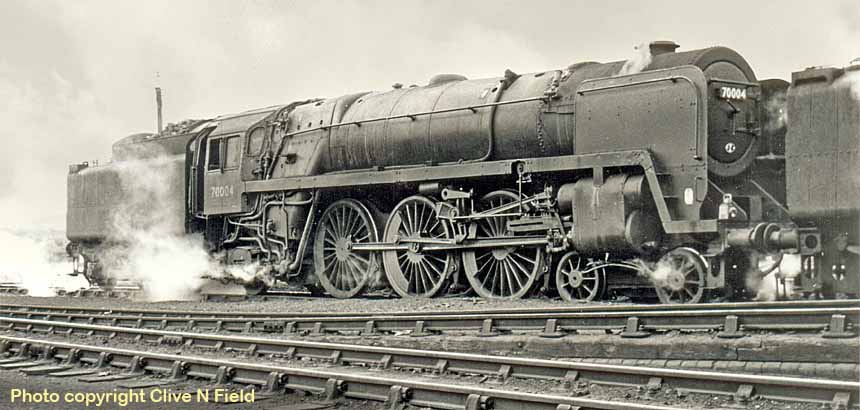
SIGHTINGS: Innumerable prints and photographs have been published to show the glory and spectacle of BR's premier Continental Boat train in the charge of Britannia Pacific No. 70004 'William Shakespeare', but precious few thereafter, which is perhaps to be expected; certainly the engine lost most of its appeal when joining the ranks of the 'down and dirty' during the early part of the 1960s. The first images were taken by British Railways official photographers as the superbly presented Britannia was displayed at London Marylebone Station as part of the 'Festival of Britain' from early April 1951 until the end of September. The Britannia was over its traumatic incident and failure on the 'Golden Arrow' when observed at Dover, light engine, in March 1952 and showing slight signs of wear and tear as the offside front corner was bumped and some areas of the locomotive were far from clean, though this was the period before Mr Richard Hardy started work at Stewarts Lane depot to oversee the daily attention required by the engine on 'Duty No 4'. The up 'Golden Arrow' hauled by the resplendent BR Pacific was witnessed at Shorncliffe station, a little way off Folkestone Junction, powering its way West and passing the small goods yard and a stationary SR tank engine at platform 1, all viewed during August 1952. The SER station used to be named 'Shorncliffe Camp' because of the nearby Army base, which saw 40,000 Canadian troops stationed there in the early stages of WWI, but later the 'Camp' part was omitted and in September 1962 the station was renamed 'Folkestone West'. In 1954 the wondrous sight of the Britannia crossing the road in front of a passive audience was captured on film at Canute Road, Southampton showing a pristine 'William Shakespeare' hauling a Channel Islands boat train (Duty 40) for Waterloo.
Many Britannia class engines have put in an appearance at Derby Works Open Day, and in 1959 it was the turn of 70004 'William Shakespeare', much to the obvious delight of schoolchildren who took great pleasure in clambering over every conceivable part the locomotive, including the top of the cab, a height of 13 feet. During 1961 the engine was seen by myself many times running down the bank from Monument Lane towards Birmingham New Street Station hauling what I believe to be a train from Manchester and while there were certainly other class members on the same turn, it was the lordly appearance of 'William Shakespeare' that still lingers in the memory. The new British Railways Corporate emblem finally made its appearance on the Britannia late in 1963 and was easily the last to be amended, being photographed at Crewe North very early in 1964 prior to a Works visit. A subsequent visit to Crewe resulted in 70004 'William Shakespeare' being selected for no less than six Rail Tours between June and November in 1966. The first of the LCGB organised Rail Tours was nominated 'Fellsman Tour' and involved three Stanier 4-6-0s along with 70004
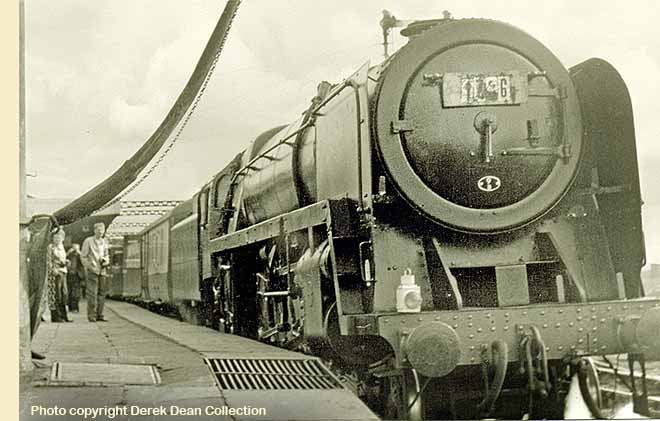 displaying hand-painted nameplates and an austere, but very clean livery, as it hauled the train from Liverpool Lime Street to Carnforth on 4th June 1966.
displaying hand-painted nameplates and an austere, but very clean livery, as it hauled the train from Liverpool Lime Street to Carnforth on 4th June 1966.(Insert) No details with this image, but I was intrigued to discover the why and the wherefore. The two main recognition points are the extra lamp irons, SR type and the '9B' shed allocation which easily leads us to the locomotive's identity - 70004, now devoid of its 'William Shakespeare' nameplates with a new deflector sheet on the offside, fitted by Darlington Works very late in 1965. Note the two fixing bolts on the lower part of the smokebox to support the ornate 'Golden Arrow' headboard, which incidentally, was replaced in the early 1960s when the service was taken over by the 2,550hp third-rail electric locomotives (later Class 71) and a plain headboard was deemed more suitable. As for the location of this shot; it is a second picture of the LCGB 'Conway Valley Rail Tour' 1Z36 which ran on 24 September 1966; the Britannia is about to come off the train at Crewe to be replaced by an electric locomotive for the final leg of the tour back to London Euston. Check out the 'Six Bells Junction' site. HERE.
DISPOSAL: Withdrawal took place on Saturday 30th December 1967 at Carlisle Kingmoor MPD and disposal was from Carlisle Viaduct Yard. The engine was stored until March 1968 then transferred for cutting up at TW Ward of Inverkeithing during April 1968.
Programme authorised 17th November 1949, built at Crewe Works, completed 7th April 1951 to Order No.E479/220 at a cost of £20,025. Withdrawal took place on 29th July 1967.
ALLOCATIONS: First allocated to Stratford (30A), but was chosen for steaming capability testing at Rugby Testing Station during April and May, then again in December 1951; also in January 1952 the engine was used on the Settle and Carlisle line in Artic conditions. As far as I know, no results were announced, but at the time of the testing, but in his authorative book on British Pacific Locomotives, Cecil J. Allen states that the design staff had every reason to be content with the performance the Britannia boiler, which was said to be capable of any task that was asked of it. 70005 spent almost 12 years on the Great Eastern section, finding further employment at Norwich (32A) from January 1959, and then March (31B) from September 1961, Willesden (1A) from March 1963, Aston (2J) in December 1963, until moving to Carlisle Kingmoor (12A) in October 1964 to eke out its days along with 24 other class members.

(Above) A fine study of No 70005 John Milton being turned at London Liverpool Street Station on 18th June 1959; the railwayman appear to be checking the hose connected to the vacuum operated turntable (the vacuum was derived from the locomotive's ejector). The turntable is also fitted with huge tanks to enable locomotives not equipped with the vacuum braking system to be turned.
MODIFICATIONS: The first to be done, in June 1951, was the low dome (item 5) on the top of the boiler and as explained above on page 91 and under 'Service Record' below, there were occasions when water would
 find it's way into the cylinders causing actual damage. This was followed by the repairs to the drive axle centres (item 17), not noted in the records, as such, but it would seem to have been done at Crewe Works during March 1952, in the case of 70005. The flexible cab sheet (item 9) was fitted in June 1953; this was to prevent excess draught around the back of the footplate. It should be noted at this point that the first production Britannias, nos. 70000-70003, 70005-70013 did not have the sand box lid modification (item 16), at any time, but the rest of the class did, either in production, or in addition at a later date. The tender steps (item 10) were eventually added, in January 1956, to the sloping sides of the BR1 type locomotive tender to aid the crew when refilling with water, as it was found to be hazardous especially if the surface was wet. During August 1957 the front step (item 1) was modified to the full specification, at Doncaster Works, followed by the smoke deflector modification (item 3) in April/ May 1959 to the standard LMR type. At this time the Automatic Warning System (item 20) was fitted, this being
find it's way into the cylinders causing actual damage. This was followed by the repairs to the drive axle centres (item 17), not noted in the records, as such, but it would seem to have been done at Crewe Works during March 1952, in the case of 70005. The flexible cab sheet (item 9) was fitted in June 1953; this was to prevent excess draught around the back of the footplate. It should be noted at this point that the first production Britannias, nos. 70000-70003, 70005-70013 did not have the sand box lid modification (item 16), at any time, but the rest of the class did, either in production, or in addition at a later date. The tender steps (item 10) were eventually added, in January 1956, to the sloping sides of the BR1 type locomotive tender to aid the crew when refilling with water, as it was found to be hazardous especially if the surface was wet. During August 1957 the front step (item 1) was modified to the full specification, at Doncaster Works, followed by the smoke deflector modification (item 3) in April/ May 1959 to the standard LMR type. At this time the Automatic Warning System (item 20) was fitted, this being 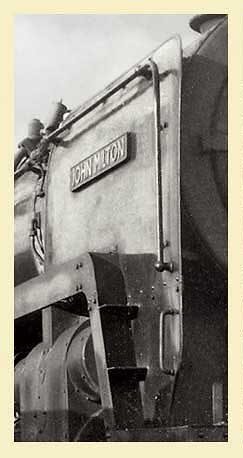 British Railways version of the Great Western Railway's Automatic Train Control, from 1927, for automated brake operation, giving better safety to all involved. The next modification carried out was the speedometer unit (item 13) which was fitted to the nearside drive wheel, via an offset crank, and dated April 1960, which was late in time, given that the engine was 9 years old. The only other general modifications that followed, were the power warning flashes (item 19) and the lamp irons (item 2) to be repositioned to what was seen as a safer, lower position on the smokebox, these being mostly done by shed staff.
British Railways version of the Great Western Railway's Automatic Train Control, from 1927, for automated brake operation, giving better safety to all involved. The next modification carried out was the speedometer unit (item 13) which was fitted to the nearside drive wheel, via an offset crank, and dated April 1960, which was late in time, given that the engine was 9 years old. The only other general modifications that followed, were the power warning flashes (item 19) and the lamp irons (item 2) to be repositioned to what was seen as a safer, lower position on the smokebox, these being mostly done by shed staff.SERVICE RECORD: 70005 John Milton did not suffer many of the defects which beset a lot of the early members of the class, such as damaged pistons. This was because the first 7,000 miles were done at Rugby on test, and therefore did not do the 'to-ing and fro-ing' as in normal running service, and it was this that caused water to find it's way into the cylinders and do damage to the pistons. Also the engines which succumbed to axle shifting were all of low mileages (strangely), such as 70004 and 70014, whereas 70005 had been busy on test and in normal service on the Great Eastern section. It is recorded that 70005 covered 78,900 miles in 1953, which included 4 weeks going in and out of works twice. The Great Eastern section Britannias were scheduled to run from London Liverpool Street Station to Norwich and back twice daily, and it was not uncommon for them to cover over 450 miles daily. The normal routes covered were not over flat terrain, but encountered a fairly switchback ride, being either going up or coming down an incline, such as Brentwood Bank, Beccles Bank, the climb to Trowse
 Junction, going south, and up to Wickham Market also. The track between Ipswich and Beccles was also very hilly, with no level sections at all on route, although there were no sustained climbs as on other routes around Britain. Named trains pulled by 70005 and other class members, would have been the likes of 'The East Anglian' or 'The Norfolkman' and 'The Easterling, also 'The Essex Coast Express' and 'The Hook Continental' which was a boat train linking London to Holland. After transfer to Norwich Thorpe MPD (32A), 'John Milton would still have been seen on the same turns as previously, but as with many other engines, the exterior condition was beginning to deteriorate, due to the lack of any regular cleaning being done. 70005 suffered cylinder lining defects in both 1960 and again in 1961, being repaired at Doncaster Works on both occasions, and also in the same year was seen with a front step (item 1) that had the central support missing altogether, looking rather strange and also being of a slightly dangerous situation. Shortly after this 70005 was allocated to March MPD (31B) in Cambridgeshire along with 12 other class members, 70000/1/2/3/6/7/8/9/10/11/12 & 70013, some taking over from 70034/35/36/37 & 70038, having arrived late in 1960. These locomotive movements were, of course, due to the influx of the new diesel fleet on Great Eastern metals, and were seen as the beginning of the end of the useful life of the Britannias, because more often than not, they would be seen on freight and parcel train duties, and increasingly less so on passenger workings.
Junction, going south, and up to Wickham Market also. The track between Ipswich and Beccles was also very hilly, with no level sections at all on route, although there were no sustained climbs as on other routes around Britain. Named trains pulled by 70005 and other class members, would have been the likes of 'The East Anglian' or 'The Norfolkman' and 'The Easterling, also 'The Essex Coast Express' and 'The Hook Continental' which was a boat train linking London to Holland. After transfer to Norwich Thorpe MPD (32A), 'John Milton would still have been seen on the same turns as previously, but as with many other engines, the exterior condition was beginning to deteriorate, due to the lack of any regular cleaning being done. 70005 suffered cylinder lining defects in both 1960 and again in 1961, being repaired at Doncaster Works on both occasions, and also in the same year was seen with a front step (item 1) that had the central support missing altogether, looking rather strange and also being of a slightly dangerous situation. Shortly after this 70005 was allocated to March MPD (31B) in Cambridgeshire along with 12 other class members, 70000/1/2/3/6/7/8/9/10/11/12 & 70013, some taking over from 70034/35/36/37 & 70038, having arrived late in 1960. These locomotive movements were, of course, due to the influx of the new diesel fleet on Great Eastern metals, and were seen as the beginning of the end of the useful life of the Britannias, because more often than not, they would be seen on freight and parcel train duties, and increasingly less so on passenger workings.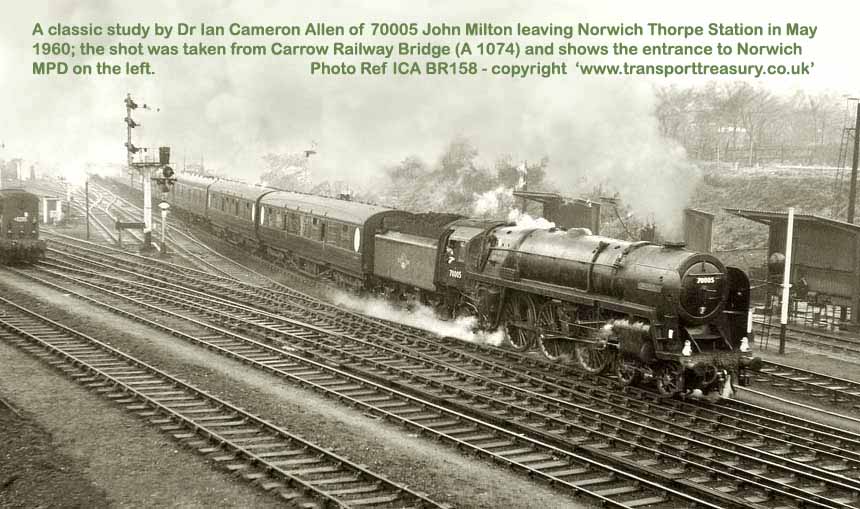
(Above) This classic shot is from Dr Ian Cameron Allen's Collection, courtesy of the Transport Treasury archive, and shows 70005 John Milton leaving Norwich Thorpe Station in May 1960. 70005 is fresh from Doncaster Works, where the speedometer (item 13) would have been fitted, but the front step (item 1) is without its support bracket, which then leaves a sharp edge for the crew to overcome when placing a headboard above the smokebox. The photo was taken from the Carrow Railway Bridge (A 1074) and the entrance to Norwich MPD is to the left, slightly further away from the bridge; also of note are the three
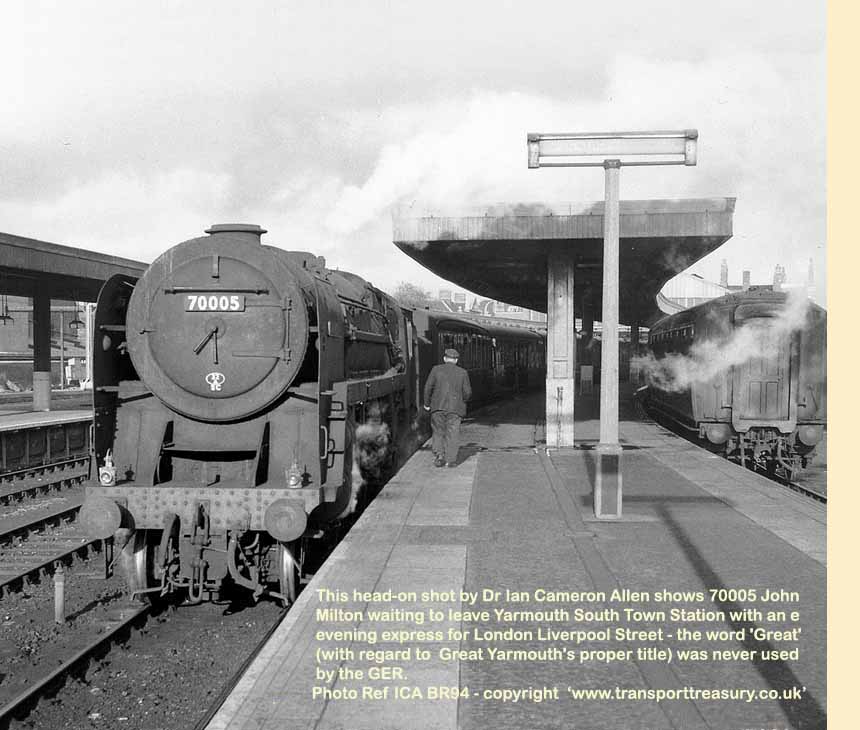 diesel pump stations on the far side of the engine, signs of the changes happening at this time. Transport Treasury has a huge archive of high-quality, hand-printed, traditional photographs from original negatives and digital images from transparencies that have been entrusted to the company by railway and transport enthusiasts through the ages. Click here for link.
diesel pump stations on the far side of the engine, signs of the changes happening at this time. Transport Treasury has a huge archive of high-quality, hand-printed, traditional photographs from original negatives and digital images from transparencies that have been entrusted to the company by railway and transport enthusiasts through the ages. Click here for link. (Left-Below) Another great photo from the Transport Treasury Archive is this head-on shot by Dr Ian Cameron Allen of 70005 John Milton waiting to leave Yarmouth South Town Station with an evening express for London Liverpool Street - the word 'Great' (with regard to Great Yarmouth's proper title) was never used by the GER. The date is May 1961 and 70005 is still allocated to Norwich MPD (32A) along with 21 other Britannias, until ousted by Diesel power. The front step (item 1) clearly has no support bracket, similar to the previous photo at Norwich, although the grubby, work-stained condition now, compares badly with that from twelve months ago (Below) A 'John Milton' nameplate went under the hammer for £12,000 at a Sheffield Railwayana Auction on 5th December 2009.

SIGHTINGS: First viewing of 70005 was at Crewe, where the locomotive was seen in the yard outside the Works' paint shop, awaiting its final top coat of paint and varnishes to be applied, and so presented a rather unusual look being without nameplates or even cabside numbers. Early in its career at Stratford shed, 70005 was pictured in a predicament; the front wheel bogie had derailed on one of the tight curves in
 the vast yard at Stratford Loco and was awaiting rectification. In the early part of 1955, the engine was photographed at Birmingham New Street Station, having brought the train on from Crewe, where 70005 had received some attention and was running-in as a precaution before being released back to its parent shed at Stratford. The Britannia would have been a rare catch for those spotters fortunate enough to be on the platforms at Birmingham and it was noted that the cab sheets were now in place, but there were still not any platform step fitted to the tender. During June 1957, 70005 was captured on film at Bishops Stortford Station in Hertfordshire, in a scene that was chock full of interest to even a casual observer; the locomotive was hauling a down semi-fast train to Norwich, 4 tank engines were in the service area opposite the main platform where many passengers were waiting for the next train towards London. The March-allocated Britannias could be seen in York, Doncaster, or Leeds on many freight workings and some passenger trains, such as a Newcastle to Colchester trip, or Crewe or Newport (High Street) on a West and North passenger working. Other sightings of 70005 include a passenger train at Blackpool whilst allocated to Aston (2J), believed to be from Birmingham New Street dated July 1964, by which time, though in recent works condition, 'John Milton' had lost the lining to the usual Brunswick Green paintwork, clear sins of austerity at this time. 70005 was also seen, in very poor external condition, when hauling a short parcels train to Perth, dated April 1965, and also an 'express fish' train running from Perth to the south in the same month, whilst allocated to Carlisle Kingmoor MPD (12A). Following sightings were on Leeds Holbeck shed, again in 1965, and hauling a Bradford to Carlisle parcels in 1966, being seen in atrocious condition as many of the class were at this time, but also still displaying the original Great Eastern section long lamp irons.
the vast yard at Stratford Loco and was awaiting rectification. In the early part of 1955, the engine was photographed at Birmingham New Street Station, having brought the train on from Crewe, where 70005 had received some attention and was running-in as a precaution before being released back to its parent shed at Stratford. The Britannia would have been a rare catch for those spotters fortunate enough to be on the platforms at Birmingham and it was noted that the cab sheets were now in place, but there were still not any platform step fitted to the tender. During June 1957, 70005 was captured on film at Bishops Stortford Station in Hertfordshire, in a scene that was chock full of interest to even a casual observer; the locomotive was hauling a down semi-fast train to Norwich, 4 tank engines were in the service area opposite the main platform where many passengers were waiting for the next train towards London. The March-allocated Britannias could be seen in York, Doncaster, or Leeds on many freight workings and some passenger trains, such as a Newcastle to Colchester trip, or Crewe or Newport (High Street) on a West and North passenger working. Other sightings of 70005 include a passenger train at Blackpool whilst allocated to Aston (2J), believed to be from Birmingham New Street dated July 1964, by which time, though in recent works condition, 'John Milton' had lost the lining to the usual Brunswick Green paintwork, clear sins of austerity at this time. 70005 was also seen, in very poor external condition, when hauling a short parcels train to Perth, dated April 1965, and also an 'express fish' train running from Perth to the south in the same month, whilst allocated to Carlisle Kingmoor MPD (12A). Following sightings were on Leeds Holbeck shed, again in 1965, and hauling a Bradford to Carlisle parcels in 1966, being seen in atrocious condition as many of the class were at this time, but also still displaying the original Great Eastern section long lamp irons.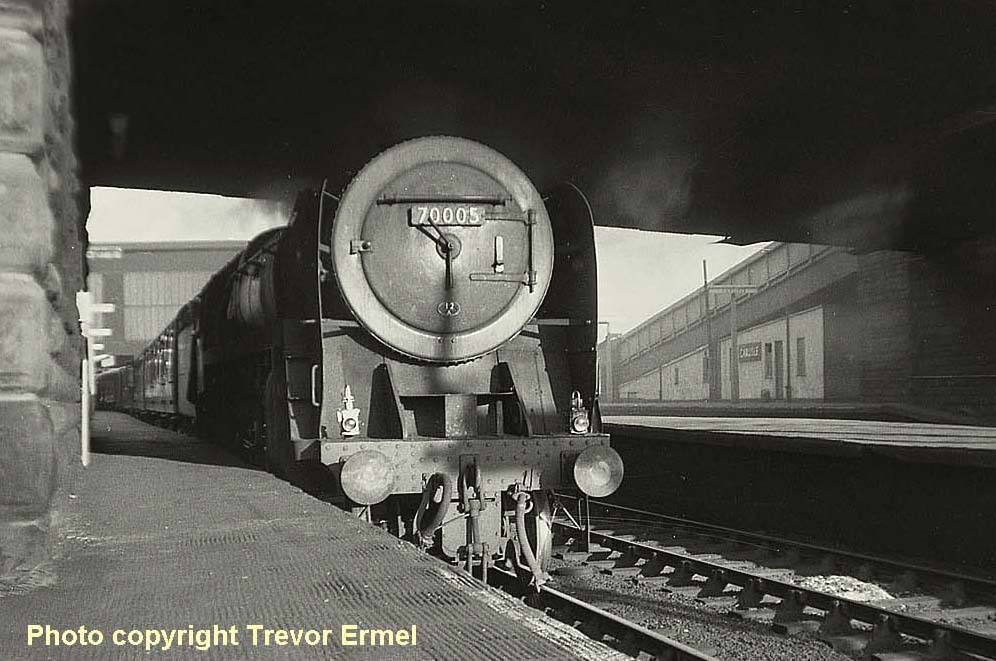
(Above) During the May school half-term holidays in 1966, aspiring 15 year-old railway photographer, Trevor Ermel, spent an enjoyable few days photographing the last bastions of steam in the North-west with his spotting chum, John Reed. They stayed at the Youth Hostel near Carlisle Kingmoor shed. At that time the 20.25 Carlisle to Perth Express was regularly hauled by a 'Britannia', so they decided to ride behind it as far as Lockerbie. Having taken this photograph of No 70005 at Carlisle prior to departure, they climbed aboard the train fully aware that there wasn't a train back from Lockerbie that night, but they fervently hoped the buses were still running. Fortunately they were; indeed the sympathetic bus driver dropped them off near the Youth Hostel around midnight on his way back to the depot. By this time, however, the Hostel had shut for the night and they had to sleep in the bike shed! Happy days! Check out Trevor's 'Rail Camerman' page 69 for more tales about his reconnaissance with a camera here
Disposal: Withdrawal for 70005 John Milton came on July 29th 1967, and the engine was then stored at Kingmoor until the end of the year, and cut up at Campbell's scrapyard in Airdrie during January 1968.
Programme authorised 17th November 1949, built at Crewe Works, completed 12th April 1951 to Order No.E479/220 at a cost of £20,025. Withdrawal took place on 20th May 1967.
ALLOCATIONS: 70006's first allocated shed was Stratford MPD (30A), but only for a very short time before relocation to Norwich Thorpe shed (32A) where the engine gave sterling service to the Great Eastern section for more than ten and a half years. March depot (31B) in Cambridgeshire became the locomotive's next home early in December 1961; this allocation lasted almost exactly two years before its transfer to Carlisle Kingmoor shed (12A). This proved to be the final move for 70006 Robert Burns as the locomotive was withdrawn there in 1967.
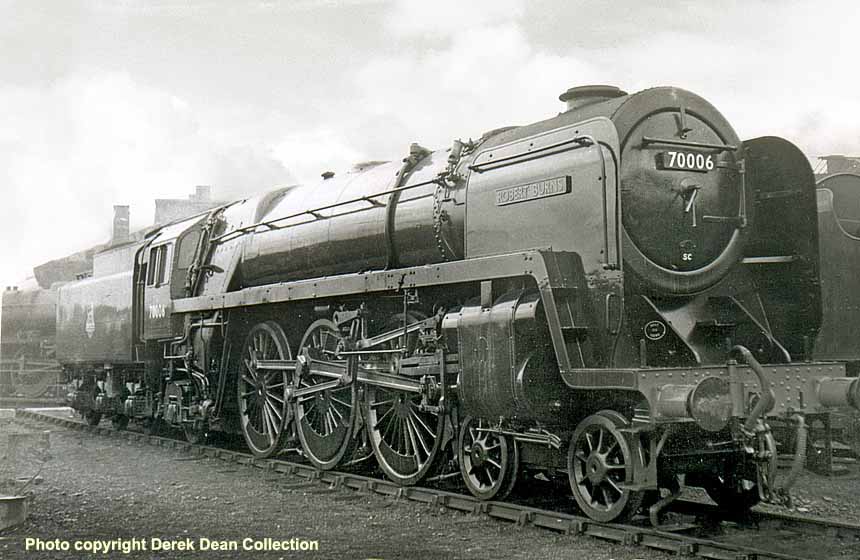
(Above-Below) Brand new at Crewe North shed in April 1951, Britannia 70006 Robert Burns is ready to be fired for the first time prior to testing procedures which will determine the build quality before release to the Great Eastern section. On top of the boiler can be seen the low dome cover, which had to be raised to accommodate the modified version of the dome; this was done almost immediately before any piston damage occurred due to water ingress to the cylinders. (Below) With a backdrop of smoke-blackened buildings, nearly new BR Pacific 70006 Robert Burns is watched over by a number of spotters, who await the next Britannia to arrive at London Liverpool Street Station; by this time, August 1951, there were thirteen of the class operating the revamped timetables, hauling express trains to Norwich and Harwich in the main. The white headcode discs stand out starkly in comparison to the scene, which includes a more usual GE locomotive in the form of a 4-6-0 B17 'Sandringham' class engine.
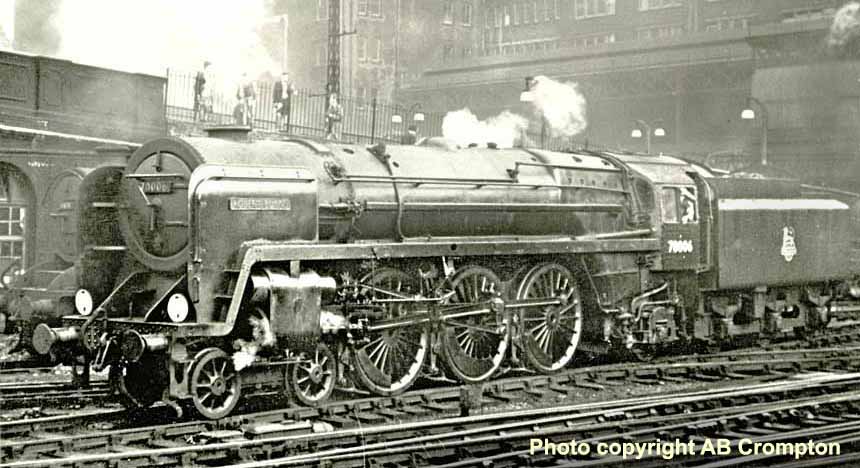
MODIFICATIONS: 70006 was originally fitted with the troublesome low dome (item 6), but this was changed before the locomotive was released to Stratford depot. In service, the first modification was to the axles (item 17) which meant complete strip down and refitting of new wheel bearings, refitting of the wheel keys and complete plugging of the hollow centres to the axles. Soon after that major rectification work, the brake vacuum pipe (item 21) was modified to a shorter version, at Crewe Works in March 1952 and also later that year the fluted coupling rods (item 14) were upgraded to all plain rods, which were stronger, but heavier than the original fluted variety. 70006 was one of the 13 Britannias that did not receive the modification to raise the sand box lids (item 16), so the next change seen was, in 1953, the addition of the cab flexible sheets (item 9) designed to prevent draughts at the back of the cab. The tender step (item 10) appeared as a WR type, with extra weld points, but this was because there was a swop of tender with 70030 William Wordsworth, in September 1954; this was also when the regulator front rod was fitted with a support bracket (item 5). The regulator rear rod was modified with a support bracket (item 7) at a further visit to Crewe Works for a General Overhaul, in November 1955, while the next works visit was in 1957, when 70006 entered Doncaster Workshops and reappeared with a full specification front step (item 1), the nearside lubrication rod (item 18) was shortened and a new BR emblem (item 11) applied to the sides of the tender, seen from late in July 1957. The Britannia was the penultimate engine to have the smoke deflectors (item 3) modified, seen from December 1959, when a visit to Doncaster Works also resulted in the AWS equipment (item 20) being added along with a speedometer unit (item 13). Following a General Overhaul at Doncaster Works over the Christmas and New Year period, 70006 was seen, in January 1962, with a LMR type return crank (item 15), a modified design from the original LNER version. The power warning plates (item 19) were fitted from March 1960, and the lamp irons (item 2) were repositioned in 1964 for safety reasons; the nameplates were removed for safekeeping in 1965, as happened to most of the Britannias.
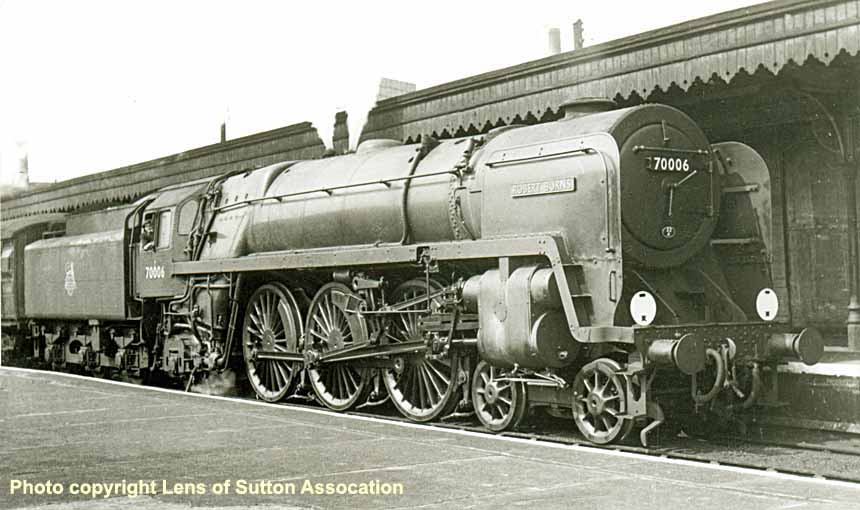
(Above-Below) Another fine image from the Lens of Sutton Association's collection; this lovely capture reflects Britannia Class 7MT 70006 Robert Burns with an express from London to Norwich at Colchester Station on Friday 4th April 1952. It shows the distinctive station platform canopy, which was such a feature of many LNER stations, before modernisation swept most of them away. Remodelling of Colchester station was completed in 1962, being initially delayed by the Second World War. (Below) Dated from April 1953 this fine image from RK Blencowe shows Britannia 70006 Robert Burns waiting somewhat impatiently to leave Ipswich Station for London Liverpool Street with an express service from Norwich. The powerful engine will cover the 69 miles to London at over a mile a minute, as it did many times in its ten plus years working from Norwich Thorpe shed. The two year-old engine is seen in a slightly work-stained condition and has already had five modifications to the original construction
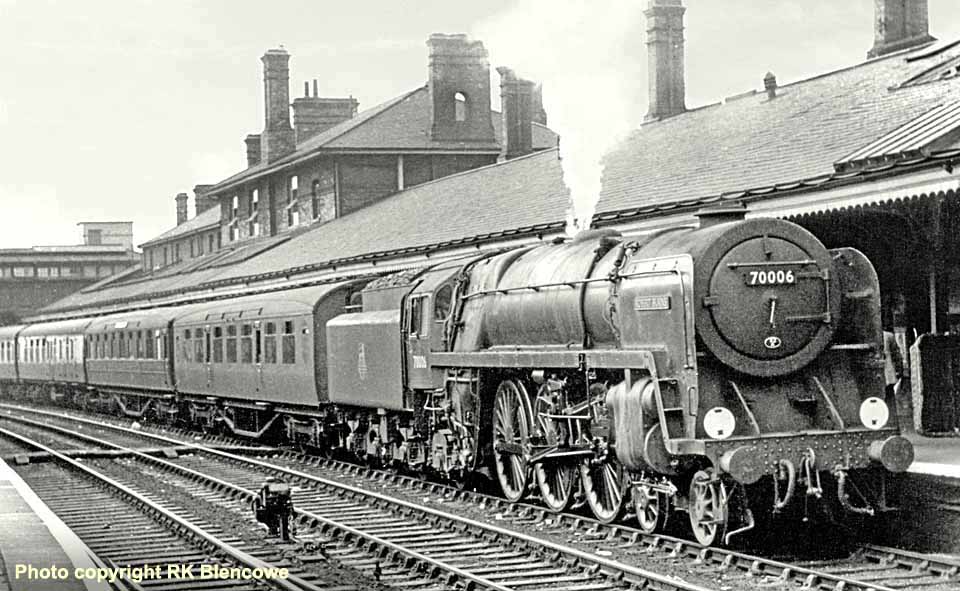
SERVICE RECORD: Completed on 12th April 1951, 70006's preliminary running-in was broken only five days later when it was required to re-enter Crewe Works for adjustments; the locomotive stayed six days and so could not have been at Stratford more than two weeks at the most before transfer to Norwich depot. The engine is recorded as entering Crewe Works 9 times, with 6 visits to Doncaster Workshops and on a couple of occasions did enter Norwich Works for attention. Recorded mileages were good, but not exceptional; an average of 71,000 miles per year for the first four years in service reflecting good usage and availability throughout. The nearly new engine was soon put to work and coupled to a dynamometer car to accurately measure speed and performance over the Great Eastern metals, as a prelude to the newly printed time-tables showing the new timings for London to Norwich expresses. 70006 was used extensively on the Norwich to London diagrams and would cover 460 miles on a regular basis, hauling such trains as the 'Norfolkman' or the 'East Anglian' over the undulating Great Eastern route. The Britannia was also used on the 'Scandinavian' Boat Train service to Harwich Parkeston Quay, linking passengers to the Danish port of Esbjerg and after 1958 was seen to be well used on the 'Essex Coast Express'. Late in 1958, 70006 had to enter Doncaster Works for rectification, after a crack was found in the nearside cylinder, possibly due to lack of lubrication. The locomotive was also used to haul the Royal Train in December 1959 from London Liverpool Street Station to Sandringham in Norfolk, for their Christmas vacation. It is reported that the engine failed at Diss, in September 1960 and had to be recovered by one of the new breed of Diesel engines from Norwich shed, possibly caused by failure of the briquette tube feeder for which the Britannia entered Doncaster Works for more repairs. After the new diesels took many Norwich services from the Britannias, 70006 Robert Burns could be seen on a combined Liverpool and Manchester to Harwich express which was unofficially named the 'North Country Continental' and originated in 1885. Much of the work done after 1961 was on freight and parcels trains, and only sporadic trips on passenger express work; but 70006 was fortunate to have a late visit to Crewe Works which resulted in a change of boiler and a complete repaint, although without any trace of lining whatsoever.
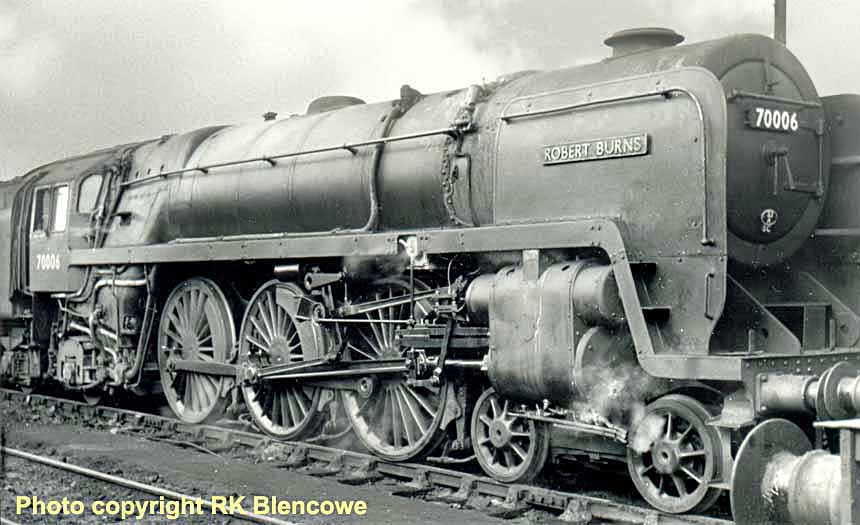
(Above-Below) R K Blencowe has captured this image of Class 7 4-6-2 70006 Robert Burns at Norwich Thorpe locoshed early in 1959, not long after suffering a fractured offside cylinder and if we look closely, that right-hand oil pump is new as shown by the different coloured paint used. The lubrication of the large cylinders (20in.x 28in.) was a constant problem for maintenance staff and piston rings had to be changed at regular intervals due to wearing in service. (Below) At the very end of brilliant decade, as the Fifties come to a close and we welcome the Sixties into our lives, BR Standard 70006 Robert Burns waits to leave a rather cold and wet Liverpool Street Station with another express for Norwich Thorpe, a run completed successfully very many times. The Norwich allocated engine has recently undergone heavy work at Doncaster and that led to selection for Royal Train duties, indicated by the white-painted cab roof and the painting of the vacuum and heater hoses on the front.
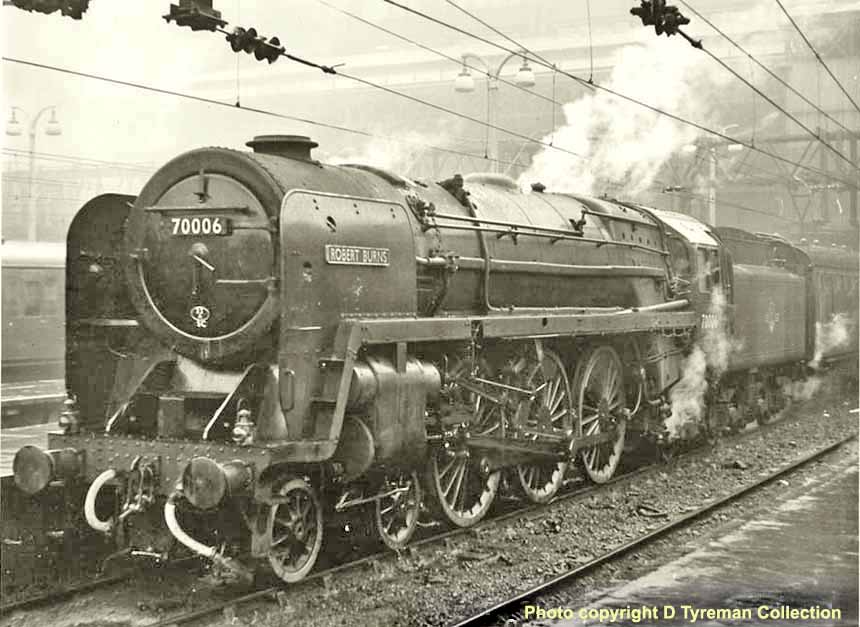
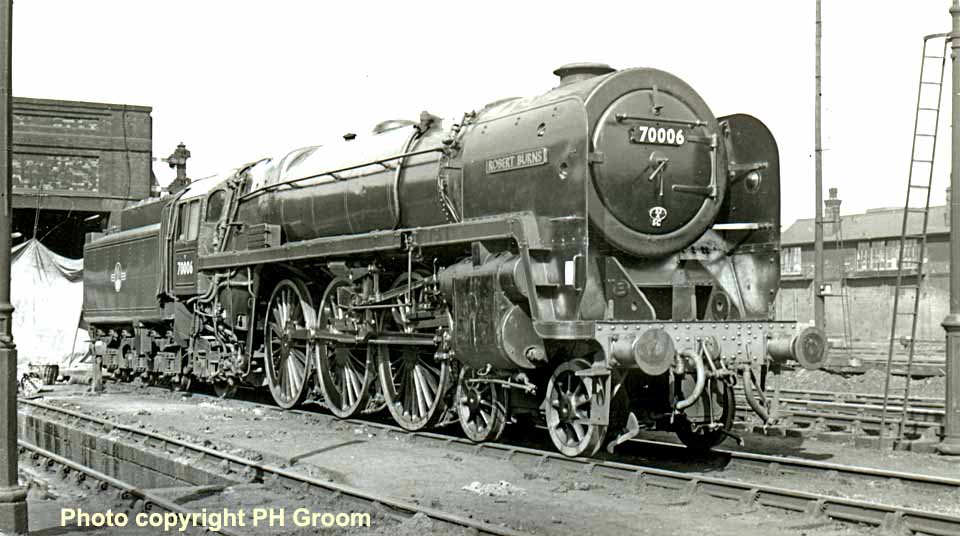
(Above) This fine picture by the redoubtable Peter Groom shows BR Standard Pacific 70006 Robert Burns, a Norwich stalwart for the best part of its service life, at Norwich Thorpe shed following heavy work being done at Doncaster and, in fact, no less than sixteen modifications have been completed since the engine was constructed, back in 1951. Also of note from the photo are the lamp irons which reflect two short and two long ones fitted; the nameplates were light blue-backed and the 'SC' plate on the smokebox stood for self-cleaning and not ScR.
SIGHTINGS: 70006 Robert Burns was first observed at Crewe, with the original low dome in place, being towed by Ivatt Type 2 tank No 41229 from the Works across to Crewe South depot for its first firing, after which the locomotive moved to Stratford MPD and put to work on the 'East Anglian' express service; 70006 was seen departing Liverpool Street station for Norwich Thorpe, sporting the early 1951 type of headboard, without any coat of arms of London or Norwich. Three years later, a work-stained engine was captured in print powering its way up Brentwood Bank with the 'Broadsman' express which would reverse at Norwich before going forward to Cromer and Sheringham. In 1958, 70006 was viewed at London Liverpool Street ready to leave with an express for the Essex coast, and it was noticeable that the white headcode discs looked striking compared to the grime on the locomotive. The following year a sparkling engine was pictured at Liverpool Street following a hefty overhaul at Doncaster Works; new wheels prominent, smoke deflectors modified to LMR 1 design and the four forward lamp irons were comprised of two short ones and two of a long variety. Very shortly after this 70006 was selected for hauling the Royal Train from London, identified by white paint on the roof of the cab and also on the vacuum and heater hoses at the front of the engine. During its stint at March depot, 70006 was seen back at Stratford in 1962; at Derby in 1963; and in very scruffy condition at Bushbury shed in Wolverhampton also in 1963. After relocation to Carlisle, the locomotive was seen at Dent on the Settle and Carlisle route with a freight train, at Motherwell Station on a passenger turn from Glasgow and also viewed at Southport Chapel Street Station awaiting a return to Scotland with a holiday express, in July 1964. The following year, fresh from another Works visit, the now nameless 70006 was pictured at Lowgill, between Grayrigg and Tebay, towing a failed 4-month old diesel-electric Type 4 back to Carlisle. Early in November 1966, a very resplendent 70006 was pictured at Crewe Works, although without any lining to the livery, after service and a reconditioned boiler had been fitted.
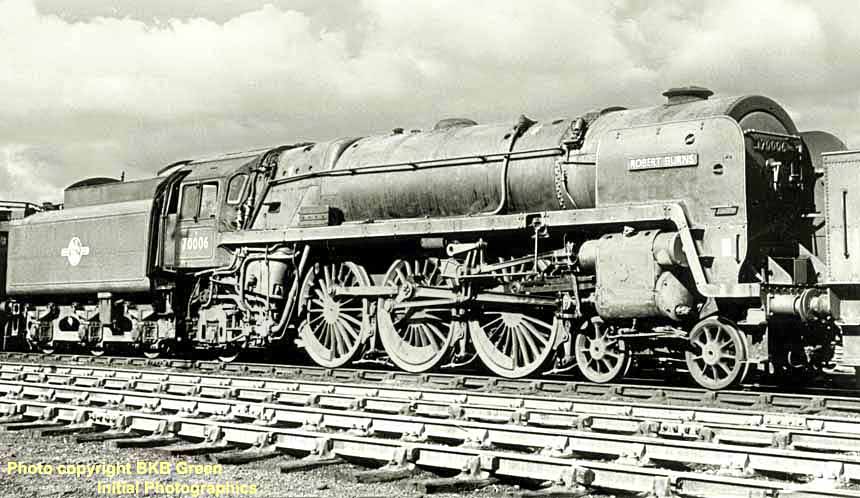
(Above) A good view of BR Standard 7MT 70006 Robert Burns, by BKB Green for Initial Photographics, at rest on Carlisle Kingmoor yard, but looking as though the locomotive has been having a long rest; covered in dust, the wheel tyres are badly marked instead of showing bright metal as you would expect; the cab windows are very dirty, consistent with an engine that has been parked up for some considerable time. Also of note is the cover is missing from the offside exhaust pipe, just above the cylinder assembly
DISPOSAL: 70006 Robert Burns was withdrawn from service on Saturday 20th May 1967, stored at Carlisle Kingmoor yard until October 1967 and then transferred to J.McWilliams of Shettleston, a suburb of Glasgow, being just over three miles to the east of the City Centre. The company was responsible for the disposal of over 40% of the Britannia class.
(Below) An interesting view of BR Standard 7MT 70006, now nameless, at Carlisle Citadel Station waiting at the head of a morning express for Perth sometime during May 1965. This fine picture, taken by A Scarsbrook for Initial Photographics, encompasses the whole railway scene as it was back then; parcels being loaded, driver chatting to an interested party, the engine hissing away with a full head of steam ready for the off, such wonderful memories.
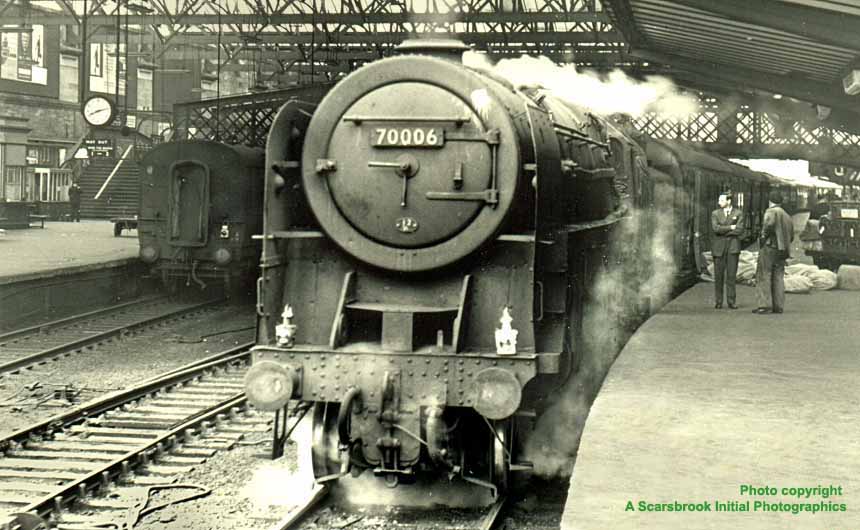
Programme authorised 17th November 1949, built at Crewe Works, completed 25th April 1951 to Order No.E479/220 at a cost of £20,025. Withdrawal took place on 19th June 1965.
ALLOCATIONS: From brand new 70007 Coeur-de-Lion was allocated to Stratford MPD (30A), but only for a period of 24 days before relocation to Norwich Thorpe shed (32A), where the engine served for ten and a half years until 18th November 1961, giving sterling service to the Great Eastern section.
March depot (31B) in Cambridgeshire was the locomotive's next venue for just over two years until December 1963 arriving the same week as many Classmates at Carlisle Kingmoor MPD (12A), the ultimate destination for the majority of the Britannias.
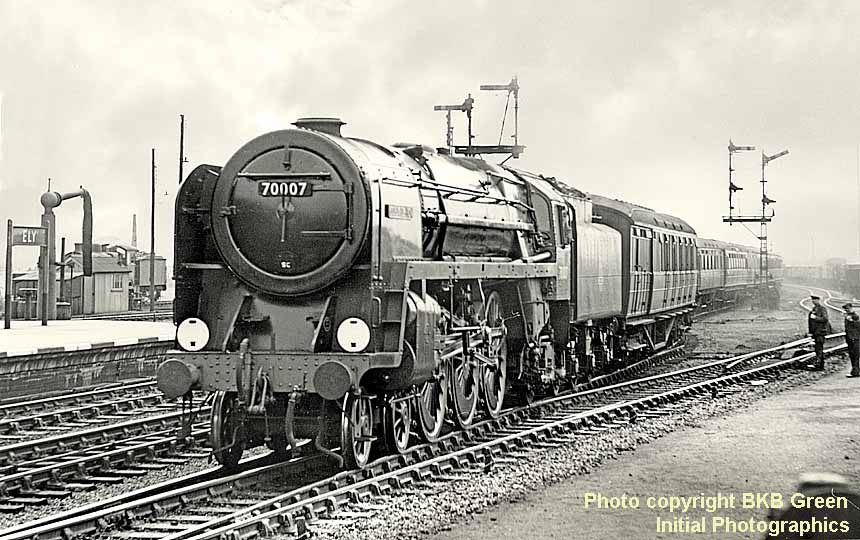
(Above) A brand new Britannia 7MT snakes its way into Ely Station in Cambridgeshire; moving stealthily past South Signal Box is 70007 Coeur-de-Lion en-route to Norwich in May 1951, yet another marvellous image from BKB Green of Initial Photographics. Ely was an important junction for Lincoln and Norwich, but had no locoshed of its own; with station pilots supplied by March or Cambridge depots.
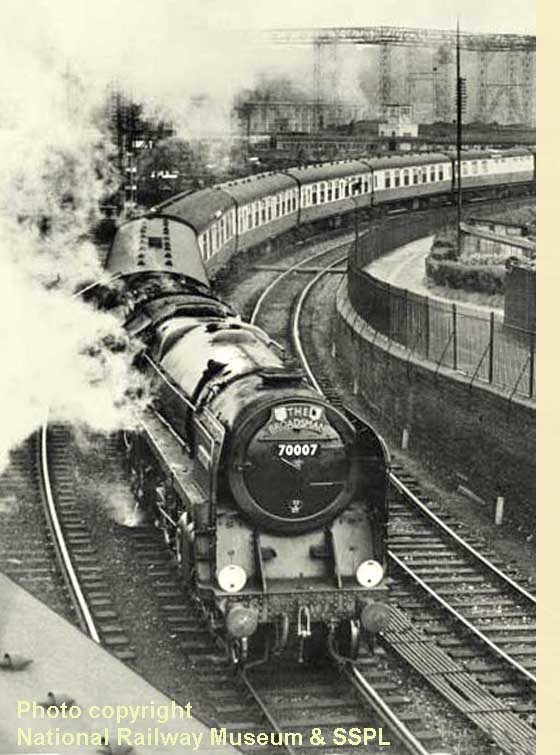 (Left) A lovely image from the National Railway Museum & SSPL's 'Liverpool Street' Collection HERE of Britannia 7MT 70007 Coeur-de-Lion hauling the Down 'Broadsman' in 1952. Having just traversed Trowse Swing Bridge (1845) spanning the River Wensum, 70007 is negotiating the tight curve past the signal box on the Wensum triangle at Norwich Junction; it is approaching Carrow Road Bridge (A1242) before entering Norwich Thorpe Station, where the train will reverse before being taken forward to Cromer and Sheringham. The sidings in the background later became Crown Point Maintenance Depot
(Left) A lovely image from the National Railway Museum & SSPL's 'Liverpool Street' Collection HERE of Britannia 7MT 70007 Coeur-de-Lion hauling the Down 'Broadsman' in 1952. Having just traversed Trowse Swing Bridge (1845) spanning the River Wensum, 70007 is negotiating the tight curve past the signal box on the Wensum triangle at Norwich Junction; it is approaching Carrow Road Bridge (A1242) before entering Norwich Thorpe Station, where the train will reverse before being taken forward to Cromer and Sheringham. The sidings in the background later became Crown Point Maintenance DepotMODIFICATIONS: As one of the first constructed batch, 70007 Coeur-de-Lion was in receipt of 18 out of the nominated 21 modifications; also the engine was the first production locomotive to have the modified larger dome fitted over the boiler to rectify the carriage of water into the cylinders which was found to be causing actual damage to the pistons.
In December 1951, 70007 took its turn to have the Axle repairs (item 17) carried out at Crewe works and was seen with a mix of coupling rods (item 14) thereafter. The next modification to be noticed was the vacuum pipe (item 21) which was altered by Stratford Works in March 1952, and at the same time the reverse gear recouperating spring (item 8) was encased to help prevent lock-up in service.
The locomotive returned to Crewe Works in March 1953 for a Light Intermediate repair and also had the wheel coupling rods (item 14) changed from fluted (original type) to the heavier, but stronger, plain version. A cab sheet (item 9) was introduced the following year, which was aimed at preventing draughts and swirling coal dust at the back of the cab; also the front regulator rod was given a support bracket (item 5) at this time. 70007 was still being sent to Crewe Works for maintenance at this time and received a General Overhaul there from April 1955; apart from a boiler refit, the tender step (item 10) was added and the rear
 support bracket (item 7) fitted to the regulator rodding, giving extra stability.
support bracket (item 7) fitted to the regulator rodding, giving extra stability. None of the first fourteen Class members, except for 70004 William Shakespeare, received the raised sand box lids (item 16) modification and 70007 did not have the weak-type front step fitted, because that was only added to Stratford allocated Britannias. But whilst at Crewe in February 1956 70007 Coeur-de-Lion was fitted with the full front step (item 1) modification, which involved removal of the two small original steps to make way for the large area plate.
From May 1956, Britannias were seen entering Doncaster Works for maintenance and repairs, with many of the modifications done there. During November 1956, 70007 entered Doncaster to have the LNER return crank (item 15) modified to the LMR version which was secured with four set-pins instead of the two cotter pins as before. Only the new BR emblem (item 11) appeared in 1957, almost two years before the smoke deflectors (item 3) had the handrails removed, in April 1959 at Doncaster, one of twelve Britannias likewise modified that year. Also at that visit 70007 was fitted with the AWS equipment (item 20), with the pipework situated along the boiler walkway on the nearside of the engine. The power warning plates (item 19) were applied to the locomotive sometime during 1959; while the speedometer (item 13) was added at a visit to Doncaster when undergoing another General Overhaul there. The lamp irons (item 2) were altered in 1964, firstly from the longer GE section irons to the shorter LMR type, then later in the year the top iron was moved down the smokebox, with the centre iron on the buffer beam moved across to align with it.
(Below) The familiar surroundings of Liverpool Street Station are captured here by the camera of BKB Green for Initial Photographics, as the crew of Class 7MT 70007 Coeur-de-Lion await their turn to use the turntable in readiness for their next duty. The locomotive has recently acquired two rear steps, one each side of the tender in May 1955; these were fitted to aid the fireman when refilling the tender with water.
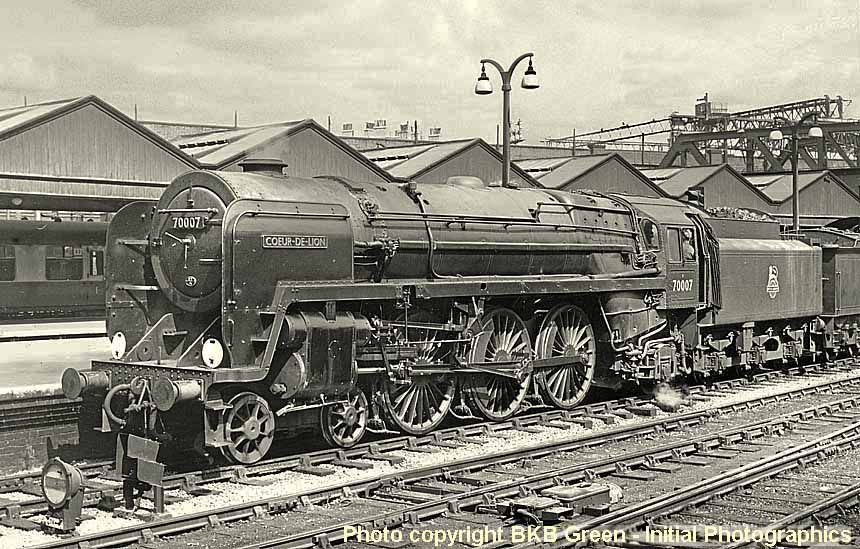
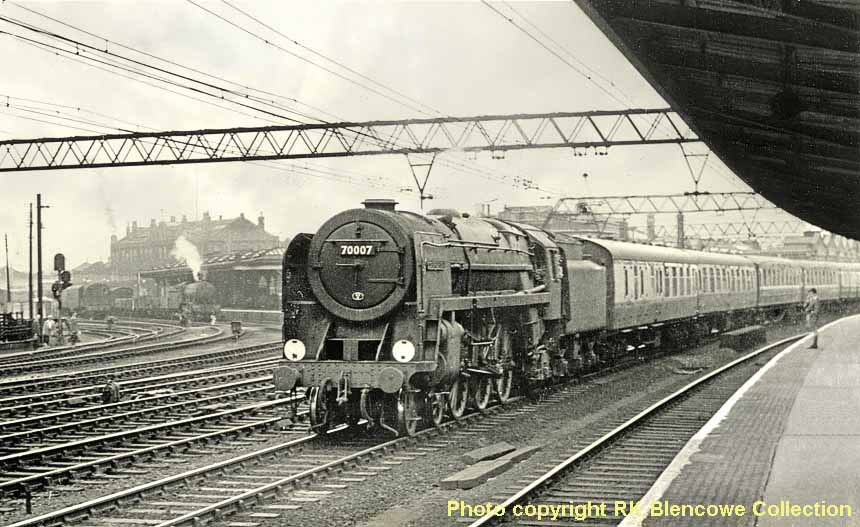
(Above-Below) Britannia 4-6-2 70007 Coeur-de-Lion, with bent smoke deflector handrail, is captured by Rod Blencowe passing Stratford (High Level) Station with an express from Norwich in February 1957. This interest-laden image affords an excellent view of Temple Mills Station where a Gresley Mogul and a Diesel Electric shunter wait with their respective trains and the small schoolboy is pondering his maths homework. 70007 Coeur-de-Lion at Lancaster: A powerful image from BKB Green and Initial Photographics, depicting a sorrowful Britannia No 70007 Coeur-de-Lion at Lancaster (Castle) Station waiting the 'off' with a northbound express in July 1964. The design of the station was based on the nearby Castle (now a prison), and the lines to the left were used by electric trains serving the Lancaster to Morecambe and Heysham route, subsequently withdrawn in 1966. (Below) A superb shot of Class 7MT 70007 Coeur-de-Lion, taken by CM & JM Bentley at Liverpool Street Station in July 1958 and reflecting the full size of these British Railways-built Pacifics. The visible pipework from this viewpoint detracts from the overall picture, but there is no denying the look of pace and power of these locomotives. The Signal Box at the top left is that of Broad Street Station extant until 1986
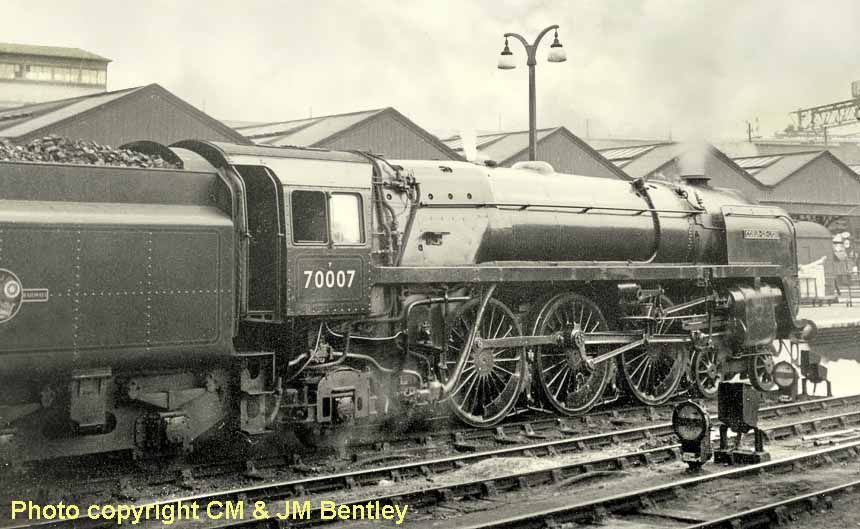
SERVICE RECORD: On the Great Eastern section metals, 70007 Coeur-de-Lion contributed greatly to the rejuvenation of the services into East Anglia. The locomotive would have headed many express trains, including 'The Norfolkman' and 'The Broadsman', both involving starting out from London Liverpool Street and taking the train forward to Norwich Thorpe where a Class B1 or L1 engine would take the train to Cromer and Sheringham. Also 70007 would have hauled many so-called 'Boat Trains', such as 'The Scandinavian' or 'The Hook Continental' which connected passengers with important boat sailings for Holland and North Germany. Recorded mileages for Coeur-de-Lion were very good; 43,200 miles in 1951 (only worked 7 months), 74,300 in 1953 and 78,000 during 1955. Works visits recorded show that 70007 entered Crewe Works six times; Doncaster on nine occasions and also three times into Stratford Workshops. A Mr. Bill Harvey was a long-time Foreman at Norwich Thorpe depot (32A), and made all of his notes into a book revealing some of the problems that came with looking after a fleet of British Railways Pacifics. 70007 Coeur-de-Lion features quite heavily in his publication, as follows; September 1960, mainframe fractured over trailing bogie wheel; March 1961 weld broken again in same area; September 1961, drive wheel Cannon axle box failed, also a note that the locomotive had a tendency to break the smokebox cradle bolts. Recorded time lost was 42 days from September 1960, a further 16 days from December 1960 and another 19 days from February 1961, which is basically three months lost while under repairs. Furthermore the engine entered Doncaster Workshops again in May 1961 for repairs to Main Frame fracture, possibly in the same area as before and this continued through its service life becoming the first Britannia withdrawn, this because of the related problems with the engine frame.

(Above-Below) Having brought in an early morning express from Norwich in typical November weather, Britannia Pacific 70007 Coeur-de-Lion is photographed by BWLB Brooksbank at Liverpool Street Station in 1960. The majority of the documented modifications have now been completed, and the locomotive looks in very good condition, though a number of problems surfaced the following year. The driver is oiling around the many moving parts of the trusty Walschaerts valve gear, first introduced in British locomotive practice in 1844. (Below) Rod Blencowe's 1963 shot of 70007 Coeur-de-Lion in residence at March depot reflects the severe winter that lasted well into the month of March; the very bad weather affected all types of transport and certainly the effects can be seen on 70007; a thick layer of grime and filth covers the locomotive and there are numerous knocks to the front end pus the offside cylinder lining is scraped and damaged. Oh how the mighty have fallen!

SIGHTINGS: The new Britannias were much sought after in the early months of 1951, and many photos were taken all around the Great Eastern lines. 70007 was viewed with an eleven coach load powering its way up Haughley Bank, a three mile climb at mostly 1 in 131 incline, with a morning train for Norwich, in June 1951, so the engine was completely original. The following year the locomotive was pictured at Ipswich Station,
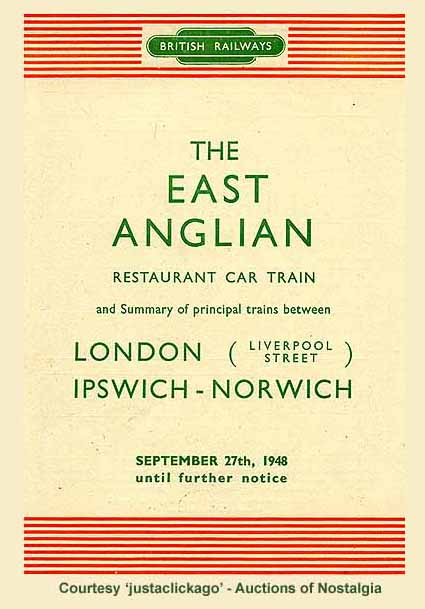 ready to leave for London, hauling the Up 'East Anglian', with the new-style headboard prominent and showing a 3-line title and the coat of arms of both London and Norwich. In May 1953, it was appropriate that the forthcoming Coronation was recognised by British Railways, and 70007 was captured at Ipswich with the 'Down' 'Broadsman' showing an additional Headboard carried on buffer beam, declaring the event. Coeur-de-Lion was seen in very good order at Colchester, in September 1956, passing the Goods Shed, hauling 'The Broadsman' towards Mannigtree and Ipswich; an express which allowed passengers from Sheringham and Cromer to travel to London for the day. In sparkling ex-Works condition, 70007 was observed on Norwich Thorpe depot, recently released from Crewe and showing a full front step, a magnificent sight to behold in amongst the murky, smoky atmosphere that morning in February 1956. After a fairly recent visit to Doncaster Workshops, the engine was viewed coming to a standstill at Ipswich Station, in July 1957, with the Down 'East Anglian' and again the resplendent locomotive looked a picture, with very clean livery and displaying new tyres on the drive wheels, along with the new version of the British Railways emblem on the tender, the first seen on a Great Eastern Britannia. During April 1958 70007 was espied powerfully leaving Liverpool Street station with an afternoon train for Norwich, showing standard headlamps instead of the white discs, meaning it would be dark before arrival in Norfolk; while the condition of the engine reflected the harsh winter months. Most pictures thereafter showed a scruffy engine, lacking any cleaning at all unless recently from a Works visit; as seen at Liverpool Street in quite reasonable condition during September 1960, awaiting departure with an afternoon express to Norwich Thorpe and seen with smoke deflector modification and AWS equipment fitted. In 1961, 70007 was pictured breasting Haughley Bank with an early morning express for Norwich, was in fair condition and the nearside lubrication rod (item 18) had been shortened to give more rate of atomised oil from the pump to the piston and cylinder. The external condition of the engine while allocated to March depot was in the main deplorable apart from two Works visits, which may have changed that situation for a short time. In July 1964, with less than 12 months service remaining, a work-stained Coeur-de-Lion was espied leaving Elvanfoot with the four-coach stopping train from Carlisle to Glasgow Central.
ready to leave for London, hauling the Up 'East Anglian', with the new-style headboard prominent and showing a 3-line title and the coat of arms of both London and Norwich. In May 1953, it was appropriate that the forthcoming Coronation was recognised by British Railways, and 70007 was captured at Ipswich with the 'Down' 'Broadsman' showing an additional Headboard carried on buffer beam, declaring the event. Coeur-de-Lion was seen in very good order at Colchester, in September 1956, passing the Goods Shed, hauling 'The Broadsman' towards Mannigtree and Ipswich; an express which allowed passengers from Sheringham and Cromer to travel to London for the day. In sparkling ex-Works condition, 70007 was observed on Norwich Thorpe depot, recently released from Crewe and showing a full front step, a magnificent sight to behold in amongst the murky, smoky atmosphere that morning in February 1956. After a fairly recent visit to Doncaster Workshops, the engine was viewed coming to a standstill at Ipswich Station, in July 1957, with the Down 'East Anglian' and again the resplendent locomotive looked a picture, with very clean livery and displaying new tyres on the drive wheels, along with the new version of the British Railways emblem on the tender, the first seen on a Great Eastern Britannia. During April 1958 70007 was espied powerfully leaving Liverpool Street station with an afternoon train for Norwich, showing standard headlamps instead of the white discs, meaning it would be dark before arrival in Norfolk; while the condition of the engine reflected the harsh winter months. Most pictures thereafter showed a scruffy engine, lacking any cleaning at all unless recently from a Works visit; as seen at Liverpool Street in quite reasonable condition during September 1960, awaiting departure with an afternoon express to Norwich Thorpe and seen with smoke deflector modification and AWS equipment fitted. In 1961, 70007 was pictured breasting Haughley Bank with an early morning express for Norwich, was in fair condition and the nearside lubrication rod (item 18) had been shortened to give more rate of atomised oil from the pump to the piston and cylinder. The external condition of the engine while allocated to March depot was in the main deplorable apart from two Works visits, which may have changed that situation for a short time. In July 1964, with less than 12 months service remaining, a work-stained Coeur-de-Lion was espied leaving Elvanfoot with the four-coach stopping train from Carlisle to Glasgow Central.DISPOSAL: 70007 Coeur-de-Lion was the first of the Class to be withdrawn, and became the only Britannia to be taken out of service from Crewe Works, which occurred on 19th June 1965 (see Service Record). The engine was stored at Crewe South depot for a short time and cut up in the Works in July 1965.
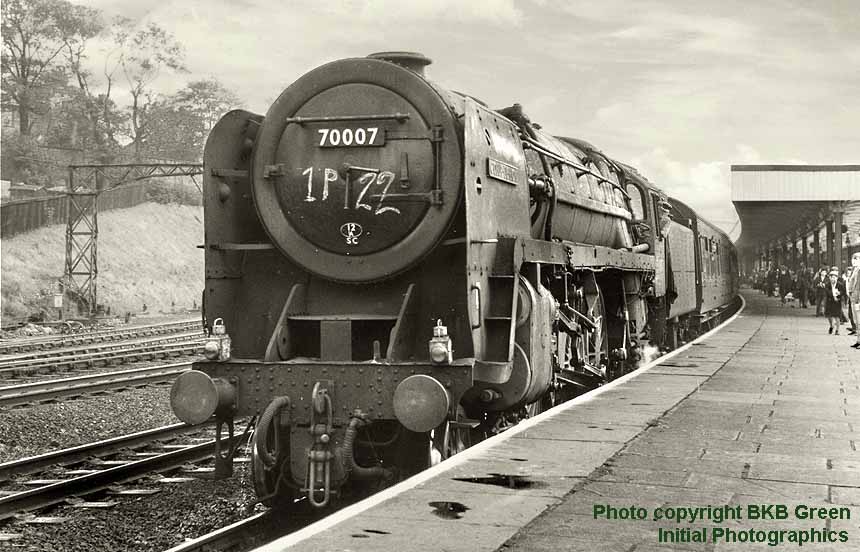
(Above-Below) A powerful image from BKB Green for Initial Photographics, depicting a sorrowful Britannia No 70007 Coeur-de-Lion at Lancaster (Castle) Station awaiting the 'off' with a northbound express in July 1964. The design of the station was based on the nearby Castle (now a prison), and the electrified lines to the left were used by a small fleet of units serving the Lancaster to Morecambe and Heysham route, subsequently withdrawn in 1966. (Below) Clive IK Field seized the opportunity to capture this image for posterity; No 70007 Coeur-de-Lion rests at Carlisle Citadel Station early in April 1964 by which time the deplorable state of engine was fairly typical - bashed and battered, layer upon layer of grime, invisible paintwork and nameplate almost undecipherable. On the plus side the drive wheel tyres look in good shape and the front of the smokebox, at least, is reasonably clean and tidy plus the cabside number is clear for spotting.
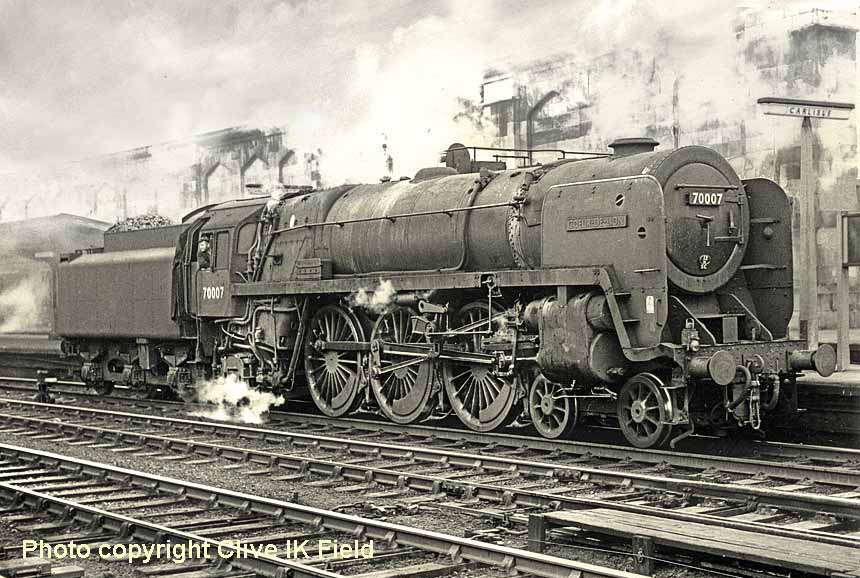
Programme authorised 17th November 1949, built at Crewe Works and completed on 28th April 1951. Order No E479/220 costing £20,025. Withdrawal came on Saturday 14th January 1967 from Carlisle Kingmoor.
ALLOCATIONS: 70008 was the first Britannia allocated to Norwich Thorpe MPD (32A), as 70006 and 70007 were initially utilised at Stratford depot. Thus for ten years and four months, 70008 served from Norwich before relocation to March Depot (31B) and finally Carlisle Kingmoor shed (12A) from 7th December 1963 until withdrawal.
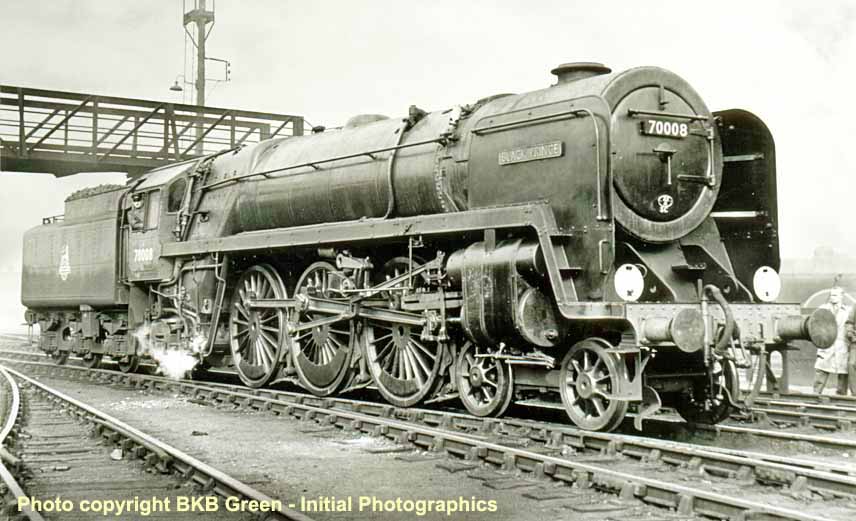
(Above) On a rather damp day in May 1951, the very first Britannia 4-6-2 to be allocated to Norwich depot is recorded at Cambridge by the remarkable BKB Green for Initial Photographics. The slightly less than pristine engine arrived amid high expectation and anticipation that the East Anglian services would change for the better; indeed this proved to be the case for the next decade when the original batch of 13 engines were joined by a further 10 for duties over the undulating Great Eastern lines. Of note is that the engine is set in mid-gear to ensure that no movement can occur while the cameramen are around the locomotive.
(Below) A locomotive nameplate from the BR Standard Class 7MT 'Britannia' Pacific No 70008 from the late Stuart Furniss collection went under the hammer at a unique Great Central Railwayana auction held at the Fawley Railway Museum, Henley-on-Thames by kind permission of Sir William and Lady McAlpine on 19 June 2016. No 70008 was named 'Black Prince' after Edward Woodstock, the eldest son of King Edward III and Philippa of Hainault; the nameplate's face is polished but the original red paint remains, whilst the back is in totally ex-loco condition. The auctioneers note that neither the nearside or offside nameplates have ever appeared in auction before.

(Below) Platform 2 at London Euston receives Norwich allocated Britannia 70008 Black Prince, returning from a Light Intermediate repair at Crewe Works in March 1953. The journey from their Norwich base to Crewe had to be made via London, Willesden Junction and the West Coast Main Line due to weight restrictions limiting the route of the Britannias; this was the usual way to return engines to Great Eastern lines prior to Doncaster Works taking on repairs of the Class 7MTs early in 1956.
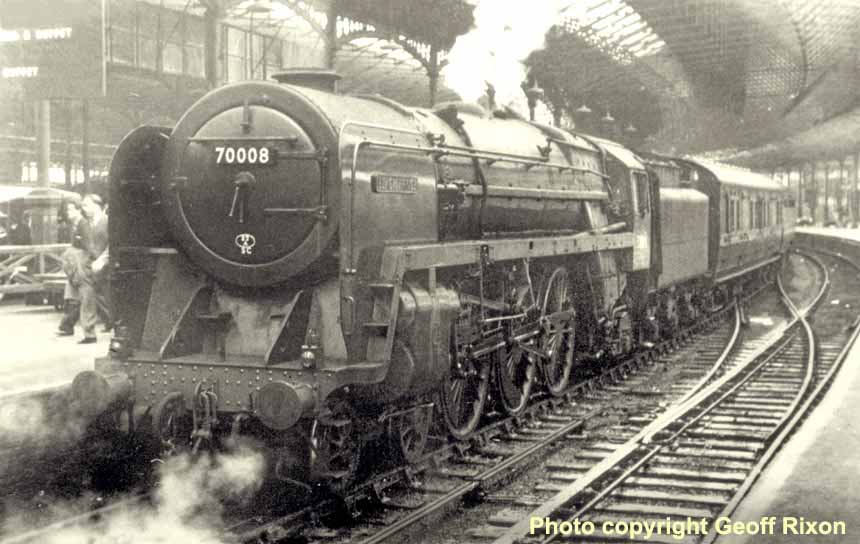
MODIFICATIONS: For 70008 Black Prince, the first modification was carried out before completion, as the low dome (item 6) was changed during construction after the operating department had resolved the 'water-carry-over' problem affecting the first engines. In total, 70008 received 18 of the 21 modifications noted. In December 1951 the engine was taken out of service to allow the axle repairs (item 17) to be carried out at Crewe works; the loco was seen with a mix of coupling rods (item 14) from the middle of February 1952, but had covered over 40,000 miles without any concerns. The coupling rods were changed to all plain variety during April 1953, while the cab sheets (item 9) were added and the vacuum pipe (item 21) was modified during the same visit to Crewe Works. 70008 was still a regular visitor to Crewe during this period; the front regulator rod was given a support bracket (item 5) at the next scheduled repair between May and June of 1954, while the tender step (item 10) was added to the sloping sides of the BR1 tender, aiding the crew when filling with water. Then at the next visit to Crewe in March 1955, the rear support bracket (item 7) was fitted to the regulator rodding, giving extra stability. None of the first fourteen Class members, except for 70004 William Shakespeare, received the raised sand box lids (item 16) modification and 70008 did not have the weak-type front step fitted; this was only added to Stratford allocated Britannias; 70008 was seen with the full step modification (item 1) after repairs at Doncaster Works during August and September of 1956. The GE section's allocation of Britannias began going to Doncaster Works in 1956, with 70003 John Bunyan being the first recorded there and, understandably, the repair work took a while until they became adept at these different Pacifics, but the Doncaster team soon matched the schedule of Crewe Workshops. Another entry for 70008 into Doncaster Works resulted in the modification of the smoke deflectors (item 3); the BR emblem (item 11) was applied to the tender and the LNER return crank (item 15) was changed to the LMR version, all on the same occasion. It seems odd, but only four Britannias had the AWS equipment and the speedometer fitted at the same time and often there would be 2-3 years between the fittings of these; as with 70008, the AWS (item 20) was added at Doncaster Works during October 1959, then the speedometer was fitted at the next visit; this was seen from January 1960, less than four months after. However, little changed thereafter, but the lamp irons (item 2) were repositioned in 1963 and the nameplates were removed in early 1965, when the engine was shopped at Crewe Works for the last time; also the new paintwork was unlined, an austerity measure brought in during 1964.
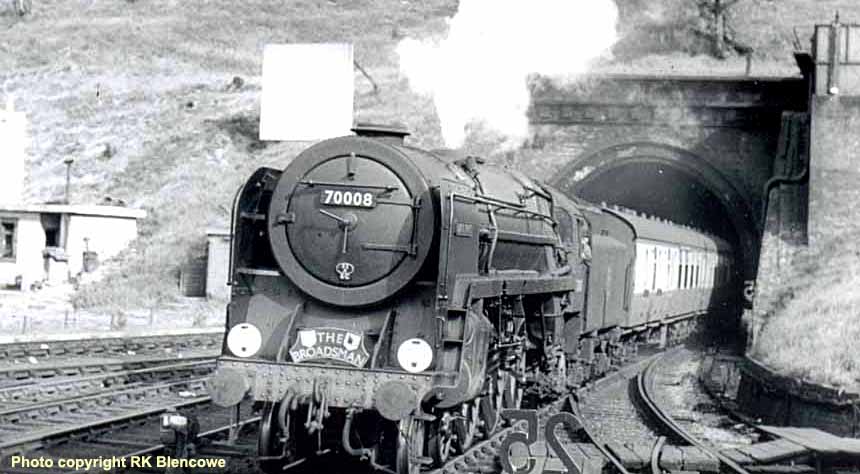
(Above-Below) A fine picture full of interest for the discernible modeller; cameraman Rod Blencowe captures BR Standard 70008 Black Prince slowing for the Ipswich stop with the down 'Broadsman' on 10th August 1953. The early part of 1953 saw many express trains carrying an extra board to celebrate the Coronation of Queen Elizabeth II in May and this led to the practice of placing the train headboard over the buffer beam, albeit this photo was taken much later in August. Also in the frame are the speed-limit signs; 15 mph to the right onto platform 4; 25 mph through the centre lines and, out of view behind the train, 40 mph through Stoke Tunnel. The large white oblong board allowed better sighting of the signals at the platform end and note the unusual position of the large water tank on the right; this is supported by a brick base incorporated into the retaining wall at the tunnel entrance. (Below) Following arrival with the down 'Broadsman' at Norwich in August 1953, Britannia 70008 Black Prince is awaiting signals at the end of platform 3 for a safe passage onto the shed for reversal and servicing, before returning to London with another express. Meanwhile the 'Broadsman' service continues its journey to Cromer and Sheringham behind a lighter class B1 or B12 4-6-0 due to prohibition of the Pacifics on that route into Norfolk. Rod Blencowe's photo shows the Britannia now has plain coupling rods and the headboard has been adorned with the crests of Norfolk and Suffolk.
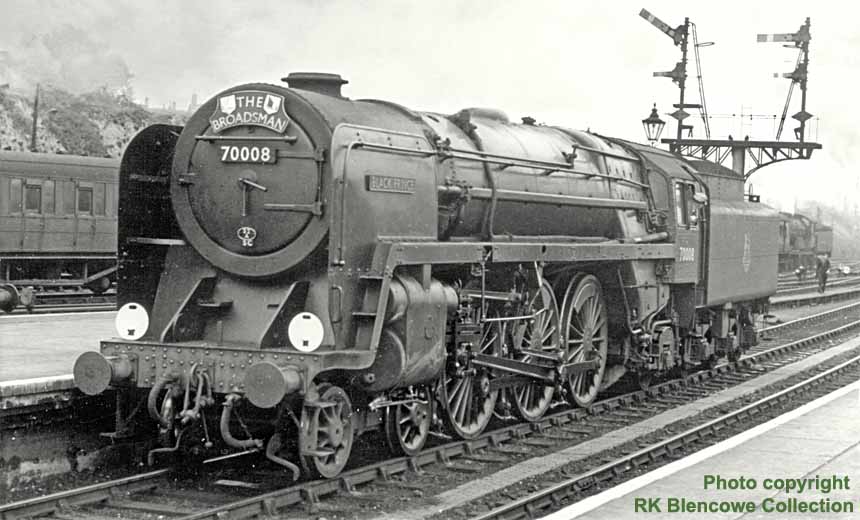
SERVICE RECORD: When working on the Great Eastern section, 70008 Black Prince helped greatly in the rejuvenation of the services into East Anglia. The locomotive would have headed many express trains, including 'The Norfolkman' and 'Broadsman', both involving starting out from London Liverpool Street and taking the train to Norwich Thorpe where a Class B1 or B12 engine would take the train on to Cromer and Sheringham. 70008 also hauled many so-called 'Boat Trains', such as 'The North Country Continental' which connected passengers from Liverpool with Harwich plus important boat sailings for Holland and North Germany. On many occasions 70008 was employed on 'The Easterling' service which ran only in the summer months, plus 'The East Anglian', a business-mans' train. Recorded mileages for Black Prince were very good, although not exceptional; with 41,000 miles noted for 1951, which allowed a maximum of 7 months in service, a creditable 74,000 recorded for 1953 and 79,000 the following year, then slightly less for 1955. In 1956, 70008 had to re-enter Doncaster Works after Norwich depot found two drive wheels had come loose on their locating keys on the axle ends. The number of workshop visits recorded show that 70008 entered Crewe Works five times; Doncaster on seven occasions and also just once into Stratford Works. After moving away from Norwich depot, the Britannia was regularly used on freight or parcel trains, returning to the hauling of passenger trains on most summer Saturdays.
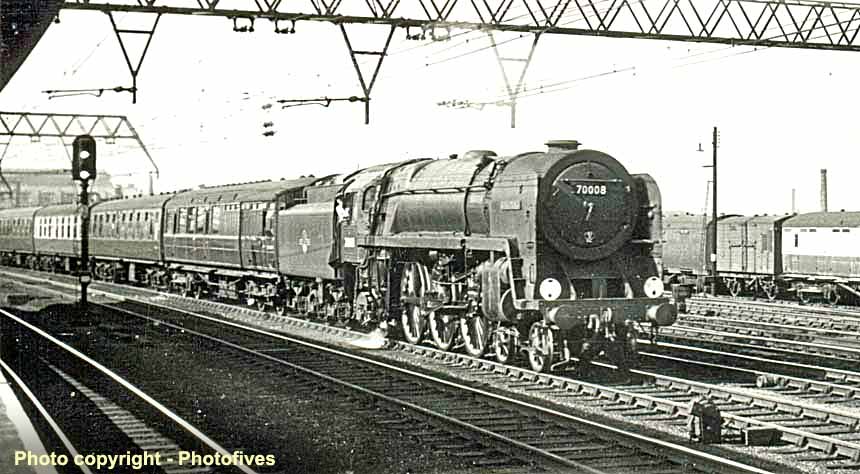
(Above-Below) A superb scene to greet passengers awaiting their local train at Stratford Station during the early 1950s; a gleaming Britannia 70008 Black Prince sweeps through the station hauling a rake of Gresley and Mk1 coaching stock making up a Norwich express in April 1958. (Below) Britannia 70008 Black Prince is pictured at a sunny Stratford MPD on what would appear to be a Sunday…the engine is flanked by two classmates, both equally idle. From the lens of BKB Green, for Initial Photographics, we can enjoy the powerful and neat lines of 70008, and note that there are nine visible modifications to the original form, including the recently altered smoke deflectors, one of the 25 Britannia engines so treated by Doncaster Works.
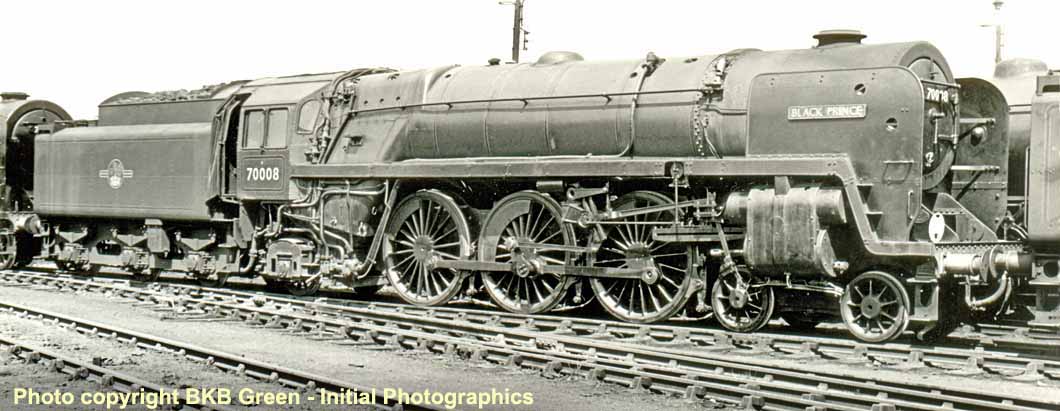
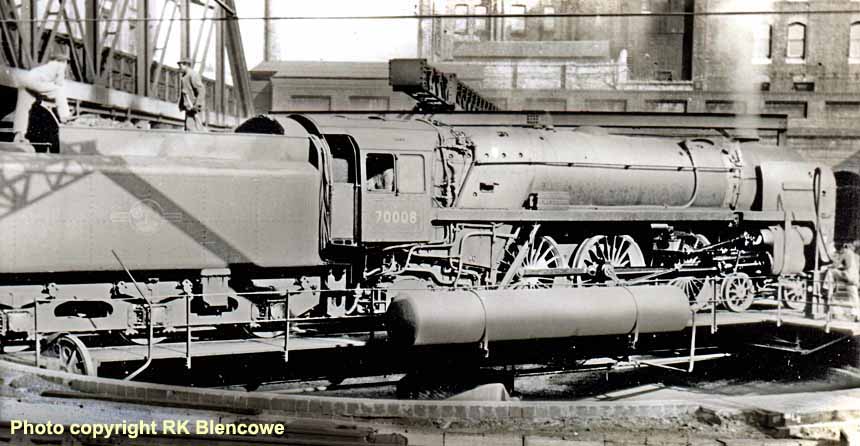
(Above) The 70 foot turntable at the north end of Liverpool Street Station is the location for this image from the large Archives of Rod Blencowe in June 1960; a grubby Britannia 70008 Black Prince is being turned for its next duty without any real effort by the crew as the engine vacuum brake system is used to operate the turntable mechanism. The condition of the locomotive is pertinent to the year; it reflects a total lack of cleaning due to the difficulties experienced by BR in maintaining sufficient staff levels at many loco sheds. The large box on the boiler walkway contains the multi-cell battery for the operation of the AWS equipment.
 (Insert) TRAILING BOGIE (PONY TRUCK): This was based on the Southern Region Pacifics' pony truck which used coil springs for its suspension. However, due to a high proportion of broken helical springs on the SR engines, the Britannia class was fitted with laminated multi-leaf road springs instead; these were overslung with pillar posts (see arrow 'A'). The weight of the locomotive was carried at three points; the pivot at the front of the 'Delta' frame and on two bolsters which slid on pads immediately below the cab. Four coil springs were used for lateral control and these were fully adjustable via long threaded rods to apply pressure to split cups, which in turn exerted pressure on the fixed centre pin, rigid to the
(Insert) TRAILING BOGIE (PONY TRUCK): This was based on the Southern Region Pacifics' pony truck which used coil springs for its suspension. However, due to a high proportion of broken helical springs on the SR engines, the Britannia class was fitted with laminated multi-leaf road springs instead; these were overslung with pillar posts (see arrow 'A'). The weight of the locomotive was carried at three points; the pivot at the front of the 'Delta' frame and on two bolsters which slid on pads immediately below the cab. Four coil springs were used for lateral control and these were fully adjustable via long threaded rods to apply pressure to split cups, which in turn exerted pressure on the fixed centre pin, rigid to the 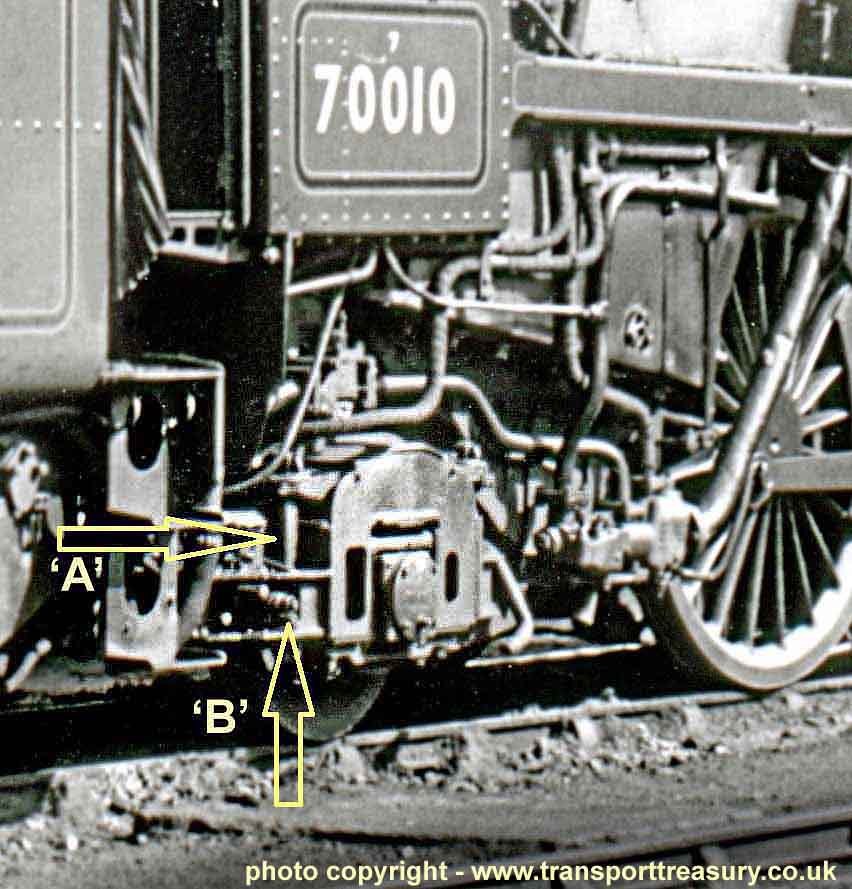 underside of the cab. The side-play adjusters were located at the extreme ends of the truck's Delta frame, on either side and fully accessible (see arrow 'B').
underside of the cab. The side-play adjusters were located at the extreme ends of the truck's Delta frame, on either side and fully accessible (see arrow 'B'). The load-bearing cups and pads were oil-fed from a small container situated close to the middle cab step. Different bearing set-ups were tried in service, with forty five Britannias having Timken roller type and the other ten (70040-49) having plain bearings; these could be identified by their end covers: the Timken type had a plain convex plate and the plain bearings had a very uneven cast finish.
Somewhat late in the day the heavy-oil in the trailing truck hub assembly was replaced by light grease and this was highlighted by painting the endplate bright yellow and finished with a broad horizontal red stripe. The same work was applied to all of the tender wheel hub sets. Also the ten-spoke wheels were 3ft 3½ins in diameter with tread and identical to those on the tender..
SIGHTINGS: In May 1953 there was much excitement around in anticipation of the forthcoming Coronation of Queen Elizabeth ll, and flags and bunting were visible at Cheadle Hulme Station as ex-Works Britannia 70008 Black Prince passed through the relatively quiet station heading back towards Crewe hauling a lightweight express. The Britannia was viewed in July 1955 coasting past Northumberland Park, just north of Tottenham, with a Cambridge-London express, passing a BR '9F' heavy freight engine awaiting passage down to Temple Mills yard. One of the lesser known duties for the GE Britannias was the Travelling Post Office train which ran either at night or during the early hours, bringing mail into the City of London from Norfolk; in May 1958 a slightly grubby 70008 was pictured on such a train moving steadily through Ipswich station towards the Capital. The double junction at Witham in Essex was the scene for a fine sighting of 70008 on a down express during the summer of 1959, moving quickly past the lovely signal box which controlled the GE main line plus local traffic to Bishops Stortford to the west and Maldon to the east. A less than pristine locomotive was seen heading an empty coaching stock train towards the coast at Reedham Junction between Norwich and Lowestoft, after working back to Norwich from London, then taking the empty train back to Yarmouth South Town via Lowestoft. Early in 1960, 'Black Prince' was viewed in reasonably tidy condition with all the usual modifications in place; the loco was being turned on the exposed turntable in the expansive yard at Stratford depot. The Britannia was pictured in a very grubby condition standing out of service between the outbuildings at Norwich Works during September 1961, perhaps awaiting a decision over its future; this uncertainty was very much the case for the majority of the Class as the new diesel locomotives had taken over the GE section line duties. But the engine was sent along to Doncaster Works for overhaul and worked out of March depot on various GN line services; 70008 was pictured leaving Stamford station with a stopping train from Peterborough to Leicester. After the locomotive was released from Crewe Works for the last time in February 1965, it was viewed leaving Wigan (NW) on a running-in turn with a southbound express, still with nameplates in position, but no lining at all on the engine livery and 3 short lamp irons plus one long one in the modified positions. A relatively short time after, however, 70008 was seen in a deplorable condition working a freight train from Leeds Stourton to Carlisle in the Aire Valley during June 1965; certainly 'Black Prince' was living up to its name although the nameplates had now been removed for safekeeping.
(Below) The station clock shows a time of 1.10pm on 5th August 1961 as Britannia 70008 Black Prince prepares to leave the cavernous, yet smoky confines of Liverpool Street Station with an afternoon express. On the extreme left stands Holden's celebrated Class J69 0-6-0T No 68619 on station pilot duty; this was always polished to a fault and a constant delight to behold, but the loco was due to be withdrawn within two months after 57 years of service.

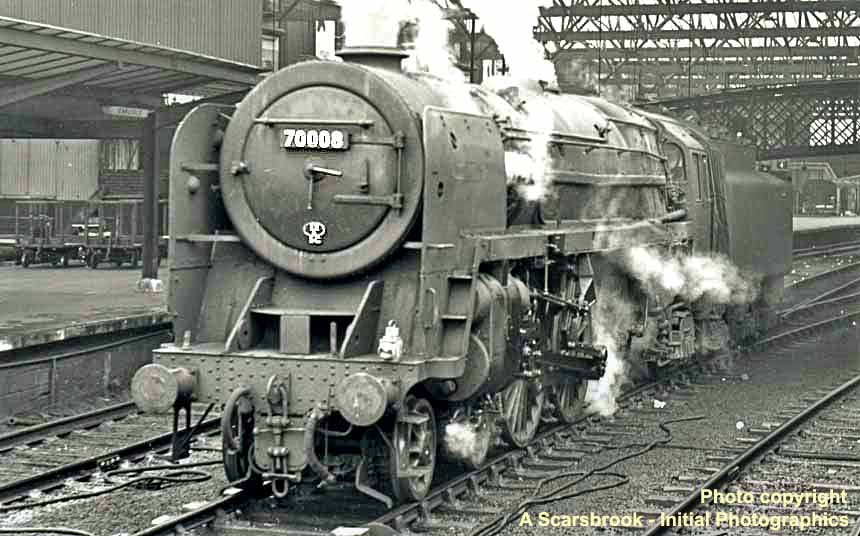
Above) In a typical latter-day scene at the majestic Carlisle Citadel Station, a down-at-heel Kingmoor Britannia 70008, now devoid of Black Prince nameplates, waits to take over a southbound train; it certainly looks ready for the task while of particular note is the contrasting height of the two lower lamp irons. The date is May 1965 and 70008 is one of 16 Britannia Pacifics allocated to 12A, all but one of which originated from the Great Eastern section lines; the remaining Britannia, No 70016 (featured further down the page) was previously allocated to the Western Region's Laira and Cardiff Canton depots in the main.
DISPOSAL: Withdrawal took place on Saturday 14th January 1967 from Carlisle Kingmoor. The engine was stored until May 1967 then transferred to G H Campbell of Airdrie for cutting up.
Built at Crewe Works and completed on the 4th May 1951 to order E479/220 at a cost of £20,025 and was withdrawn on the 21st January 1967.
ALLOCATIONS: 70009 spent slightly less than a decade in service on the Great Eastern Region; firstly working from Norwich MPD (32A), but this was quickly followed by a move to the Southern Region for the sole purpose of hauling 'The Bournemouth Belle' Pullman service; 70009 was based at the SR's Nine Elms shed (70A) until October 1951. Continuation of service from Norwich was further interrupted by the engine being placed in store prior to Axle modification at Crewe, but then 70009 worked through to September 1961, relocating to March shed (31B) in Cambridgeshire at that time. Service on the Eastern Region continued until employment was found on the London Midland Region based at its final shed Carlisle Kingmoor depot (12A) in December 1963.Liverpool Street Station in London opened in 1874 on the site of the Bethlem Royal Hospital, replacing the original station at Bishopsgate Street which was then used as a goods depot. Photographed by the redoubtable Peter Groom is Britannia 4-6-2 70009 'Alfred the Great' stands ready to reverse onto the turntable to prepare for its next duty. The Britannia Pacific was close to moving to pastures new, about to be elbowed out by the incoming Diesel engines; a decade of sterling service soon forgotten.
(Below) 70009 at Bournemouth; the spectator at the window must be in awe of the sight before him: a new Britannia Pacific 70009 Alfred the Great on its inaugural trip on the Southern Region, accompanied by a bowler-hatted Inspector on the footplate to instruct the crew. Another splendid photo from the Archives of Rod Blencowe capturing the moment for posterity, as the 'Bournemouth Belle' rests at Bournemouth Central Station. 'One of the four 'Belles' that ring the South' declared the advertisement posters; Devon, Bournemouth, Brighton and Thanet being the four in question.
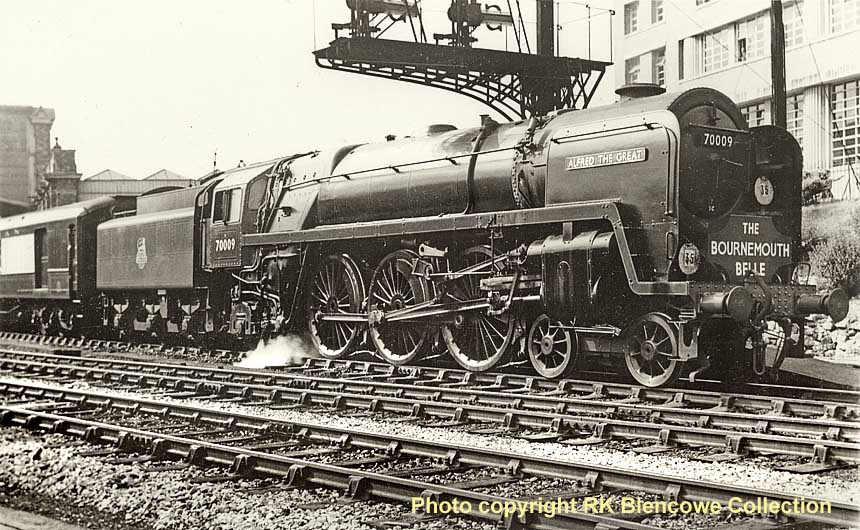
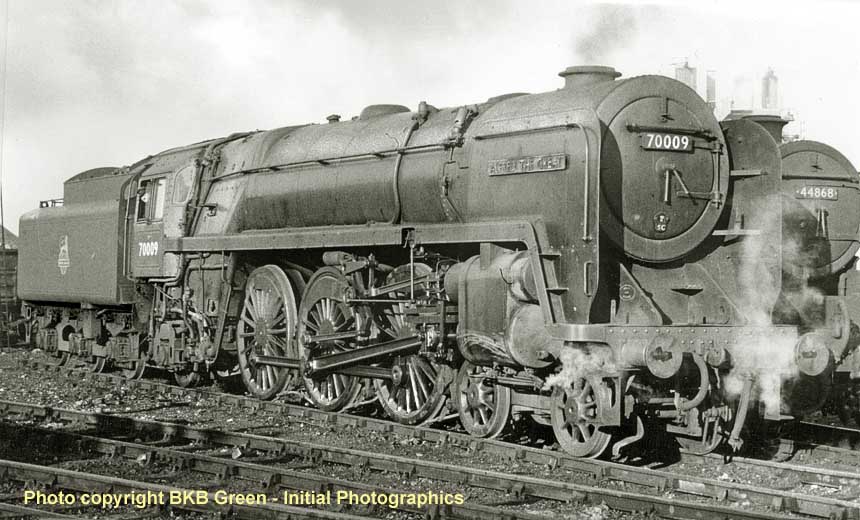
(Above) A fine image from the camera of BKB Green showing Britannia 70009 Alfred the Great at Crewe, having had major repairs to the drive-wheel axles; meaning plugging of the axleshafts, new keys and bearings and a change of coupling rods, plain section to the front and fluted to the rear. Also of note is the reverse recouperating spring which is not yet covered, seen above the centre drive-wheel, just under the boiler walkway. Picture dated Christmas 1951.
MODIFICATIONS: 70009 was almost immediately modified with Southern Region lamp irons (item 2) so that the correct headcoding could be applied when running on SR metals; these were added to the smoke deflector stays (small irons) and to the buffer beam platform (extended irons). After completing his stint at Nine Elms, 70009 was stored at Norwich until called into Works to have the required axle repairs (item 17) done, although at this time the coupling rods (item 14) were not altered and remained both fluted, front and rear. The long vacuum standpipe (item 21) was modified to the squat version at the same visit to Crewe, whereas the cab sheet (item 9) was not added until May 1953 at Crewe, along with the reverse gear recuperating spring (item 8) being encased to help prevent lock-up, and also the coupling rods (item 14) were now all of the plain variety.
 The tender step (item 10) was added to 70009 at the next visit to Crewe in 1955, in tandem with the regulator front rod support bracket (item 5) which was designed to stabilise the rod in service and give better control to the driver over its operation. Doncaster Works were next to repair 70009 and they duly modified the front step (item 1) in October 1956, and during his next visit there in March 1958 the smoke deflectors (item 3) were modified to the LMR 1 type which had two handholds with backing cups and the new version of the British Railways emblem (item 11) made its appearance on the tender. The sand box lids (item 16) were not modified for some reason on many of the early engines and this also applied to 70009, but the AWS equipment (item 20) was fitted at Doncaster, seen in June 1959, and then the speedometer (item 13) during August 1960, also at Doncaster Works, which truly reflects the large amount of rectification and modification work that they performed from about May 1956 to late 1962 on the Britannias.
The tender step (item 10) was added to 70009 at the next visit to Crewe in 1955, in tandem with the regulator front rod support bracket (item 5) which was designed to stabilise the rod in service and give better control to the driver over its operation. Doncaster Works were next to repair 70009 and they duly modified the front step (item 1) in October 1956, and during his next visit there in March 1958 the smoke deflectors (item 3) were modified to the LMR 1 type which had two handholds with backing cups and the new version of the British Railways emblem (item 11) made its appearance on the tender. The sand box lids (item 16) were not modified for some reason on many of the early engines and this also applied to 70009, but the AWS equipment (item 20) was fitted at Doncaster, seen in June 1959, and then the speedometer (item 13) during August 1960, also at Doncaster Works, which truly reflects the large amount of rectification and modification work that they performed from about May 1956 to late 1962 on the Britannias. 70009 was seen with the power warning plates (item 19) in position after August 1960, these being varied in position and number and were riveted to the locomotive for security. The LNER return crank (item 15) survived until September 1962 and was modified to the LMSR type at Crewe Works; also the lamp irons (item 2) were changed to the short London Midland type and then repositioned in 1965. It has not been possible to establish if the locomotive livery (item 12) was seen without lining as no clean photos have surfaced, but almost certainly this austerity measure would have been applied late in 1964.

(Above) 70009 at Liverpool Street; a fantastically sharp image from the Archives of Photomatic Limited, depicting a splendidly clean Britannia 70009 Alfred the Great ready for the off at Liverpool Street station, in June 1957. The Great Eastern section Pacific would have received ten modifications by now, and would be sporting blue-backed nameplates, 'BR 7' on the buffer bar and Southern Region type lamp irons on the smoke deflector stays.
SERVICE RECORD: During 1951, 'Alfred the Great' was was well received on the SR and used extensively on 'The Bournemouth Belle' Pullman service from Waterloo Station. I have not read anything of this, but come to the logical conclusion that as the 'Bournemouth Belle' ran the same route of 'The Royal Wessex' express train - and with 70009 being named so - it was therefore the obvious choice because King Alfred the Great and the King of Wessex were one and the same!
70009 was assigned to the Southern Region along with two other classmates; 70004 William Shakespeare and 70014 Iron Duke, but as this left a shortage of engines three SR engines were loaned to Stratford; 34039 Boscastle, 34057 Biggin Hill and 34066 Spitfire to fill the breach. During 1951, 'Alfred the Great'
70009 visited Crewe Works six times, and Stratford on three occasions plus repairs were carried out by Doncaster Works a further six times. Recorded mileages for 70009 were low for 1951 being 22,700, but much improved for 1953 at 77,500 and 63,300 miles for 1954 and then 67,000 for 1955. Apart from the 'Belle' 70009 hauled titled-trains such as 'The East Anglian' from London to Norwich, 'The Scandinavian' to Parkeston Quay for boat sailings to Holland, 'The Broadsman' which ran to Cromer and 'The Essex Coast Express' which terminated at Southend. 70009 was selected to haul the Royal Train in December 1960 for the Christmas get-together at Sandringham. However, all of this prestigious front-line work was put behind him when 70009 left the Great Eastern section for March shed and finally Carlisle.
(Below) 70009 at March; another good capture from BKB Green depicting how standards had dropped by 1959; Britannia 70009 is shown at March MPD, now without the dangerous handrails and with Automatic Warning System (fitted by Doncaster). To be fair to Norwich shed, all the GE section Britannias were now under their control and they were not allowed to employ any more men to cope with the extra engines transferred from Stratford Loco.

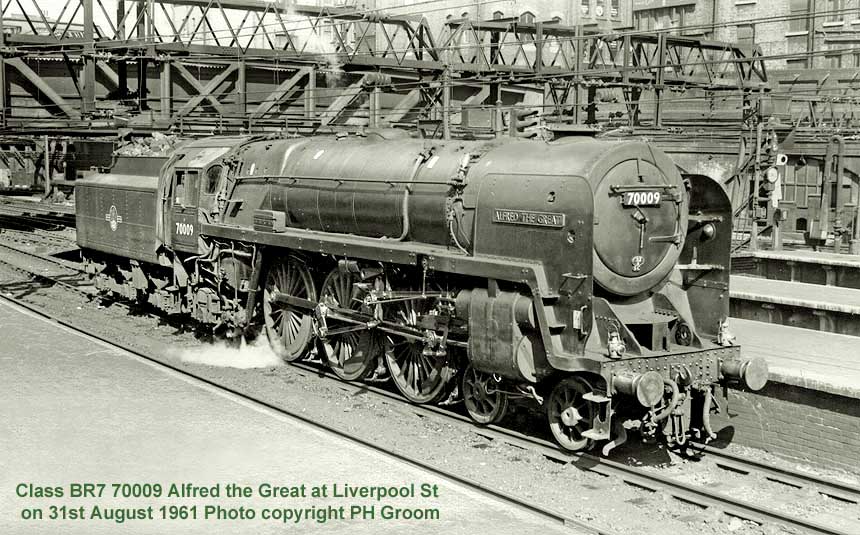
(Above) Liverpool Street Station in London opened in 1874 on the site of the Bethlem Royal Hospital, replacing the original station at Bishopsgate Street which became a goods depot. Photographed by the redoubtable Peter Groom is Britannia 4-6-2 70009 'Alfred the Great' waiting to reverse onto the turntable in readiness for its next duty. By this time the Britannia Pacific was close to moving to pastures new, having been elbowed out by the ER's new diesel fleet; a decade of sterling service soon forgotten.
SIGHTINGS: 70009 Alfred the Great was first viewed on a running-in turn out to Llandudno and back, which was not the most usual route used by Crewe. As soon as the locomotive arrived on the Southern Region, 70009 was found to be at Eastbourne for an exhibition in aid of the International Union of Railways' Conference held in the town. Also in attendance were 73001 from Derby and 75000 from Swindon. 70009 then had a continued run on the 'Bournemouth Belle' Pullman service from Waterloo Station in London and was photographed numerous times at one end of the journey or the other; doubtless this is due to the sheer novelty of having a 'Britannia' on the Southern Region route; 70009 was also viewed at Southampton on one occasion, and one can only wonder what the crews at Nine Elms depot thought of the new engine from up north.
Back on the GE section, 70009 was viewed at Norwich Thorpe Station in August 1953, with the down service of 'The Broadsman' which would reverse and continue to Cromer with a different engine. After repairs at Doncaster 70009 was seen on the Liverpool Street turntable in very fine condition and sporting a new front step between the frames, along with 'BR 7' painted on the buffer beam; a short-lived exercise that was said to help shed staff. 'Alfred' was again in perfectly pristine condition when photographed at Colchester on a down Norwich service, viewed now without handrails on the smoke deflectors following overhaul in April 1958. The excellent condition did not last, of course, and in 1959 the engine was seen to be very much work-stained at rest in the yard at March MPD, but after a works visit all its glory was restored as 70009 took charge of the Royal Train in December 1960 and the engine had a white-painted cab roof; painted vacuum hose; heater hose and the buffers were polished to a fault.
In 1963 'Alfred' was one of a number of Britannias in store at March in Cambridgeshire, and as 1963 was an awful winter, by the time the engines arrived at Carlisle they were in a parlous state. This was reflected when viewed at Kilmarnock on an Ayr to Carlisle mail train, 70009 looked in a deplorable condition, but fortunately
 after a works visit the engine looked better than average at Dumfries on the early morning Glasgow to Carlisle parcels and postal train in June 1965.
after a works visit the engine looked better than average at Dumfries on the early morning Glasgow to Carlisle parcels and postal train in June 1965.DISPOSAL: Following a period of storage at Carlisle Kingmoor, 70009 was cut up at J McWilliams of Shettleston in June 1967.
(Below) FOOTSTEPS ON FIREBOX SIDES: These simple steps were used by maintenance staff to reach the steam manifold assembly and corresponding pipework in cases of split hoses or leaking joints. In Keith Long's shot of 70000 'Britannia' (below right) the offside step sits clear of any obtrusions, but allows access to the steam valves and
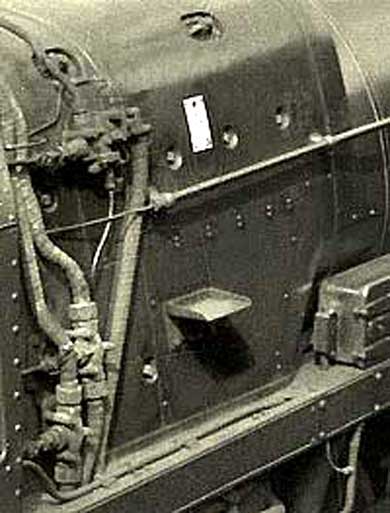 pipework including a feed for brake operations. The nearside version can be seen in Bernard Wright's drawing (below left). This is one of the sketches accompanying his article featuring the BR 'Britannia' class in 'Model Railways' magazine January 1972; this step was positioned just below the steam pipe channelling and
pipework including a feed for brake operations. The nearside version can be seen in Bernard Wright's drawing (below left). This is one of the sketches accompanying his article featuring the BR 'Britannia' class in 'Model Railways' magazine January 1972; this step was positioned just below the steam pipe channelling and 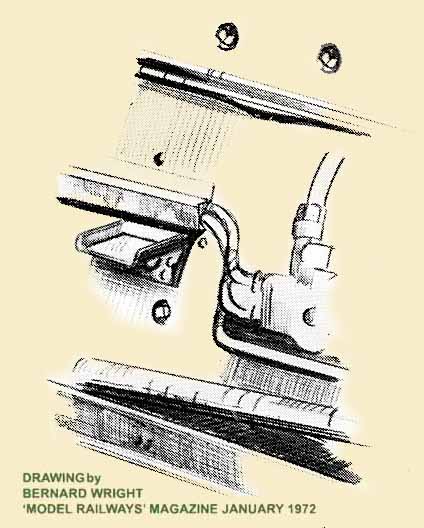 sits neatly halfway between the grab-rail above and the reverser control rod below.
sits neatly halfway between the grab-rail above and the reverser control rod below. (Below) BRITANNIA DRIVE WHEELS: The dimensions were of 6ft. 2in. diameter, of a flat level construction and were fitted with two 'tyres' or 'rims' which had to be sweated on to the wheel and were retained also by two lips on the periphery of the wheel. The wheel itself was made up of 20 spokes and had to be keyed onto the drive axle while being an interference fit, so that no free-play was allowed between the two surfaces and the position of the 'key' was pre-determined in construction to ensure that the correct timing was maintained. The first and third axles were fitted with balance weights which encompass five spokes, whereas the centre axle required further balancing and was set with a larger weight which spread over eight spokes or in other words 40% of the circumference of the wheel. But after the first batch of engines the centre balance was reduced so that Nos 70030 to 70054 were completed with a slightly smaller addition that covered seven spokes only. Also it was noted that No 70023 ended service with a smaller balance still, covering just four spokes of the third axle wheel.
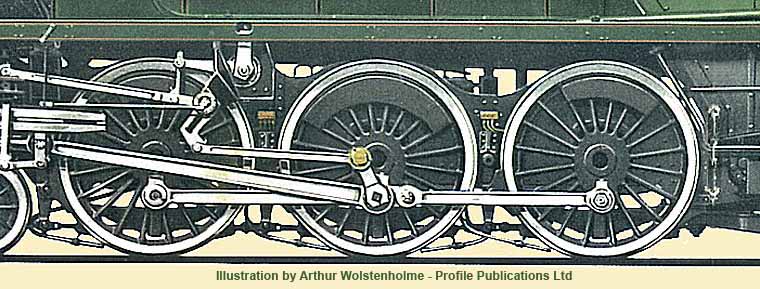
Programme authorised 17th November 1949, built at Crewe Works, completed 5th May 1951 to Order No E479/220 at a cost of £20,025. Withdrawal took place on 23rd September 1967 from Carlisle Kingmoor.
ALLOCATIONS: Norwich MPD (32A) was the starting point for the tenth Britannia on the Great Eastern section, thus began a long association of just over ten and a half years on East Anglian services, before allocation to March depot (31B) in Cambridgeshire at the start of December 1961. After sixteen months there, 70010 was reallocated to Willesden shed (1A) in North London from April 1963 until the very start of 1965, when the engine returned 'home' to Crewe North MPD (5A), although the shed was a shambles by this time as no more money was being spent on the 'spotters' paradise' and closure was all but a short time away - June 1965, in fact. As with all the other engines 70010 was moved to Crewe South shed (5B), but this lasted only four weeks preceding its move to Carlisle Kingmoor MPD (12A), its final destination as was the outcome for so many others before and after.
(Below) This image by BKB Green reflects every 1950's schoolboy's dream; an express passenger engine freshly painted in Brunswick Green and varnished to perfection. Here Britannia 70010 Owen Glendower stands outside the Weighbridge House at Crewe Works awaiting the final touches to be applied, before being weighed and dispatched back to Norwich depot. The low angle affords a good view of the guard-irons at the front plus the position of the banner of the old BR emblem below the cabside number; also of note is the delicate lining on the front valance by the buffer beam.


(Above-Below) Britannia Pacific 70010 Owen Glendower departs Cambridge station with an express from Norwich to London Liverpool Street; this regular double trip was a daily routine for the GE Britannias. The route via Cambridge, Ely and Thetford to Norfolk was ten miles longer than by way of Ipswich, but it was easier and less taxing on both the engine and crew. The photo was taken by Rod Blencowe and shows a tidy-looking 70010, but not at its best externally and showing the front end knocked up, which was all too common on these locomotives. (Below) One of 70010's cast brass locomotive nameplates, measuring 60" long, went under the hammer for £14,000 at a Great Central Railwayana Auction in July 2009. Built at Crewe in May 1951 No 70010 was named after the Welsh Chief (1350-1414) who conducted war against the English on the border between England and Wales. The loco was allocated new to Norwich but soon moved to March and later to Willesden, Crewe North, Crewe South and finally Carlisle Upperby from where it was withdrawn in September 1967 and cut up at J McWilliam, Shettleston the following January. A link to the Great Central Railwayana's website can be found at the bottom of this page.

MODIFICATIONS: 70010 was fortunately not one of those Britannias to suffer an early failure of the drive axles (item 17), but the engine was set aside at Norwich Thorpe depot for 43 days and entered Crewe Works in early December, with repairs lasting right up to the end of January 1952. In June 1952 the forward vacuum pipe (item 21) was modified to a much shorter standpipe and hose when the engine was serviced at Stratford Workshops, as the Britannias sometimes were, saving a long journey to Crewe and back. After the modifications, 70010 was seen with a mix of plain and fluted coupling rods (item 14) only until March 1953, when all four rods fitted were of the plain variety, which were heavier, but stronger than the fluted type. After a further visit to Stratford Workshops in November 1953 the flexible cab sheets (item 9) appeared; also a support bracket was added to the front regulator rod (item 5) and the reverse recouperating spring (item 8) was seen to be encased, to avoid locking up in service. On the engine's next visit to Crewe, twelve months later, the tender step (item 10) was added to the angled cut-away of the more commonly used BR1 tender; also a change of boiler was recorded at this visit as the locomotive was approaching four years in service. Again entering Crewe Works for a major service, 70010 was modified in three ways; the original front step (item 1) was modified to a fully-supported platform, the LNER return crank (item 15) was replaced with the LMR version and the regulator rear rodding (item 7) was modified with a support bracket. The weak-type front step that was fitted to all 13 long-time Stratford Britannias would not have been applied to 70010 because it was always a Norwich allocated engine; also the sand box lids (item 16) were of two each side and not altered to the raised type at any time, being flush with the boiler walkway. In January 1958, 70010 made its first visit to Doncaster Works and was seen with modified smoke deflectors (item 3), altered to LMR type 1, with backing cups to the handholds; also a new BR emblem (item 11) was applied to the sides of the tender at this visit, plus the nearside lubrication operating rod (item 18) was shortened to increase the rate of delivery of atomised oil to the relevant parts, but mainly to the piston and cylinder. 70010 entered Doncaster Works and received a speedometer unit (item 13) during May 1961, showing once again that Doncaster carried out a large proportion of the modifications of the Britannias.. The engine continued to be maintained by Doncaster Works and the Automatic Warning System (item 20) and its associated equipment was fitted at the next General Overhaul, which was carried out from the last week of July 1959, with the pipework showing along the bottom of the cab and along the lower edge of the boiler walkway; also affixed at the same visit were the power warning plates (item 19). The lamp irons (item 2) were repositioned, with the top one moving down and to the right of the smokebox and the middle lower iron moving to the right to align with the upper one, when the Britannia entered Crewe Works in September 1965; with the nameplates being removed for safe-keeping at that time. The final item of note was that the tender step (item 10) which been of the usual LMS type, was seen to be of WR design with more integral weld points. This change had come about in 1966 when 70010 paid a last and final visit to Crewe Works and ended up with the tender from 70006 which would have been swopped at Kingmoor depot, before setting off for Crewe. Swopping of tenders in this way was fairly common practice with the Locomotive Shed Running staff organising faulty units to go into Works with an engine that was due to be serviced.
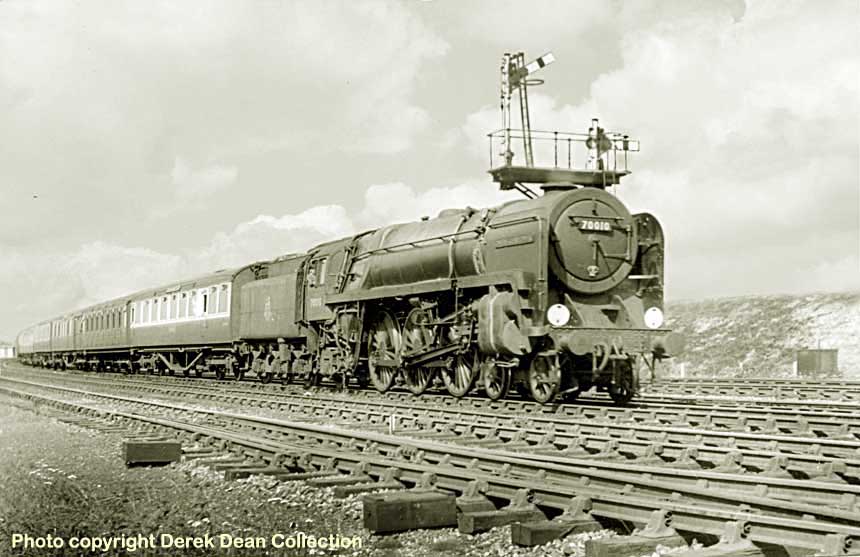
(Above) A neat and tidy Britannia No 70010 Owen Glendower comes off the Norwich-Ely-Cambridge route with a morning express from Norfolk to Liverpool Street in 1954; the location is Copper Mill Junction near Walthamstow Marshes in the London Borough of Waltham Forest; the view shows the cab sheets are now fitted, but the front end is still showing some damage, as with the 1953 image at Cambridge.
 (Inset) FLEXIBLE CAB SHEET: Following complaints from engine crews of draughty conditions in the cab creating a coal dust storm on the footplate, flexible cab sheets were fitted to BR1 tenders from 1953 and took the form of corrugated rubber screens with approximately 12 folds in each sheet that filled the gap between the rear of the cab and the front of the tender. They were formed of two parts, one each side of the engine; the lower ends of the sheet were finished at an angle of 45 degrees and
(Inset) FLEXIBLE CAB SHEET: Following complaints from engine crews of draughty conditions in the cab creating a coal dust storm on the footplate, flexible cab sheets were fitted to BR1 tenders from 1953 and took the form of corrugated rubber screens with approximately 12 folds in each sheet that filled the gap between the rear of the cab and the front of the tender. They were formed of two parts, one each side of the engine; the lower ends of the sheet were finished at an angle of 45 degrees and 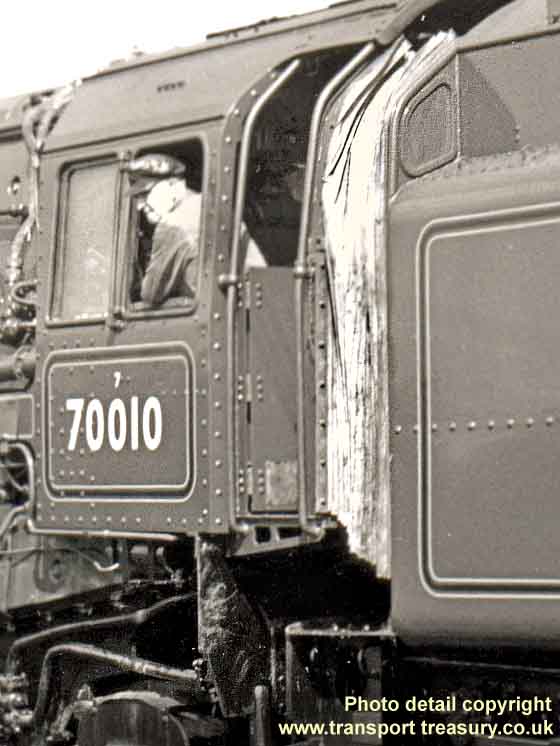 reached a height of about 7ft, just higher than the lower edge of the roof extension. Since they were very difficult to keep clean they were often seen in a bedraggled state and frequently renewed during Works visits.
reached a height of about 7ft, just higher than the lower edge of the roof extension. Since they were very difficult to keep clean they were often seen in a bedraggled state and frequently renewed during Works visits.The cab sheet fixings had to be fabricated by Crewe Works to suit the early Britannia cabs as they were not featured in the original plans. Actual fastening of the edges of the screens was accomplished by the addition of metal plates adjoining the vertical handrail at the rear of the cab, but leaving sufficient clearance for the original rail to be accessible by the crew. Approximately 28 set pins were used to secure each sheet in position. Britannia Nos 70000-70024 were built without these and had to be modified, whereas Nos 70025-70044 had the fittings from new, while the last 10 engines coupled with BR1E tenders did not require them.
(Below) Wendens Ambo is the unusual name of the village served by Audley End Station in North West Essex; this 1954 photo from Lens of Sutton Association shows 70010 Owen Glendower heading an afternoon London express towards Stansted and Bishop's Stortford. The huge bulk of the boiler always looked more powerful from this close angle, while the fireman looks content in the knowledge that there are no stiff climbs ahead for the remaining 42 miles to the capital. Also of note are the wall-mounted electric lanterns set on the west side of the station, while on the east side was the Saffron Walden branch.
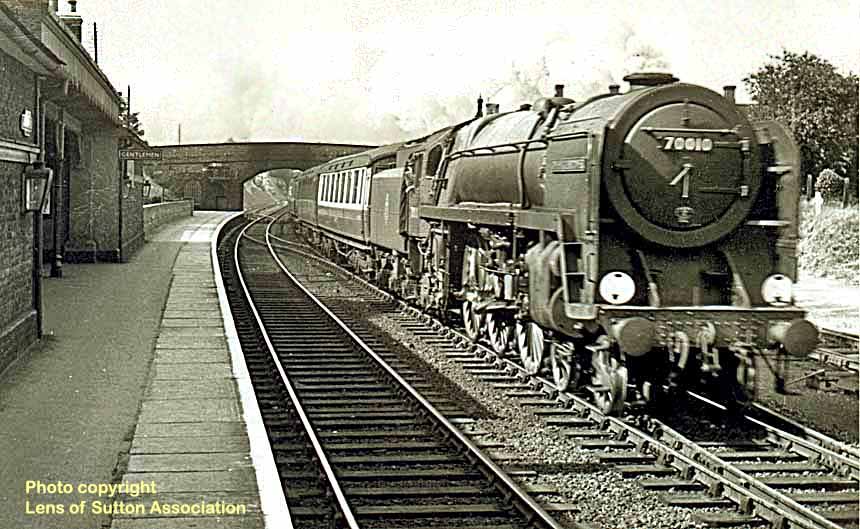
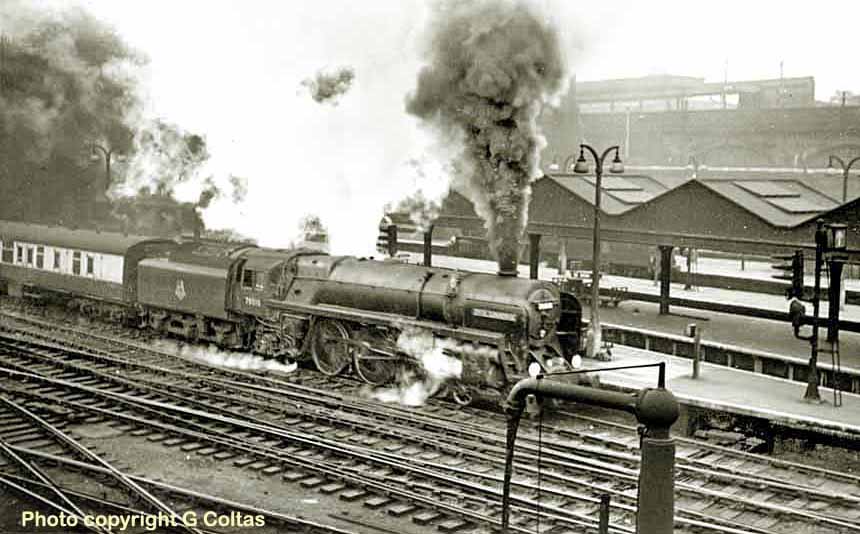
(Above-Below) From the expert eye of Gordon Coltas comes this shot of a strangely quiet Liverpool Street station being awakened by Britannia 7MT 70010 Owen Glendower performing pyrotechnics upon departure for Norwich with the down 'Norfolkman' in July 1954. The Britannia locomotives were not cleared to traverse the route beyond Norwich due to the axle-loadings; therefore the remainder of journey to Cromer and Sheringham was conducted by a lighter engine. (Below) Following arrival at Norwich, a presentably clean Britannia 70010 Owen Glendower waits to back onto the shed at Norwich Thorpe to be watered, coaled and turned in readiness for its next duty. The coaches of the 'Broadsman' brought in by the locomotive are already on their way to Cromer and Sheringham to complete the journey, while another newer Britannia awaits departure with a London express from the adjoining platform.
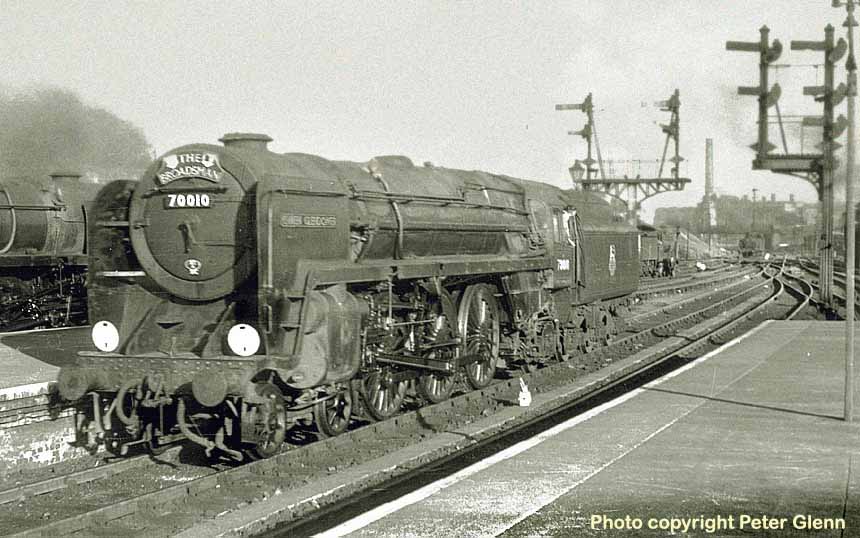
SERVICE RECORD: Although the engine is recorded as going to Norwich Thorpe depot on 5th May 1951, I believe this to be an anomaly because two weeks of running-in were usually allowed for each engine, but the locomotive re-entered Crewe Works on the 9th May for a repair that took just over two weeks to complete, thus the new Britannia would have arrived in Norfolk at the end of the month at the earliest. 70010 Owen Glendower would often be seen hauling Great Eastern express services such as the 'Norfolkman' and the 'East Anglian', also the 'Scandinavian' and the 'Hook Continental' boat trains. The Britannia is recorded as running a good average of 78,000 miles for the first four years of service. 70010 entered Crewe Works on ten occasions, saw repairs done at Stratford Works on five occasions, with around four visits to Doncaster Workshops and again it was the latter that made the most modifications to this particular Britannia. The long-time Norwich shed Foreman, Bill Harvey was said to have a soft spot for this particular engine and made sure that it was cleaned on a regular basis. Following transfer away from Norwich to March in Cambridgeshire, the usage of 70010 lessened, but could be seen on Colchester to Newcastle expresses, or cross-country trains, such as a Newcastle to Bournemouth service, but still ended up in store at March depot in the early part of 1963, as were most of the 16 Britannias allocated there at that time, while a decision was made to decide their fate, and maybe they only survived scrapping because they were relatively new, when compared to other classes. In a strange twist of fate the extremely harsh winter from December 1962 and lasting through to March 1963, served to help the fleet of steam engines as the weather took its toll of the new Diesel locomotives in a number of different ways. The Britannia would have been more likely to be hauling mixed freight or parcel vans for its last four years in service, but mixed in with a few passenger turns mainly through the busy summer seasons and on special turns for sporting occasions.

(Above-Below) Norwich-based Britannia 70010 Owen Glendower rests at March depot in Cambridgeshire before its next turn of duty back to Norfolk. The drive wheel tyres are now looking well-worn and the general upkeep is nothing like the usual high standards for this engine. 19 Britannias were at one time or another allocated at March depot, although only 9 were resident to the bitter end of 1963 when all were transferred to Carlisle depots, either Kingmoor or Upperby to finish their service. (Below) Awaiting its next duty at Liverpool St is Britannia Pacific No. 70010 Owen Glendower, while another classmate is being turned in preparation for a run to Norwich Thorpe. From this unusual angle we can see the exemplary lining of two lines of orange filled with black on both the BR1 tender and cabside; note the centre line of the newer BR emblem is aligned with the centre of the cabside number, but this was not the case when coupled to the larger BR1D version, or indeed when displaying BR's earlier 'Lion and Wheel' emblem, which was sited much lower.
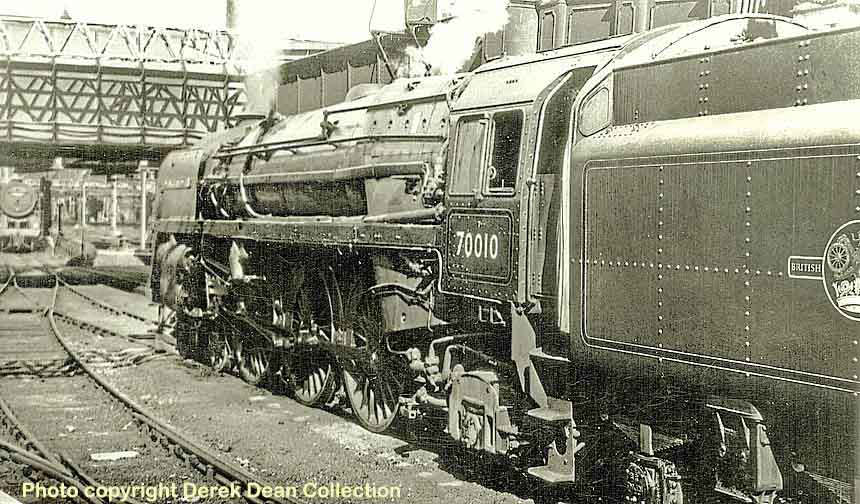
SIGHTINGS: 70010 was new to Norwich just in time for Liverpool Street station's newly extended turntable to be ready and the new timetables to be printed up, but two views of the Britannia show a very unclean engine, one seen in August and the other in September 1951, yet the locomotive was seen in pristine condition racing down Brentwood Bank in July, showing how quickly a steam engine became begrimed with dirt and soot. Once Norwich Thorpe shed staff had become used to the routine of looking after their Britannias, they were seen in much improved levels of cleanliness; this was the case at Shenfield when a very clean 70010 was photographed heading to Norwich with an express consisting of mainly old Gresley-designed carriages in early 1953. The Britannia was ex-works when espied at the top of the 1-in-100 Haughley Bank with a morning train for London, a trip the engine most likely performed twice in the day covering 460 miles over what was basically an undulating route across East Anglia. In September 1959, a sparkling 70010 emerged from Doncaster Works in pristine condition following six weeks of very intense work, including a change of boiler and fitting of the AWS equipment, which was nearly eight years after the accident at Polesworth involving Coronation class 46252 City of Leicester, resulting in a strong recommendation that AWS gear should be fitted without delay to all express engines; it was noted that the AWS system would have prevented the crash. After losing their stronghold of the Great Eastern services to the new diesels, many Britannias moved to March depot and could be seen in Lincolnshire on stopping trains, as in April 1962 when 70010 was pictured at Stamford station heading towards Peterborough, on a line that was as flat as could be and the only intrusions were the multitude of level crossings. The Britannia could still be seen on express turns and was observed at Farington curve junction, near to Preston, with a returning Blackpool to London train in May 1964, and again in December 1965 at Carlisle station awaiting departure with the overnight service from London Euston to Stranrear.
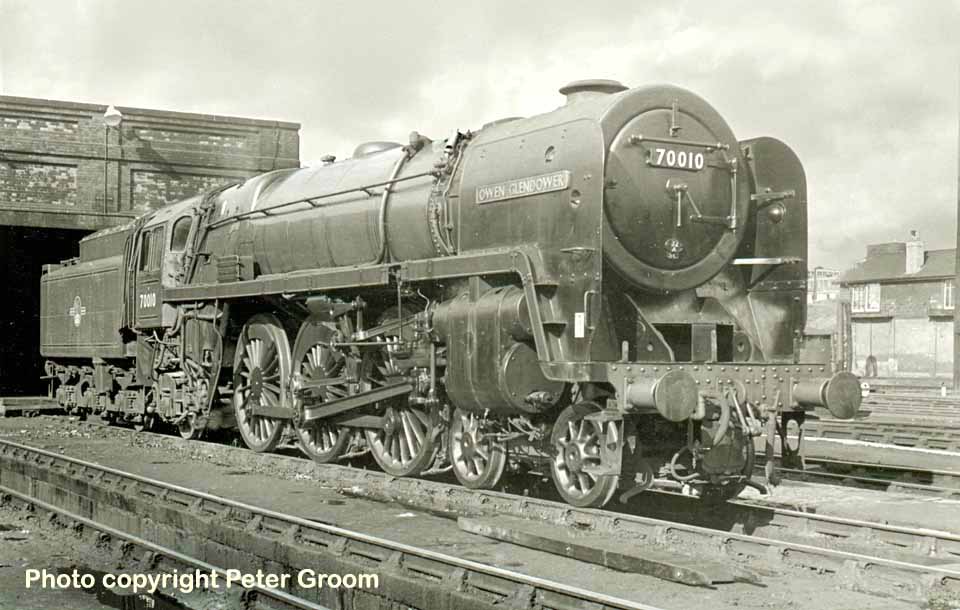
(Above) BR Standard Pacific No 70010 Owen Glendower stands proud at Norwich Thorpe depot (32A) as photographed by master cameraman Peter Groom on the 10th April 1961. 70010 was one of 22 Britannias to see service in Norfolk, although only 10 were long-time residents at 32A where shed Foreman Mr Bill Harvey held a soft spot for this particular locomotive, ensuring it received both regular cleaning and its proper maintenance schedules were adhered to, for which he was justly renowned; indeed his working practices brought their reward with a high availability of the Britannias based at Norwich.
DISPOSAL: 70010 was withdrawn from service was on Saturday 23rd September 1967, the same day as 70039 had been, then stored at Carlisle Kingmoor yard until 30th December 1967 and transferred to J.McWilliams of Shettleston, a suburb just over three miles to the east of Glasgow city centre, where it was cut up in January 1968. The company was responsible for the disposal of over 40% of the Britannia class.
Programme authorised 17th November 1949, built at Crewe Works, completed 14th May 1951 to Order No.E479/220 at a cost of £20,025. Withdrawal took place on 23rd December 1967.
ALLOCATIONS: From brand new 70011 Hotspur was allocated to Norwich Thorpe shed (32A), where the engine served for a little over ten years until 10th September 1961, giving very good service to the Great Eastern section. March depot (31B) in Cambridgeshire was the locomotive's next venue for just over two years until December 1963, then arriving the same week as many classmates at Carlisle Kingmoor MPD (12A), the ultimate destination for the majority of the Britannias. Although the engine was reallocated to Carlisle Upperby depot (12B) from March 1965 until early December 1966, 70011 returned to Kingmoor to complete its service, lasting just another twelve months.

(Above-Below) A beautiful image from Lens of Sutton Collection of Britannia Class Pacific 70011 'Hotspur' at Colchester Station with an express from London Liverpool Street to Norwich Thorpe in 1951. This photo was taken during the very early months of the new services in East Anglia, hence the locomotive is almost brand new, albeit slightly work-stained and the plate covering the lubrication pump is still in prime position, but soon to be discarded. Opened in 1843, the main features at Colchester Station were the curved platforms and corresponding canopies. (Below) A cast brass nameplate, measuring 30"x6", from the BR Standard Class Britannia 4-6-2 No 70011 Hotspur, went under the hammer for £9,500 at a Great Central Railwayana Auction in September 2016. The locomotive was named after the late medieval English nobleman Sir Henry Percy, otherwise known as Harry Hotspur or simply Hotspur; No 70011 was allocated new to Norwich on 14 May 1951 where it remained for ten years before moving to March and later Carlisle Upperby and Kingmoor from where it was withdrawn on 23 December 1967 and despatched for scrap to J. McWilliam at Shettleston on 7 March 1968.

(Below) Preparing to move off platform 4 at Ipswich Town Station is a rather grubby Britannia Pacific 70011 Hotspur with a down express for Norwich on 25th March 1952. The locomotive is not yet one year old and only the axle repairs have been done since construction, although that cover plate for the lubrication pump is now missing and would remain so throughout its career. No 70011 was photographed alongside the platform end servicing point at Ipswich and of note are the 33 canopies that make up the most part of the station roof.
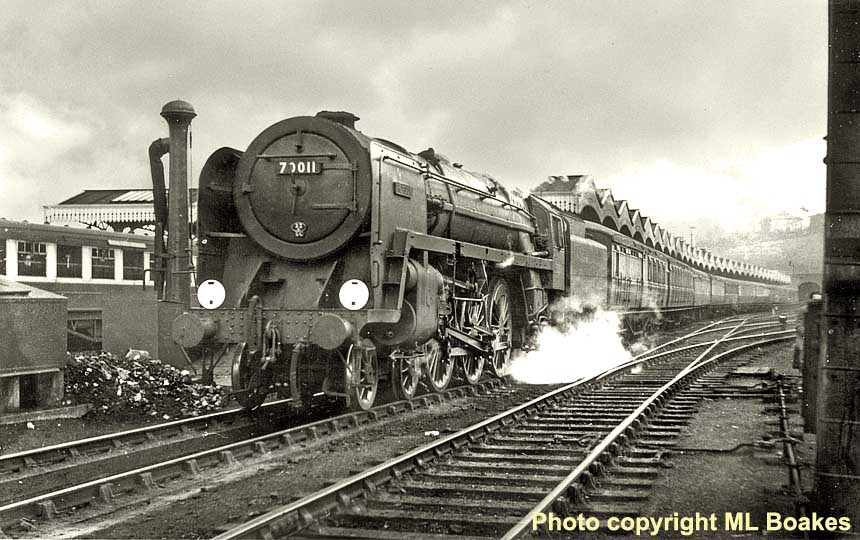
MODIFICATIONS: Unfortunately 70011 Hotspur was among the Britannias to suffer an early failure of the drive axles (item 17) and entered Crewe Works less than four months after construction, with repairs lasting until the end of November 1951. After the modifications, 70011 was seen with a mix of plain and fluted coupling rods (item 14) until June 1958, when all four rods were of the plain variety, which were heavier, but stronger than the fluted type. After a further visit to Crewe Workshops in September 1953 the flexible cab sheets (item 9) appeared; the forward vacuum pipe (item 21) was modified to a much shorter standpipe and hose; a support bracket was added to the front regulator rod (item 5) and the reverse recouperating spring (item 8) was seen to be encased, to avoid locking up in service. On the engine's next visit to Crewe, twelve months later, the tender platform steps (item 10) were added, one each side providing a safer working area for the crew when adding water to the tender, and the regulator rear rodding (item 7) was modified with a support bracket. As a Norwich allocated engine, 70011 was not fitted with a weak-type front step (item 1), but had the full modification applied during its first visit to Doncaster Workshops in the summer of 1956. And again it was Doncaster that carried out much of the modification work on the Britannia class locomotives; in June 1958 70011 was seen with modified smoke deflectors (item 3), altered to LMR type 1, with backing cups to the handholds; also a new BR emblem (item 11) was applied to the sides of the tender at this visit. The engine continued to be maintained by Doncaster Works and received a speedometer unit (item 13) during April 1960, while the AWS (item 20) and its associated equipment was fitted at the same occasion. The Doncaster designed LNER return crank (item 15) never caused any issue at all and thus was not ever altered. The power warning plates (item 19) were added in 1960 and the lamp irons (item 2) were mainly kept to the original long GE section type, however the centre iron was shortened by Doncaster in 1957, then reverted to long type from 1960, yet was changed again in 1964 when the smokebox iron was moved and also changed to LMR type. The smokebox numberplate had been removed in 1964 and a false one fitted, but this was also missing in 1966, yet reappeared later on in 1967.
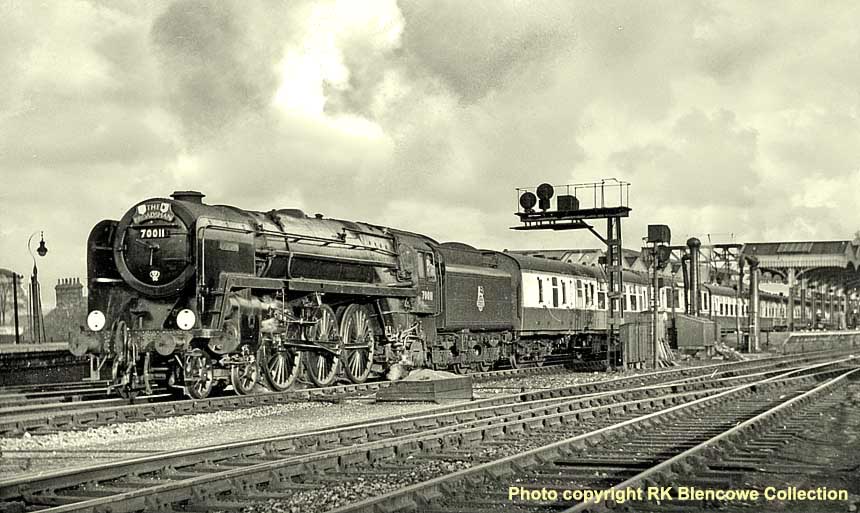
(Above) Fresh from Crewe Works in May 1952, 7MT Britannia 70011 Hotspur is seen leaving Ipswich Station with the down 'Broadsman' which will reverse at Norwich Thorpe before continuing to Cromer and
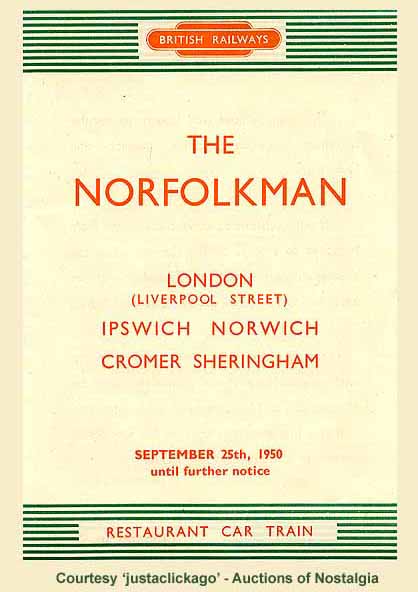 Sheringham. This scene reflects the reason behind BR's decision to construct the class - to accelerate and improve services in East Anglia - a task which the 7MTs' performed admirably, although their effect was muted elsewhere on the network. The opening of Ipswich station in 1860 led to the closure of the original station sited by the Docks, and close to the site of Ipswich locomotive running shed. From the collection of Negative Archives owned by Rod Blencowe.
Sheringham. This scene reflects the reason behind BR's decision to construct the class - to accelerate and improve services in East Anglia - a task which the 7MTs' performed admirably, although their effect was muted elsewhere on the network. The opening of Ipswich station in 1860 led to the closure of the original station sited by the Docks, and close to the site of Ipswich locomotive running shed. From the collection of Negative Archives owned by Rod Blencowe.(Below) Climbing the 1 in 84 incline from Trowse Lower Junction is 7MT Britannia Pacific 70011 Hotspur hauling the late afternoon 'Norfolkman' from Norwich to London Liverpool Street in September 1952. The locomotive is little changed from new and appears in fine condition after recent attention at Crewe Works; renowned photographer ER Morten captured the express passing the signal box and the cattle pens; the latter being well used when Trowse was the terminus for trains prior to the swing bridge opening in 1845.
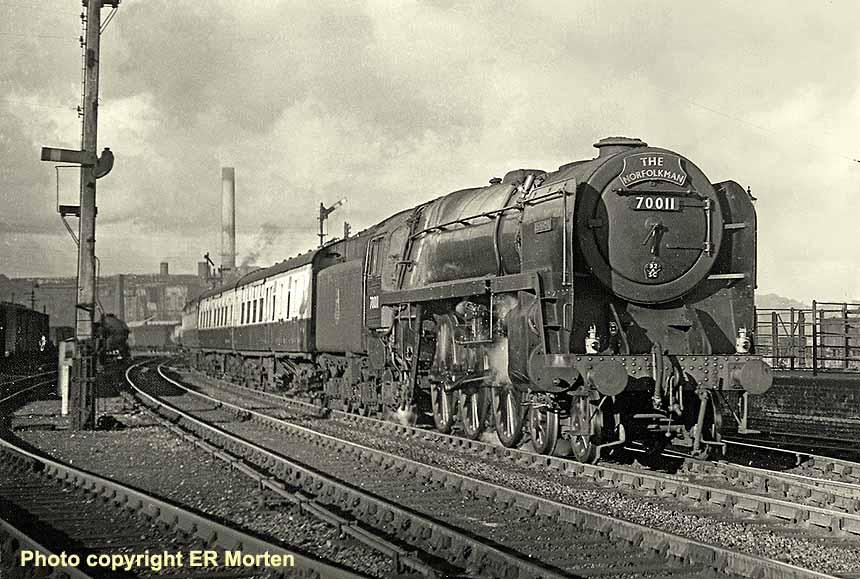
SERVICE RECORD: A nearly new 70011 Hotspur was one of the early casualties of the wheel-shifting episode, which affected seven engines in total, and in service the locomotive broke down at Hatfield Peverel on 4th September 1951. The engine was hauling the early morning newspaper train to Norwich when the incident occurred, causing the papers to be late in the Norwich area that day. Also the engine is recorded as suffering a mainframe fracture during June 1958. Recorded mileages are quite high, but not to any excess: 32,000 miles in 1951, which was basically only 4 months in service; 78,000 in 1953; 67,000 during 1954 and 76,000 for 1955. 70011 entered Crewe Works on nine occasions, with another eight visits to Doncaster Workshops and again it was the latter that made the most modifications to this particular Britannia. The locomotive was well used on the Great Eastern express services such as the 'Broadsman' and the 'East Anglian', also the 'Scandinavian' and the 'Hook Continental' boat trains. After transfer away from Norwich to March in Cambridgeshire, the Britannia's deployment lessened and 70011 would be more often employed on freight turns to York and Doncaster. The locomotive was in store at March depot in the latter part of 1963, as were most of the Britannias allocated there at that time, while decisions were made at top level to decide their fate, and maybe they only survived because they were relatively new, when compared to other classes.
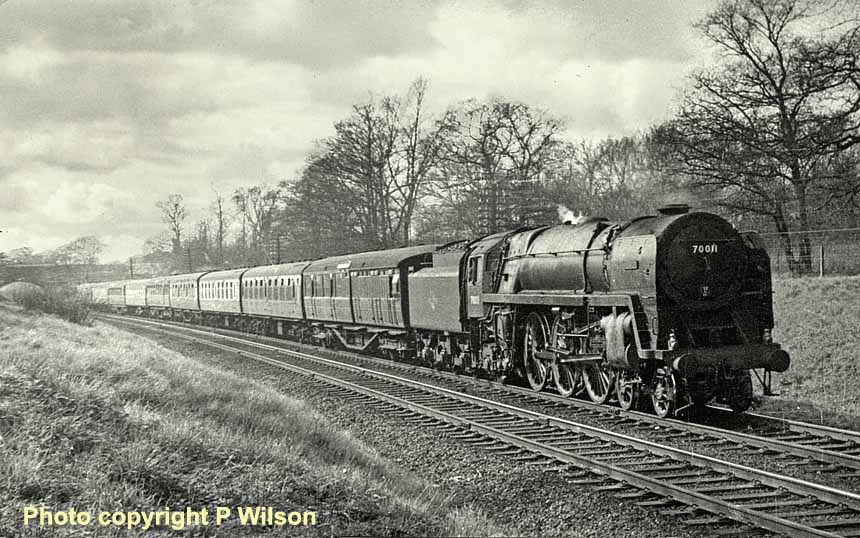
(Above) Approaching Colchester is Britannia 70011 Hotspur with a down express comprised of a strange mix-match of coaches. The engine has recently received a smoke deflector modification and is showing a full-head of steam, so is well in command of the situation. Colchester Station was a very important junction on the route to Ipswich, giving access to Wyvenhoe, Brightlingsea and Clacton-on-Sea mainly, but also Walton-on-the-Naze.
(Below) Looking ready for action at Ardsley shed is March-allocated Britannia 70011 Hotspur, captured here by BKB Green for Initial Photographics in 1962. The former GNR shed (37A) was a brick-built eight-track affair, rebuilt with a concrete louvre type roof and recoded 56B under BR ownership. The shed was located south of Leeds and had a whole range of engines resident there, with LNER A1, A3, V2 classes prominent and still some J50s, which were known as Ardsley Tanks. The shed closed in late 1965.
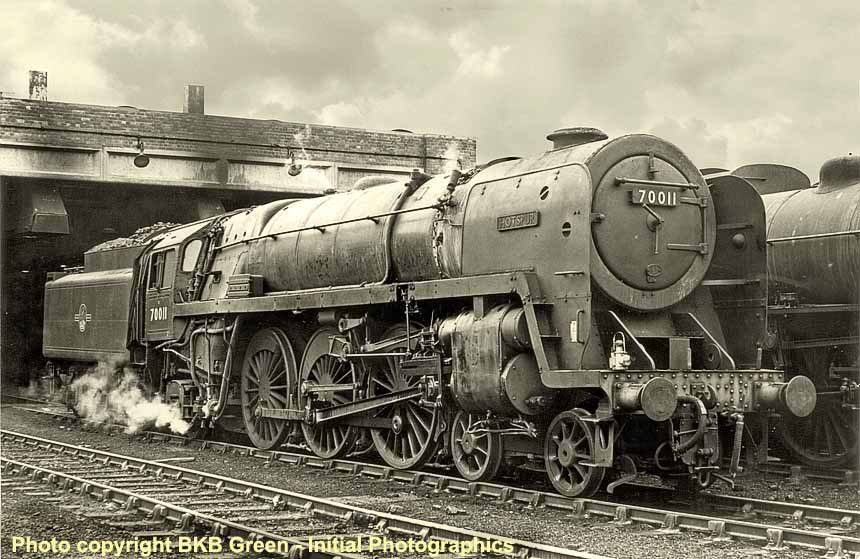
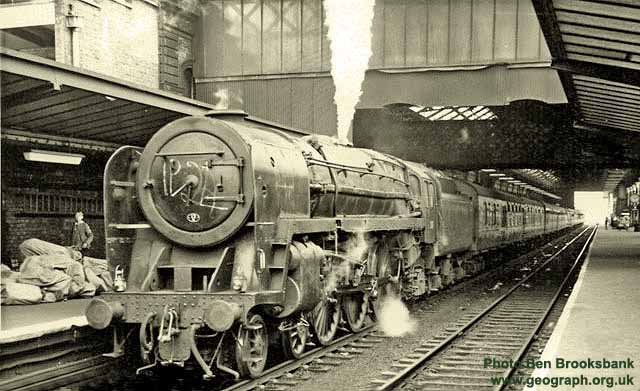
(Above) A fine shot by Ben Brooksbank of 7MT No 70011, now devoid of its 'Hotspur' nameplates, awaiting departure from Preston's platform 5 (the 'down' main) with a Manchester Victoria to Glasgow Central express on 23rd July 1966. The Carlisle Upperby engine is seen in decent condition, a legacy of its visit to Crewe Works in January, but reflects a rather odd look in plain green livery without any lining at all, and lacking a smokebox numberplate. Of note is the passenger footbridge situated above the first coach of the express.
SIGHTINGS: A gleaming and resplendent 70011 Hotspur was seen at rest at Crewe South shed after a running-in trip to Manchester during the first week of trials following construction in May 1951. The following April, a very smart looking 70011 was pictured at speed passing Ipswich Locomotive depot with a morning express from Norwich, going forward to London. When seen at Stratford MPD in May 1955, the locomotive was less than pristine, but had undergone a General Overhaul only two months previously, showing how quickly the gleaming paintwork disappeared under a cloak of grime, if not cleaned occasionally. The scene at Bethnal Green was a spectacular one; railway infrastructure abounded, six lines all elevated, a very clean Britannia 70011 Hotspur seen coasting down the short 1 in 70 incline towards Liverpool Street, hauling an express from Norwich early in 1957. The following summer a rather down-at-heel 70011 was viewed at Shenfield with the 'Butlins Express' bringing returning holidaymakers from Clacton-on-Sea, but it was noticeable that the locomotive was now carrying modified smoke deflectors. Much later, in 1962, the engine was seen waiting entry to Doncaster Works and had been completely de-greased, showing that the paintwork needed attention, and the nameplate was still backed with light blue paint; however when seen shortly after, the colour had changed to red, consistent with LMR engines. Unusually the engine was photographed at Newport High Street Station, in South Wales, ready to leave with a so-called West & North service, which 70011 would take as far as Crewe, as it was still a March allocated engine at that time, in 1962. While the engine was shedded at Carlisle Upperby (12B) it was seen in reasonable condition at Birkenhead Motive Power Depot being serviced before returning north.
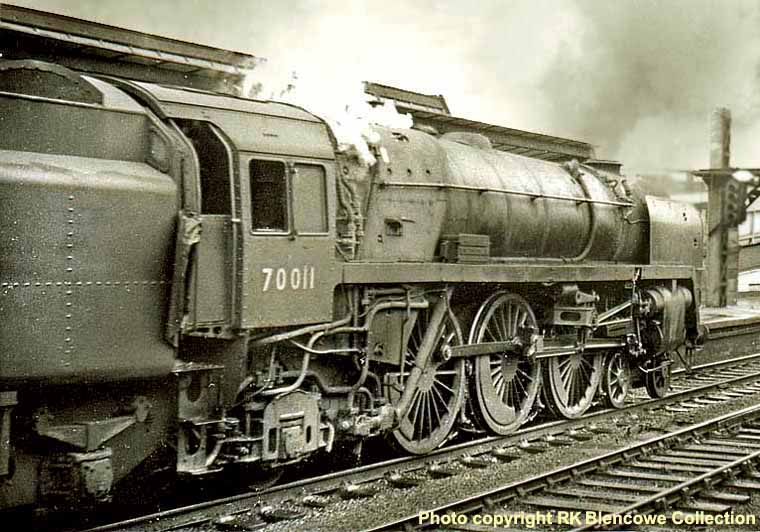
(Above) Rod Blencowe presents us with this image of a work-worn 7P6F Britannia 70011, formerly Hotspur awaiting departure with a northbound train at Carlisle Citadel Station in July 1966. At this time 38 Britannias were allocated to two Carlisle sheds - 28 at Kingmoor 12A, and 10 at Upperby 12B; by the end of the year the number was still 38, but all were based at Kingmoor following closure of Upperby in December 1966. Four Britannia locomotives did not see any service at the Carlisle sheds, whereas 13 of the class were by then withdrawn.
DISPOSAL: 70011 was withdrawn from service on Saturday 23rd December 1967, stored at Carlisle Kingmoor yard until 7th March 1967 and then transferred to J.McWilliams of Shettleston, a suburb just over three miles to the east of Glasgow city centre, where it was cut up in April 1968. The company was responsible for the disposal of over 40% of the Britannia class.
Programme authorised 17th November 1949, built at Crewe Works, completed 21st May 1951 to Order No.E479/220 at a cost of £20,025. Withdrawal took place on Saturday 30th December 1967.
ALLOCATIONS: 70012 John of Gaunt began its revenue-earning service at Norwich Thorpe depot (32A), although the new timetables for the GE lines were not quite written up. Rather strangely, in October 1958 the engine was moved to Stratford MPD at a time when the thinking was quite the reverse, but less than three months later 70012 was transferred to Yarmouth shed (32D) - surely an unsuitable allocation for a Pacific engine. This move lasted only three weeks before the engine rejoined the familiar surroundings of Norwich Thorpe yard in the fourth week of January 1959 until its services were no longer needed on the Great Eastern and the Britannia moved over to March depot (31B) in Cambridgeshire. The locomotive was then transferred to the London Midland Region from March 1963 with a move to Willesden MPD (1A) in North London, followed by moves to Crewe North (5A) in January 1965, then Crewe South depot (5B) in June that year. A short interlude at Llandudno Junction shed (6J) interrupted almost twelve months at (5B) depot before moving to Carlisle Kingmoor MPD (12A) from August 1966, for a final fling.
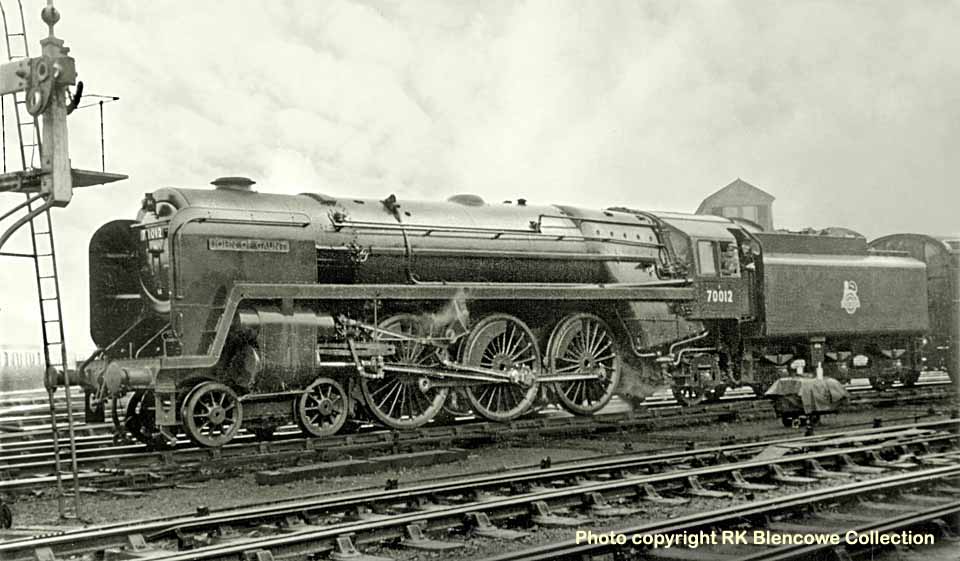
(Above-Below) The redoubtable rail cameraman Rod Blencowe took this nicely-posed photograph of brand new 7MT Britannia Pacific No 70012 John of Gaunt during a running-in turn at Shrewsbury. From this angle the similarity between the Britannia's hollow axles with those on the Coronation Class Pacifics can be clearly seen, albeit the latter had larger wheel centres and suffered no problems. Just visible above the cab is the Severn Junction Signal Box; the box was based on a design from 1876, and had 180 levers making it the largest in the world. (Below) One of many such images from the formidable BKB Green for Initial Photographics is this shot of a resplendent Britannia Pacific 70012 John of Gaunt awaiting departure with the northbound 'Broadsman' from Ipswich early in 1953. 70012 will continue to Norwich where the train will reverse and a lighter engine attached for the remainder of the journey to Cromer and Sheringham. The headboard has the two crests displayed, one for Norfolk and the other representing Suffolk, while the train consists of the usual mix of both Gresley and British Railways coaching stock.
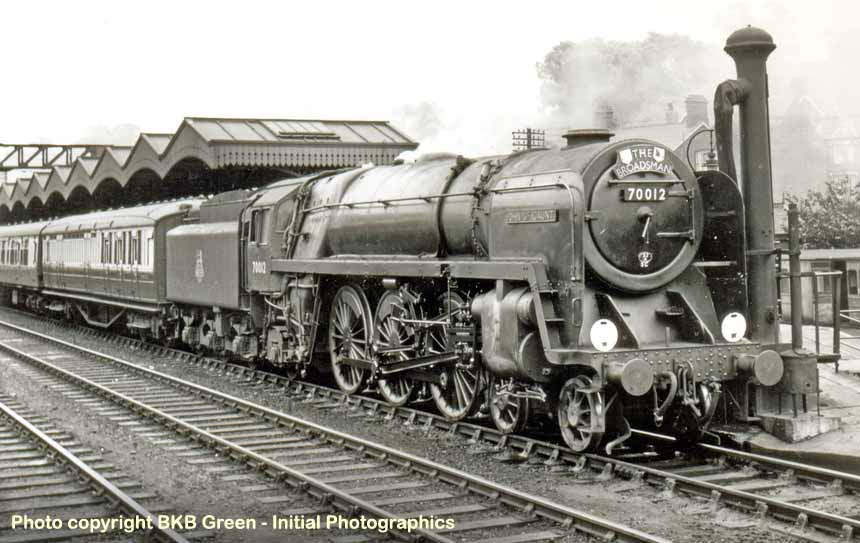
MODIFICATIONS: Fortunately 70012 John of Gaunt did not suffer an early failure of the drive axles (item 17), but entered Crewe Works in due course during December 1951, reappearing in February 1952, also with the vacuum pipe (item 21) modified. After the modifications, 70012 was seen with a mix of plain and fluted coupling rods (item 14) until March 1953, when all four rods fitted were now of the plain variety, which were heavier, but stronger than the fluted type and were changed by Crewe Works along with the additions of the cab flexible sheets (item 9); a support bracket added to the front regulator rod (item 5) and the reverser recuperating spring (item 8) was seen to be encased, to avoid locking up of the same, in service. On the engine's next visit to Crewe, in September 1954, the tender steps (item 10) were added giving the fireman a safer environment to work in when refilling with water.
The Doncaster designed LNER return crank (item 15) was replaced with the LMR version, which is secured by four studs, when the engine visited Crewe Works during November and December 1955 and was also seen with the regulator rear rod (item 7) supported with a steady bracket, to try to rectify vibrations in service. 70012 was not fitted with any raised sand box lids at any time, and was not fitted with a weak-type front step (item 1), being a Norwich resident, but had the full modification applied during its first visit to Doncaster Workshops in September 1957 coupled with the new British Railways emblem (item 11) to the
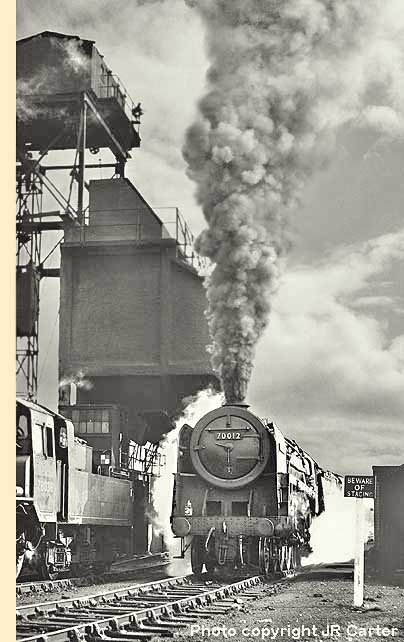 sides of the tender and the nearside lubrication operating rod (item 18) was much shortened to give more delivery to the piston, cylinder and valves on that side. The Britannia was seen with modified smoke deflectors (item 3), altered to LMR type 1, with backing cups to the handholds when the engine left Doncaster Works in October 1958; also a strange reversal took place because the LMS return crank (item 15) was removed and the original LNER version was again seen in service.
sides of the tender and the nearside lubrication operating rod (item 18) was much shortened to give more delivery to the piston, cylinder and valves on that side. The Britannia was seen with modified smoke deflectors (item 3), altered to LMR type 1, with backing cups to the handholds when the engine left Doncaster Works in October 1958; also a strange reversal took place because the LMS return crank (item 15) was removed and the original LNER version was again seen in service. It is worth noting here that of the 55-strong 'Britannia' class, 39 received the modification to the deflectors; Doncaster completed 25 of these which is equivalent to 64%, the other 14 (36%) were carried out by Swindon Works. 70012 continued to be maintained by Doncaster and again entered the Works in September 1960, having the AWS equipment fitted, followed by a further visit there in September 1961, when a full overhaul was carried out and a speedometer unit (item 13) was fitted, somewhat belatedly bearing in mind that 70045 was constructed in June 1954, with a speedometer in place. Quite surprisingly the original long GE lamp irons (item 2) remained right to the bitter end for 70012, but the irons were moved for safety reasons when the engine was shopped at Crewe Works in June 1965; also at this time the nameplates were removed for safekeeping.
(Above right-Below) This rather bizarre scene was captured on film by the redoubtable Jim Carter, as Britannia 4-6-2 70012 struggles to move from a position adjacent to the unusual design of coaling stage at Crewe South MPD. A very clean 9F was subesequently called in to add its not inconsiderable power to the rear end of the Britannia to assist in freeing the stricken engine, but even with over 60,000 lbs of tractive effort to call upon, the struggle continues for a while longer before success is achieved and the locomotive is freed from its embarrassing position. The cause of the fracas was basically the badly sunken rail line which caused a sudden drop of the offside centre drive wheel, which locked against the recently renewed brake-blocks and much cursing among attendant railwaymen followed.
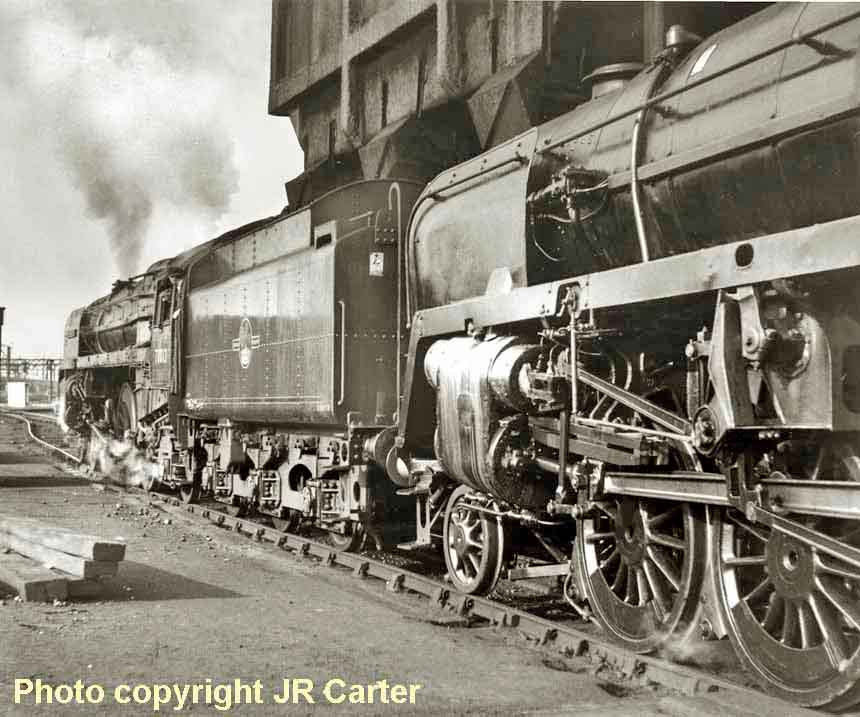

(Above-Below) The old 3-track brick-built locoshed at Colchester (30E) is the scene for this image by Rod Blencowe, showing 7MT Britannia Class No 70012 John of Gaunt being prepared for duty in March 1959, the same year the depot closed. The engine has the LNER return crank back on, plus a modified front step and smoke deflectors have been fitted, but 70012 is still awaiting the AWS equipment to be added. (Below) Stuart Blencowe has captured this image showing Britannia Pacific 70012 John of Gaunt waiting its turn at the water gantry at New England depot in September 1961. By this date the engine had just left the safety of its Norwich base, its home for the last ten years, and headed for pastures new at March shed (31B), where 18 classmates also found favour up to the end of 1963. The New England depot was a large 9-track affair which housed a variety of LNER loco types, plus 85 WD 2-8-0's and 40 9F 2-10-0 types were allocated there at various times until closure in 1965.
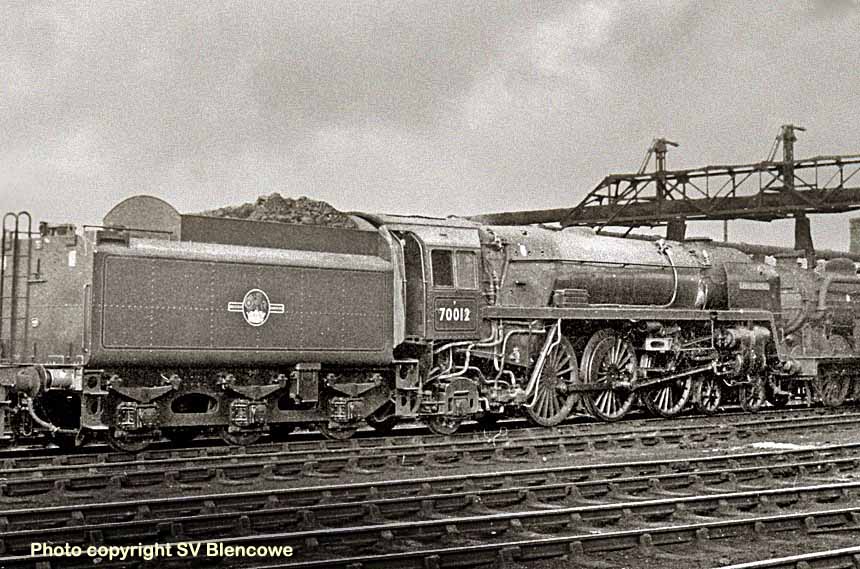
SERVICE RECORD: Recorded mileages for 70012 John of Gaunt are of a high average with 79,000 miles returned for 1953, 70,000 shown for 1954 and a slightly better 76,000 for 1955. It is worth noting that, based on 50 weeks of service in any given year; allowing for two weeks of maintenance per year and assuming the locomotive is operating a six-day working week - then a figure of 75,000 miles is only achieved by running 250 miles per day, everyday throughout the whole year. 70012 entered Crewe Works on eight occasions, Stratford Works just once, with another eight visits to Doncaster Workshops and again it was the latter that made the most modifications to this particular Britannia. The locomotive was well used on the Great Eastern express services such as the 'Norfolkman' and the 'East Anglian', also the 'Scandinavian' and the 'Day Continental' boat trains. During August 1957, 70012 was hauling an evening express between Norwich and Ipswich, when the locomotive broke away from the tender and the rest of the train, which came to a rather rapid stop due to the loss of vacuum. However the engine carried on for some time before the panic-stricken driver managed to bring the speed down by use of the reverser and gradually to a halt. It was fortunate that the fireman was well positioned to avoid falling off the footplate at the crucial moment. The incident was caused by the towing pin fracturing due to metal fatigue; indeed this had occurred previously with some of the other GE-allocated Britannias, due in part to the 'switchback' nature of the Great Eastern lines between London, Ipswich and Norwich putting extreme pressure on both sides of the towing pin. The running sheds were aware of the issue and it had already been decided to fit safety chains to all of the class before this near-miss had happened. After transfer from Norwich to March in Cambridgeshire, the day to day schedules of express trains were fewer, but some passenger work to York, Newcastle and Lowestoft were diagrammed for a 7MT Britannia class engine. 70012 John of Gaunt was chosen for a Derby Works open day and for the RCTS Rail Tour of North Lincolnshire, both in 1965. 70012 was coupled to a BR1 tender from new, but this was swapped for a BR1D type tender very late into 1967; this replacement tender came off a withdrawn engine and because the BR1Ds were constructed later, they would have been in better condition.
Along with eight other Britannias, 70012 remained in service to the last official day, 30th December 1967, thus 70012 has the distinction of being the longest serving member of the class.
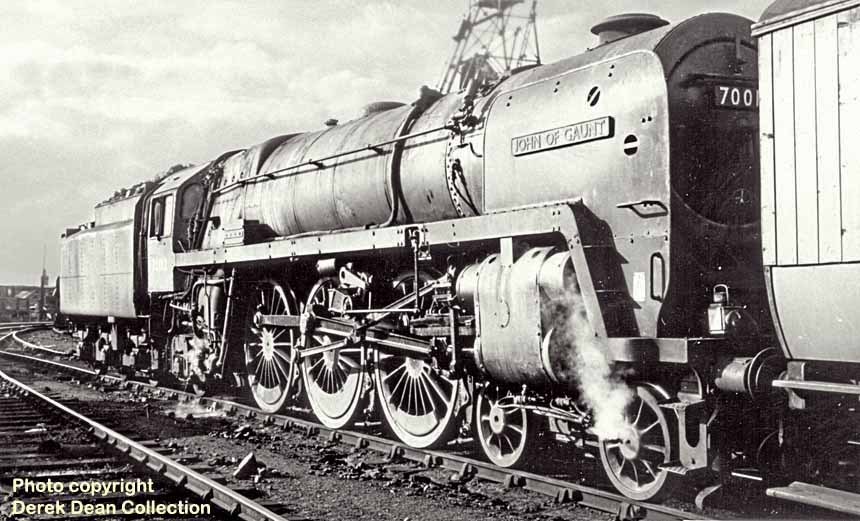
(Above-Below) This splendid back-lit image of 4-6-2 Britannia 70012 John of Gaunt at rest at Willesden MPD (1A) in North London, affords a good view of the Britannia's Walschaerts valve operating gear. The main drive wheels are 6ft 2in diameter and have 20 spokes, while the front bogie wheels have just 9; also the large balance weight on the centre pair encompasses eight of the wheel's spokes to help counteract revolving and reciprocating weights. In May 1954 the Willesden roundhouse was cleaned to a fault in order to accommodate the International Railway Congress Exhibition which displayed a range of new British Railways types, including Britannia 70037 Hereward the Wake. (Below) The loco yard at Willesden depot seems to be filled to maximum capacity as Britannia 70028 John of Gaunt stands at rest on the canal side of the site on 5th April 1965. The engine looks decidedly down-at-heel and reflects the lack of maintenance at this period of time, with the exhaust joint cover missing from the top of the cylinder assembly and the joint leaking steam; also the untidy state of the pipework for the AWS equipment.
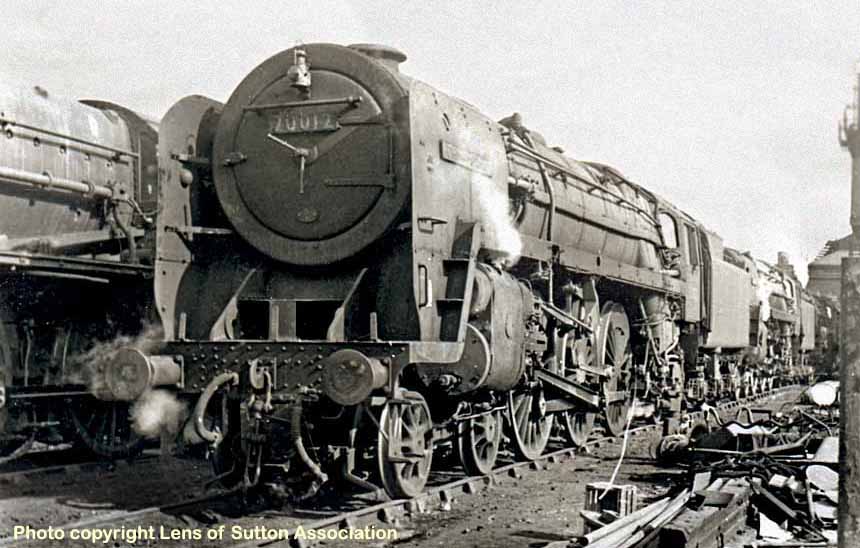
SIGHTINGS: 70012 John of Gaunt was photographed at the massive Stratford depot yard in very good condition following a recent works visit in March 1952, but the locomotive was surrounded by spent ash from a multitude of engines. In 1955 a resplendent Britannia was espied sweeping along Haughley bank with the London-bound 'Norfolkman' with the classic lines of the uncluttered engine in unison with a rake of eleven BR crimson and cream coaches trailing behind. A couple of years later another fine image was captured displaying a very clean Britannia entering Ipswich Station from the country end with a Norwich-London train comprised of Gresley coaches, some Thompson variety and topped off with BR Mk1 coaching stock. All this glorious splendour and magnificence just could not last much longer and sure enough in August 1959 a grime encrusted engine, with no BR emblem visible, was thoughtfully committed to film at Liverpool Street Station on a Norwich service. Of note was the LNER return crank had now been refitted to 70012 following a couple of years working with the LMR version, as applied to the centre axle drive wheel. During August 1962 a very creditably clean March-allocated engine was viewed at the head of an express leaving York Station to the south and passing under Holgate Bridge with a long rake of repainted Gresley carriages. After a good overhaul at Crewe Works the engine was selected for the annual Derby Works Open Day and as you would expect the Britannia was presented in exemplary fashion to the delight of many young lads, and doubtless one or two older ones too.
(Below) Paul Claxton has given us another wonderful image from 1965, this one showing Britannia Pacific 70012, formerly John of Gaunt, shunting a single carriage on the through road between platforms 2 and 3 at Preston Station. Having recently been shopped at Crewe, where it was fitted with a replacement boiler, the engine looks in fine condition, although the front end has experienced a heavy knock on the nearside front causing the crazy angle of the lamp.
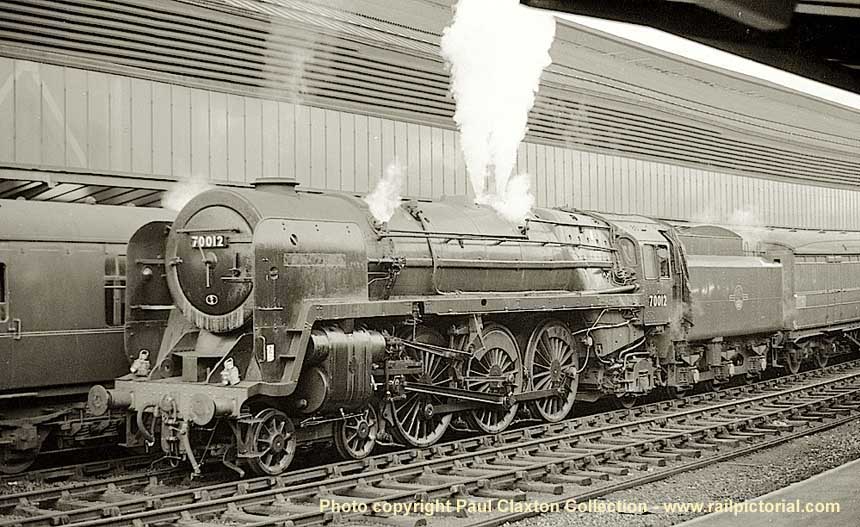
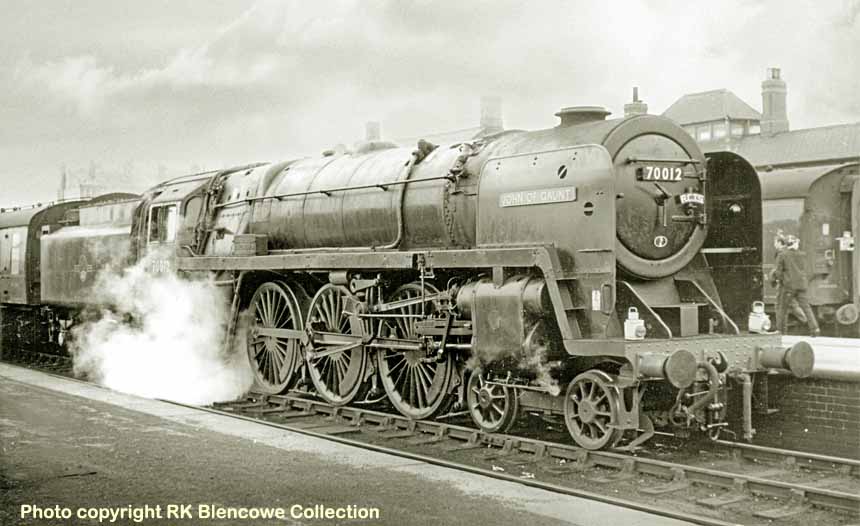
(Above) A thoroughly well presented Britannia 70012 John of Gaunt - sporting what appear to be its original nameplates, or some very good replacements - is captured by cameraman Rod Blencowe at Cleethorpes Station in north-east Lincolnshire on 2 October 1965; the engine is pausing for a photo-shoot during the RCTS (East Midlands Branch) tour of North Lincolnshire. The railtour began at Nottingham Midland Station and travelled via Sleaford and Boston, finishing the outward leg at New Holland Pier.
DISPOSAL: Withdrawal took place on Saturday 30th December 1967 and the engine was put into storage at Carlisle Kingmoor until the end of March 1968, when 70012 was moved to TW Wards of Beighton, in Sheffield for cutting up in April 1968.
Programme authorised 17th November 1949, built at Crewe Works and completed on 30th May 1951, to Order No E479/220 costing £20,025. Withdrawal was on Saturday 17th August 1968 from Carnforth, followed by preservation by the National Railway Museum.
ALLOCATIONS: 70013 was allocated initially to Norwich MPD (32A) where it worked for more than ten years except for a four month spell at Ipswich shed (32B) from September 1958. Leaving Norwich Thorpe in September 1961, 70013 was repositioned at March, but by the summer of 1963 the locomotive was no longer needed and ended up at Carlisle Kingmoor (12A) along with eight other class members until February 1965; this was followed by a transfer to Carlisle Upperby (12B) then a return to Kingmoor in December 1966 until the end of steam workings in December the following year. However, unlike other Britannia members facing the cutters' torch, good fortune came to pass when 70013 was selected by British Railways to haul a number of special trains throughout 1968, hence a complete overhaul was carried out by Crewe Works and Carnforth MPD was selected as the base from where the engine would work and be serviced as and when required.
(Below) Haughley Bank in Suffolk was a regular foray for master cameraman, Dr Ian Cameron Allen, who recorded the changing face of rail traffic on the line from Stowmarket towards Haughley Junction, Norwich and Bury St Edmunds. Introduced in 1951, the Britannias were the first Pacifics to be regularly seen on the Eastern Region's GE section where they ruled the roost on express passenger services between London and Norwich for a little in excess of ten years, producing constantly low figures in coal consumption in conjunction with high levels of availability and advancing the timetable to a high degree. During the late summer of 1951, Dr Ian Cameron Allen captured nearly-new BR Standard 70013 'Oliver Cromwell' climbing the 1 in 131 incline to Haughley station with an afternoon express bound for Norwich. The loco is displaying a rather poor pair of white discs in place of headlamps each side of the buffer beam; this indicates a standard locomotive headlamp code for an express passenger train. Click HERE to visit the excellent Transport Treasury website.
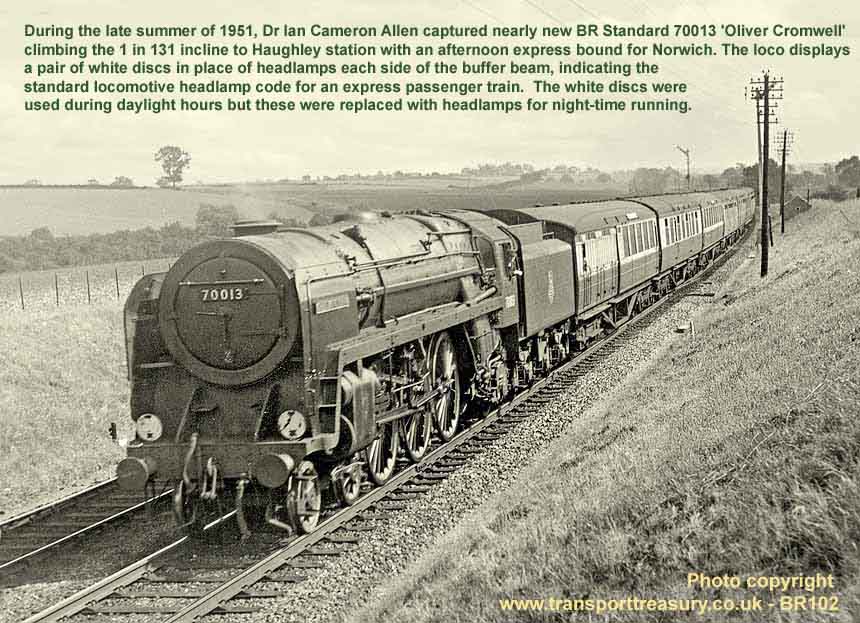

(Above) 70013 'Oliver Cromwell' was the fifth Britannia Pacific to roll off the production line at Crewe Works in May 1951. The locomotive is pictured here alongside the Old Works building dating back to 1843. Compared to the introduction of the doyen of the class, when 70013 entered traffic it had a modified low dome, indicated by the more pronounced cover; however it did undergo a further 18 modifications and changes throughout its career, though this doesn't include numerous changes of BR1 type tender. Behind the Pacific is Ivatt Class 2-6-2T 41258, a Leeds Farnley Junction engine throughout its very short career from 1949 to 1962. Click HERE to visit the Rail Photoprints website.
(Below) This splendid study of No 70013 'Oliver Cromwell' awaiting departure at Colchester Station with a Norwich train, allows us to reflect on the clean lines of the BR 7MT Britannia design. The beautifully elegant station at Colchester was built by the Eastern Counties Railway in 1843; the water tank beyond the platform canopy supplied the small locomotive depot (30E), the home of many LNER 4-6-0 and 0-6-0 types; the shed closed at the end of 1959. The LOSA archive contains thousands of quality photographs. Details can be obtained at Lens of Sutton Association 46, Edenhurst Road, Longbridge, Birmingham, B31 4PQ.
For the record, the word 'Lens' is, in fact, derived from the name of the gentleman, John L Smith, who started the business. A major contributor to this site, Ed Chaplin, remembers Len well. Ed writes...
'Len ran his business 'Lens of Sutton' from 4 Velmead Road, Carshalton, the next place after Sutton on the SR line via Mitcham Junction to either London Bridge or Victoria. I knew every rail joint on that line. My in-laws lived in Sutton, so it was convenient during visits on a Saturday between 1985 and 1990 to call in and buy some black and white photos from him. He and I were both (then) smokers, and as I always gave him three or four fags he let me have a look at his pictures and never charged the full price of 12p or 15p each. He let me have them for 10p and then rounded down the total to a number of pounds. He was a true pal of enthusiasts, and very often people like Dick Riley, who I once saw there poring over his photos with Len, plus I met with numerous other enthusiasts who popped in on a Saturday to have a chinwag with Len; indeed I've known Len from as far back as the mid-50s when he had his business at 50 Carshalton Road, Sutton, a shop perched precipitously above a huge depression near Sutton station. In those days I lived near Sutton and collected Hornby Dublo electric trains. He had a good second-hand business and I picked up quite a few wagons and pieces of track, all at 'acceptable to a schoolboy' prices. The second-hand trade has always had its fair share of hucksters, but Len was known as an honest and fair man, and an immediate friend of anyone who shared his passion for trains and buses. I never saw him not wearing his beret, in the street and in the shop. The photo and magazine collecting scene today only further confirms his important contribution to the hobby we enjoy so much. A full Obituary and Appreciation of Len appeared in the railway press after his passing, but I cannot pinpoint it just now…'
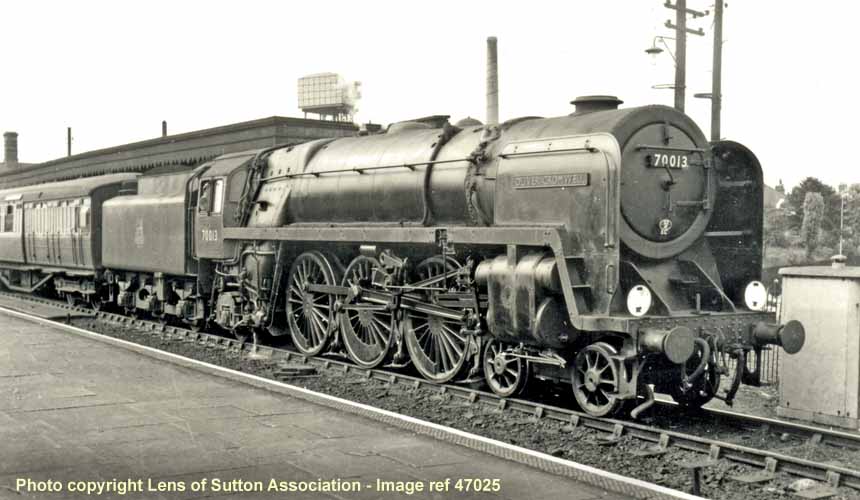
MODIFICATIONS: 70013 Oliver Cromwell was among the first eight Britannias to work from Norwich Thorpe depot and all the initial Pacifics were required to have their axles (item 17) reset. However, 70013 had to wait until after Christmas 1951 before Crewe made a start on this repair work, reappearing the first week of February 1952 with, initially, fluted coupling rods (item 14) in place; in addition the vacuum pipe (item 21) was modified, though this only affecting the first 19 engines Nos 70000-18. By May 1953 No 70013 was modified at Crewe Works with a steady bracket (item 5) for the forward regulator rod, while the original fluted type coupling rods (item 14) were replaced by the plain variety which were heavier and stronger. A flexible cab sheet (item 9) was fitted early in 1954 by Crewe Works, followed later in the year by the tender step (item 10) to aid the crews safety. In October 1955 Crewe Works changed the LNER return crank (item 15) to the LMS version, which 70013 kept for the remainder of its service. As with most all of the Class in service, the modifications at Crewe were done in piecemeal fashion with no real pattern to any of the work carried out. However, all subsequent work was done by Doncaster, which was more accessible to Norwich engines, and many modifications took place over the four years from August 1957 until November 1961. These included the front step (item 1) and the new BR emblem (item 11), which were added at the end of September 1957 and it was noted that the nearside lubrication operating rod (item 18) had been shortened in order to increase the rate of delivery of oil to the cylinder and valves. 70013 'Oliver Cromwell' was eventually fitted with the AWS equipment (item 20) plus the smoke deflectors were modified to LMR 1 type during May 1959, again at Doncaster Works. In all, 12 Britannias were so treated during 1959, ten of them at Doncaster; the remaining two Nos 70024 and 70029 being modified by Swindon Works. An ensuing entry to Doncaster saw the speedometer unit (item 13) fitted in December 1960, while it is interesting to note that the locomotive tender was recorded as changed four times during 1960. Early into 1960 the power warning plates (item 19) were affixed to the locomotive, back and front, to remind footplate crews of the relevant danger when working in close proximity to the overhead wires. Few changes occurred thereafter except for the nameplates being removed in late 1964, the lamp irons (item 2) were repositioned and the original front number plate was seen to be missing in 1966.
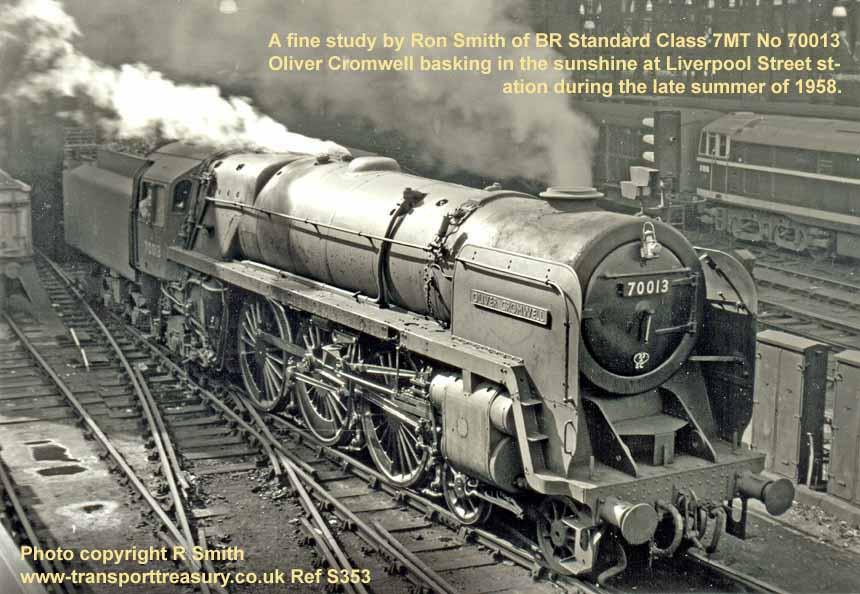
(Above) Another fine study from the Transport Treasury archives is this shot of BR Standard 70013 'Oliver Cromwell' at rest by the taxi-ramp at Liverpool Street station in London, as perceived by Ron Smith during late summer of 1958. The engine had undergone repairs at Doncaster at the start of the year and was in good mechanical condition, but now covered in a layer of dust and soot although showing a full-head of steam and ready to return to Norwich. The image allows a good view of the superheater pipe which rises from the injector assembly, runs along the boiler walkway to a point level with the centre of the first drive-axle then flanks the boiler to reach the 'header' of the superheater allowing saturated steam to become 'superheated' and increase its thermal efficiency, producing more work from the engine. On the right is D5516, one of twenty Brush Type 2 A1A-A1A pilot scheme diesels Nos D55001-19 (later TOPS Class 30) ordered by the British Transport Commission; additional orders were placed with Brush that culminated in a production run of a total of 263 locomotives (Class 31) all built to the same basic design, but with the Mirrlees engine uprated to 1,365hp, together with a change-over to the (Blue Star) coupling system making the class compatible with most other manufacturers designs at that time. At the end of 1957, the first Brush Type 2s were working on the Eastern Region, followed in March 1958 by the arrival of ten new EE Co Type 4 D200s (Class 40s). The times were a-changing!
(Below) We must thank Rail Cameraman, Barry Hilton, for capturing this scene of BR Standard 70013 'Oliver Cromwell' coupled with an unidentified Class A4 Pacific and a third unknown engine to form what spotters nicknamed the 'Plant Streamer'; this was a regular occurrence at Doncaster as newly-released engines from 'the Plant' were conveyed to the MPD (36A) for final inspection and testing by the running shed. The date is April 1959 and three other Britannias were receiving attention at Doncaster Works: 70005 'John Milton', 70034 'Thomas Hardy' and 70039 'Sir Christopher Wren', all in Crimpsall Works for heavy repairs; indeed between 1956 and the end of 1962 a large proportion of Britannia engines were modified and maintained at Doncaster; this included over 63% of smoke deflectors changes and 75% of speedometers fitted in service being completed there, plus 62% of the AWS equipment was added by Doncaster - even 35% of the front step modifications were carried out at the 'Plant'.
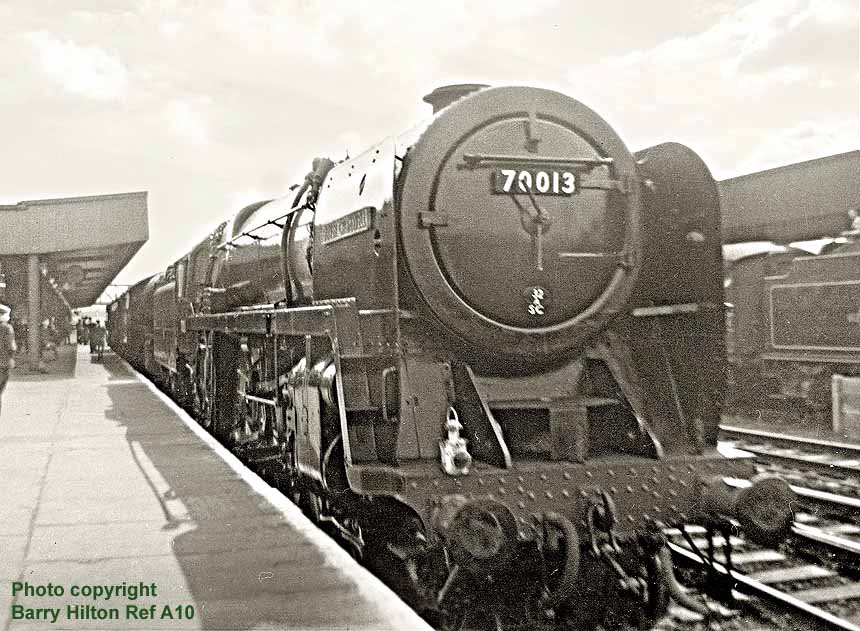
SERVICE RECORD:The Norwich engine was not one of the top ten in the class to register high annual mileages, but it did manage a return of 80,000 miles for 1953 and a reasonable 70K the subsequent year; this was followed by a very similar 69,000 the year after that, but no more recorded figures are available. The stalwart Norwich-based engine was recorded as entering Stratford Works on two occasions early in its career; it also had repairs carried out at Crewe Works six times and saw most modifications completed during eight visits to the workshops at Doncaster. The Britannia was a regular performer on the 'Broadsman', 'Norfolkman' and 'East Anglian', the latter being a business train augmented in 1937 which was given a new timetable for the summer of 1951, although the journey times were only trimmed by five minutes. 70013 'Oliver Cromwell' was not without its problems in running, but this was no more than the average Britannia which were worked hard and gave good service and availability on the Great Eastern express passenger services. Bill Harvey, Norwich Thorpe's Supremo, was diligent and forthright in his approach to maintaining the Britannias in his charge and soon realised that the reason for the constant breakage of the boiler stays was due to cold water hitting hot surfaces and reasoned that hot/warm water should be used for such work. During 1957, it was found that the drive wheels of 70013 had moved in relation to each other; this was caused by the square locking keys, which held the drive wheels in the correct position, being moved and pushed out (ie forced out) resulting in major work being undertaken at Doncaster Works. Towards the latter part of 1960, a substantial crack was noted within the mainframe and this, of course, required immediate remedial treatment, again by Doncaster Works. Only a relative short time later a problem occurred within one of the cylinders; on close inspection it was found that the inner lining had shifted and blocked off the oil supply causing a compression ring failure and consequent lack of power, however this defect occurred four times before actual replacement of the offending cylinder was actioned by Doncaster Works, a delay doubtless caused by austerity measures.
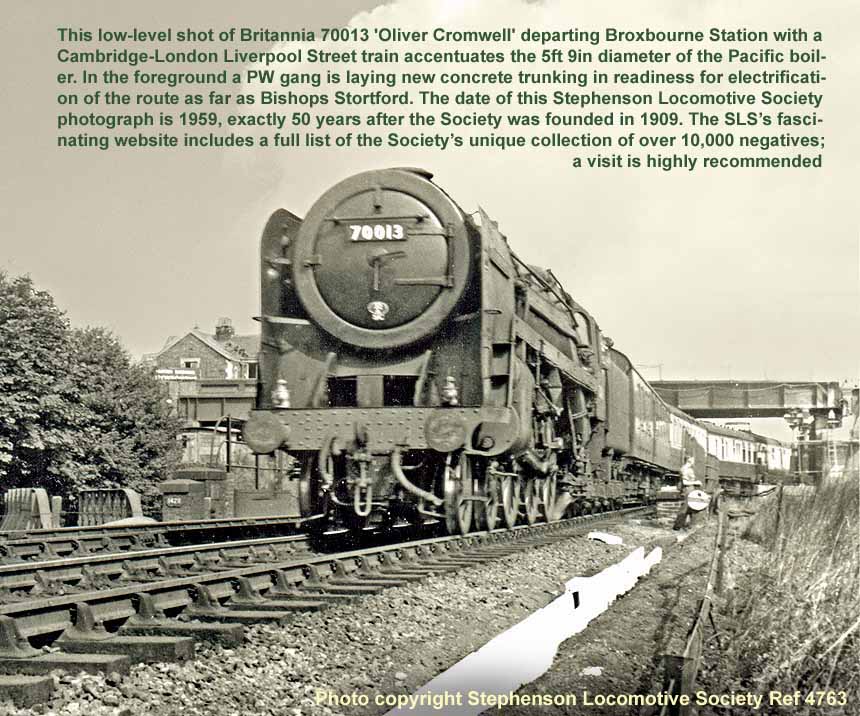
(Above) The driver of Britannia 70013 'Oliver Cromwell' keeps a good lookout as his charge pulls steadily away from Broxbourne Station with a Cambridge-London Liverpool Street. This low-level shot highlights the 5ft 9in diameter of the Pacific boiler and the 13 feet to the top of the chimney, while the modified smoke deflectors are now prominent and only the speedometer unit has yet to be added. The station signboard can be seen just above the road bridge on the left which spans both the railway and River Lee at this point; in the foreground a PW gang is laying new concrete trunking in readiness for electrification of the route as far as Bishops Stortford. The date of this Stephenson Locomotive Society photograph is 1959, exactly 50 years after the Society was founded in 1909. Click HERE to visit the SLS's excellent website which includes a page listing the Society's unique collection of over 10,000 negatives covering pre-Grouping, Grouping and the post-1948 nationalised era of British Railways.
(Below) This top-notch capture by Dr Ian Cameron Allen perfectly encapsulates the effect of the Britannia Pacifics in East Anglia. A spritely-looking ten year-old 70013 'Oliver Cromwell' moves easily away from Norwich Thorpe station en route to London Liverpool Street station, a journey of 115 miles via Ipswich, or slightly longer via the much easier Ely and Cambridge route. Norwich Thorpe Steam Locomotive depot was situated beyond the signal box on the extreme left, while a sign of the times is the new diesel fuelling point used by the Eastern Region's more modern traction introduced in 1958 on Great Eastern lines.
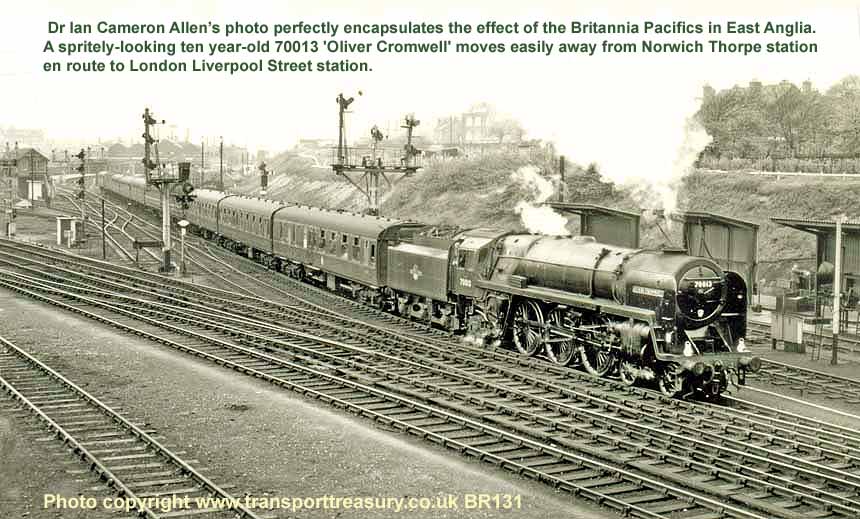
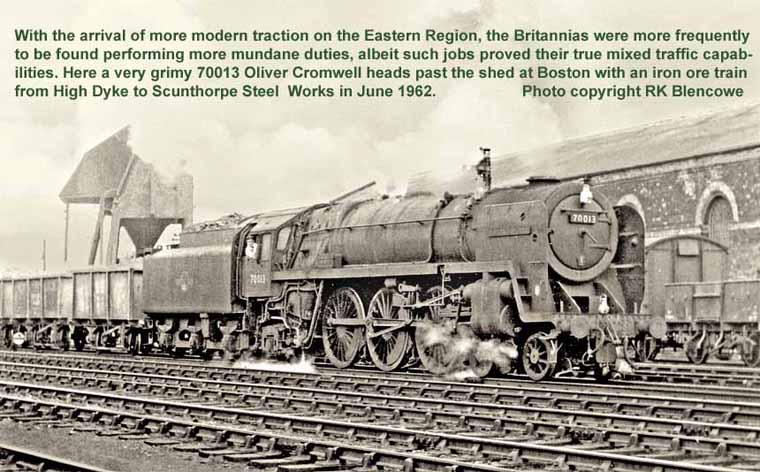
(Above) In contrast to the previous image, with the onset of modernisation the Britannias were more frequently to be seen performing more mundane duties, albeit the tasks involved did prove their true mixed traffic capabilities; here a very grimy 70013 Oliver Cromwell heads past the shed at Boston with an iron ore train from High Dyke to Scunthorpe Steel Works in June 1962. The decade heralded a period of some uncertainty for the Class 7MT Britannias, with many sheds finding it increasingly difficult to obtain suitable work for them. The 9-track Boston depot (40F) was home to many Ivatt Class 4 2-6-0 'Flying Pigs', Gresley-designed K2s and J6 freight engines; the shed closed early 1964.
(Below) Rail Tour 1Z95 is seen awaiting the start signal from platform 16 at Manchester Victoria station behind BR Standard Britannia 70013 'Oliver Cromwell', as witnessed by Jim Carter on June 1 1968. The train would be banked by Newton Heath's 'Black 5' 44884 for sharp climb of Miles Platting Bank, as the 'special' worked its way eastwards towards Guide Bridge and beyond. Of particular note on 70013 is the damage to the offside front valance which has caused the headlamp to be sitting at a rather odd angle.
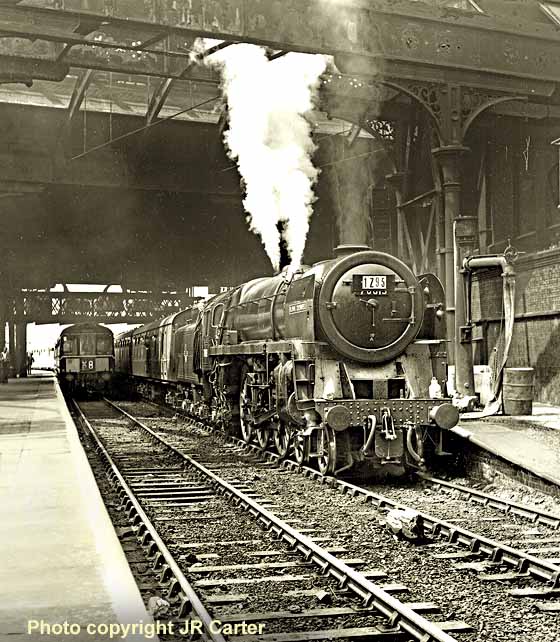

(Above) Steam footplate cameraman Jim Carter was well known for scaling a coaling tower or ash plant to gain the best vantage points for his overhead shots, but I have no idea how he achieved the required height to pull off this remarkable photograph of '1Z95-Grand Rail Tour No 5' departing Manchester Victoria station on 1st June 1968. 70013 had brought the train from Carnforth, via Preston and Bolton to continue on to Guide Bridge before giving way to an electric locomotive for the run over the Woodhead route to Sheffield. 70013.
(Below) It is not very often that we have the benefit of viewing both sides of the same subject at one time, so many thanks to retired railway signalman Keith Long, whose wonderful Flickr website 'Cabsaab900' can be found HERE. The following images of 7MT Britannia 70013 'Oliver Cromwell' were taken at Carlisle Kingmoor depot on 16 July 1967 after the Pacific had entered Crewe Works for an extensive and comprehensive overhaul taking 9 weeks, even allowing for the Christmas holidays. The removal of the original nameplates in 1965 reveal the 8 bolt-holes used to secure the plates to the smoke deflectors; also the lubrication operating rod was as original length, which was rarely seen to be any different on this side.
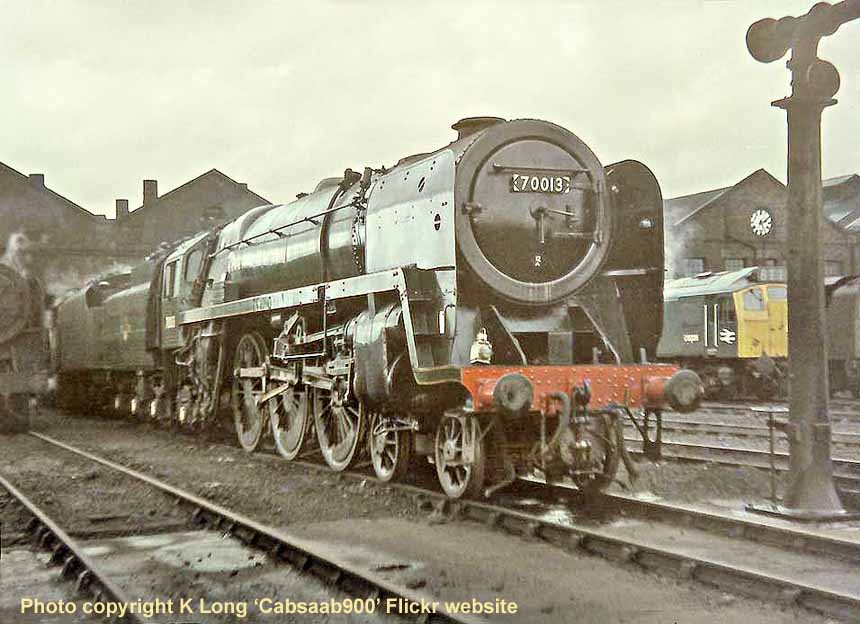
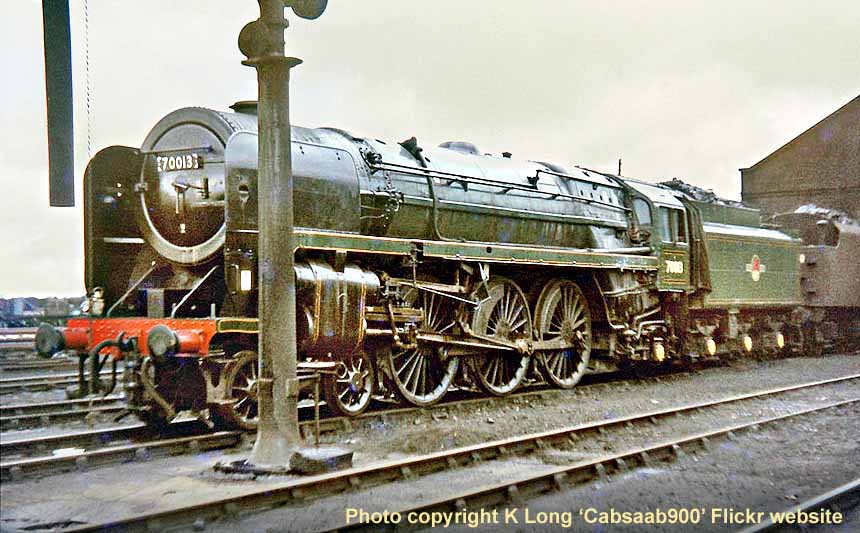
(Above) On the nearside of the locomotive we find that the relative lubrication operating rod had been shortened (from 1957, in fact) and with the benefit of better lighting conditions on this image, we can be certain that the lamp irons are in new positions; the replacement numberplate is slightly different to the original (altered spacings) and the tender step is now of WR type having claimed a reconditioned unit (BR1 No 773) which was previously coupled to 70014 'Iron Duke' and therefore of lower mileage.
(Inset Right) The last Britannia Pacific in British Railways service is seen at rest inside the relative calm of Carnforth MPD (10A) but the engine still had five more 'Rail Tours' to officiate, including the infamous '15 Guinea Special' on the 11th August before 70013 'Oliver Cromwell' moved into preservation at Bressingham. The raking light inside the depot has been skilfully used by Bill Wright to highlight many details on the sparkling paintwork and to show the AWS' relative pipework running from under the cab along the lower
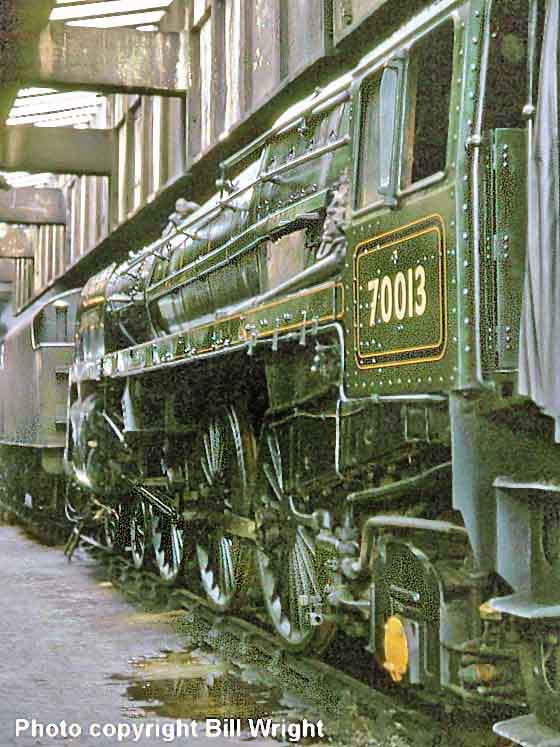 edge of the boiler walkway as far as the lubrication pump; also prominent is the concertinaed rubber cab sheet and the yellow-painted end-plate for the trailing axle, depicting a change of lubrication used from heavy-oil to light grease on this and the tender axles. Click HERE to vist Bill Wright's 'Rail Cameraman' page, where links to his excellent 'Barking Bill' Flickr website can be found.
edge of the boiler walkway as far as the lubrication pump; also prominent is the concertinaed rubber cab sheet and the yellow-painted end-plate for the trailing axle, depicting a change of lubrication used from heavy-oil to light grease on this and the tender axles. Click HERE to vist Bill Wright's 'Rail Cameraman' page, where links to his excellent 'Barking Bill' Flickr website can be found.SIGHTINGS: A very early image of 70013 'Oliver Cromwell' reflects a very clean engine backing out of a rather decrepit looking track area between platforms 11 and 12 on the east-side of Liverpool Street station. Another early view at the London terminus shows the engine primed to depart with the down 'Broadsman', proudly displaying the upgraded headboard now embellished with two crests showing sailing vessels and a windmill in the background, a scene very similar to the Great Eastern Railway postcard produced by Mr. Raphael Tuck in 1905; indeed a major feature of Norfolk's flat, fertile land is the wide expanse of rivers and lakes, which gave rise to the construction of five swing bridges to allow sail boats to navigate as far inland as required and the railway almost complete access across the region. Of the five river crossings, the Trowse swing bridge was the most used and in 1953 Britannia 70013 was pictured moving steadily across the 1905-built structure with yet another express train into Norwich Thorpe. During the summer of 1954, a slightly less than clean Britannia was observed reversing light engine down to Liverpool Street station; the only item of note was the cab sheet, made of concertinaed rubber, which had been newly fitted between the cab and tender. Then in January 1957, before the front step had been upgraded, but by which time the tender step was in place, the clean uncluttered lines of 70013 'Oliver Cromwell' was clear to see when the locomotive was observed in the large expansive yard at Stratford in east London. During the busy summer season in 1960, 70013 was viewed near Pontefract Baghill hauling a long rake of flat-sided Southern Region rolling stock; the Britannia had taken over this Newcastle-Bournemouth express at York and was using the S&K joint loop line to reach Sheffield. The Swinton and Knottingley Joint Railway was formed to connect the Midland and Great Central lines at
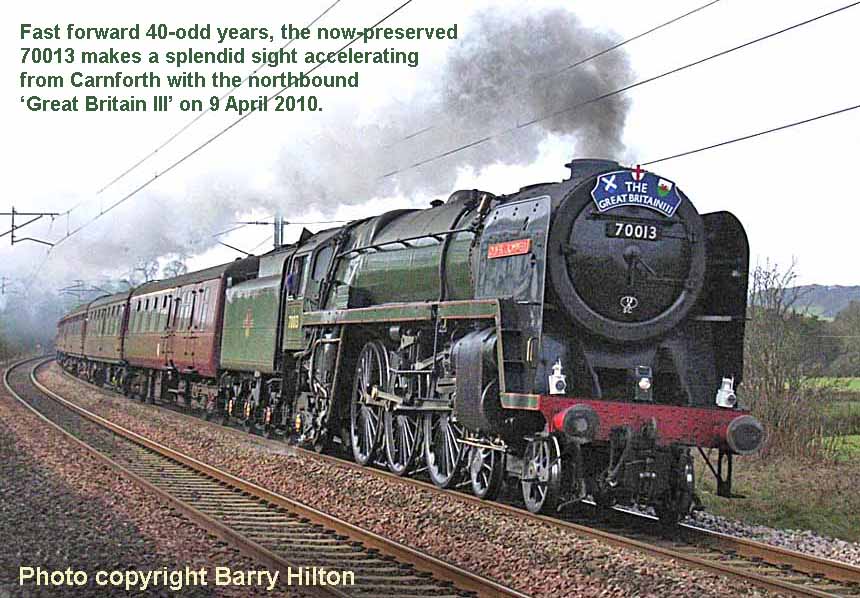 Swinton, north of Rotherham, with the North Eastern Railway at Ferrybridge, near Knottingley, a distance of sixteen miles, thus opening up a more direct route between York and the Sheffield area. Seen on far more common ground in June 1961, a relatively clean 70013 'Oliver Cromwell' entered Liverpool Street station at the head of an early morning train from Clacton on Sea in Essex, a journey of some 70 miles, with its arrival at the capital timed very close to 08.00 am. By 1961, the influx of new diesel locomotives had taken over many express duties in East Anglia which led to the Britannias working many different trains away from their normal trips to Norwich; consequently the class was reallocated away from Norwich Thorpe depot to March shed (31B). Thereafter very little was seen of 70013 on film, but the engine was simply biding its time for it wasn't long before stardom struck and the clamour to record the passing of the 'Last Day of Steam' turned into a torrent, a virtual sea of both still and cine cameras accompanied by expensive sound recording systems to preserve that lasting memory of the actual day that BR steam traction ceased. Follwing 70013's prolonged and expensive overhaul at Crewe Works, a grand total of 16 Railtours were organised including the infamous '15 Guinea Special' on the 11th August 1968, which involved Britannia 70013 'Oliver Cromwell' hauling the train from Manchester to Carlisle, with other legs of the special's itinerary shared by three 'Black Fives', 45110, 44871 and 44781.
Swinton, north of Rotherham, with the North Eastern Railway at Ferrybridge, near Knottingley, a distance of sixteen miles, thus opening up a more direct route between York and the Sheffield area. Seen on far more common ground in June 1961, a relatively clean 70013 'Oliver Cromwell' entered Liverpool Street station at the head of an early morning train from Clacton on Sea in Essex, a journey of some 70 miles, with its arrival at the capital timed very close to 08.00 am. By 1961, the influx of new diesel locomotives had taken over many express duties in East Anglia which led to the Britannias working many different trains away from their normal trips to Norwich; consequently the class was reallocated away from Norwich Thorpe depot to March shed (31B). Thereafter very little was seen of 70013 on film, but the engine was simply biding its time for it wasn't long before stardom struck and the clamour to record the passing of the 'Last Day of Steam' turned into a torrent, a virtual sea of both still and cine cameras accompanied by expensive sound recording systems to preserve that lasting memory of the actual day that BR steam traction ceased. Follwing 70013's prolonged and expensive overhaul at Crewe Works, a grand total of 16 Railtours were organised including the infamous '15 Guinea Special' on the 11th August 1968, which involved Britannia 70013 'Oliver Cromwell' hauling the train from Manchester to Carlisle, with other legs of the special's itinerary shared by three 'Black Fives', 45110, 44871 and 44781. DISPOSAL: Only for the second instance the locomotive was not disposed of, but, of course, it was fortunate to be selected for preservation.
Built at Crewe Works, completed 2nd June 1951 to Order No E479/220 and costing £20,025. Withdrawn from Carlisle Kingmoor MPD on 30th December 1967, and scrapped at Carlisle Viaduct Yard on 12th March 1968.
ALLOCATIONS: Initially, but very briefly, to the ER's Norwich Thorpe MPD (32A) spending just eight days there. This was followed by a spell on the Southern Region with a move to Nine Elms MPD (70A) from 10th June to 6th October 1951; then on to Stewarts Lane MPD (73A) where 70014 settled into the role of back-up engine to 70004 'William Shakespeare' for close on seven years. 70014's allocations came thick and fast after this time, starting with a move to Kentish Town MPD (14B) on 21st June 1958, but this lasted just three weeks before the next transfer beckoned at Trafford Park MPD (9E) from 13th July 1958 to 30th December 1960. 70014 then moved to Newton Heath MPD (26A) followed by a move to Neasden MPD in September 1961, staying there until 28th June 1962 when a transfer to Annesley MPD (16D) ensued, but again this was all too brief. Before the year was out 70014 had moved to Willesden MPD (1A) on 10th November 1962 but by 22nd December the itinerant engine was allocated to Llandudno Junction MPD (6G). The following year, 'Iron Duke' settled for a while at Willesden MPD (1A) from 18th May 1963 to 2nd January 1965, but then moved to Crewe North MPD (5A) until the shed closed its doors to steam. This meant another move on the cards, this time to Crewe South shed (5B), before returning to Llandudno Junction MPD (6G) on 26th February 1966 for just two months followed by a move back to Crewe South MPD (5B) on 19th June 1966. Finally the nomadic 70014 joined the massed ranks of 'Britannias' at Carlisle Kingmoor depot (12A) on 20th
 August 1966; indeed taking all of these moves into account, 70014 covered many areas of Britain during his career.
August 1966; indeed taking all of these moves into account, 70014 covered many areas of Britain during his career.(Left-Below) A nameplate measuring 34½" long, in superb ex-loco condition, went under the hammer for £15,000 at a Sheffield Railwayana Auction on 15th December 2012. 'Iron Duke' was the nickname of the 1st Duke of Wellington. (Below) A magnificent sight to behold, a new Britannia class engine in the yard at Crewe Works on a fine summer's day during June 1951. This was one of the pair destined to be entrusted with hauling the prestigious 'Golden Arrow' Pullman trains from London to Dover (or Folkestone), albeit 70014 Iron Duke performed the role of 'back-up engine' for close on seven years.
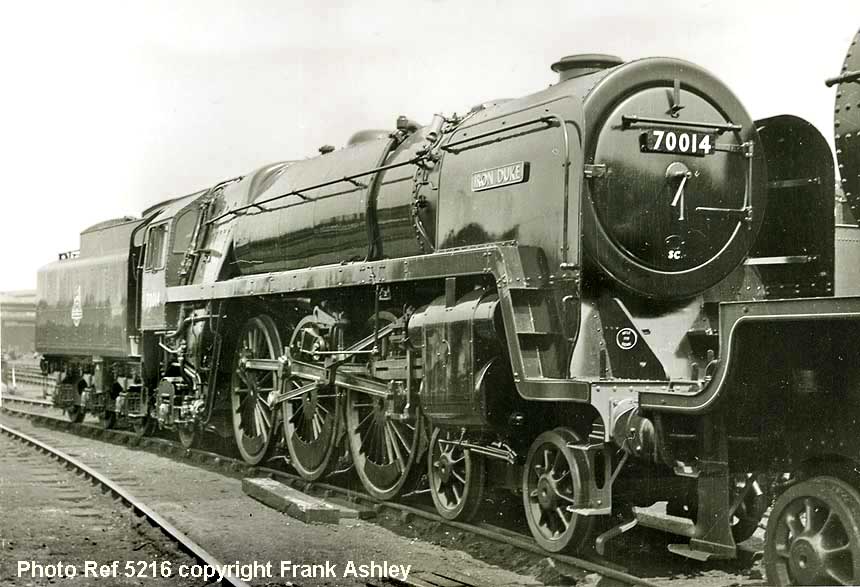
MODIFICATIONS: As seen above, Iron Duke was not built with a low dome cover (item 6), but did succumb to failure due to the Axle shift (item 17) problems during July 1951; this being the very first incident. The problem was not fully understood at that time, and repairs at Brighton Works were more of an interim measure than a permanent one. Thus a full modification was not carried out until May 1952 when the front coupling rods (item 14) were changed to the plain variety; also the vacuum pipe (item 21) was altered at this time, and shortly after the tender step (item 10) was fitted and the cab sheet (item 9) also appeared; while the long lamp irons (item 2) were seen at Folkestone fitted on either side of the buffer beam from November 1952 (see below).
(Below) Captured on the turntable at Folkestone Junction by the doyen of railway photographers, Henry Casserley; 70014 Iron Duke is being turned in readiness for the return journey to the Capital with the up Golden Arrow; tricolor flags and long lamp irons prominent. Dated Saturday 14th August 1954.
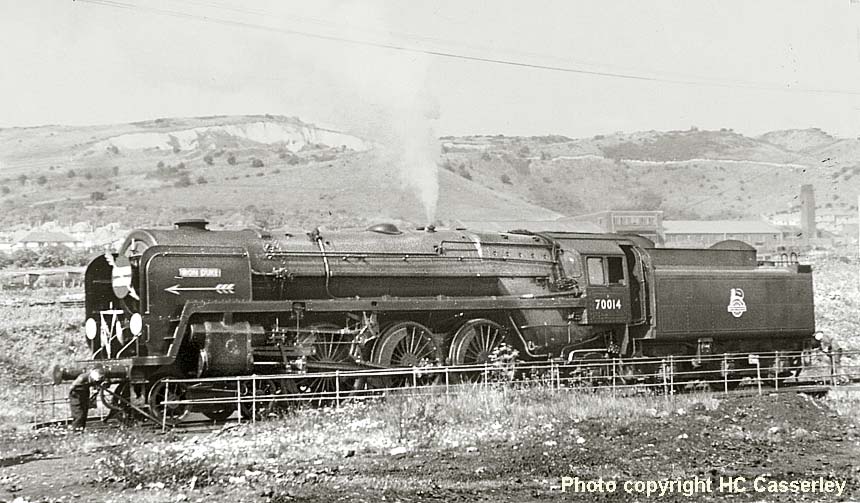
The tender step was noted to be of the Western Region type (for details, see page 90), this was because it was fitted at Swindon Works, and the long lamp irons were a common sight on Southern Region engines, from many years previous. The reverse rod recuperating spring (item 8) was encased also, in November 1952, and the raised sand box lids (item 16) made their appearance in June 1953; along with the front regulator rod support bracket (item 5) to keep the rod stable. In November 1955, 'Iron Duke' had the LNER Return Crank (item 15) modified to the LMS type, with the 4-stud fixing; also the rear regulator rod support bracket (item 7) had been fitted. No modifications were done in the next two years, but No 70014 was allocated to Trafford Park MPD (9E) before the front step was modified in November 1958; also Crewe did remove the long lamp irons (item 2) for normal LMS type. Following this the new British Railways emblem (item 11) appeared in 1960; the power warning plates (item 19) were seen in 1961; 70014 eventually received a Speedometer (item 13) in April 1962, and in February 1963 the AWS equipment (item 20) was added. The smoke deflectors (item 3) were not ever changed from their original form, nor were any changes made to the exhaust ejector unit (item 4).
(Below) In October 1953, a beautifully clean 70014 Iron Duke is seen heading a Boat train service past Ashford Works on 11th October 1955. The long lamp irons were a feature of the two Britannias allocated to Stewarts Lane MPD (73A) from the winter of 1952, right through to when their service ended in the summer of 1958.
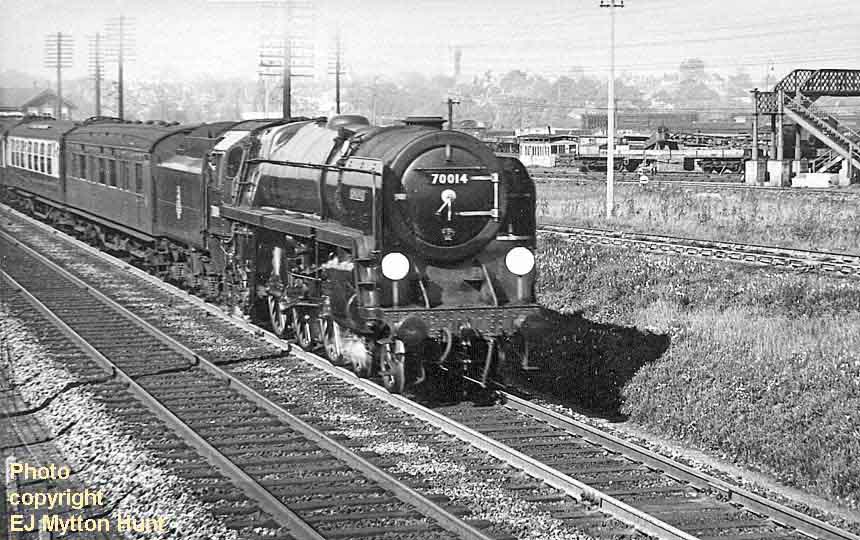
SERVICE RECORD: 70014 did work briefly from Norwich shed on Great Eastern trains, but following a move to Nine Elms MPD (70A) was more regularly to be photographed on the Southern Region's Boat trains (see above).
Unfortunately 'Iron Duke' failed in service and had to be towed to Brighton Works early in July 1951. The mileages accrued at this early stage were quite low; a recorded 36,500 miles in 1953, being the highest until 1960, when a total of 51,300 miles were covered. Apart from the entry to Brighton mentioned above, 70014 made visits to Eastleigh Works (4 times) and Crewe Works at least eight times during his career.
'Iron Duke' was on loan to the Southern Region from 1951 to 1958 as a back-up engine to 70004 'William Shakespeare' and during that period was cleaned as often as 70004 in readiness to step in should the need arise. Normally 70014 would take a relief train to Dover, or would be rostered on the 'The Night Ferry', a train often comprised of five sleeping cars, known as Wagon-lits, with two normal coaches and two baggage cars; the train was shunted aboard the cross Channel Ferry service to France and on to Paris. Having departed London Victoria at 9 pm, the engine would wait at Folkstone for the returning coaches, before the journey back to London, arriving around 9 am - however this often depended on weather conditions in the Channel.
Mr Richard Hardy, Stewarts Lane Shedmaster from 1952 to 1955, once stated in print how 70004 and 70014 were very good engines, and they were liked by all, especially the maintenance staff and the stores people. Not long after 70014 transferred to the Midland Region, the engine broke away from the tender and train at speed while hauling 'The Palatine' near Cheadle Heath station. The driver had no brakes to use, but managed to stop the train by using the reverser, and was towed away by a Midland 4-6-2T engine.
This incident did bring about a modification (not a visible one) to ensure that the drawbar spring tension and shock absorber rubbers were adequate for the purpose. Also due to the nature of the winding Midland Region tracks, it was found that the smokebox cradle rivets were breaking off on a regular basis. Late in 1966 'Iron Duke' was seen with a missing piston rod, waiting to enter Crewe Works for repairs.
(Below) BR Pacific 70014 Iron Duke is viewed passing Finedon Road Signal Box on the approach to Wellingborough Station, with an up express from Manchester, still sporting the long SR lamp irons on the buffer beam and the short versions on the smoke deflector stays, nicely mixed in with two LMR lamp irons in the centre. The lines to the left fed the Wellingborough Iron Co. works, and in the middle distance can be seen Neilsons sidings, while a Midland 4F 0-6-0 waits attention of the shunter and his pole. Dated Friday 15th August 1958.
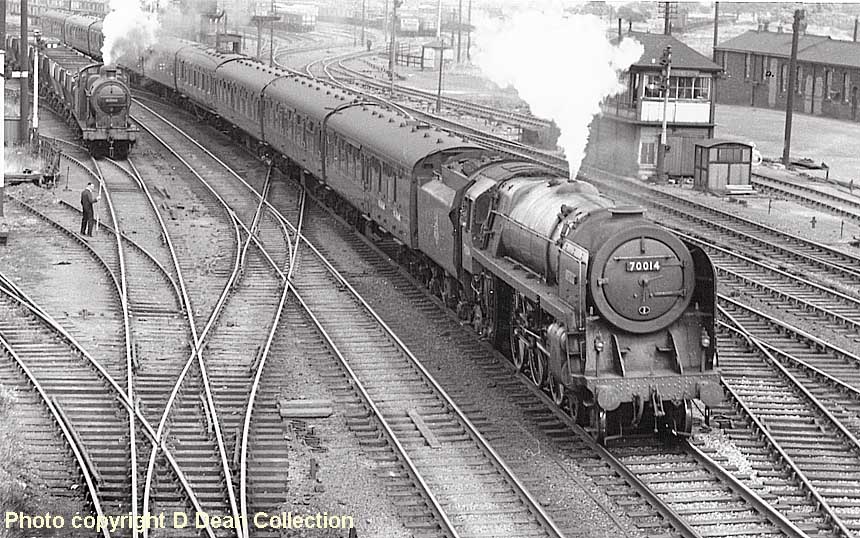
SIGHTINGS: First image noted shows 70014 receiving a fitter's attention at Brighton shed in June 1951, working from Nine Elms MPD. Also in July 1951, 'Iron Duke' was seen at Winchester Station, hauling a Bournemouth to Waterloo express; while many more sightings were recorded of Boat Trains workings between London Victoria and Dover, or Waterloo and Southampton. 70014 was seen at Hildenborough, near Tonbridge, with a boat train in August 1951, and again in February 1952, leaving Sandling Tunnel in Kent with another boat train. Shortly after this 'Iron Duke was noted receiving attention at Eastleigh Works to reset the driving wheels correctly - the interim repairs had been carried out at Brighton - and it was also seen to have had a temporary name change to 'Scrap Iron' by some mischevious wag on the staff.
When seen in May 1953, 70014 was hauling the 'Golden Arrow' across the viaduct past Battersea, heading out towards Dover on 'trip 4'. He was also viewed at Stewarts Lane MPD, decked out with tricolor flags, waiting to back down to London Victoria to start the journey eastwards. Then in September 1958 70014 was pictured at the wonderful Millers Dale station - opened in 1863 and closed to passengers in 1967 - at the head of an express from Manchester to London St. Pancras. During February 1967 70014 was observed hauling a long parcels train out of Leeds for Heysham, and in August 1967 he was seen in fairly good condition at the head of a Glasgow to Liverpool express at Golborne, near Wigan. Disposal was from Carlisle viaduct on 12th March 1968, to Wards of Inverkeithing in April 1968.
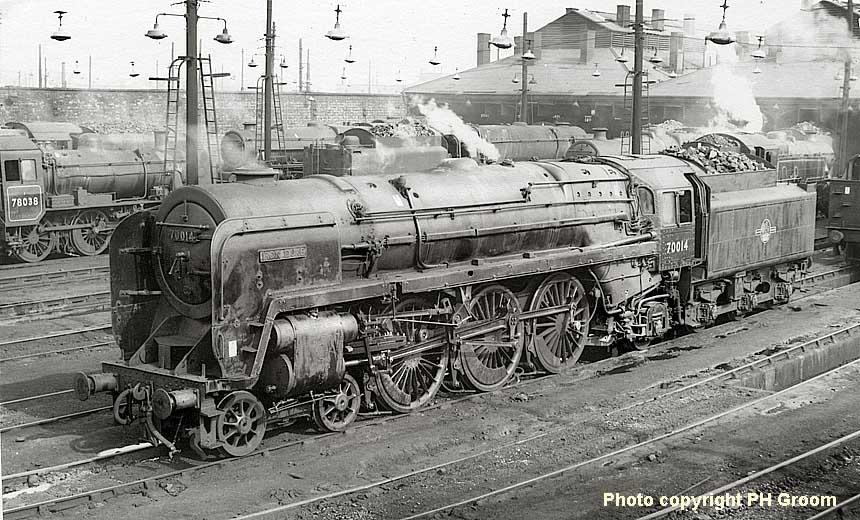
(Above) Another excellent, evocative scene from Peter Groom, with Britannia 70014 Iron Duke taking centre stage on Willesden MPD (1A), dated 26th June 1964. While 70014 still has the evidence of his time on the Southern Region, many other changes have now taken place; front step, AWS, speedometer and power warning plates are all prominent. Also nine other locomotives can be made out in the background and a total of 28 yard lamps are visible - a nightmare for photographers!
(Below) 70014 'Iron Duke' is seen back at Crewe Works in late 1966, and has swopped tenders for one of the BR1D type (70013 having taken his old one, which had the WR type). AWS battery box and reservoir prominent on offside and 70014 is still showing three different types of lamp iron, with the two centre ones repositioned for safety reasons.

(Below) A grimy 70014 Iron Duke gets to grips with the Long Drag at Sheriff Brow just north of Settle. The grimy appearance of the paintwork is in complete contrast to his Stewarts Lane existence where he was kept in immaculate condition along with one other Stewarts Lane Britannia No 70004 William Shakespeare for working the 'Golden Arrow' and other boat train services until 1958. For the record, both No 70004 and 70014 were among the last thirteen Britannias withdrawn from traffic at Carlisle Kingmoor in December 1967.
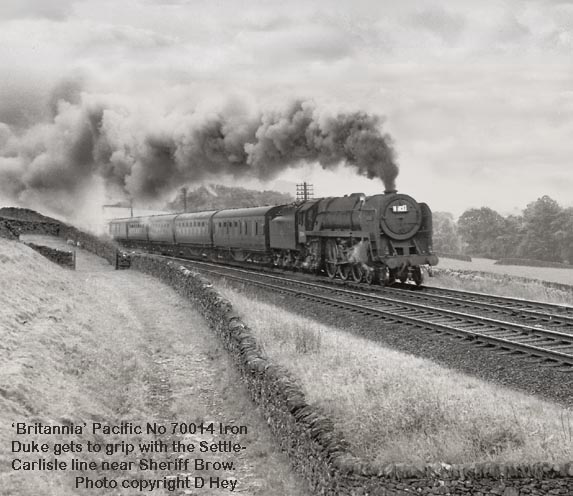
Built at Crewe and completed 12th June 1951 to order E479/220/Swindon 397, costing £20,144 and was withdrawn on the 5th August 1967, stored at Carlisle Kingmoor yard, disposal to J. McWilliams of Shettleston.
ALLOCATIONS: 70015 Apollo appeared from Crewe Works with Western Region lamp irons, ATC equipment and so was predestined for Old Oak Common, but was sent on loan to the London Midland Region who based the new locomotive at Camden MPD (1B) in London, with the sole purpose of trialling the engine on 'The Red Rose'. Transfer was then to Stratford shed in May 1952 and eventually to Old Oak Common (81A) to link up with 70017/18/20 and 70023 in September 1953. The 3 years and 3 months spent at 81A was the longest period of time allocated to one shed, with many short stays at far too many other depots.
Transfer to Cardiff Canton (86C) at the very end of 1956 resulted in a stay of 18 months before following 70017 Arrow to Trafford Park MPD (9E) to join up with another 4 Britannias: 70004/14/21 and 70042 replacing a similar number of 4-6-0 Royal Scot Class engines and lasting a total of two years and five months. 70015 Apollo then took on a nomadic existence, with moves to Newton Heath shed (26A) for nine months; Neasden depot (14D) another nine months; Annesley MPD (16D) for barely three months; then Willesden (1A) just two months; Llandudno Junction shed (6G) came next for nine months before joining the massed ranks of Britannias at Crewe North MPD (5A) for a period of twenty months, beginning in September 1963. During September 1965, 70015 was on the move yet again, as relocation to Stockport Edgeley depot (9B) took place, dated from May 1965 until June 1967 then finally moving to Carlisle Kingmoor (12A), the last resting place for many steam engines.
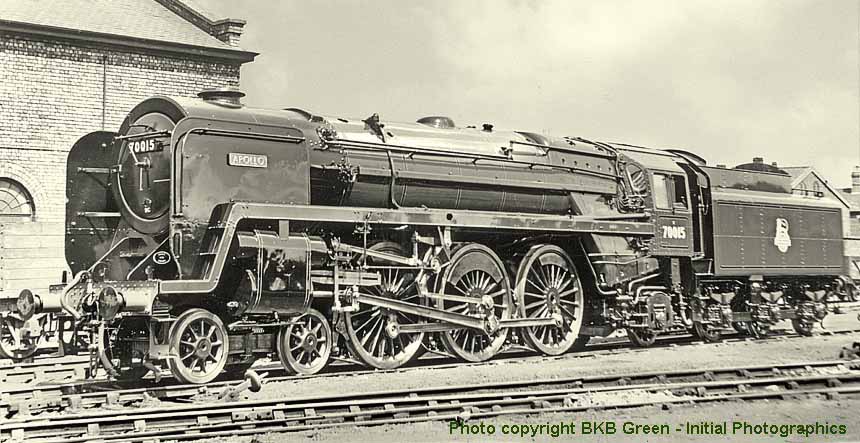
(Above) Crewe Works yard is the venue for yet another classic image from the camera of B K B Green for Initial Photographics. Brand new 7MT Britannia 4-6-2 70015 Apollo stands resplendent in front of the Paint Shop awaiting last minute checks before running-in commences, dated 10th June 1951. We should be able to notice hollow axles; Western Region style lamp irons; battery box for ATC below the cabin floor and a cover in front the lubrication atomiser, above the front drive axle, which was soon to disappear (ie left off).
(Inset) A nameplate measuring 25¾" long, the front repainted, went uder the hammer for £9,000 at a Great Central Railwayana Auction in December 2015. Built at Crewe and loaned new to Camden on 12 June 1951,  the BR Standard Class 7 Britannia 4-6-2 No 70015 was then loaned to Stratford before moving in 1953 to the Western Region, first at Old Oak Common (81A) and then Cardiff Canton. Its later sheds included Trafford Park, Neasden, Annesley, Llandudno Junction, Crewe North, Stockport and Carlisle Kingmoor from where it was withdrawn in the week ending 5 August 1967 and despatched for scrap to J McWilliam of Shettleston on 1 November 1967.
the BR Standard Class 7 Britannia 4-6-2 No 70015 was then loaned to Stratford before moving in 1953 to the Western Region, first at Old Oak Common (81A) and then Cardiff Canton. Its later sheds included Trafford Park, Neasden, Annesley, Llandudno Junction, Crewe North, Stockport and Carlisle Kingmoor from where it was withdrawn in the week ending 5 August 1967 and despatched for scrap to J McWilliam of Shettleston on 1 November 1967.

MODIFICATIONS: 70015 was built to order E479/220/Swindon 397 which meant that Swindon had requested Western Region lamp irons (item 2) and Automatic Train Control equipment (item 20) to be fitted, including
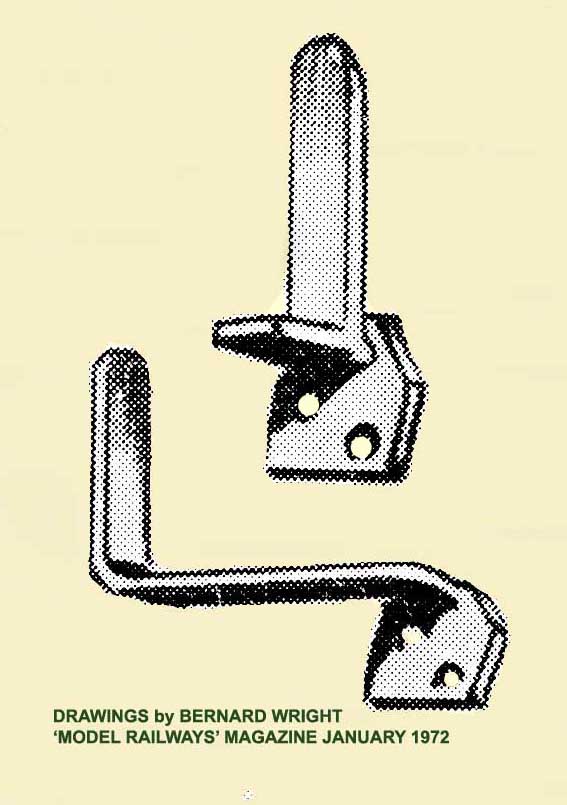 battery box and in-frame pipework. Yet although the lamp irons were WR type (not front facing...see bottom example left) initially these were very soon changed to the LMR pattern (top example left) to accommodate their lamps and headboards. The engine was duly delivered to Crewe in October 1951 to enter the Works to have the Axle repairs (item 17) carried out, and was seen after with plain coupling rods (item 14).
battery box and in-frame pipework. Yet although the lamp irons were WR type (not front facing...see bottom example left) initially these were very soon changed to the LMR pattern (top example left) to accommodate their lamps and headboards. The engine was duly delivered to Crewe in October 1951 to enter the Works to have the Axle repairs (item 17) carried out, and was seen after with plain coupling rods (item 14). Another visit to Crewe Works in June 1953 (still not yet a WR Britannia) resulted in modification to the vacuum pipe (item 21); the support bracket (item 5) was added to the front rod of the regulator control; the sandbox lids (item 16) were raised and the cab sheet (item 9) was added at this time. The exhaust ejector unit (item 4) was subject to a number of changes; in 1954 the unit was fitted with a solenoid valve, which was said to give the driver better control over its operation; in August 1955 the engine was seen without said valve on, after a Crewe Works visit; but then in summer of 1956 was again seen with the accompanying valve in position. But in 1957 Swindon Works moved the whole ensemble to a lower position on the boiler claiming that driver visibility was now impaired.
The tender step (item 10) made a belated appearance in August 1955, while the rear support bracket (item 7) for the regulator rod was also fitted after 70015 visited Crewe Works yet again. The engine next entered Swindon Works at the end of May 1957 for extensive work and modifications, but was not seen until
 January 1958, when viewed with Western Region smoke deflectors (item 3); a modification of the front step (item 1); and a new BR emblem (item 11) on the tender. So it was perhaps surprising that 70015 Apollo was transferred away from Cardiff Canton just six months later, although the ATC equipment and the solenoid valve on the exhaust ejector were both removed beforehand. No AWS equipment was ever fitted to 70015, but a speedometer (item 13) was added at Crewe Works in October 1960, by which time the lamp irons had changed again to LMR type (from WR) and the power warning plates (item 19) had been secured to the engine.
January 1958, when viewed with Western Region smoke deflectors (item 3); a modification of the front step (item 1); and a new BR emblem (item 11) on the tender. So it was perhaps surprising that 70015 Apollo was transferred away from Cardiff Canton just six months later, although the ATC equipment and the solenoid valve on the exhaust ejector were both removed beforehand. No AWS equipment was ever fitted to 70015, but a speedometer (item 13) was added at Crewe Works in October 1960, by which time the lamp irons had changed again to LMR type (from WR) and the power warning plates (item 19) had been secured to the engine. Basically few changes occurred over the next three years to 70015, except that the LNER return crank (item 15) was modified to a LMR type late in 1961, and a plain unlined green livery (item 12) was applied in 1964. A year later, the nameplates were removed, the numberplate disappeared for security reasons and the topmost lamp irons were repositioned on the smokebox door to avoid engine crew working in close proximity to the overhead live wires.
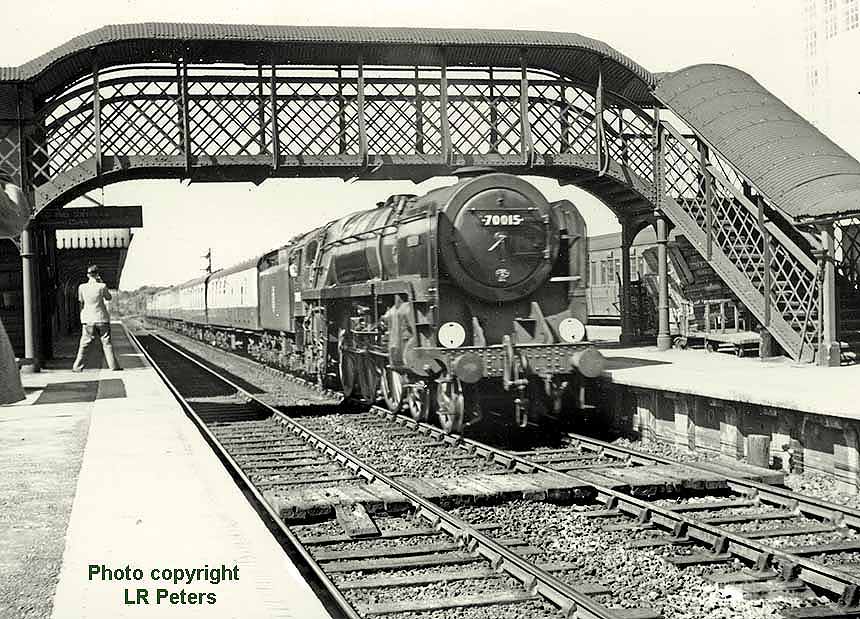
(Above-Below) Britannia Pacific 70015 Apollo attracts much interest as it coasts through Haughley Junction Station in Suffolk, descending the 1 in 131 bank towards Stowmarket and Ipswich, with an express from Norwich on Saturday 5th July 1952. The engine was now allocated to Stratford shed (30A), having been on loan to the LMR and still to see service on the Western Region metals where it was intended for. Haughley Station was an important junction for Bury St. Edmunds to the left and to Laxfield to the east. (Below) On Saturday 21st July 1956, Britannia 4-6-2 70015 Apollo was viewed by the redoubtable Dick Riley, courtesy Transport Treasury HERE as the engine forged its way to Whiteball Tunnel from the Exeter direction, with a 14-coach load from Newquay headed for London Paddington. The third line was a down goods refuge, while the tunnel through the Blackdown Hills was over 1,000 yards long and opened in 1844.
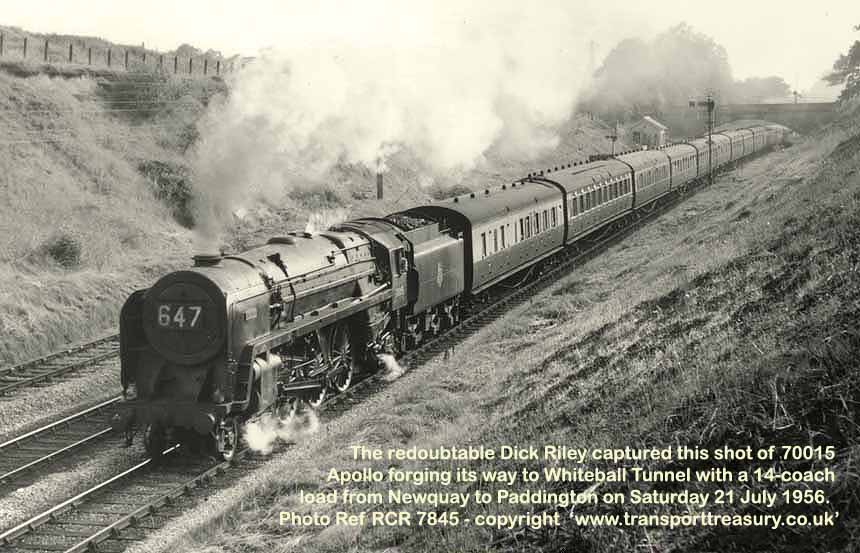
SERVICE RECORD: Because of the way 70015 was utilised initially, moving around the Regions and not settling at one shed location for too long, the recorded mileages are not available for 1951 or 1952, while the ensuing years are noted as below average for an express passenger locomotive. During 1951, the engine is recorded as entering Crewe Works on five separate occasions for non-classified work, noted as 8 days, then 6 days, 3 days, 4 days and a further 7 days, which coincide with the testing of 70005 John Milton at Rugby Testing Station and may well have given rise to a number of adjustments from their findings at that time. 70015 was recorded as entering Crewe Works on twelve different occasions, with two visits to Swindon Works noted and another two trips to Stratford Works noted in 1952.
The transfer to the London Midland Region saw 70015 utilised on 'The Red Rose' from Liverpool to Euston, a regular train for the Edge Hill 'Princess Royal' Class locomotives; this enabled the operating department to compare fuel consumptions between both classes, although I have not found any recorded information on the findings. While on the Great Eastern section the engine was used on the regular Norwich trains, and then after moving to Old Oak Common it worked the West Country trains out of London Paddington. Furthermore, following its transfer to Cardiff Canton 70015 was employed on the South Wales expresses such as 'The Red Dragon' and 'The Capitals United Express' from the start of 1957, but then on the Midland Division the engine was utilised on 'The Palatine' between Manchester Central and London St. Pancras Station. Following 70015's relocation to the Great Central depots, it operated between Nottingham and London Marylebone Station hauling semi-fast trains. The locomotive was subsequently returned to the LMR where it was more usually employed on fitted freights, parcels or summer Saturday excursions rather than titled-train.
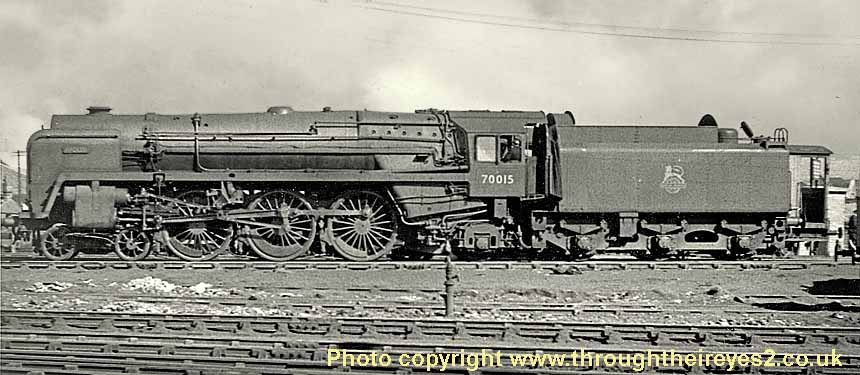
(Above-Below) A lovely image from Jim Payne capturing Britannia 4-6-2 70015 Apollo at Bristol Bath Road depot, waiting to back down to refill the tender during the summer of 1956. Worthy of note on the locomotive are the ATC battery box immediately below the cab floor and the large box on the tender between the first and second axles; which may well appear to be some sort of tool box or such, but is in fact a 'sludge box' to accumulate dirt, debris and rust from the water in the tender, to prevent it entering the boiler system. (Below) A very good image captured by Clive IK Field of Britannia 4-6-2 70015 'Apollo' at Kentish Town depot in North London. The image is so good because 70015 was the only Britannia to have visited 14B that displayed Western Region styled smoke deflectors, so it was a rare beast. The picture was dated February 1960 and reflects a work-worn engine that was fuelled, turned and in full steam in readiness to return North anytime soon. The Midland Division depot was an unusual design of three brick-built roundhouses which were joined and also inter-linked. The backdrop to the picture was the Read Brothers Bottling Plant which was famous for 'Dog's Head' Beer.
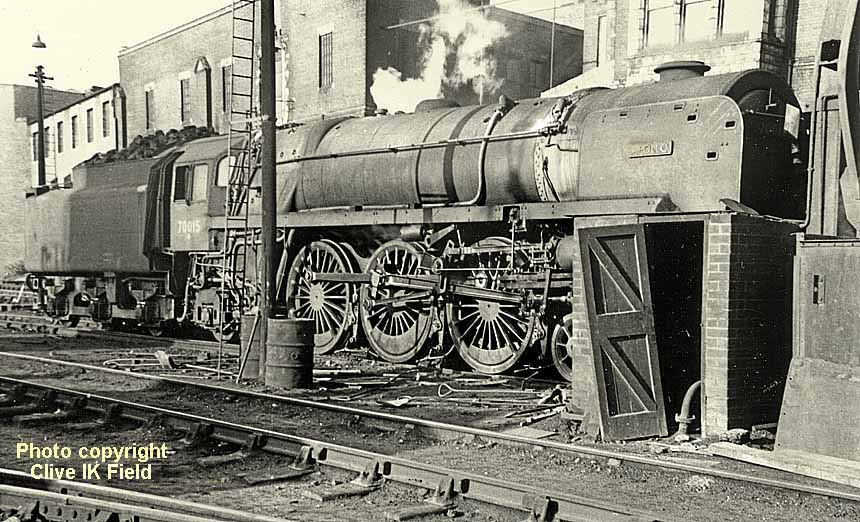
SIGHTINGS: Two views of 70015 hauling 'The Red Rose' reflect a very clean engine attracting much attention as the new Britannia engine was replacing the normal 'Princess Royal' seen at Runcorn and also at Crewe Station, in July 1951. In 1954 the engine was then allocated to Old Oak in London, but was observed alongside the newer straight shed at Plymouth Laira depot (83D) possibly awaiting attention, in company with 70019 'Lightning' of that shed.
Slightly later that year 70015 was pictured entering Exeter St. Davids hauling a long express from Paddington, heading for Plymouth, and looking in very smart condition. After yet another visit to Crewe Works during August 1955, the Britannia was photographed in resplendent condition and now had a LMR type step in position on the sloping sides of the tender, and after some running-in would soon return to London and Old Oak Common depot.
70015 was captured at Ranelagh Bridge servicing yard having brought an express from South Wales and it was noticeable that the smoke deflectors were displaying the six brass-lined handholds that Swindon had recently fitted, and the pipework for the ATC equipment was now showing down the edge of the boiler walkway instead of along the frame. Shortly after this sighting, the pristine engine was viewed wheeling the 3.55pm Paddington-Fishguard Harbour 'Capitals United Express', into Cardiff General Station, dated 8th May 1958.
After leaving Cardiff Canton for Manchester Trafford Park, 70015 was seen on a Cup Final special to Wembley, bringing Blackburn Rovers supporters to view their team's demise at the hands of Wolverhampton Wanderers in May 1960; the general condition of the engine was reasonably clean, but the cover was notably missing from the exhaust pipe joint above the offside cylinder (bad practice). While on the strength at Newton Heath depot, in company with four classmates, 70015 was viewed on the Calder Valley line at Mytholmroyd heading a passenger working towards Hebdon Bridge and ultimately Manchester, in September 1961. The engine was also seen along the North Wales coastline after transfer to Llandudno Junction; then in July 1963 it was pictured at Bangor MPD, in poor condition with the numberplate and nameplates all missing.
Michael Fox commented in the November 2007 issue of 'Steam Days' magazine that 70015 Apollo was sighted no fewer than fifteen times on the Micklehurst Loop from Stalybridge in Greater Manchester, dated from 4th February 1966 until 25th October that year; on six occasions on freight; five times hauling a parcels train and only once sighted on a passenger train, dated Saturday July 2nd. These reported sightings exemplify the Britannia Class as a whole at this period in time; down at heel, unwanted for most passenger trains and demoted to mundane parcels and fitted freights for the most part, albeit they were fulfilling their true MT (mixed traffic) capabilities.
Apollo did find a short reprieve from this when the locomotive was selected for the RCTS Lancastrian Rail Tour Special in March 1967. Following on from this event, 70015 was pictured close to Rose Grove depot near to Burnley, and was still quite clean looking, although the nameplates (homemade) and numberplate were now missing. One of the staff there stated that the engine was used to haul coal trains to Wyre Dock in Fleetwood, using the route through Accrington, Blackburn, Preston and Kirkham to reach the coastline.
DISPOSAL: Withdrawn 5th August 1967 to Carlisle Kingmoor yard, stored until January 1968 and then transferred to J.McWilliams of Shettleston to be cut up, also in January 1968. Shettleston is a suburb of Glasgow, being just over three miles to the East of the City Centre.
(Below) A very well presented picture from BKB Green for Initial Photographics, reflecting Britannia 70015 (formerly Apollo) residing at Wakefield Motive Power Depot (56A) during April 1967 looking in reasonable condition due to recent working on the RCTS Lancastrian Rail Tour, but having not more than 4 months left in service. The heavy freight shed was a 10 road dead-end brick-built affair opened in 1893 and closed in June 1967.
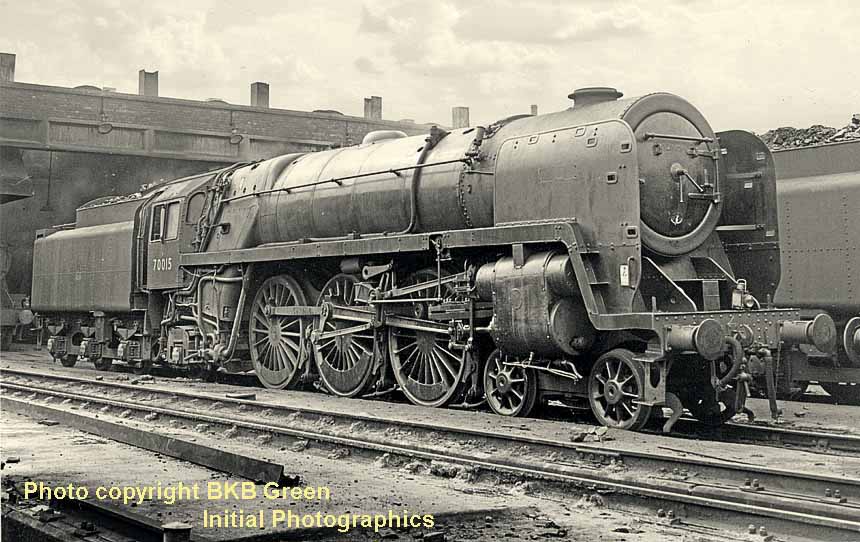
Built at Crewe Works, completed on 18th June 1951, at a cost of £20,144. Withdrawn from service on 19th August 1967.
ALLOCATIONS: 70016 was predestined to be the second engine to be allocated to the Western Region, but instead was loaned out to (20A) Leeds Holbeck MPD...then rather strangely it was moved on to Stratford MPD (30A) in March 1952. Eventually 'Ariel' arrived on the Western Region at Plymouth Laira shed (83D) in August 1953, by which time the loco was over two years old, hence it became the penultimate Britannia to be received by the WR.
Then in December 1956, as a result of the Western Region's endeavour to concentrate all fifteen WR engines of the class at one depot, No 70016 joined the rest of the Pacifics at Cardiff Canton shed (86C). After a stint of nearly five years at Cardiff, No 70016 was then transferred to the London Midland Region based at Carlisle Canal shed (12C) in September 1961.
In 1962, 70016 moved around somewhat to Longsight (9A) followed by Crewe North (5A) and Llandudno (6G) all in the space of a year! Further moves were made to Holyhead (6J) and Aston (21D) before arrival at its final resting place at Carlisle Kingmoor depot (12A) from October 1964.
(Below) This lovely catch by R K Blencowe shows 70016 Ariel in original condition at Corkerhill Glasgow in June 1951. The Britannia was destined for the Western Region, but instead went on loan to Leeds Holbeck MPD (20A) and thus worked over the Settle and Carlisle Railway. One wonders if noises from Old Oak had any influence on this change of direction?

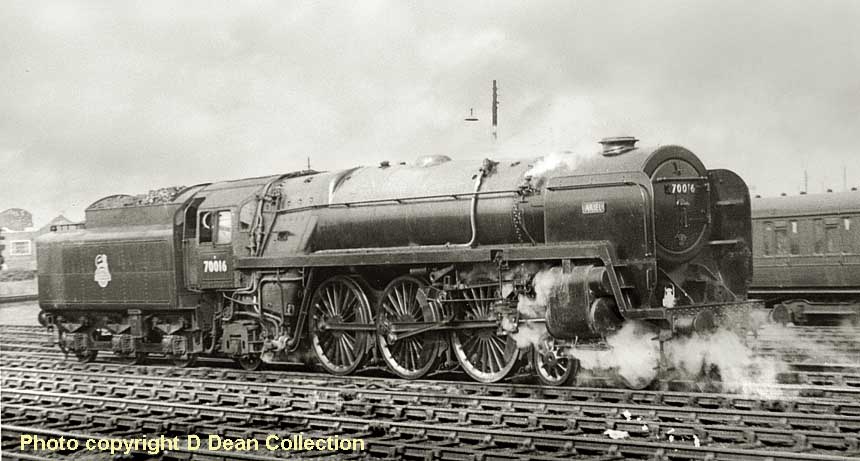
(Above-Below) Captured at rest in the yard at Stratford in East London is 70016 Ariel which has now had repairs to the drive axles carried out and a modified vacuum pipe fitted at the front of the engine. The locomotive was at Leeds Holbeck on loan from the WR and then stored awaiting its turn to enter Crewe Works, so when seen here in March 1952 the engine's accumulated mileage was very low indeed, but it wasn't long before 70016 began to earn some revenue on the Great Eastern metals. (Below) From the large negative archive of RK Blencowe is yet another wonderful lineside shot depicting an engine in control of the task. Here Class 7MT Britannia 70016 Ariel climbs Brentwood Bank rising at 1 in 85 from Harold Wood before easing to a 1 in 150 and the summit at Ingrave Summit Box; the loco is seemingly tackling the job without any fuss as is the fireman who is taking a breather. The photo was taken in July 1952, by which time the locomotive had completed its loan to Leeds Holbeck where it was employed on workings via the former MR route into Scotland, and following its spell on the ER at Stratford it moved to WR based at Plymouth and then spent time in South Wales and later Carlisle, truly a career covering the whole of Britain.
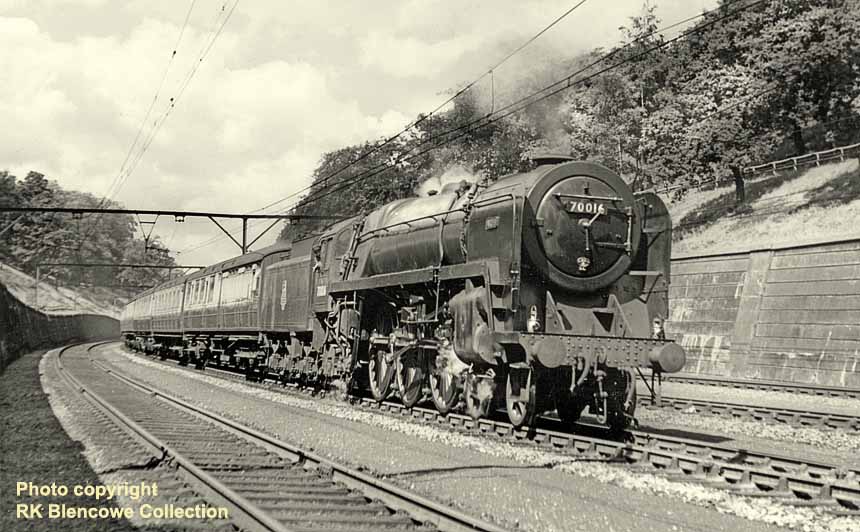
MODIFICATIONS: Lamp irons (item 2) were LMR type from new; ER version from March 1952; WR type from late 1953 and reverted to LMR version after May 1962. The Western Region designed Automatic Train Control equipment (item 20) was fitted from new although not completed - i.e. the pick-up shoe added - until the engine arrived at Swindon in August 1953. The first nineteen Britannias were all built with a long vacuum pipe (item 21) and as such 70016 was duly modified at Crewe Works early in 1952 while having the Axle repairs done, although 'Ariel' did not suffer any problem with the drive axles (item 17). At this time the axle coupling rods (item 14) were altered to show a plain version at the front of the engine and a fluted (lighter) type to the rear which was common with the early build locomotives, but unusually the coupling rods stayed this way right up to withdrawal. When under repairs at Crewe in November 1953, 70016 had the sand box lids (item 16) modified to make them easier to fill by the crew, also the reverse recuperating spring (item 8) was enclosed as part of the job to prevent lock-up of the gear in service.
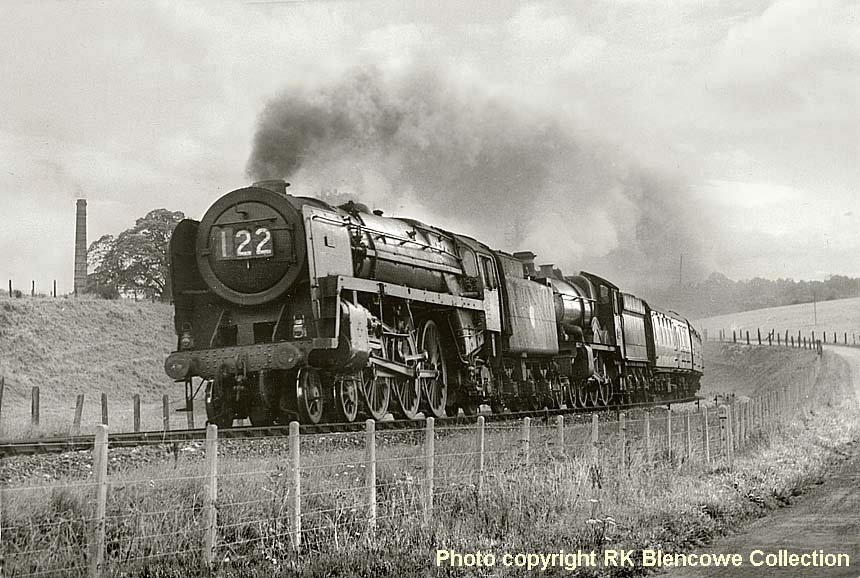
(Above) Another glorious image from RK Blencowe's archive, taken by EW Fry on Friday 10th August 1956; it clearly shows the effort required to lift a heavy holiday train up Grafton Bank curve near to Savernake on the Western Region mainline. Here 'Castle' class 5098 Clifford Castle and 'Britannia' 70016 Ariel storm up the bank at the head of the 09.30am Paddington to Newquay, with both engine crews 'hard at it' trying to make up for lost time due to the many holiday expresses slowing their progress. 70016 now has a full front step and cab sheet fitted.
The next modification was done by Swindon in May 1955 and involved the exhaust ejector unit (item 4) which was fitted with a solenoid valve controlled from the cab, to give better steaming it was said; also the cab sheet (item 9) was added and the steady bracket to the front regulator rod (item 5) was fitted. Many modifications were done in June 1956 when 70016 visited Crewe Works for a General Overhaul; the front step (item 1) was changed; the LNER type Return Crank (item15) was discarded for the LMR version; a support bracket was added to the regulator rear rod (item 7); a step (item 10) was fitted to each side of the tender and the first ever new British Railways coat of arms (item 11) was applied to the tender as coupled to 70016 when completed by the Works. This was for general display and did not come into regular use until 1957, being added all the way through to 1964 for some engines. The only problem with the new display was the right hand emblem was facing the front, in other words to the right, but this was adverse to the rules of Heraldry which state that the lion on the coat of arms must face to the left. Further modification took place in September 1957 when repaired at Swindon this time, the smoke deflectors (item 3) were reset to show six brass-lined handholds instead of the long handrails; also to aid better vision, the exhaust ejector unit (item 4) was repositioned lower down on the side of the boiler. More changes came about when in Swindon Works up until May 1959; the bracket on the regulator rear rod was left off; the pipework for the ATC pick-up shoe (under front of engine) was now to be seen along the boiler walkway whereas before it was piped down the frame out of sight; also the tender step (item 10) was seen to be a WR type now, from a LMR version. When 70016 moved away from the Western Region in 1961 the ATC equipment was removed by Swindon and 70016 did not receive the LMR version (AWS) at all, or the speedometer unit.
(Below) A splendid image from BKB Green of Cardiff Canton on Sunday 12th July 1959 showing Britannia Class No 70016 Ariel ready for the road later that day with a train to Paddington. All relevant modifications have been carried out including Western Region type smoke deflectors with six burnished-brass handholds replacing the dangerous handrails. The engine is not in pristine condition with some grime on some parts of the boiler and cylinder, also with the offside front slightly bumped, which is unusual for a Canton locomotive at this time.
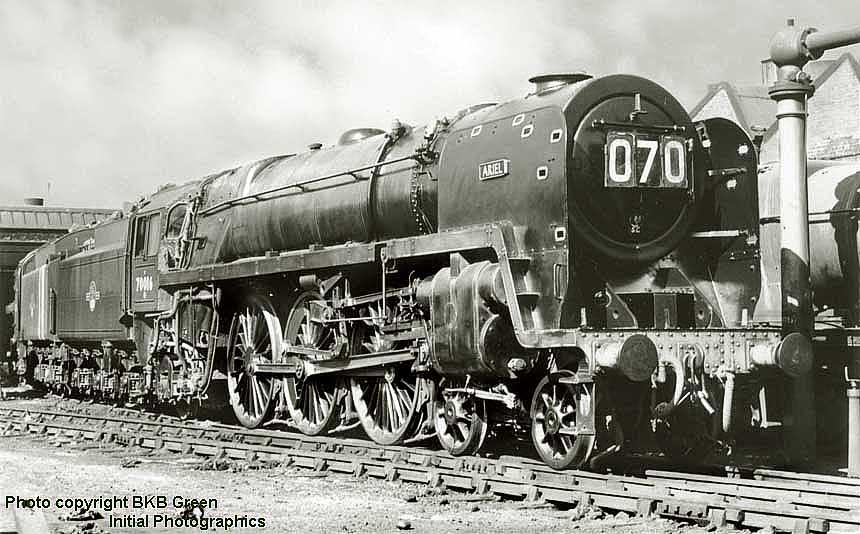
SERVICE RECORD: 70016 Ariel was most definitely unique in that the locomotive was announced as destined for the Western Region, but when completed it went on loan to Leeds Holbeck shed (20A). Now I do not know if the engine reached Leeds at all, but it is recorded as entering Crewe Works on 19th June 1951 (one day old) for a non-classified repair. This lasted six days and therefore 70016 was not available until June 25th, at the earliest, to go out on loan...nor had not run any distance.
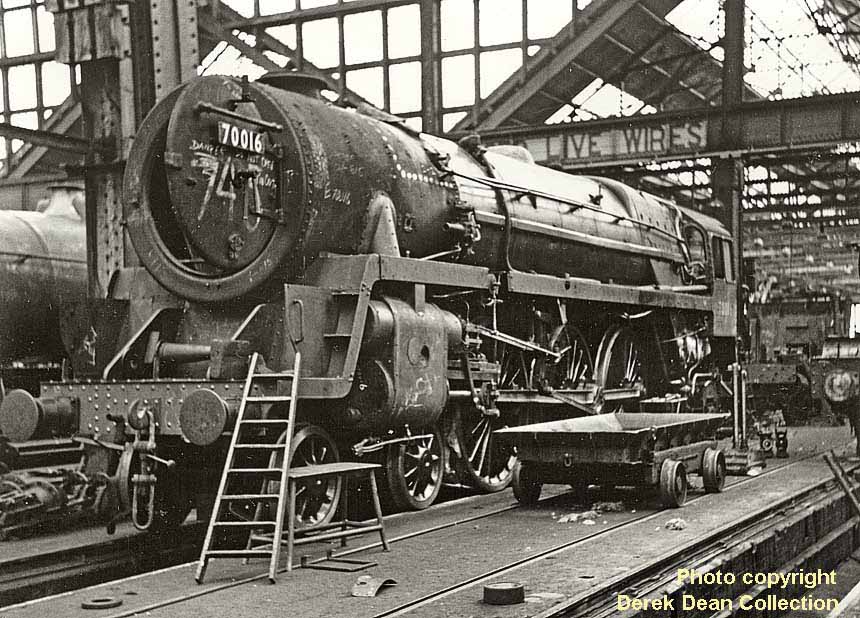
(Above-Below) A classic image of Swindon Works main shop which highlights the amount of intensive work carried out every two years or so on the WR's allocation of Britannia Pacifics from 1951 to 1961. This image by Clive Field taken on 3rd May 1959 shows 70016 Ariel being reassembled and was about 10 days away from completion on this occasion. 70016 was in fact the last Britannia to be repaired at Swindon when it next visited the Works in March 1961, so that when three other Britannias came along Nos 70018, 70023 & 70027 for overhaul they were sent off to Doncaster instead. (Below) The fantastic sight and sounds of a beautifully-clean Britannia starting away from Paddington Station was an experience to be savoured, enjoyed and recalled for always; the 'Red Dragon' express restaurant service to Pembroke Dock begins its long journey hauled by 7MT Britannia Pacific No 70016 Ariel of Cardiff Canton depot, whose staff liked and looked after their charges, cleaning all the top-link engines extremely well. When the staccato exhaust hit the underside of Westbourne Bridge, the reverberations could be heard and felt by all those within earshot; wonderful memories, wonderful times…

(Below) This Jim Oakley photo of 70016 Ariel at Cardiff Canton on 11 September 1960 and shows the loco in a shocking state! Bent handrail, very thin tyres, a mix of coupling rods; also the Exhaust Ejector valve is still down, a short lube rod can be seen and the 88A (from 86C) shedcode indicates the year is 1961. F55 was the code for a train from Carmarthen to Paddington. This is the first time I've seen Canton's coaling stage from this angle! The covered walkway is unique, giving access to a fourth tip intended to service the smaller engines on a separate line away from the express engines which took longer to fill. There are four single tips - the fourth is on the other side of the walkway. The structure was built in 1935 when the original was abandoned, but the water tank (of the original) was still kept in use.

Built at Crewe and completed 23rd June 1951 to Order E479/220/Swindon 397 and withdrawn on the 30th September 1966, disposal to J Cashmore of Newport in December 1966 (via Shrewsbury).
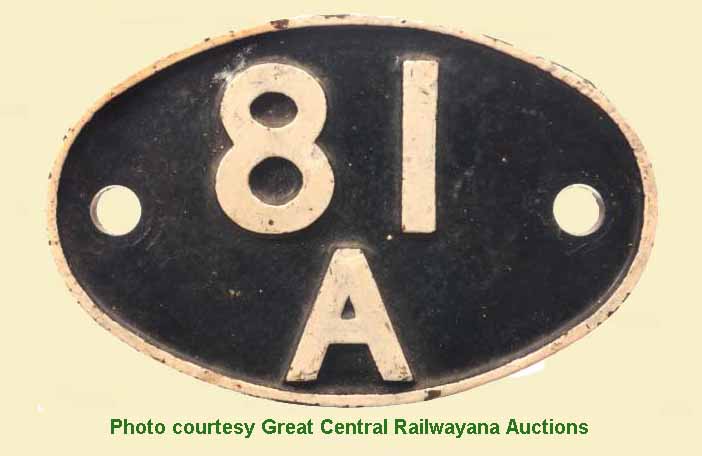 ALLOCATIONS: Life began at Old Oak Common MPD (81A) on 30th June 1951, followed by a move to Salisbury shed 72B (on loan to the Southern Region) from 26th May 1953 to 20th June 1953, helping out while the Merchant Navy Class locomotives were out of service. 70017 remained at Old Oak until moving to Cardiff Canton shed (86C) at the end of 1956. The next port of call was Kentish Town MPD (14B) on the London Midland Region at the end of June 1958, but after only three weeks was allocated to Trafford Park shed (9E). This move lasted up to transfer to Willesden depot (1A) in December 1960, followed by a transfer to Aston MPD (21D) from September 1961, then Rugby for a short time from October 1962. Not long after returning to Aston in February 1963, 'Arrow' was off to Llandudno shed (6J) for four months before joining the throng at Crewe North MPD (5A). Following the shed's closure to steam in May 1965, 70017 moved at Crewe South depot (5B) until finding favour at Newton Heath (26A) in July 1965. 70017 finally moved to the last outpost for the Britannia class at Carlisle Kingmoor shed (12A) on 21st May 1966, where 70017 saw out the last few months before ultimate retirement.
ALLOCATIONS: Life began at Old Oak Common MPD (81A) on 30th June 1951, followed by a move to Salisbury shed 72B (on loan to the Southern Region) from 26th May 1953 to 20th June 1953, helping out while the Merchant Navy Class locomotives were out of service. 70017 remained at Old Oak until moving to Cardiff Canton shed (86C) at the end of 1956. The next port of call was Kentish Town MPD (14B) on the London Midland Region at the end of June 1958, but after only three weeks was allocated to Trafford Park shed (9E). This move lasted up to transfer to Willesden depot (1A) in December 1960, followed by a transfer to Aston MPD (21D) from September 1961, then Rugby for a short time from October 1962. Not long after returning to Aston in February 1963, 'Arrow' was off to Llandudno shed (6J) for four months before joining the throng at Crewe North MPD (5A). Following the shed's closure to steam in May 1965, 70017 moved at Crewe South depot (5B) until finding favour at Newton Heath (26A) in July 1965. 70017 finally moved to the last outpost for the Britannia class at Carlisle Kingmoor shed (12A) on 21st May 1966, where 70017 saw out the last few months before ultimate retirement.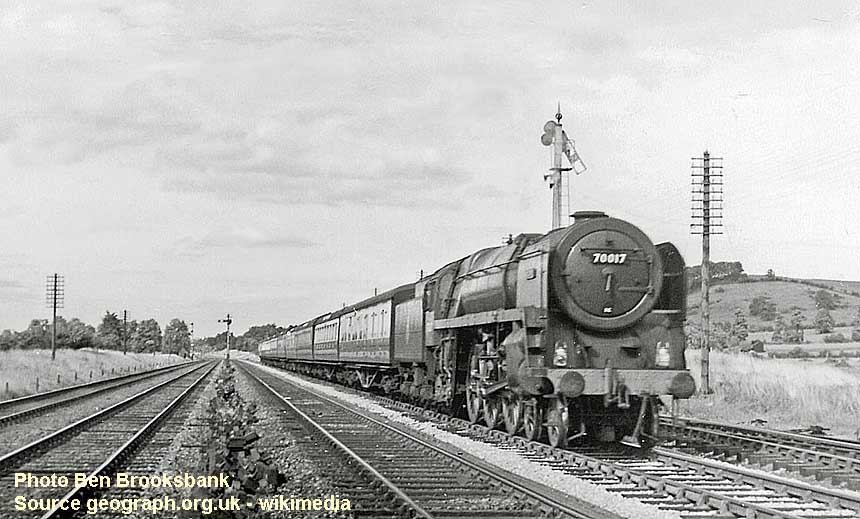
(Above) Although seen in August 1951, 70017 Arrow still has no shedcode plate fitted, suggesting that assessment trials are still being carried out. The train would seem to be 'The Cheltenham Flyer' which was the 'fastest train in the World' until the 'Bristolian' took that mantle. Click here to vist the Wikipedia page on the BR Britannia Class 7MTs.
MODIFICATIONS: 70017 was built to order E479/220/Swindon 397 which meant that Swindon had requested Western Region lamp irons (item 2) and Automatic Train Control equipment (item 20) to be fitted, including battery box and in-frame pipework. Unfortunately 70017 was one of the engines to succumb to drive axle failure in service and was seen outside Swindon Works awaiting repair before work commenced (see image below); the Axle modifications (item 17) being completed on 7th December 1951 and was seen with a mix of plain (front) and fluted (rear) coupling rods (item 14), which were kept the same throughout the remainder of its service life.
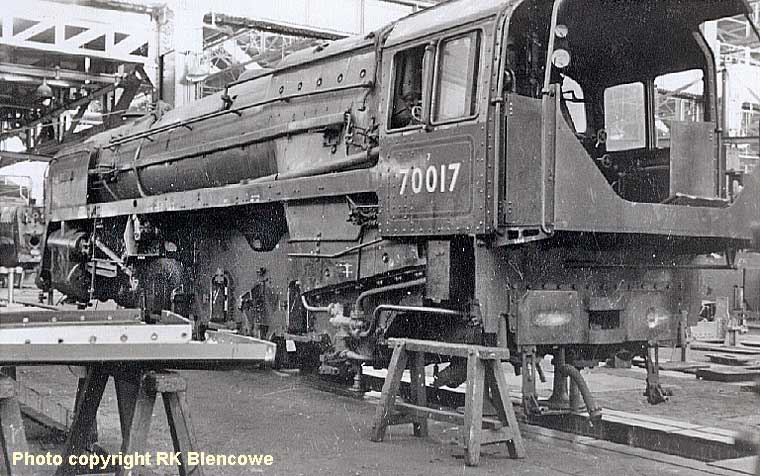
(Above) No 70017 was an early failure of the Britannia Class 7 engines allocated to the Western Region. This only 'added fuel to the fire' among the legion of diehard ex-GWR railwaymen whose allegiance to the old company was well known; in their view these new locomotives would never replace their beloved 'Castle' and 'King' classes. No 70017 is seen under repair in Swindon Works with all axles removed in November 1951; the drive wheels would have been sent to Derby for resetting. Also of note the Exhaust Ejector control valve has been removed from just in front of cab. (Below) This image of 70017 Arrow heading a northbound train out of Crewe in September 1956 highlights perfectly the GWR dome fitted to the tender to prevent water from overflowing when refilling at water troughs. Judging by the appearance of 70017 this would seem to be a running-in turn following a works visit.
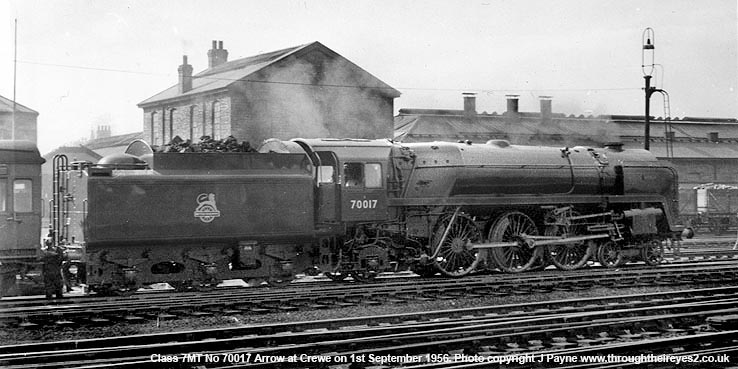
Driver complaints led to a unique modification to be applied to 70017 'Arrow'; the track ballast was said to be adversely affected by water overflow from a Britannia tender and so Swindon fitted a large dome to the top of the water pick-up delivery chute, and this tender was coupled to 70017 in January 1953. No more seems to have been written about this and no other Britannia tender was so treated; the assumption therefore was that there was no noticeable difference from the original type. The large dome can be clearly seen in the photo of 70017 at Crewe (above). The sand box lids (item 16) were modified in May 1953, along with the front regulator rod support bracket (item 5); closely followed by a change to the lamp irons (item 2) when 70017 was allocated to Salisbury, on 26th May 1953, extra lamp irons (SR type) were added, giving a total of eight on the front of the engine. (see below).
(Below) This photo by Rod Blencowe shows just how the 'Britannia' class helped out on the Southern Region in the aftermath of the Crewkerne accident in May 1953 and the subsequent withdrawal of the Merchant Navy class locomotives. Allocated to Salisbury MPD on loan, but still showing an 81A shedcode, No 70017 is heading an 'up' express through Wimbledon...if anyone requires traditional photographic prints of Rod Blencowe's shots, or any other photographic services, Rod's email address can be found at the foot of the page.
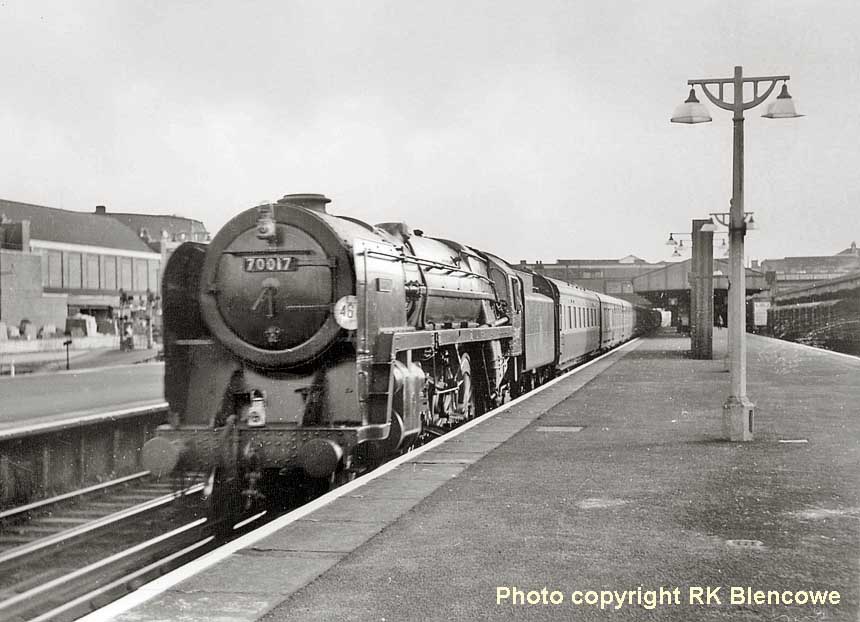
The long vacuum pipe (item 21) was altered in August 1954, while the tender step (item 10) made its appearance at the same time. 70017 entered Crewe Works in July 1956 for overhaul and left with a modified front step (item 1) in position, also the LNER Return Crank (item 15) was modified to a LMR type, and a flexible cab sheet (item 9) fitted. Following on from this 'Arrow' was repaired at Swindon, and had the smoke deflectors (item 3) modified to LMR 2 - two cut-outs without any backing - and the exhaust ejector (item 4) was lowered on the boiler, as Swindon did with most, not all, of the Western Region Britannias. Most unusually, 70017 was seen, in 1960, with the power warning plates (item 19) fitted before the new British Railways emblem (item 11) appeared on the tender; this was not seen until July 1962, a full six years after the first sighting as applied to 70016 'Ariel'. The Automatic Train Control equipment (item 20) had been removed just before leaving the Western Region in July 1958, and there was no AWS apparatus (item 20) fitted at any time to 70017. Meanwhile the speedometer unit (item 13) also appeared in July 1962, and there could now be seen '7P' added to the livery (item 12) on the cabside, a change from the more usual singular '7' and applied to only five Britannia engines in total: 70017, 70042, 70046, 70048 and 70052, as seen from 1961.
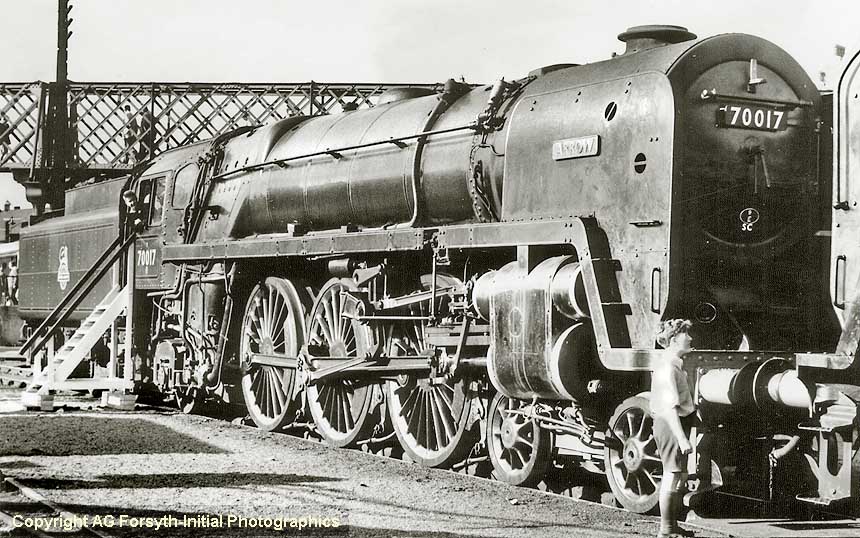
(Above-Below) Viewed at Derby Works Open Day on 30th August 1958, 70017 Arrow is suitably cleaned for the occasion and sporting recently modified LMR Type 2 smoke deflectors, with no backing cups to the handholds. Also of note is the WR 'red-spot' sticker on the cabside and the mix of coupling rods - plain at the front, fluted to the rear. (Below) A very good close-up shot of Britannia No 70017 Arrow at Willesden in April 1961. BKB Green's photo clearly shows how the condition of locomotives deteriorated during the early 1960s. No 70017 appears to have 'thin tyres', the air pipe channel sections are missing from the centre of the boiler and there is evidence of slight damage to the nearside front; all in all, 70017 displays a general run-down look. 70017 was a Willesden resident at this time.
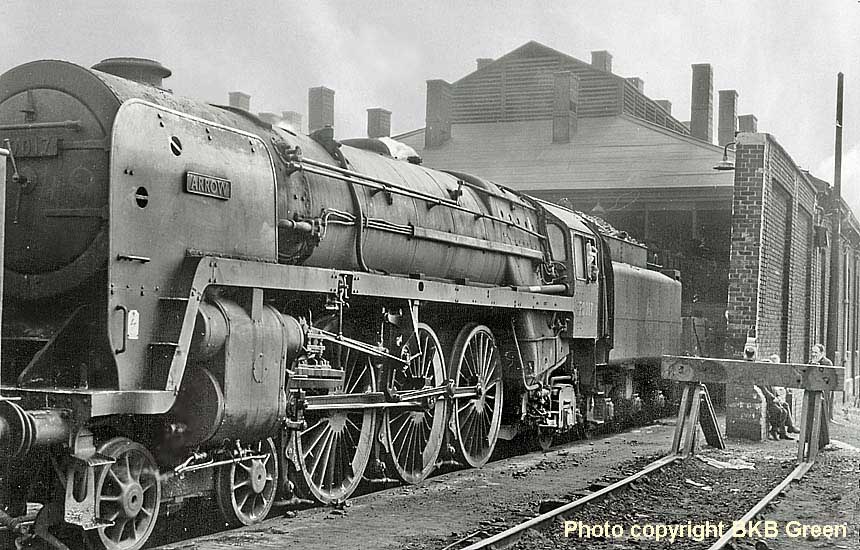
SERVICE RECORD: 70017 was the very first Britannia to arrive at Old Oak Common, as 70015 'Apollo' and 70016 'Ariel' had been loaned to the London Midland Region and the Great Eastern Region respectively. 70017 was an early casualty of the Axle shift problems, but then settled down to work on top-link work such as 'The Bristolian', 'The Merchant Venturer' and the other West Country expresses, working out of Paddington. Mileages in service were not at all high, and are recorded as 44,000 (1952), 50,900 (1953), only 29,200 (1954), 45,600 (1955) and a slightly better 64,400 miles in 1959 when working on the London Midland Region; hauling such trains as 'The Palatine', 'Waverley' and 'Thames-Clyde Express on a regular basis.
No 70017 is listed as having paid three visits to Swindon Works, and at least seven to Crewe Works during its service life. The large domed tender as seen on 70017 was transferred to 70031 'Byron' when the two engines were at Aston MPD in July 1962; this also gave 70017 a change of tender step from LMR to WR, as seen here on the 53A Models website showing 'Arrow' and Stanier LMS 8F 2-8-0 No 48416 posing outside the main shed building at Willesden (1A) in November 1963. Alas, less than three years later and 70017's premature end transpired in August 1966; this followed an accident when the loco was hauling an empty coaching stock train from Glasgow to Morecambe and was involved in a heavy collision with a freight train at St Michaels in Carlisle. The resulting damage to the front end was considered too costly to repair at that time, however had this occured two years prior then most certainly the repairs would have been sanctioned.
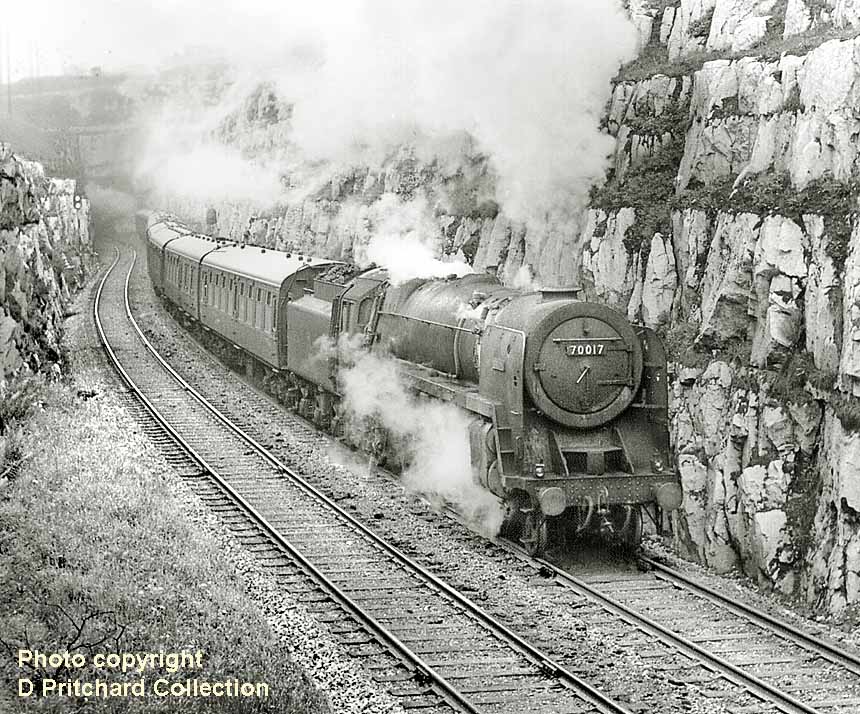
(Above-Below) A wonderfully evocative sight of a hard-working Britannia amongst the limestone topography of the Derbyshire Peak Dirstrict; 70017 Arrow climbs from Dove Holes tunnel to the summit at Peak Forest with a Manchester Central-London St Pancras express. (Below) Another classic panning shot by Footplate Cameraman, Jim Carter; this one showing 70017 Arrow speeding north at Winwick Junction.
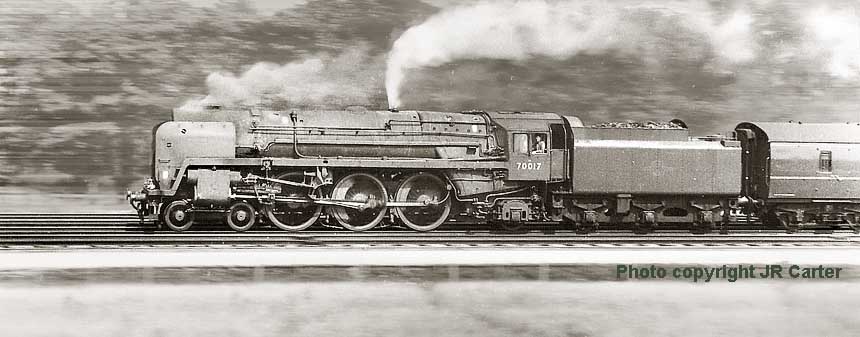
SIGHTINGS: Early spot was at Bath Station on 15th August 1951, seen on a local turn, and showing hollow axles but not yet displaying a shedcode. 70017 Arrow was viewed hauling train No 142 'The Merchant Venturer' past Thingley Junction in Wiltshire in April 1952. During 70017's loan spell on the Southern Region, the loco was pictured in very clean condition at Waterloo Station, having hauled a train from Exeter on 20th May 1953. 70017 was seen with an express at Teignmouth in the summer of 1954, still allocated to Old Oak Common. In 1958 70017 was observed at Birmingham Snow Hill Station on a return trip to Hereford. By this time the loco was fitted with modified smoke deflectors, recently altered to LMR 2 type by Swindon Works. When allocated to the Midland Region 70017 was worked hard, but rarely cleaned as seen at Ambergate Station with an up express bound for St. Pancras in 1959. An excellent view of 'Arrow' at Holyhead shed shows the old emblem was still in use on express passenger locomotives, over five years after its introduction in 1956. In July 1962, a pristine-looking 70017 was observed in ex-works condition at Preston Station on a northbound express; and finally in 1965 'Arrow' was pictured at Golborne, in Lancashire, in good order, with the lamp irons moved and nameplates removed. Finally seen at Carlisle Upperby Shed after recovery from the crash site in August, 1966, and announced as withdrawn shortly after. Disposal was to J Cashmore of Newport in February 1967.
Built at Crewe Works and completed on the 25th June 1951 to order E479/220/Swindon 397. The additional part of the order number added the Swindon Works request to fit Western Region lamp irons and the Automatic Train Control equipment with in-frame pipework; this raised the cost of construction slightly to £20,144. Withdrawal came on the 24th December 1966.
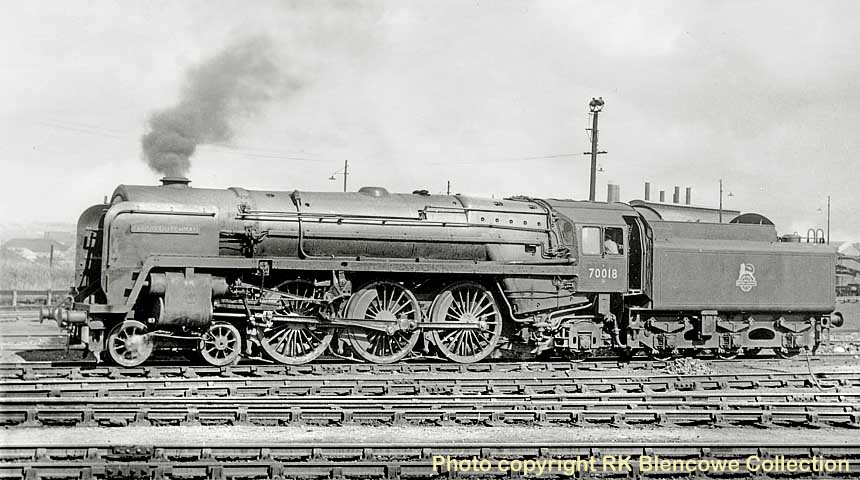
(Above) A superb study of Britannia 4-6-2 70018 Flying Dutchman captured by Rod Blencowe at Bristol Temple Meads Station, awaiting return to London Paddington on 8th August 1954. The side-on shot allows the viewer time to admire the lengthy wheelbase of 58 foot 3 ins and the overall length of 68ft 9ins which just fitted the usual 70 foot long turntables; while the fluted coupling rod and original vacuum pipe can be picked out by the casual observer.
ALLOCATIONS: 70018 spent a little over ten years in service on the Western Region; firstly from Old Oak Common until December 1956 followed by Cardiff Canton MPD (86C) until the middle of September 1961. 70018 was then posted to Carlisle Canal shed (12C) apparently to replace an LNER Class A3 Pacific engine, the shed having lost all but one of their allocation. In May 1962 a short stay at Longsight MPD (9A) was quickly followed in September by a move to Crewe North (5A) where large number of the Britannias were gathered. Upon closure of 5A to steam in May 1965, 26 of the 28 Britannia residents moved the short distance to Crewe South shed (5B) including 70018. Time was now becoming very short for 'Flying Dutchman' and his next move was basically the last; after spending nine months at Crewe South, 70018 was transferred to Carlisle Upperby shed (12B) until to December 1966 and ultimately ended his days at Carlisle Kingmoor two weeks later.
(Below) Comparison with the Bristol image will show that Britannia 70018 Flying Dutchman has received a number of changes; notably the smoke deflectors, post Milton, and the piping for the Automatic Train Control is now on display along the boiler walkway instead of hidden along the engine frame. This fine view taken at Cardiff in November 1958 also clearly shows the changes made by Swindon Works to the exhaust ejector assembly, situated just behind the WR type smoke deflectors
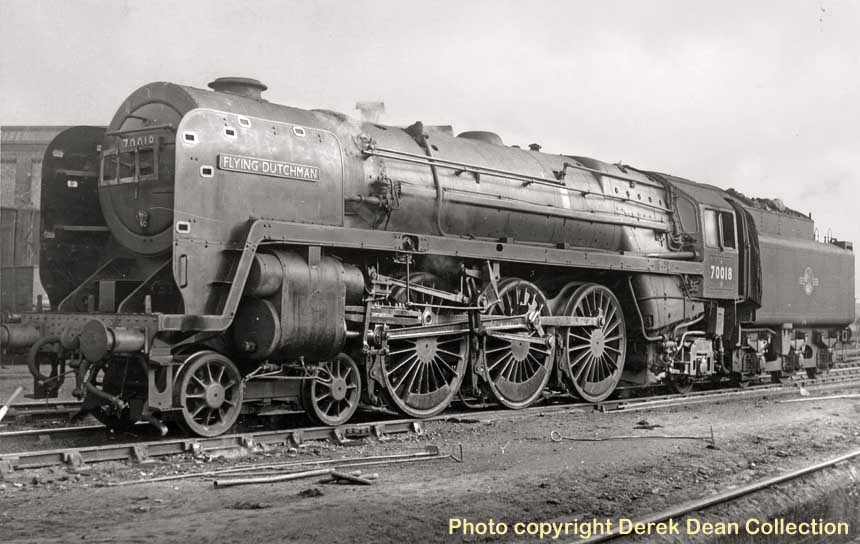
MODIFICATIONS: 70018 did not incur any problems with the drive axles (item 17), but it was set aside at Swindon until parts were available and the modification was completed in January 1952; also seen with a mix of coupling rods: plain at the front and fluted at the rear (item 14). A cab sheet (item 9) was added in February 1953, along with raised sand box lids (item 16); the regulator front rod bracket (item 5) and the reverse recouperating spring (item 8) was encased to help prevent lock-up. 70018 was the last Britannia to be built with the original vacuum pipe (item 21) and this was duly modified during a works visit in early 1955. Also at this time the exhaust ejector assembly (item 4) was fitted with a solenoid valve, with cabling
 back to the cab and plain coupling rods (item 14) could be seen both front and rear. Swindon Works was starting to modify the smoke deflectors (item 3) on the Britannia engines, something that must have seemed alien to them, and 70018 was altered to Western Region type in August 1957, along with the front step (item 1) modification and a new British Railways emblem (item 11) applied to the tender; plus the pipework for the ATC (item 20) was now out from the frame and running along the full length of the boiler walkway to the front of the engine. It was also noted that the exhaust ejector assembly (item 4) had now been lowered on the side of the boiler and the relative pipework altered to accommodate the different position.
back to the cab and plain coupling rods (item 14) could be seen both front and rear. Swindon Works was starting to modify the smoke deflectors (item 3) on the Britannia engines, something that must have seemed alien to them, and 70018 was altered to Western Region type in August 1957, along with the front step (item 1) modification and a new British Railways emblem (item 11) applied to the tender; plus the pipework for the ATC (item 20) was now out from the frame and running along the full length of the boiler walkway to the front of the engine. It was also noted that the exhaust ejector assembly (item 4) had now been lowered on the side of the boiler and the relative pipework altered to accommodate the different position. No further changes were seen until leaving Swindon in July 1959 when 70018 was observed with new wheels and the nearside lubrication rod (item 18) now set shorter to give a higher rate of oil delivery to the valves and cylinder. In 1961 70018 was repaired at Doncaster, although still a Western Region engine, and the power warning plates (item 19) were applied at this time, then shortly after the ATC equipment (item 20) was removed by Swindon before transfer away to Carlisle Canal shed. Following a move to Longsight in Manchester, 70018 had the original Western Region lamp irons (item 2) changed to the London Midland type, which were face-on instead of side-on (WR). 70018 did not ever receive a speedometer (item 13), but was fitted with the AWS equipment (item 20) at Crewe Works during January 1963, and seen with the pipework fitted in the chassis frame. The safety record of the ATC/AWS equipment was phenomenal, yet 70018 was one of only three engines of the whole class to have both fitted, which would have given maximum protection throughout their service career. The LNER type return crank (item 15) was also modified to the LMR type with four stud fixing, at this visit to Crewe.
(Below) Seen in the normal grubby condition for the period, Britannia 70018 Flying Dutchman waits at Carlisle Station in readiness for the long climb southwards up to Shap Summit some thirty miles away. From the extensive Archives of Rod Blencowe the image shows an ex-Western Region engine that has WR lamp irons, WR smoke deflectors with six brass-lined cut-outs and a red spot route restriction indicator on the cabside; but is now a LMR engine about to run the West Coast mainline. The date is given as late May 1962, just before transfer south to Longsight shed (9A) in Manchester.
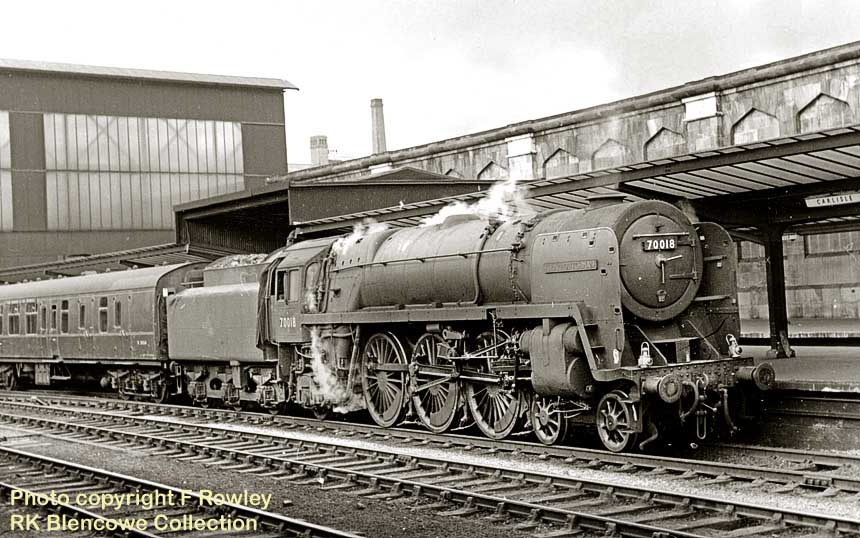
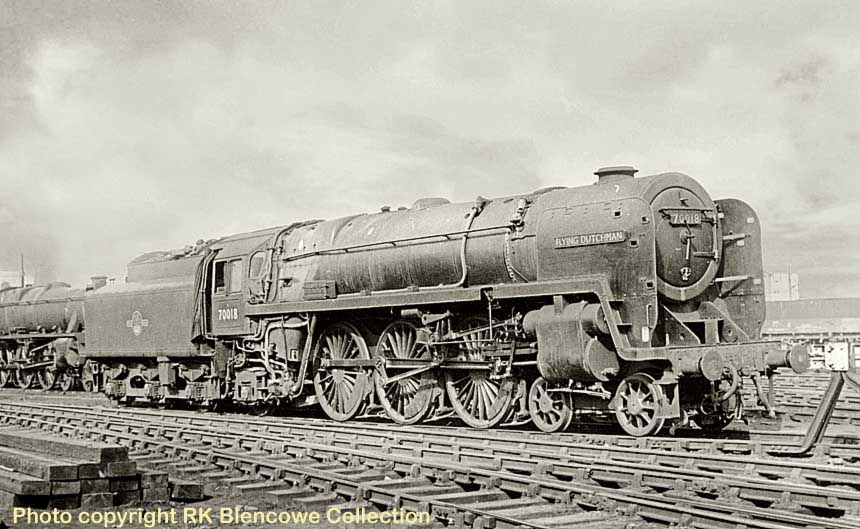
(Above) A lovely view of Britannia 70018 Flying Dutchman at Willesden shed, which was very close to Old Oak Common depot where the engine began his career about twelve years before in 1951. This image from the Archives of Rod Blencowe shows that the LNER return crank has been replaced with the LMR type and this indicates that the date is post February 1963, which is backed up by the shedcode of (5A) for Crewe North depot. Also of note is that the WR lamp irons have now been replaced by the more usual LMR type which are face-on and much shorter in length.
SERVICE RECORD: The wonderfully named Flying Dutchman gave good service throughout its career and generally averaged a recorded 48,000 miles from 1953 to 1960 with a maximum of 52,600 miles recorded in 1960, but the figure dropped to about 30,000 from 1961. 70018 was put to good use by Old Oak and then by Cardiff Canton loco sheds on the main top-link express trains such as 'The Cheltenham Flyer' and 'The Bristolian' from (81A) then 'The Red Dragon' and the 'Capitals United Express' when at (86C). When utilised by Carlisle Canal it was said that 70018 could not cope with the Waverley route and suffered 'loose wheels' was the term used, so the Britannia was moved on. The engine was subject to early rectification work at Crewe for firstly a week when only two weeks old, and then for four days when still only four weeks into service. In total 70018 had a recorded seven visits to Swindon Works; a further two trips to Crewe for repairs and just the one unexpected visit to Doncaster Works in 1961.
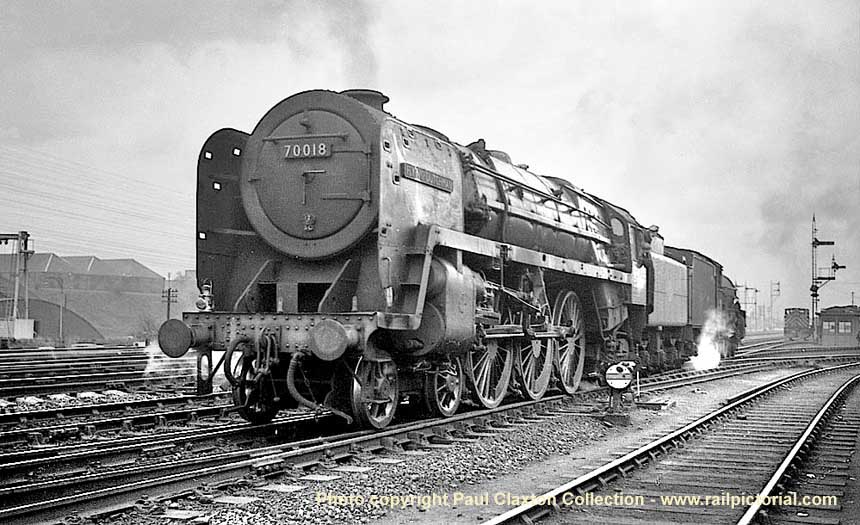
(Above) From the superb images taken by Paul Claxton, we see Britannia 4-6-2 No 70018 Flying Dutchman at Haymarket MPD in Edinburgh backing down to the 8 track shed in company of Class B1 No 61178, a long-time resident of (64B). 70018 has lost the ATC equipment and only received the AWS (BR version) assembly in January 1963, whereas 61178 was fitted up in February 1959. The two engines are directly opposite Murrayfield Rugby Union Football Ground first built in 1925.
SIGHTINGS: 70018 was spotted at Shrewsbury Station in June 1951, obviously brand new and pristine in appearance, during its running-in turn and with a bowler-hatted Inspector on the footplate to oversee proceedings; and seen at Cardiff station in beautiful condition, hauling 'The Red Dragon' to Paddington in July 1958. When viewed at Shap Summit signal box, 70018 was pulling a mundane mixed goods train south from Carlisle with the fireman well in control of the situation, taking things easy after the long climb up from Penrith and a wisp of steam showing at the safety valves. Although the outward appearance of the engine was good on that occasion, all later viewings were of a run-down locomotive that was showing much signs of neglect and a complete lack of even basic cleaning, deteriorating into a sorry sight, but yet still capable of putting on a performance as seen at Brighouse double-headed with a LNER B1 loco hauling the Heaton to Red Bank empty newspaper van train.
DISPOSAL: 70018 Flying Dutchman was withdrawn from Carlisle Kingmoor on Christmas Eve 1966, being stored at Kingmoor until late May 1967, and cut up at Motherwell Machinery and Scrap Co. of Wishaw in June of that year..
Programme authorised on 17th November 1949; built at Crewe Works and completed on the 30th June 1951 to order E479/220/Swindon 397. The additional part of the order number added the Swindon Works request to fit Western Region lamp irons and the Automatic Train Control equipment with in-frame pipework; this raised the cost of construction slightly to £20,144. The locomotive was withdrawn on the 12th March 1966.
ALLOCATIONS: 70019 'Lightning' was allocated new to Newton Abbot shed (83A) for a short three months before its transfer to Laira MPD (83D) in Plymouth. The Britannia then settled down to work from the South Devon depot until joining its classmates at Cardiff Canton MPD (86C) at the very end of 1956, thus forming a pool of 15 Pacifics at the South Wales shed. In September 1961 the locomotive was transferred to Carlisle Kingmoor MPD (12A) and then proceeded to move around several depots, as many members of the Britannia class did at this uncertain time; this included a move in June 1962 to Longsight (9A), to Crewe North (5A) in September 1962, and then a transfer to Aston (21D) from late May 1963. 70019 then returned to Crewe North (5A) in September the same year, but following closure of to steam in May 1965, it joined 26 of the 28 resident Britannias that moved the short distance to Crewe South (5B); however four weeks later 70019 was reallocated to Carlisle Upperby depot (12B), this being the final move for the engine as withdrawal came less than eight months later.
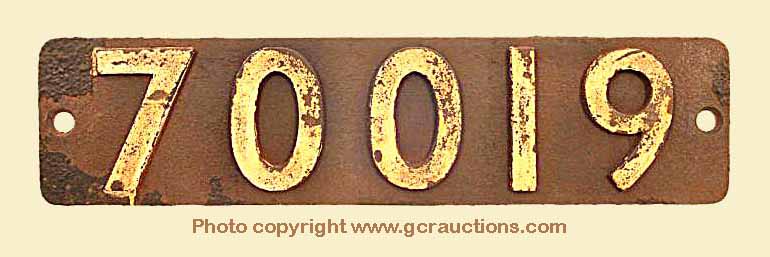
(Above-Below) A smokebox numberplate in ex-loco condition from BR Standard Britannia class No 70019 Lightning went under the hammer for £4,100 at a Great Central Railway Auction on 14th April 2012. (Below) Many of the new or repaired engines were dispatched by Crewe Works to Shrewsbury for running in purposes hence they could be found being serviced at the combined Western Region and LMR depot at Coleham, before returning to Crewe South for checking over. The pristine Britannia 7MT 70019 'Lightning' was captured by Rod Blencowe in front of the 8-track straight shed; note the dilapidated roof of the old roundhouse behind the ex-GWR 28XX engine on the right.

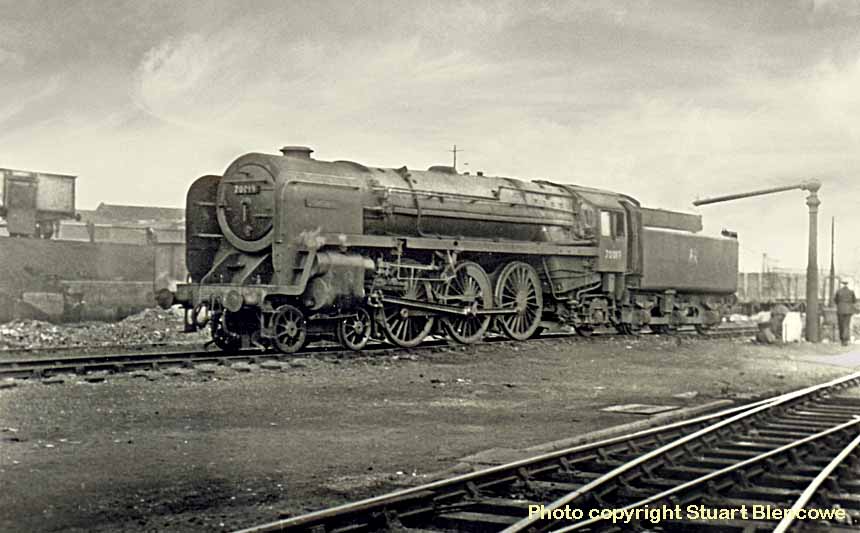
(Above-Below) Photographed on a misty March morning by Stuart Blencowe, Laira's Britannia Pacific 70019 'Lightning' has entered the massive Old Oak Common depot for refuelling after its 223 mile run from Plymouth in 1956. The rather unkempt engine reflects what the Laira crews thought of their stock of four Britannias…not very much! But the depot would not suffer them for too much longer as all four were transferred to Cardiff Canton MPD (86C) to link up with the eleven Britannia classmates already resident there. (Below) On a fine summer's day, Stuart Blencowe was in the right place to record this powerful image of Britannia Pacific 70019 'Lightning' in tandem with an ex-GWR Castle class locomotive at Laira depot (83D). No record can be found but the engine has been altered by Swindon Works in respect of the solenoid added to the exhaust ejector, with cabling back to the cab giving the driver better control over its operation. Of note is that the nearside exhaust flange cover is still missing; this should give the crew and fitters protection from possible burns, as well as enhancing the neat lines of the Pacific.
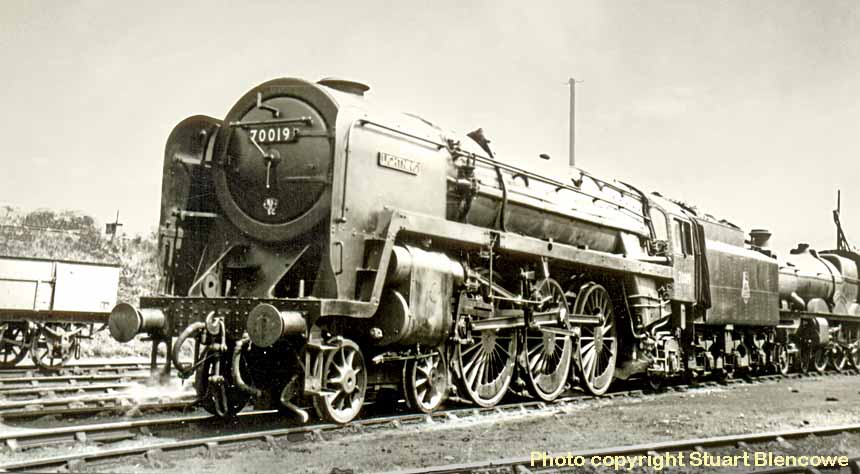
MODIFICATIONS: The twentieth member of the class was completed with the front vacuum pipe (item 21) modified as were all the following engines, also the lamp irons (item 2) were of the WR type from new, as per the Swindon Works order. Early in January 1952, 70019 'Lightning' entered Swindon Works to have the Axle repairs (item 17) carried out, which took seven weeks to complete and the engine was then seen with a mix of couplings rods (item 14) which remained throughout its career. However, in 1953 the Britannia entered Crewe Works for general repairs and was fitted with the steady bracket for the forward regulator operating rod (item 5). Later in 1953 the engine returned to Crewe Works and was modified with raised sand box lids (item 16) and a steady bracket for the regulator rear rod (item 7). A cab sheet (item 9) was fitted early in 1955 along with a tender step (item 10) as 70019 visited Crewe Works again, in preference to Swindon Works, although the subsequent five visits were to Swindon; resulting in changes to the smoke deflectors (item 3) and to the exhaust ejector (item 4), both modified in 1957 after spending 22 weeks under repair. Also at the same visit, a period from the beginning of March until the last week of July, changes were made to the front step (item 1) and the new BR logo was applied to the tender. A speedometer (item 13) was never fitted to this Britannia and it is worth noting here that of the 15 allocated to the Western Region, all had ATC equipment, only 20% went on to have AWS added and just 33% had a speedometer unit, all of which would have received the fitting after leaving the WR. Twelve months later, in 1958, 70019 'Lightning' was back at Swindon and the exhaust ejector was sited lower down the boiler to assist the driver's forward vision. From the middle of February 1960, Britannia 70019 'Lightning' was under repairs at Swindon and not released to traffic until the 11th August, by which time the boiler had been lifted and reconditioned, plus the original in-frame pipework for the ATC (item 20) was renewed and reset along the full length of the outer edge of the boiler walkway, while the nearside lubrication operating rod was shortened to deliver more atomised oil to the valves and cylinder. When the engine was allocated away from Cardiff in 1961, the ATC equipment was removed complete and 70019 'Lightning' was one of those never fitted with BR's AWS braking system, introduced in 1956. The power warning plates (item 19) were added by Carlisle Kingmoor and the Western Region lamp irons (item 2) were replaced with the normal short LMR type early in 1962.
(Below) In direct contrast to its condition while allocated to Laira (83D), Britannia Pacific 70019 'Lightning' does look a picture at Cardiff Canton MPD in July 1958. This photo was captured by the remarkable BKB Green, who travelled far and wide to record the 'steam era' for Initial Photographics. The engine is being cleaned for its next duty and the brass-edged cut-outs show up quite well on the smoke deflectors; the Pacific is posing alongside Gloucester shed's Modified Hall No 7926 Willey Hall, which only managed 14 years in service.
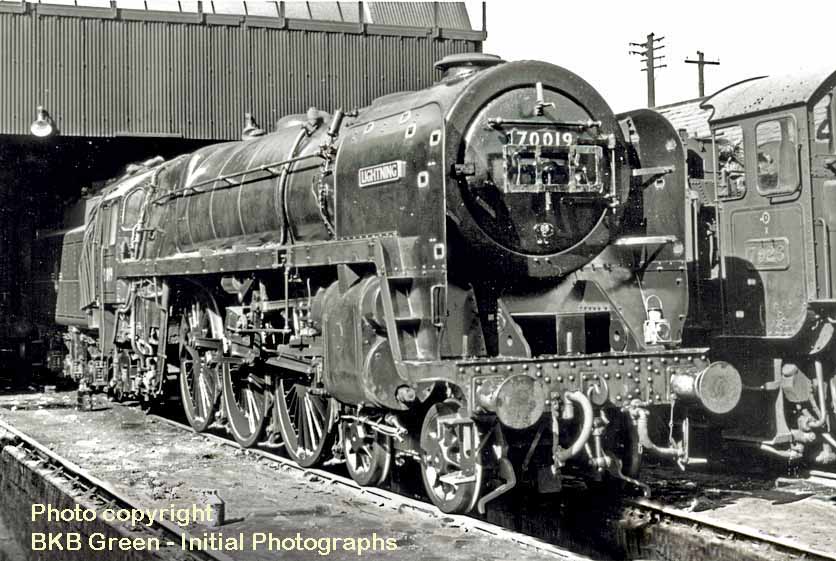
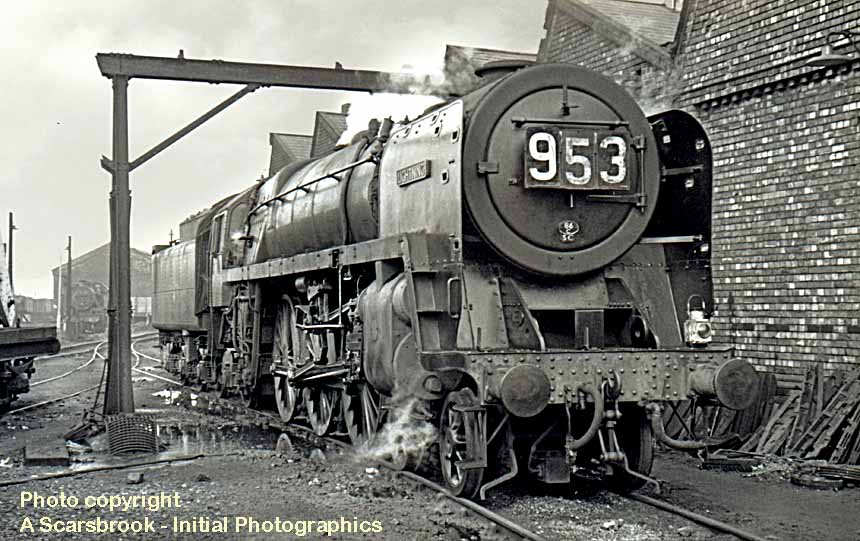
(Above-Below) Standing alongside the nine-track straight shed at Shrewsbury depot is Britannia Pacific 70019 'Lightning' as seen by photographer A Scarsbrook for Initial Photographics. The date provided tells us that the engine is on route to Swindon Works for light maintenance from June 1959 for six weeks, having come up from South Wales with the Swansea to Manchester London Road express. The building with the hipped roof behind the engine was the GWR coal stage, with the turntable situated over to the left of the cameraman. (With much thanks to Ed Chaplin for help with train identification). (Below) Devoid of its tender, Britannia Pacific 70019 'Lightning' was photographed on the reception road at Swindon Works awaiting its turn to be shopped and returned to traffic in April 1960. At this visit the boiler was lifted and reconditioned which may explain the delay of its release in August, but there were four others - 70022, 70025, 70026 and 70028 - in the 'factory' during June 1960; strange therefore that over 40% of the WR's Pacifics were out of commission during the height of the summer period.
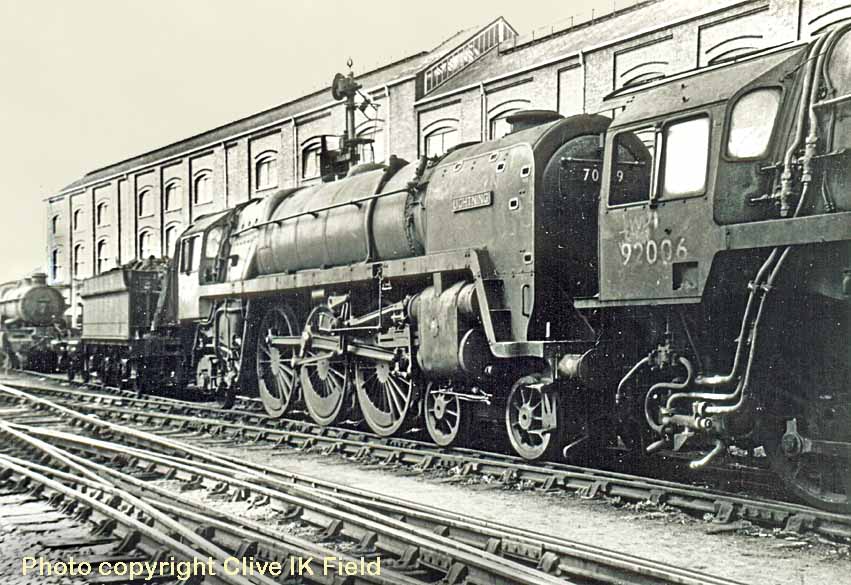
SERVICE RECORD: After the usual testing of a newly-built locomotive, 70019 'Lightning' was found to need some rectification at Crewe Works lasting for four days, which delayed its release to the Western Region. Swindon Works were then able to fit the ATC pick-up shoe and test the system (item 20) before they in turn released the Britannia to Newton Abbot depot. The engine was not well liked by WR crewmen and little used by Laira MPD as the mileage figures indicate; 40,000 for 1953, 1954 and 1958, an even lower return of 36,000 miles for the subsequent year and yet an even lower figure of 22,500 for 1960, albeit the engine spent six months at Swindon that year. In 1960 Cardiff Canton had 12 Britannia Pacifics at their disposal, but six of them spent much time under repair at Swindon Works; 70029 for four months; 70028 five months; 70026 also four months, while 70025 had a six months stint and 70022 just three months out of action. It is also worth noting that the influx of the 'King' Class engines began in September 1960, thus ousting the Britannias from many top-link expresses, especially the 'Red Dragon'. 70019 'Lightning' was a common sight on the 'Cornish Riviera' and 'Cornishman' expresses, plus it was seen on the 'Devonian' starting from its introduction in South Devon in 1951. During the engine's time at Laira, any photographs that have emerged reflect no cleaning was ever done and the exhaust flange cover, sited immediately above the cylinder, was noted to be missing over a period of quite some time. In direct contrast was the excellent condition of 70019 when working from Cardiff Canton MPD; the engine was seen many times in very good order hauling the 'Red Dragon', 'South Wales Pullman' and 'Capitals United Express'. Recorded visits to Works for repairs have shown five trips to Crewe and seven to the Swindon 'factory' although the record does remain incomplete and nothing is noted after 1960. The early withdrawal of 70019 appears to be due to the old and familiar problem of 'Wheel Shift'; the locomotive was placed in storage at Carlisle Upperby with connecting rods and coupling rods removed.

(Above) A very attractive nameplate measuring 35" by 6", face restored only, and arguably one of the best names - Lightning - went under the hammer for £13,750 at a Railwayananet auction in September 2006. Built at Crewe in 1951, No 70019 was one of a batch of fifteen Britannias named after earlier famous GWR broad gauge locomotives. 70019 went new to Newton Abbot in July 1951 followed by a transfer to Laira (83D) where it became the first of the class to work the 'Cornish Riviera Express' into Cornwall on 28th August 1951. All the Western Region Britannias went to Cardiff Canton in 1956. The locomotive was withdrawn from Carlisle Upperby in March 1966 and cut up at West of Scotland Shipbreaking Co Troon during the summer of the following year.
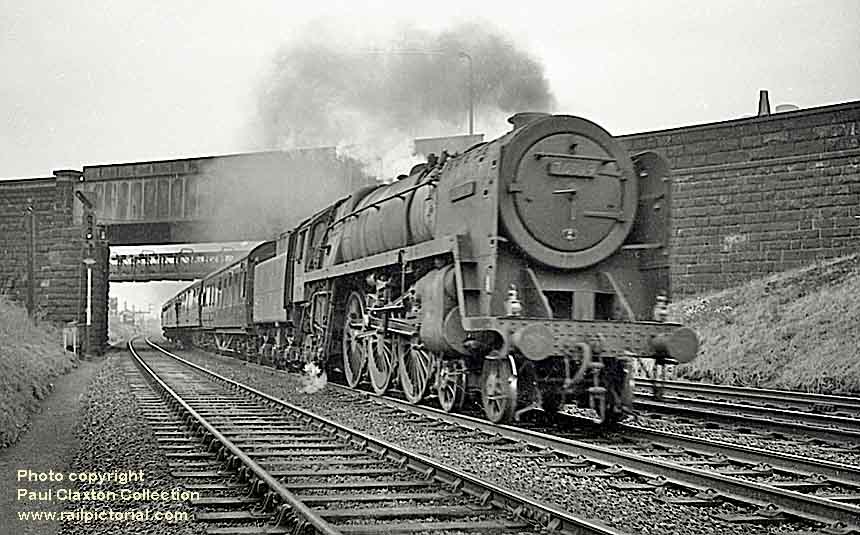
(Above-Below) A splendid action shot from the lens of master cameraman Paul Claxton, shows Longsight's Britannia 70019 'Lightning' speeding south towards Farington Junction, where the train will leave the West Coast Main Line for Liverpool. The express from Glasgow is identified as '1M38' and is threading Skew Bridge, where the well-known 'Mann's Beer' hoarding is positioned, a familiar landmark in the 1960s…the top of the display 'bottle' is visible top right above the retaining wall. Click HERE to visit Mike Claxton's brilliant 'Rail Pictorial', a website dedicated to the memory of his brother Paul, who sadly passed away in April 2009…a visit to Mike's site is highly recommended. (Below) Another fine shot from the Paul Claxton Collection, courtesy Railphotoprints; this excellent image shows Britannia Pacific 70019, minus its nameplates, heading north towards Preston on the West Coast Main Line during May 1965. The ensemble is passing Farington Junction signal box, which controlled the traffic to Liverpool and East Lancashire. The scruffy engine seems to be well in control of its task, having a full head of steam; note the young spotter on Bee Lane Bridge.
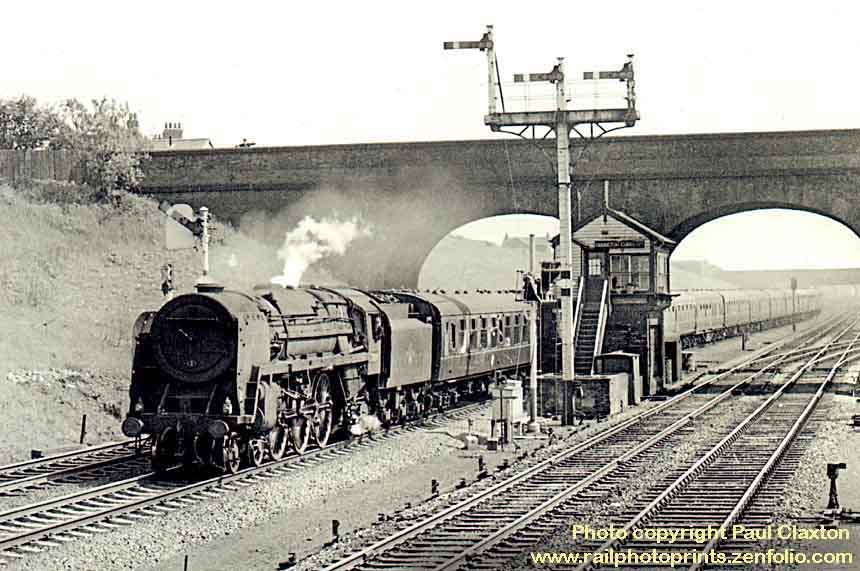
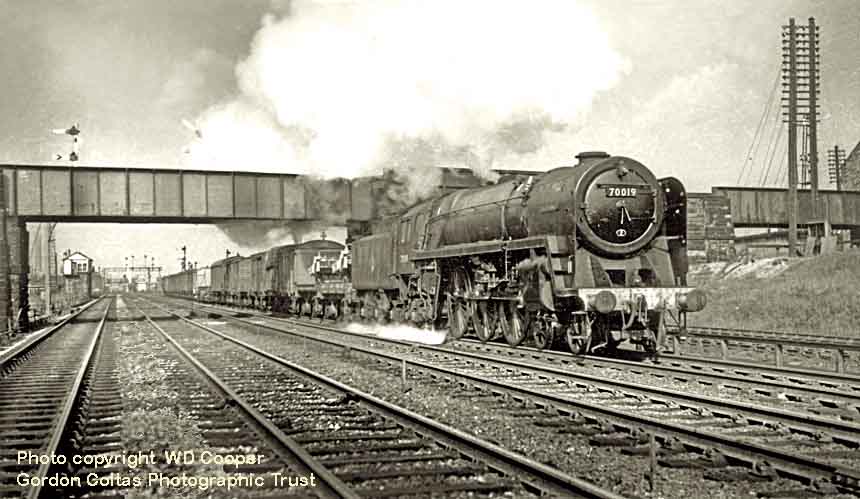
(Above) This gorgeous image of Wigan Springs Branch is absolutely chock full of interest; two signal boxes and a whole host of semaphore signals are in the frame, including three on the far right for the Manchester Exchange lines - the photo captures all that was so good about British Railways in the post war years. Having recently been relocated to Crewe North depot, Britannia Pacific 70019 'Lightning' is virtually ex-Works as it heads a somewhat unusual southbound freight towards Taylors Lane Bridge.
SIGHTINGS: Following the required axle repairs at Swindon In 1952, 70019 'Lightning' was observed working a Penzance to Paddington express at Newton Abbot Station later that year. The locomotive looked resplendent awaiting the 'right away' whilst a resident 'wheeltapper' looked on, having checked the integrity of the wheels available to him. During the engine's time allocated to Laira depot, it is doubtful that any cleaning was afforded to 70019 'Lightning'; this was witnessed at Teignmouth Station where the locomotive was in quite a despicable condition, and showing the missing exhaust flange cover from the offside cylinder - a sign of poor maintenance procedures. Later, at the end of August 1955, the Britannia was captured at Shaldon Bridge, just west of Teignmouth, with a London Paddington to Paignton train that ran non-stop to Exeter, then stopped at all stations to Paignton except Kingskerswell; this Sunday train ran during the summer peak period only and again the locomotive was in a shameful condition. However, the external condition of 70019 'Lightning' was much improved after its transfer to Cardiff Canton MPD from 1957, by which time extensive repairs had been carried out by Swindon Works; the locomotive was observed at Cardiff General station preparing to take over the 'Red Dragon' to London Paddington on 3rd August 1957; the engine looked immaculate with new or refurbished wheels gleaming, its full front step fitted and replacement WR type smoke deflectors with six brass-lined cut-outs in preference to the original handrails. The only one item that looked out of place was the new BR emblem on the offside of the tender which was incorrectly facing to the right. Even though the Britannia was working from South Wales in June 1958, it was back on familiar territory when pictured passing through Teignmouth with a Paignton-Newcastle express that the Cardiff engine would come off at Bristol Temple Meads. A very clean 70019 'Lightning' was the centre of attraction at Paddington in September 1960, having just arrived with the 'up' 'Red Dragon' from Cardiff, more often a 'King' hauled train at this time. It was noticeable that the engine had lost its steady bracket for the regulator rear rod and the cabling leading back to the cab for the exhaust ejector solenoid valve had been routed below the protective channelling for the small steam pipes, something not seen before. When allocated to Crewe North, the Britannia was viewed on Beattock bank at Harthope in April 1963; the locomotive looked to be in fine condition whilst working the mid-morning Liverpool-Edinburgh and Glasgow express loaded to 14 bogies, and requiring assistance of a banker engine at Beattock Station.
DISPOSAL: Withdrawal took place on Saturday 12th March 1966 from Carlisle Upperby. The engine was stored until September 1966 then moved to West of Scotland Shipbreaking Co Troon for cutting up.
Built at Crewe Works and completed on the 31st July 1951 to order E479/220/Swindon 397 and was withdrawn on the 21st January 1967. The additional part of the order number added the Swindon Works request to fit Western Region lamp irons and the Automatic Train Control equipment with in-frame pipework; this raised the cost of construction slightly to £20,144.
ALLOCATIONS: After a visit to Swindon for inspection, 70020 began its service from Old Oak Common MPD (81A), by far the largest engine shed on the Western Region, and was resident there unto the end of 1956, moving to join another twelve WR Britannias at Cardiff Canton depot (86C), so that engine crews could become more accustomed to their ways. 70020 then moved away to Carlisle Kingmoor shed (12A) in September 1961, becoming one of the first of the Class to be allocated there. Moves came thick and fast thereafter; to Longsight (9A), June 1962; Crewe North (5A) 3 months later; then Carlisle Canal (12C) from January 1963, but for 4 months only. 70020 then settled as a Willesden (1A) resident for a good period until January 1965, but was reallocated to Crewe North (5A) until its closure caused transfer to Crewe South (5B) in June that year. However, just 4 weeks later the engine was allocated to Carlisle Upperby (12B) for what was basically its last shed; a short move to Carlisle Kingmoor (12A) followed at the end of 1966 but the engine was withdrawn after only 5 weeks there.
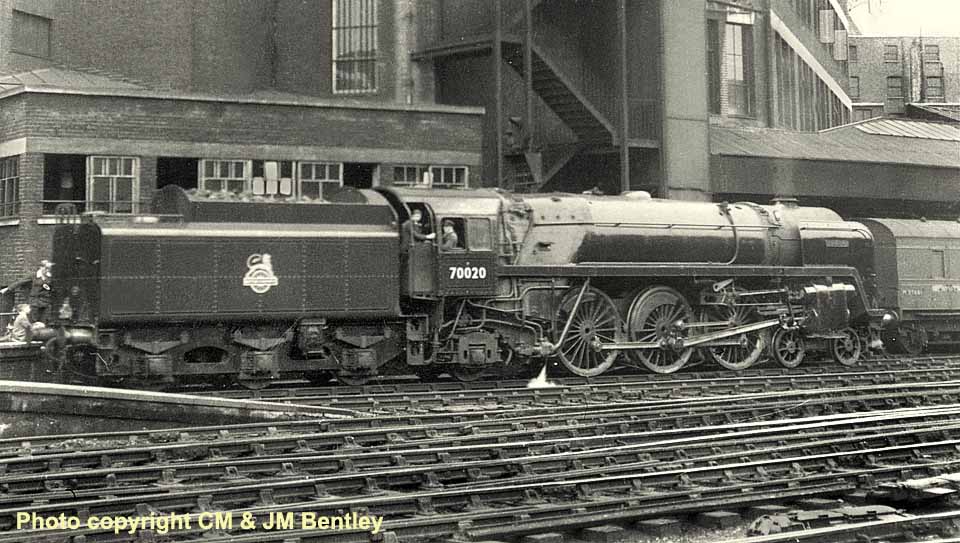
(Above-Below) From C.M. & J.M. Bentley we have this lovely image of new Britannia 70020 Mercury resting at Paddington Station awaiting its next duty, with the crew seemingly relaxed and the young spotters suitably impressed by the sight before them. Following 70017 Arrow and 70018 Flying Dutchman to the Western Region, the locomotive would still be on test from Swindon before being handed over to the running staff at Old Oak Common MPD. Of note is the brick-built departures signal box, built in 1907, behind the engine, and the small dome on the tender, near to the coal space, which was increased in size some time later, by Swindon Works. (Below) This opportunistic image is from J.A.Coltas, and shows WR Britannia 70020 Mercury waiting to reverse down to Old Oak Common in company with one of the numerous 0-6-0 matchbox tank engines, at Westbourne Park Station in West London. The Britannia is fresh from Crewe Works in June 1954 and shows six modifications from new, including raised sandbox lids and the flexible cab sheets. Westbourne Park Station was the site of the original engine sheds, built in 1852, but these were demolished in 1907 after Old Oak Common MPD came into use; the station became integral part of the LT underground system, in 1933, deemed the Metropolitan Line, and later named as the Hammersmith and City Line.

MODIFICATIONS: Before delivery into service, 70020 would have gone to Swindon for fitment of the ATC pick-up shoe situated under the front buffer beam and then for testing of the engine absolute. First seen changes to 70020 Mercury would have been the Axle repairs (item 17) which are recorded as carried out by Swindon Workshops late in 1951, while the wheel coupling rods (item14) were plain at the front and fluted to the rear and though most engines were further modified to both plain, 70020 was not, and the rods stayed with the mix of the two types right to the end of service. During 1953 the raised sandbox lids (item 16) appeared, with two on each side of the engine, and designed to help simplify the task of filling them.
 These were followed by the additions of the regulator front operating rod support bracket (item 5); the cab flexible screens (item 9); tender steps (item 10) of LMR type; and the reverse recouperating spring (item 8) was encased when the locomotive visited Crewe Works during June 1954. As a Western Region Britannia, 70020 received changes to the exhaust ejector (item 4); in 1956 a solenoid valve was added by Swindon Works; while two years later the whole unit was set in a lower position. A visit to Crewe Works in June 1956 saw a modification to the front step (item 1) from the original; also the LNER return crank (item 15) was changed to the LMR type. 70020 is recorded as spending over 3 months in Swindon Works from late March 1958 and received a number of modifications; the regulator rear rod (item 7) was fitted with a support bracket; the smoke deflectors (item 3) were altered to LMR type 2, which basically means that the normal LMR 1 type were used, but without the backing cups to the handholds and became the second engine behind 70017 Arrow to have these fitted; a new style BR emblem (item 11) was added to the tender and as mentioned above the exhaust ejector was moved down the boiler. The engine was unchanged over the following three years as far as records show, although at some stage Swindon works did change the original dome on the tender to a much deeper version to try to prevent overflowing when refilling from water troughs. A speedometer unit (item 13) was not fitted at any time despite records showing different, and the AWS equipment (item 20) was never fitted either, although the ATC system was fitted from new, but this was removed by Swindon in September 1961. The power warning plates (item 19) were seen to be fitted from April 1962 and the lamp irons (item 2) were now of LMR type.
These were followed by the additions of the regulator front operating rod support bracket (item 5); the cab flexible screens (item 9); tender steps (item 10) of LMR type; and the reverse recouperating spring (item 8) was encased when the locomotive visited Crewe Works during June 1954. As a Western Region Britannia, 70020 received changes to the exhaust ejector (item 4); in 1956 a solenoid valve was added by Swindon Works; while two years later the whole unit was set in a lower position. A visit to Crewe Works in June 1956 saw a modification to the front step (item 1) from the original; also the LNER return crank (item 15) was changed to the LMR type. 70020 is recorded as spending over 3 months in Swindon Works from late March 1958 and received a number of modifications; the regulator rear rod (item 7) was fitted with a support bracket; the smoke deflectors (item 3) were altered to LMR type 2, which basically means that the normal LMR 1 type were used, but without the backing cups to the handholds and became the second engine behind 70017 Arrow to have these fitted; a new style BR emblem (item 11) was added to the tender and as mentioned above the exhaust ejector was moved down the boiler. The engine was unchanged over the following three years as far as records show, although at some stage Swindon works did change the original dome on the tender to a much deeper version to try to prevent overflowing when refilling from water troughs. A speedometer unit (item 13) was not fitted at any time despite records showing different, and the AWS equipment (item 20) was never fitted either, although the ATC system was fitted from new, but this was removed by Swindon in September 1961. The power warning plates (item 19) were seen to be fitted from April 1962 and the lamp irons (item 2) were now of LMR type.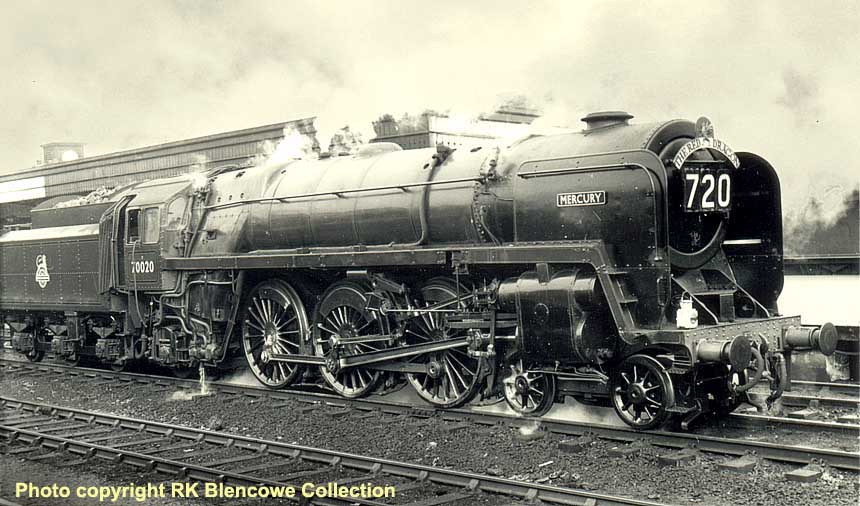
(Above-Below) Resplendent Britannia 70020 Mercury is at Cardiff General Station, awaiting its train to arrive from Carmarthen, to take over the Up 'Red Dragon', the 10.00 am departure to Paddington. Cardiff Canton MPD took well to their initial allocation of five Britannias from late 1952 and shed staff prepared them beautifully for the main expresses to London; then from January 1957 the other ten Western Region Pacifics, including 70020, were moved to Cardiff to concentrate their utilisation, and to increase the number of crews becoming more accustomed to their ways. Image dated March 1957 and from the Negative Archive of Rod Blencowe. (Below). A good shot of a Britannia captured by BKB Green for Initial Photographics; 70020 'Mercury' is following the empty coaching stock of its train out from Paddington Station, having brought the express up from Swansea to London on 10th September 1957. The Cardiff Canton engine is in poor external condition, which is most unusual, but also shows damage to the offside front valance, rarely seen outside of Cardiff at this time. Beyond the engine is the imposing Goods Station and an underground train for the Metropolitan Line.
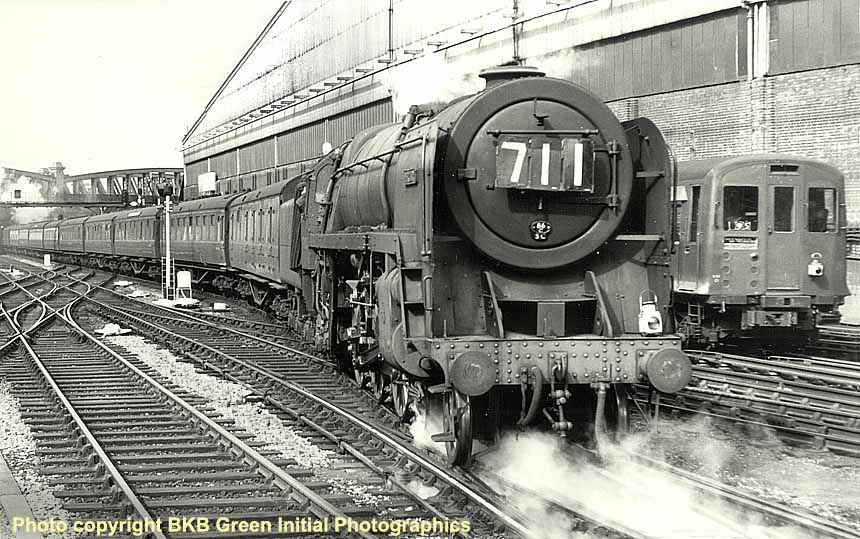
SERVICE RECORD: 70020 started life at Old Oak Common in late August or even into September 1951, joining forces with three other classmates, but finding that the competition was strong in the form 13 Kings and 27 Castle class engines; locomotives that the crews were accustomed to driving and furthermore were right-hand drive engines as opposed to these 'new machines'. Thus recorded mileages were on a par with the WR 4-6-0's, which averaged about 48,000 miles each, covering similar turns, on top-link work such as 'The Bristolian', 'The Merchant Venturer', which was one of the five new British Railways named trains to celebrate The Festival of Britain, and the other West Country expresses, working out of Paddington. The lowest recorded figure was 35,000 miles in 1958, although this did include a visit to Swindon Works, while the high point was to 58,000 miles in the following year. 70020 was also used on a test train, double-headed with 70023 Venus, in January 1952, hauling a coal train of 1,200 tons between Toton and Brent on the Midland Main line, testing performance levels and braking capabilities. Having moved to Cardiff Canton, 'Mercury', could be seen at the head of 'The Red Dragon' or 'The Capitals United Express' and many other South Wales express trains including Swansea to Manchester and Liverpool trips, taking the train through as far as Shrewsbury Station, before returning on similar North-West route expresses. In 1964, 70020 was selected for no less than four separate Rail-tours with starting points at Waterloo, Willesden, London Kings Cross and London Euston Stations. During 1966, the locomotive did suffer drive wheel problems and was seen at Carlisle in September of that year with one drive axle out for repairs, but the engine was seen in service again soon afterwards. It is also worth noting that of the Britannias, only 70018 Flying Dutchman and 70020 Mercury were allocated to all three Carlisle Sheds; 12A, 12B and 12C.
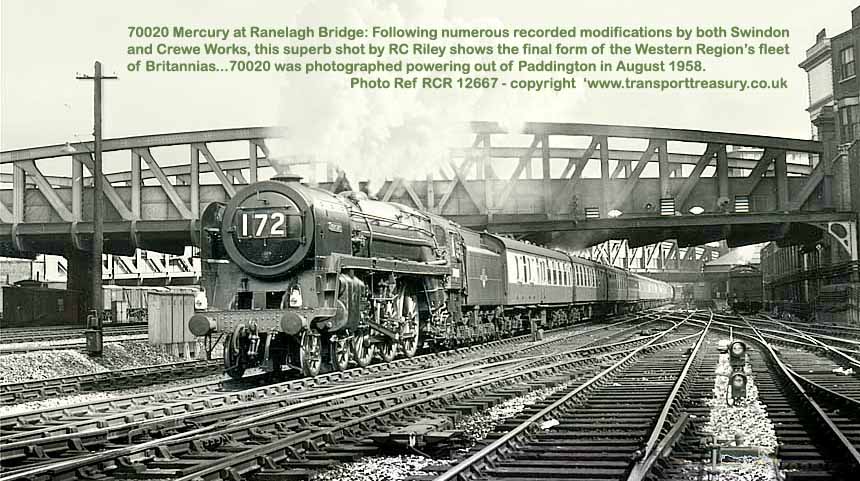
(Above-Below) A superb lineside action shot from R.C.Riley, for Transport Treasury HERE, showing the final form of the Britannia engines on the Western Region following numerous recorded modifications by Swindon and Crewe Works had been completed. 70020 Mercury is seen powering out of Paddington in August 1958, passing Ranelagh Bridge servicing yard, with the afternoon London to Pembroke Dock express, reporting number '172' which was formerly applied to the famous 'Cheltenham Flyer' express. (Below) This lovely image from the camera of Peter Groom shows Canton Britannia 70020 Mercury sweeping through Sonning Cutting, with the Paddington to Pembroke Dock express, carrying train reporting number 714, on Sunday 14th June 1959. This wonderful setting between Twyford and Reading was first built in 1840, by hand and taking two years to shift the earth; the cutting was widened much later. Of note on the locomotive are the smoke deflector handholds which can be seen as the LMR type 2, without any backing cups.
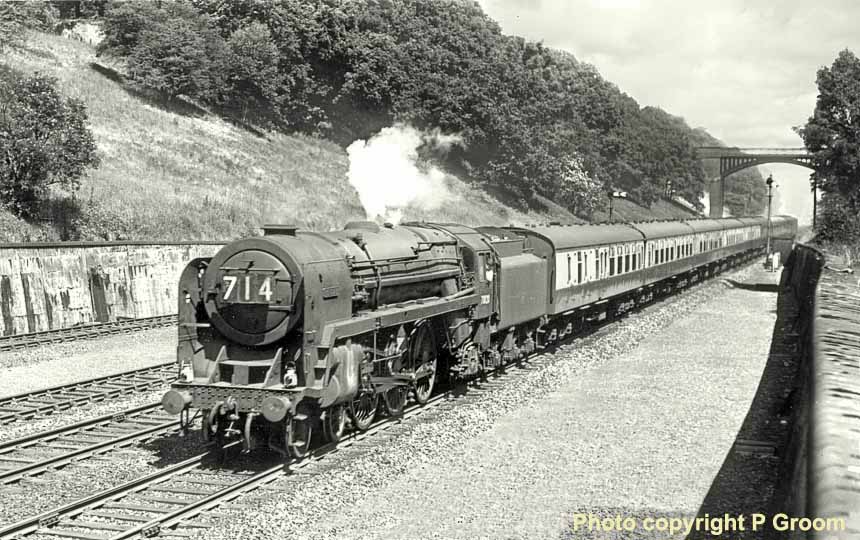
SIGHTINGS: 70020 Mercury was first pictured at Bath Station in near new condition, on a running-in trip from Swindon MPD, testing the Auto Train Control braking system, whilst thoroughly checking the general operation of the engine. On 29th August 1951 the locomotive was seen hauling 'The Merchant Venturer' at Chippenham, on the down train from Paddington to Weston-super-Mare and looking a fine sight indeed. But that was far from the case when spotted leaving Shrewsbury in July 1954, because the Britannia was in filthy condition and was seen to be pulling a freight train, which originated in Birkenhead, heading for Old Oak in London. Yet only one week later 70020 could be seen in very clean condition at Exeter St. David's Station with train reporting number 117, which was the morning Paddington to Kingswear express. Just over 12 months later the engine was observed at Old Oak common in a bedraggled state; a large section of the front buffer beam having been ripped off along with the valance and lower part of the smoke deflector, all on the offside; also the general condition of the engine was very poor with no livery visible anywhere. But all looked fine again in August 1958, as the engine was viewed leaving Neath General Station with train reporting number 172, which was identified as the afternoon Paddington to Swansea express. While 70020 was allocated to Cardiff Canton, the usual condition of the engine was excellent, as it was when photographed at Shrewsbury Station, having arrived with a Swansea to Manchester express passenger train, one of five such trains on the so-called North-West route that ran daily. After this event the Western Region Britannias began to be ignored for the top express trains because the mighty Kings were in prime position at Cardiff with ten of the class being available and the general state of the Britannias became rather poor. In June 1962, 70020 was noted bursting from Moncrieff Tunnel, a short way south of Perth, with an express fish train for the south and the overall condition of the engine was rather poor again. While in late 1963 the locomotive's condition was exemplary when seen at Newton Heath depot, awaiting its next duty, and displaying all the expected modifications, but still showing the mix of plain and fluted coupling rods that were kept to the end. During March 1965, 70020 was recorded as taking an excursion from Coventry to the North East and was pictured taking on coal at West Hartlepool shed, while it was noted that the nameplates had just been removed and the apron over the front buffer beam was very shoddy indeed, also the lamp irons were a strange mix of long and short versions, such were the vagaries of the Britannia Pacifics.
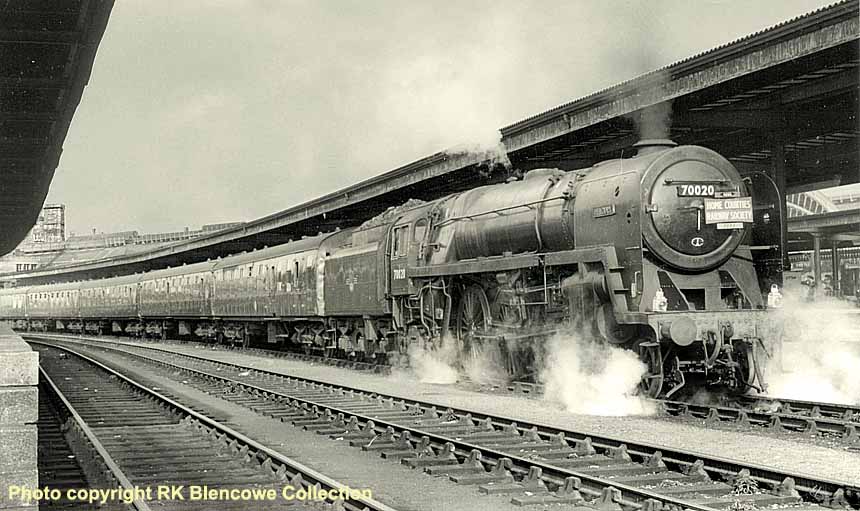
(Above) A smart looking 7MT Britannia 70020 Mercury is seen entering York Station, in October 1964, with the return leg of the' Home Counties Railway Society' York Railtour, which had set out from London Kings Cross and followed the ECML route to Grantham then reached Lincoln and Gainsborough before arriving at York. The locomotive was a late replacement for the advertised 46256 Sir William A. Stanier FRS, which was unfortunately withdrawn from service shortly before the event.
DISPOSAL: 70020 Mercury was withdrawn from service on Saturday 21st January 1967, stored at Carlisle Kingmoor yard until 22nd May 1967 and then transferred to J.McWilliams of Shettleston, a suburb of Glasgow, being just over three miles to the east of the City Centre. The company was responsible for the disposal of over 40% of the Britannia class.
Programme authorised on17th November 1949; built at Crewe Works and completed on the 3rd August 1951 to order E479/220/Swindon 397 and was withdrawn on the 30th December 1967. The additional part of the order number added the Swindon Works request to fit Western Region lamp irons and the Automatic Train Control equipment with in-frame pipework; this raised the cost of construction slightly to £20,144.
ALLOCATIONS: After running-in was completed to satisfaction and the ATC pick-up fitted by Swindon Works, 70021 was delivered to Plymouth Laira MPD (83D) to begin earning some revenue, and would have been the first of the five Britannias to see service from that depot. Early in 1957, the engine moved from Devon to join the other WR Britannias at Cardiff Canton (86C), but was removed from Cardiff after eighteen months and allocated to Trafford Park depot in Manchester (9A) from July 1958 until February 1961, when transfer to Willesden MPD (1A) came about. The engine resided at the West London depot until the first days of 1965, except for one week away at Aston shed (21D) in March 1962, which may or may not have been an anomaly. The locomotive then followed a very familiar path for the Britannia class; after closure of Crewe North depot (5A) to steam in June 1965 70021 was transferred to Crewe South shed (5B), but then deviated slightly when transferred to Newton Heath MPD (26A) in mid-July 1965. 70021 stayed in the Manchester area with a move to Stockport Edgeley depot (9B) in late May 1966, remaining there for slightly more than twelve months before its final move to Carlisle Kingmoor shed (12A) for its last six months in service.
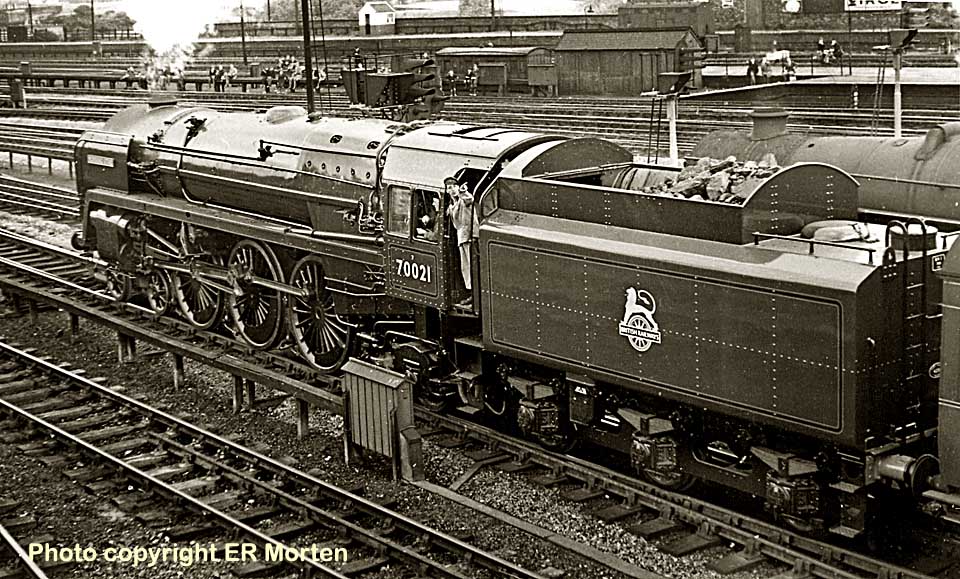
(Above-Below) An opportunistic capture by the redoubtable E R Morten of newly-built Britannia Pacific 70021 Morning Star departing Crewe on a running-in turn, possibly to Chester and return on 6 August 1951. The locomotive is facing nearly two weeks of testing and close checking of its vital components prior to a transfer to the Western Region at Swindon; the fireman appears to be admonishing someone on the footbridge spanning the platforms. (Below) Thanks to the sterling efforts of the Lens of Sutton Association Photographers, this picture of 70021 Morning Star at Old Oak Common is just one of the wonderful images to be found in the Association's collection. Allocated to Plymouth Laira (83D) 70021 Morning Star is awaiting a return working in the summer of 1952; by this time it has undergone a couple of modifications from new, namely the drive axles and coupling rods; also of note is the original reverser recuperating spring above the middle drive axle.
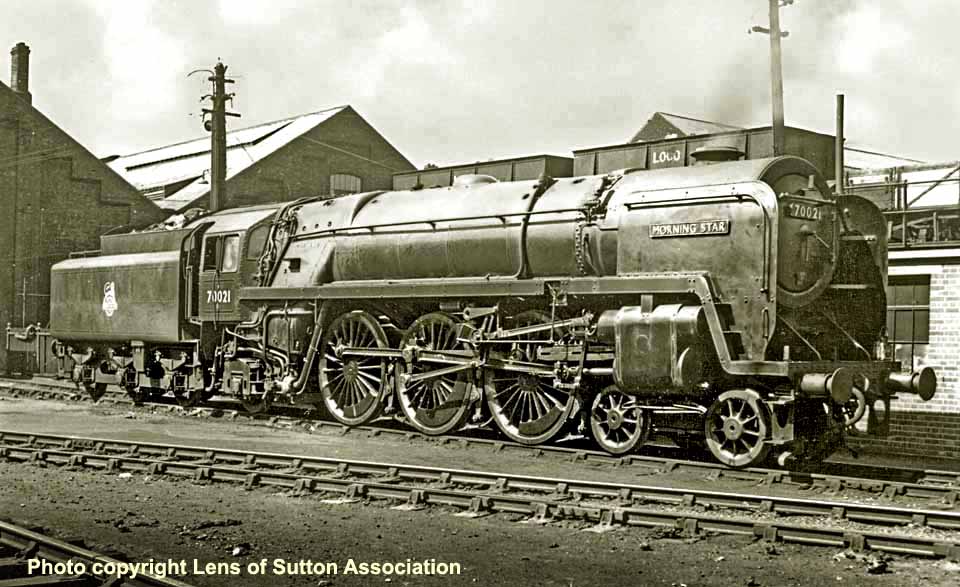
MODIFICATIONS: 70021 Morning Star was new to Plymouth Laira and was working the southwest area, so when required to go for the obligatory Axle repairs (item 17) the engine went to Swindon Works during late December 1951, lasting until the end of January 1952. The coupling rods (item 14) as seen at that time were of plain type at the front of the engine and of fluted variety between the middle and rear drive axles, but these were modified to all plain during the next visit to Crewe Works in June 1953; also the sand box lids (item 16) were raised to aid filling the boxes, the regulator forward rod bracket (item 5) was fitted and the reverse gear recouperating spring (item 8) was encased to help prevent lock-up in service. Early in 1955 the engine entered Swindon Works for maintenance and was seen with a tender step (item 10) added to each side of the bunker and a solenoid valve was added to the exhaust ejector unit (item 4) with cabling back to the cab. Unusually the cab sheet (item 9) was not fitted until the next entry into Crewe Works late in 1956, in fact Christmas Eve is given as the release date; also the pipework for the ATC equipment (item 20) was now refitted along the boiler walkway, and all the way to the front which was not so common. The front step (item 1) was modified from the original small twin steps at Crewe Works during November 1957, with the new British Railways emblem (item 11) also making its bow; the rear regulator rod bracket (item 7) was added and the LNER return crank (item 15) was swopped for the LMSR version with the four pin fixing. Also at this visit the nearside lubrication operating rod (item 18) was much shortened to increase the rate of delivery in service. 70021 was transferred to the LMR in the summer of 1958, so that the WR style lamp irons (item 2) were replaced with standard London Midland type and the Western Region ATC equipment was removed absolute; but the engine did not receive the AWS system at any time. The fact that the engine was only shopped at Swindon Works twice and thereafter always at Crewe, is the reason that 70021 became the only WR Britannia to avoid the modification to the smoke deflectors (item 3). The power warning plates (item 19) were added at the end of 1959, these being a requirement after some close-calls for the crews concerning the newly added overhead high-voltage cables for electrification. In September 1960, a speedometer unit (item 13) was added, basically completing all the modifications for the locomotive. The only other changes seen; the repositioning of the lamp irons in 1963 and the nameplates were seemingly removed in 1965.
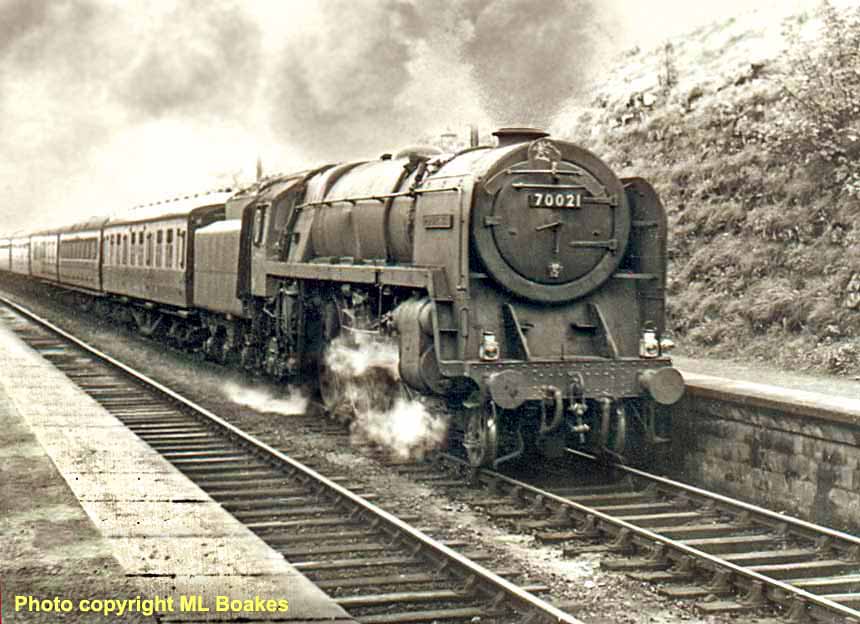
(Above-Below) A rather unlikely setting for a Britannia to be observed; 70021 Morning Star is heading an express for Cardiff through St. Athan station in the Vale of Glamorgan, South Wales. The reversed named train headboard indicates the locomotive will take over the down 'Red Dragon' at Cardiff to complete the journey to Carmarthen. High mileage engines that were due for overhaul were utilised west of Cardiff to work trains to Swansea, Pembroke and Fishguard Harbour, thus connecting passengers with a number of sailings to Southern Ireland. (Below) In the summer of 1957, Cardiff Canton based Britannia 70021 Morning Star eases into Paddington Station with the up 'Red Dragon'; this train originated at Carmarthen and the 'Britannia' was responsible for the run from Cardiff General. This image from Rod Blencowe reflects how the Britannias were utilised by Cardiff Canton on the WR's top-link expresses, although on this occasion the condition of the engine is slightly below par. The following year 70021 was one of 3 Britannias loaned to Trafford Park shed to work Manchester-London St Pancras expresses, a move which became permanent after a couple of weeks.

SERVICE RECORD: 70021 Morning Star became the first of five Britannia Pacifics to be allocated to Plymouth Laira depot, but they were not welcomed by crews who were used to the right-hand drive 'Kings' and 'Castles'. The 7MT's were also prone to slipping of the drive axles, it was said, and the sanding gear did not work to good effect, hence time was lost in comparison to the sure-footed Great Western locomotives. But 70021 lasted over five years at Laira where it worked expresses such as the 'Devonian' and the 'Cornish Riviera' as well as the 'Cornishman' and other expresses to London Paddington.
After moving onto Cardiff Canton the engine was seen hauling top-link expresses to London, such as the 'Capitals United Express' and the 'Red Dragon'. Then in the summer of 1958, 70021 joined 70004, 70014, 70015, 70017 and 70042 at Trafford Park depot in order to augment the London Midland Region's services to London such as the 'Palatine' up to St Pancras while work began on the WCML electrification.
The recorded mileages were not in the high category when running on Western main lines and only slightly better when running on Midland lines. Highest figure was 63,000 miles in 1959, while a figure of 51,000 miles was returned in 1955 and an average of 40,000 over six other years up to and including 1958. The Britannia entered Swindon Works just three times and was mainly seen in Crewe Works, having been shopped there seven times, hence the reason its smoke deflectors remained unaltered throughout its service life.
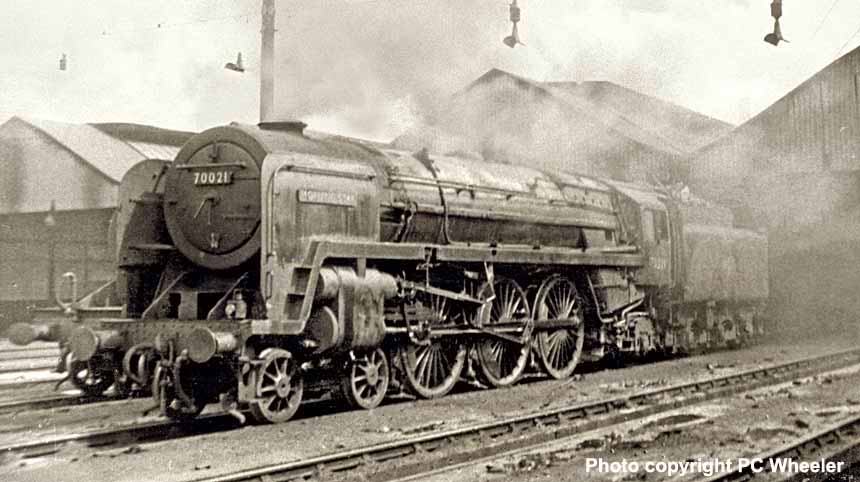
(Above-Below) An atmospheric shot of a rather bedraggled-looking Britannia 70021 Morning Star at Trafford Park shed; the locomotive had only recently been transferred from Cardiff Canton depot in South Wales, and is now looking decidedly worse for wear. Also there are no other visible signs that the locomotive is from the Western Region; no WR lamp irons, no red spot on the cabside, and no change to the original smoke deflectors to help identify its previous home. (Below) Another interesting shot from the superb photographic archive of Rod Blencowe, depicting ex-WR Britannia 70021 Morning Star on a local service at Northampton in 1961. The engine has obviously been pressed into service after heavy accident damage has brought about a strange appearance to the locomotive; the offside smoke deflector is new, with fresh paintwork including overpainting of the nameplate; a new power warning plate stands out starkly and at the front, fresh red paint on the buffer beam, yet superficial damage is still evident on and around the cylinder.
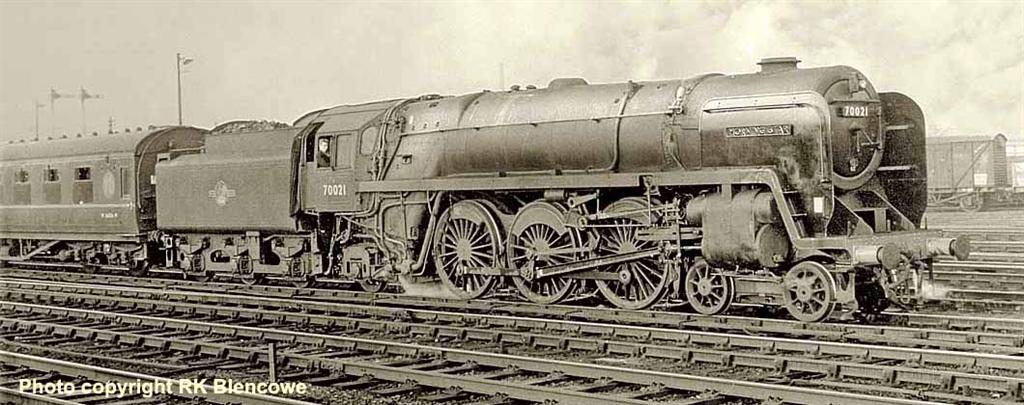
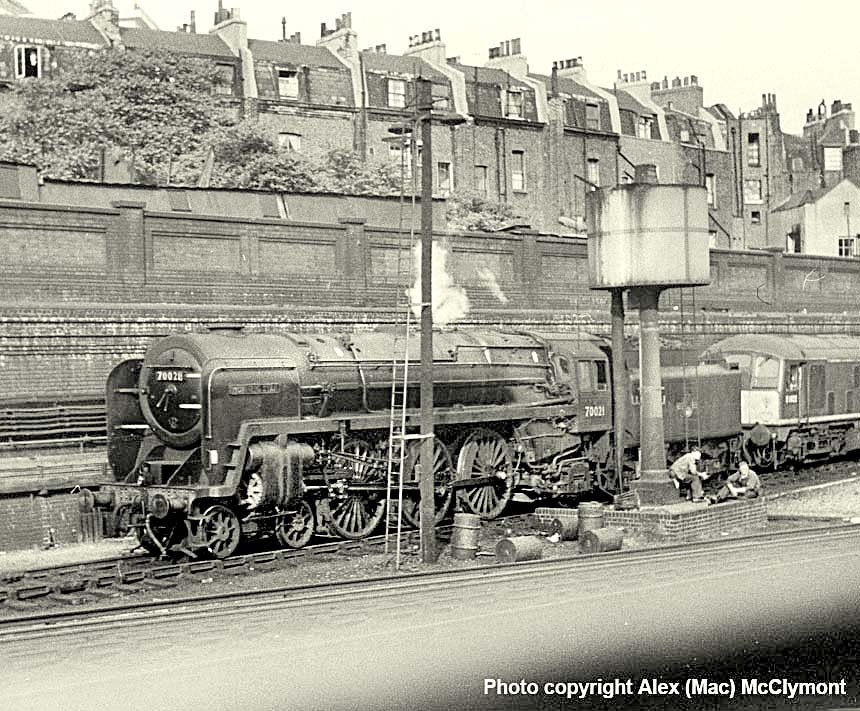
(Above) The engine crew take a breather as Britannia Pacific 70021 Morning Star and an unidentified Class 25 await their next duties, as observed by Alex (Mac) McClymont from a passing train out of Euston Station in July 1962. The white markings prominent on the smokebox were a feature of its stay at Aston shed in Birmingham, but by the time this photo was taken 70021 was allocated to Willesden MPD (1A). Of note is the nearside cylinder head which is a replacement type; this is almost certainly due to damage and is prominent because the cover has not been refitted.
SIGHTINGS: A slightly dusty Britannia was espied at Swindon MPD quite late in August 1951; it was reported as 'just arrived' from Crewe, revealing that around two weeks of testing had been carried out before release into service to the Western Region. The following year an early morning picture reflected 70021 hauling a Paddington to Penzance sleeper train at St. Erth Station in Penzance, with just over five
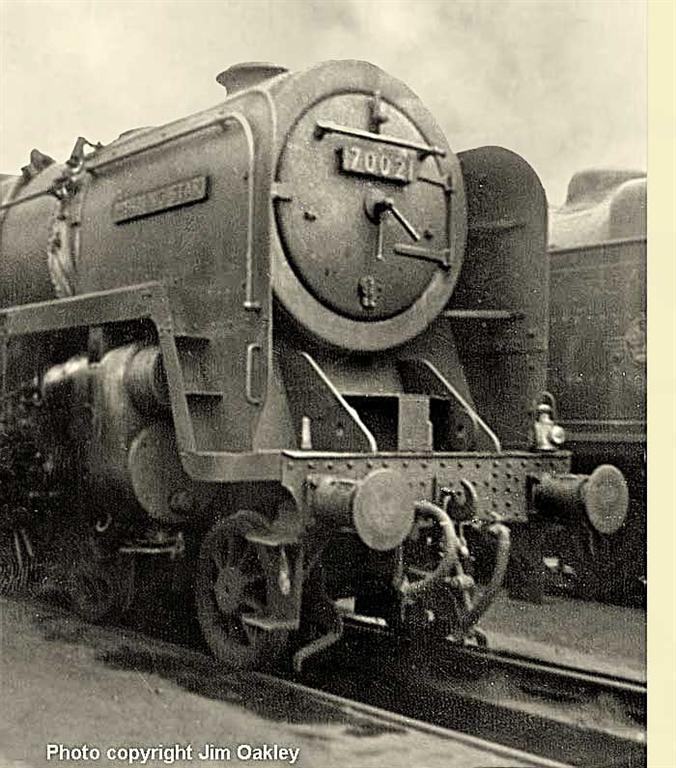 more miles to complete the journey. Just a few miles east of St. Erth is Hayle Station and in July 1953 70021 was photographed climbing from Carbis Bay with the Up Cornish Riviera, a top-link express normally dominated by Western Region 'King' Class locomotives.
more miles to complete the journey. Just a few miles east of St. Erth is Hayle Station and in July 1953 70021 was photographed climbing from Carbis Bay with the Up Cornish Riviera, a top-link express normally dominated by Western Region 'King' Class locomotives. An unusual event was captured on camera in early August 1955, when 70021 Morning Star was coupled with 70017 Arrow on an eleven coach Penzance to Paddington train at Aller Junction, west of Newton Abbot. Shortly before a Swindon Works visit, which preceded transfer to Cardiff Canton, the engine was viewed at Old Oak Common MPD in very tidy condition, but it was noticeable that there was no 'red spot' added below the cabside number; this was the Western Region's way of denoting weight restrictions as applied to certain locomotives. In 1959, 70021 was pictured leaving Derby Station following its relocation to Manchester Trafford Park and extended usage on the London St. Pancras services, but was seen in a very work stained condition at this time. With the electrification of the West Coast Main Line mostly in place, the Midland services were rapidly downgraded and 70021 was relocated to Willesden shed from which the engine worked for almost four years, concentrating on expresses to the North West of England and also into North Wales, where the Britannia was seen on Prestatyn water troughs in May 1964 returning with empty coaching stock. Late in 1966 a now nameless 70021 was pictured in the yard at Crewe Works awaiting repairs after seemingly breaking the piston of the nearside cylinder; the loco still had lining on the Brunswick Green livery, which was unique at this late juncture.
(Below) Sporting false, but very creditable nameplates, a fine-looking 70021 was photographed at Mirfield MPD by Stuart Blencowe in September 1966. This North Eastern Region depot was home to 40 engines in 1950 reduced to just 30 in 1959. By 1962 it had 3 Royal Scots and a large turnover of Class B1, Class B16 and many WD 2-8-0 engines on its books. Following closure in April 1967 the eight-track shed building was taken over by a Tanker Transport company, but the site has now been cleared to make way for new housing.
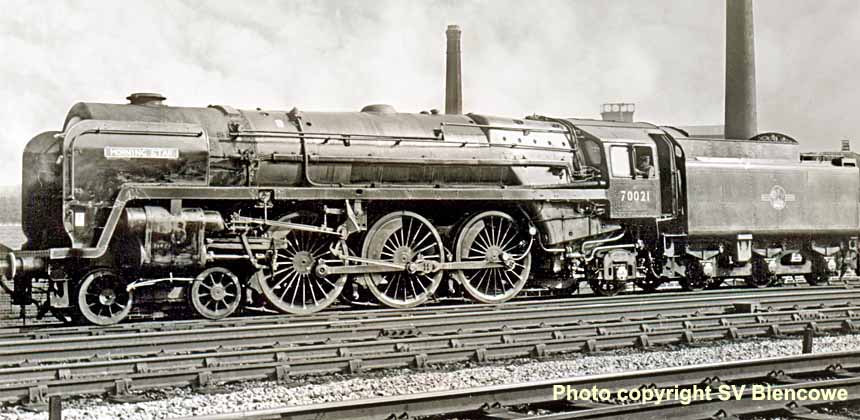
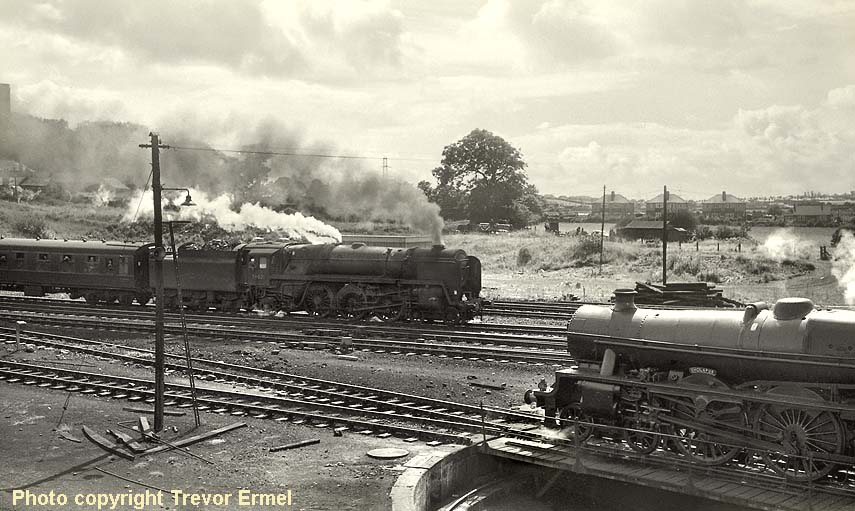
(Above) There are several interesting shots of Britannias to be found on Trevor Ermel's 'Rail Cameram' page 69 (see left-hand menu) including this one of Britannia 70021 Morning Star passing Kingmoor MPD (12A). In the foreground is a very presentable 'Jubilee' class 4-6-0 No 45593 Kolhapur which is being turned in readiness for a return working to Leeds. This Holbeck-based Jubilee had been cleaned by enthusiasts and one of their numbers had painted the name incorrectly; the wrongly-spelled nameplate can be clearly seen in this shot…the story is told on Paul Claxton's page 46...see left-hand menu. No 45593 had little time left in service, whereas the Britannia lasted until the end of 1967.
DISPOSAL: 70021 was withdrawn on Saturday 30th December 1967, stored at Carlisle Kingmoor until moved to TW Wards of Inverkeithing, where it was dismantled from 26th April 1968.
Built at Crewe and completed 16th August 1951 to order E479/220/Swindon 397 costing £20,144 and was withdrawn on the 23rd December 1967.
ALLOCATIONS: 70022 was the second of the four Britannia Pacifics to have worked from Plymouth Laira depot (83D), although the official date of 16th August 1951 is a misnomer since 70022 would have spent some time at Swindon having the ATC equipment fitted and tested before being released to traffic in the Southwest. Only eight months were spent there before transfer to Newton Abbot Shed (83A) for a period of over four years until joining the other Western Region Britannias at Cardiff Canton (86C) at the very end of 1956. In September 1961 all of the 12 Britannias at Cardiff were removed from the Western Region and 70022 was one of those moving on to Carlisle Kingmoor (12A). Following on from the Western Region service many Britannias were moved hither and thither; 70022, in quick succession, was seen to move to Longsight MPD (9A); Aston (21D); Rugby depot (2A); back to Aston in Birmingham, only to return to Carlisle Kingmoor (12A) in October 1964. Even then the Britannia only stayed six weeks before transfer to Carlisle Upperby Depot (12B) ensued, staying for slightly over two years before returning to 12A to see out its last year of revenue earning service.


(Above) Another one rolls of the production line at Crewe Works in 1951, as 70022 Tornado is awaiting entry to the Paint Shop in order that final prepping can be done before the Brunswick Green paint is applied. It seems strange to me that the nameplate is in position and also three lamps are displayed on the engine, unless someone has deliberately posed the locomotive in this way to be photographed. The image was captured by C.M. & J.M. Bentley
MODIFICATIONS: 70022 Tornado emerged from Crewe with WR-type lamp irons (item 2) and the Automatic Train Control (item 20) fitted except for the pick-up shoe at the front of the engine, which Swindon Works fitted and tested before release to traffic. The locomotive was duly delivered from Plymouth to Crewe Works to have the required axle repairs (item 17) in October 1951, although no failure had occurred, and emerged from Works eight weeks later. The sand box lids (item 16) were next to be modified, in 1952, giving better delivery of steam sanding to the drive wheels. Only the cab sheet (item 9) was added during 1953, and the following year the tender step (item 10) became a fixture on the sloping sides of the tender to assist the
 fireman when refilling with water. The exhaust ejector (item 4) was subject to much change on the Western Region Britannias, with the exception of 70021 Morning Star which never saw any change at all.
fireman when refilling with water. The exhaust ejector (item 4) was subject to much change on the Western Region Britannias, with the exception of 70021 Morning Star which never saw any change at all. As on the other 14 engines, 70022 Tornado had a solenoid valve added to the top of the unit with cabling back to the cab, to attempt to give better control to the driver over its operation; later the whole unit was lowered down the side of the boiler (driver visibility now being an issue) and following transfer away from the Western Region, the Swindon additions were removed, but with only two exceptions the exhaust ejector remained in that lower position. 70022 was one of those exceptions, the other being 70023 Venus, so that the unit regained its original placement as altered by Crewe Works in 1964. The coupling rods (item 14) were originally of the fluted variety from new, these being modified to plain type at the front and still fluted to the rear in conjunction with the axle repairs; then at some later stage, when all parts were available, plain rods were fitted throughout. That did not happen with a few of the Britannias; some retaining a mix of the rods to the end, but with 70022 all plain rods were fitted at Crewe Works in 1964. No pictures are available to me to pin down definitive dates, but I believe that the regulator rod front bracket (item 5) was fitted in September 1954 and the rear bracket (item 7) later into 1960. In the summer of 1957, 70022 underwent extensive changes at Swindon Works in the course of a General Overhaul; a modified front step (item 1) was fitted; the smoke deflectors (item 3) were altered to WR type with the six brass-lined cut-outs in each sheet; the new version of the British Railways emblem (item 11) was applied to the tender; and the pipework for the ATC unit (item 20) was now seen to be along the edge of the boiler walkway instead of attached to the engine frame, as it was from new. The Western Region type lamp irons (item 2) were changed to typical LMR irons in 1961, almost certainly by Carlisle Kingmoor MPD, although they themselves changed yet again in 1965, when the top iron was lowered for safety reasons and the centre iron was re-aligned also. The power warning plates (item 19) were rarely seen on Western Region Britannias, but were generally applied soon after transfer away, mostly in 1961 as was the case with 70022. A speedometer unit (item 13) was belatedly fitted by Crewe Works in late January 1962 and finally in 1964 the original LNER return crank was swapped for the LMSR type, recognisable by the four-stud fixing of the crank lever on the middle drive wheel.
(Below) A sight for sore eyes if ever there was one; a resplendent Britannia fresh from a Works visit. Ten modifications having been completed now since being built in 1951, including the burnished brass finishes to the handholds on the smoke deflectors, which are now without the original handrails. The image from the archives of Rod Blencowe shows 70022 Tornado at Bristol Bath Road MPD in 1957 after a Heavy General Repair at Swindon Works, on a running-in trip before returning to Cardiff depot.
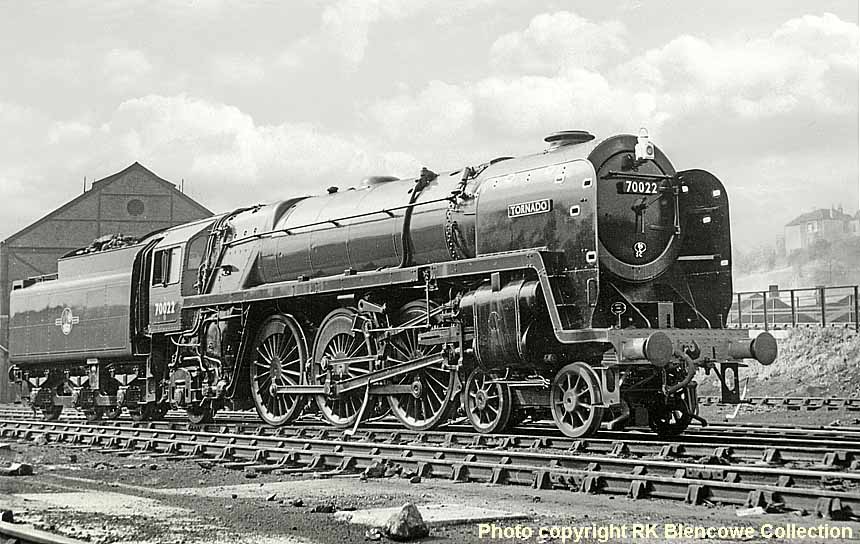
SERVICE RECORD: The recorded mileages for 70022 Tornado were far and away lower than any Britannia on the Great Eastern section, or the London Midland Region for that matter. That said the mileage figures are quite similar to that of 70024 Vulcan which had a like for like shed allocation and shows that the location of Plymouth did result in lower usage. Highest figure was 55,300 miles for 1958, dropping to a low of 25,750 in the following year; a figure adversely affected by entry to Swindon Works for General Overhaul which could last 3 to 5 months. A recorded mileage of 37,400 was returned for 1953 and very much the same for the two consecutive years. In general the locomotive was maintained by Crewe (6 visits) and Swindon (4 visits), but it is also recorded as entering Newton Abbot Works for a Light Casual schedule in June 1956, which was a rare occurrence to say the least. Probably the only titled-trains available to 70022, working from Plymouth Laira, would have been the 'Cornish Riviera Express', 'Devonian' and also 'Cornishman' which ran between Wolverhampton and Penzance, but was not initiated until June 1952. Also the Britannia would have been well used on the so-called North West route running as far as Shrewsbury with Plymouth to Liverpool or to Manchester expresses. After relocation to Cardiff Canton, the locomotive could be found on 'The Red Dragon', 'The Capitals United Express' or any of the other South Wales expresses and to the extreme credit of all the staff at Canton, the excellent condition of 70022 and the other Britannias for the London turns, was well noted by all observers. But that was in stark contrast to the general condition of the engine as noted during the latter days of service at Cardiff and thereafter. Tornado was one of four Britannias to be (unusually) shedded at Rugby depot (2A); the others being 70017 Arrow, 70023 Venus and 70024 Vulcan. These were to replace four Jubilee class engines and were on Station pilot duties and acting as standby for the mainline services which were diesel-hauled at that time; the active period was from October 1962 until February 1963, after which time the four engines returned to Aston depot (21D) in Birmingham. In 1964, 70022 Tornado was seen at Crewe in a parlous state, having suffered an axle shift resulting in broken coupling rods; a shocking mishap which was not only confined to new engines in 1951.
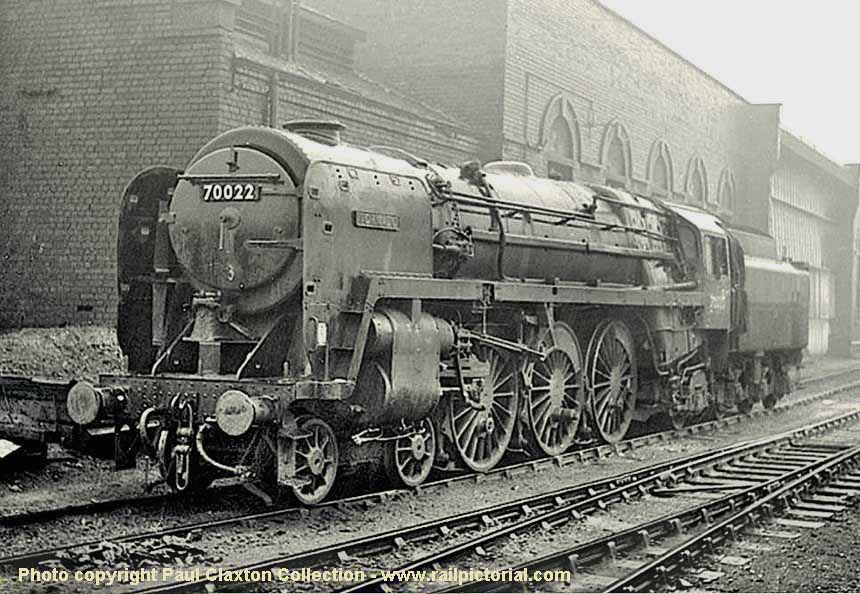
(Above) An excellent image from the Paul Claxton collection showing the catastrophic effects of a wheel shift when the locomotive is travelling at speed. This happened to seven Britannias in the first few months of service, but 70022 Tornado has succumbed to the shocking outcome of broken coupling rods and misalignment of the drive wheels in March 1964, being pictured at Crewe Works, awaiting entry for the required repair work.
SIGHTINGS: From new 70022 Tornado became a regular sight at Bristol Temple Meads Station and as such was photographed heading south with a Manchester London Road to Plymouth train; then four days later, on Wednesday the 19th September 1951, the new Britannia was seen sweeping round towards platform 10 with a Plymouth to Liverpool Lime Street express. Yet only a relatively short time after these views, in mid October the engine was espied at Crewe in rather grubby condition awaiting entry into Works for Axle repairs. In 1953 the much modified engine was captured leaving Torquay Station with 'The Devonian' service to Bradford Forster Square, which the loco would haul as far as Bristol to be relieved by a 4-6-0 Jubilee class most probably. Also the engine was photographed at Llanwern, east of Newport, heading a Plymouth to Manchester express service, train headcode '247', and seen in exceptional condition, certainly allowing for the fact that the date was November 1953 and recorded as leaving Works 6months prior. Following a Swindon Works visit, 70022 Tornado was seen at the head of 'The Capitals United Express' at Twyford Station hauling 13 coaches towards London Paddington, and on the same day in September 1957 was viewed returning to South Wales with a train for Pembroke Dock. Nearly a year later and still looking in pristine condition, 70022 was seen on 'The Red Dragon' comfortably pulling 13 coaches across the Rumney River Bridge heading yet again towards Paddington; the train was made up completely with brown and cream liveried coaches, which were used extensively during the later 1950s....sightings continued below.

(Above) An image from BKB Green, courtesy Initial Photographics, presents us with Britannia 70022 Tornado at Manchester Exchange Station having brought its train from Glasgow in June 1967. The engine is in quite reasonable condition for the period, with excellent drive wheel tyres and the exhaust ejector unit resorting to its original position halfway down the boiler.
In October 1962, Tornado was photographed in the shed yard at Rugby Midland (2A) being prepared for duty as one of the stand-by locos to cover the mainline expresses which were diesel hauled at this time, and apparently failures due to heating boilers were commonplace amongst the new fleet. Another image captures a scene which was very familiar to me, Monument Lane Station, which was situated just north of New Street Station and Tunnel, which in turn was immediately before Monument Lane Shed (2E). 70022 was pictured leaving the Birmingham suburbs for Manchester in April 1963 with an express made up with LMR stock and the locomotive was in very good order. Sometime later, in November 1965, 70022 was spotted leaving Manchester on a Football Special to Leicester, where Manchester United were playing in a Division One League match; resulting in a 5-0 win to United over City with a 19-year old George Best scoring the first goal, followed by another from the redoubtable Bobby Charlton.
DISPOSAL: After withdrawal on 23rd December 1967, 70022 was stored at Carlisle Kingmoor Viaduct yard until March 1968, and then cut up at Wards of Inverkeithing during April 1968.
Built 21st August 1951, withdrawn 30th December 1967, at the very end of British Railways steam traction. The locomotive was stored at Newton Heath Depot for 3 months before finding its way to Wards scrapyard in Killamarsh, where she was dismantled.
ALLOCATIONS: Initially to the Western Region London Division at Old Oak Common (81A), along with 70017 Arrow, 70018 Flying Dutchman, and 70020 Mercury at the London depot. This stay of over 5 years was interrupted by a brief Southern sojourn to Salisbury depot (72B) (see further ref below) as cover for the stricken Southern Pacifics, which suffered problems with cracked axles.
The next move for 70023 was onto Cardiff Canton (86C) in February 1957 to join forces with 14 other Britannia class engines, and so to bring all the Western Region Britannia locomotives together at the one depot. Thus Nos 70015 to 70029 inclusive were concentrated on the London expresses, in preference to the Castle class locomotives, that was until the King class engines came to the shed late in 1960, and they took over some turns, especially 'The Capitals United Express'.
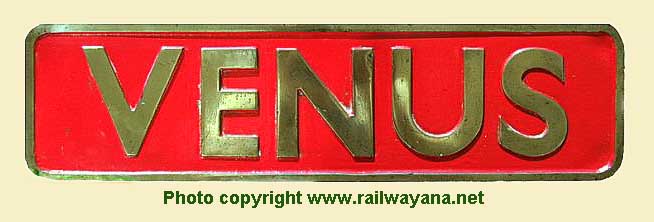
(Above-Below) A brass locomotive nameplate 'Venus', measuring just 23 inches long, from the BR Standard Class 7 No 70023 went under the hammer for £10,000 at a railwayana.net auction in November 2007...a link to the excellent website can be found at the bottom of this page. (Below) No 70023 is captured at Cardiff Canton MPD (86C), looking in fine form, and ready for another trip to London in the morning. She only arrived at Cardiff on 18th January 1957, having been at Old Oak Common (81A) previously. She is sporting the newly designed WR style Smoke Deflectors (item 3) which have six brass lined handholds on each 'sheet' deemed necessary after the Milton Accident (70026), but had to wait a further two years before the front step (item 1) was modified. Note original BR emblem, and 70019 'Lightning' in similar position just behind. Dated February 1957. Also of note the recent repairs to the roof of the straight shed done during 1955.

Eventually the Britannias, including 70023, were transferred away from the Western Region to the London Midland, in September 1961. Following four and a half years at Cardiff, 70023 was moved around a lot without spending much more than a year at any one depot, being allocated to Carlisle Kingmoor (12A) (9 months), Longsight (9A) (3 months), and Aston (21D) (1 month) up to October 1962. After this 70023 moved to Rugby (2A) for 4 months, then back to Aston (21D) for a further 7 months, before settling at Crewe North (5A) for a period of 12 months. She then moved on to Holyhead (6J) for a brief stint of 5 months, followed by a return to Crewe North (5A) for only 3 months, to Crewe South shed for 7 months, before a transfer to Llandudno (6G) came about.
There is some difference of opinion as to the next allocation for 70023, but it seems to have been back to Crewe South (5B) in April 1966, but only for 5 months, moving then to Carlisle Kingmoor (12A). This proved to be the last move; 70023 joined the swelling numbers of Pacifics at Carlisle, (all except 4 Britannias spent some time there), and was amongst the very last to be withdrawn at the end of 1967. The shed closed to steam at the same time, thus bringing to a close a massive chapter in the history of Railways in Britain.
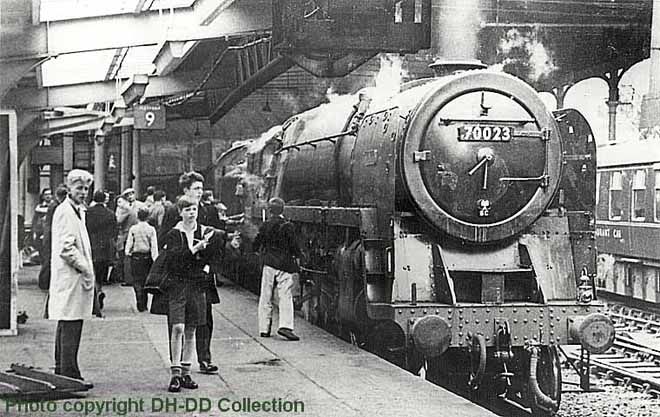
(Above) A rare 'cop' for the local spotters at Newcastle Central staion when 70023 Venus arrived on a
 running-in trip, having being 'shopped' at Doncaster Works, as Swindon could not cope at this time (July 1961). Showing off her Cardiff Canton Shedcode of 88A, she has WR lamp iron (top), SR iron (centre) and LMR irons on the buffer beam. Also of note, the front step (item 1) has an inverted support bracket, leaving a sharp (shin breaker) edge, and the WR style smoke deflectors (item 3), were the very first to be modified for the Britannias.
running-in trip, having being 'shopped' at Doncaster Works, as Swindon could not cope at this time (July 1961). Showing off her Cardiff Canton Shedcode of 88A, she has WR lamp iron (top), SR iron (centre) and LMR irons on the buffer beam. Also of note, the front step (item 1) has an inverted support bracket, leaving a sharp (shin breaker) edge, and the WR style smoke deflectors (item 3), were the very first to be modified for the Britannias.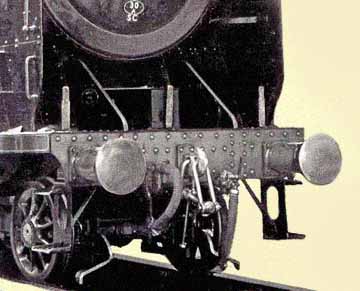 LAMP IRONS: Variation is the key word here; some Britannias stayed with only the one type of lamp iron, whereas others had many changes and additions; this included a mix of both WR types with SR versions, and even a combination of both these types plus LMR lamp irons was used, as described in the shot of 70023 (above). (Inset right) In 1955 No 70037 Hereward the Wake was fitted with long irons of a new design to suit the
LAMP IRONS: Variation is the key word here; some Britannias stayed with only the one type of lamp iron, whereas others had many changes and additions; this included a mix of both WR types with SR versions, and even a combination of both these types plus LMR lamp irons was used, as described in the shot of 70023 (above). (Inset right) In 1955 No 70037 Hereward the Wake was fitted with long irons of a new design to suit the 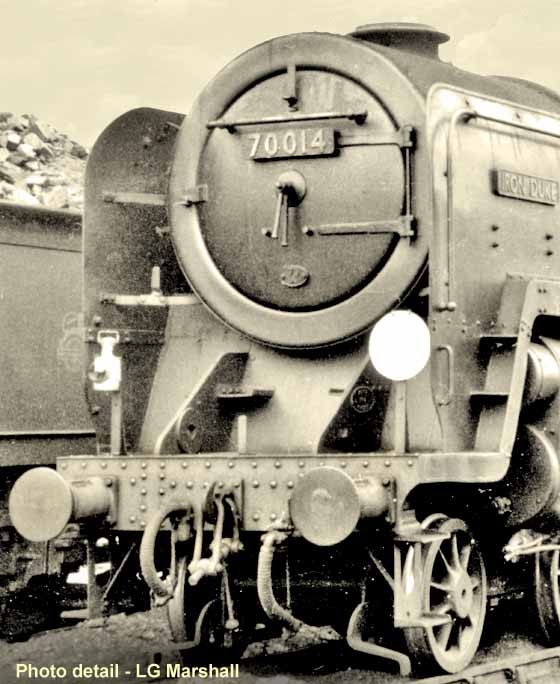 occasion of a visit to London by King Frederick of Denmark.
occasion of a visit to London by King Frederick of Denmark. (Inset left) Yet another type were the 18 inch long SR irons that were modified for 70004 and 70014 to work the 'Golden Arrow' as seen from winter 1952 until 1958, and even these changed again from 1956; an improvement was added in the form of an extra strip of metal to support the single section and form a more stable and rigid lamp iron which could be identified by a rivet just below the top section.
(Below) The normal size for GE engines was 6 inches long to accommodate the white discs. Further to this common type, was the alteration made by Immingham MPD to the outboard front irons which were reset with a step which held the headlamps more firmly and raised them a couple of inches off the buffer beam.
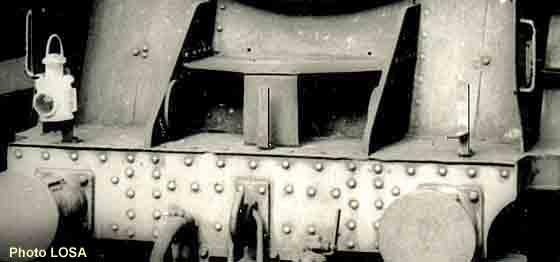
MODIFICATIONS: to start with, a correction to the general consensus of opinion that, on the Western Region engines, the ATC was added by Swindon, after the building was done at Crewe works. This is not so, and photos prove this, but I always wondered myself how could Swindon (or anybody, for that matter) fit a piping conduit from the underside of the cab, along the chassis frame and into the front of the locomotive after building had been finished. When any changes were made to the conduit, the pipe run was taken along the 'running board' and brought down to the front of the locomotive that way.
The first modification to 70023 would have been the axle repairs (item 17) and this would seem to have been done by Swindon, although not recorded as a separate job on the works list available to me, and dated December 1951. This was not urgent in respect of 70023 because she was still in service, and did not show
 any signs of breaking down. It was therefore ironic that she was chosen to be loaned to the Southern Region along with 70017, 70028, 70029, 70030 and 70034 in June 1953 to help out whilst the Southern Region Pacifics were out of service due to axle shaft cracking on some engines.
any signs of breaking down. It was therefore ironic that she was chosen to be loaned to the Southern Region along with 70017, 70028, 70029, 70030 and 70034 in June 1953 to help out whilst the Southern Region Pacifics were out of service due to axle shaft cracking on some engines. At this time 70023 was fitted with extra lamp irons (item 2) to accommodate the white discs as used on SR trains, so that 'Venus' had no less than 9 lamp irons at the front of the engine (see picture). The SR drivers soon found that the Western 'side-on' type were not compatible with their white discs, also they needed more irons to be sited halfway between the upper and lower ones, and these were bolted onto the smoke deflector lower stays of the Britannia (see photo). All the 6 engines were loaned from 26th May 1953 to 20th June 1953, except for 70030 which had gone to Dover 3 weeks earlier. At about this time, 70023 had the sand box lid (item 16) modification done, which helped drivers to fill up the containers with less spillage.
During 1953 most Britannias were having the flexible cab sheet (item 9) fitted, but I can't find any evidence that 70023 did, not until later on. The sheet, when fitted, helped to keep the draught down in the cab, which could cause coal dust to blow around inside the cabin, in addition to the obvious cold air causing discomfort to the crew.
The tender step (item 10) was to be seen after works visit in December 1954, this giving some safety to the fireman when adding water to the tender, and was of the type used by the LMR (see notes above), because Crewe Works did the overhaul at this time.
(Below) The smoke deflectors (item 3) were modified to the Swindon specifications when 70023 received a Heavy Intermediate repair at Swindon Works from September 1956 to January 1957, and in fact was the very first to be altered, even before 70026 Polar Star, this being the engine involved in the fatal crash that prompted the removal of the 'dangerous handrails'. Also at this time Swindon made changes to the Exhaust Ejector (item 4) to try to gain better control over the unit and improve steaming of the engine. This alteration can be seen as a valve fitted atop of the Ejector unit, and has a cable attached which is routed back to the cabin.
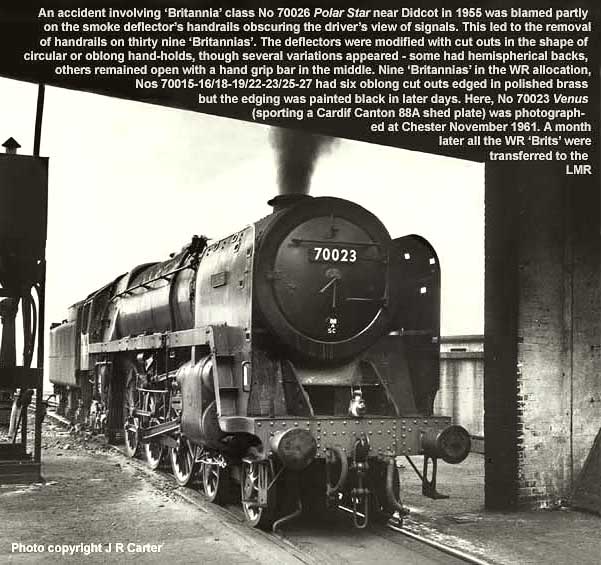
The front step (item 1) modification was not carried out on 70023 until the next Heavy Intermediate repair, dated from the very last day of 1958 until April 1959, so that she could be seen with smoke deflector modification and original front step for almost two years, and also was one of only 3 engines that had the step altered following the change to the deflectors.
The Exhaust Ejector (item 4) was seen, at a later date, in a lower position because the solenoid valve that had been added to the unit was now obstructing the driver's view forward, and again this was changed on almost all the Western Britannias (a total of 15 engines) in due course. At this same date the new British Railways Logo was applied to the tender, a fully 3 years after it appeared on 70016 Ariel, again showing that the class of the Standard Britannias were anything but - the last to be so treated was 70004 William Shakespeare in 1964!
When 70023 was transferred away from the Western Region, the ATC equipment was removed, but she was one of 12 engines that did not receive the AWS (British Railways version) for automatic braking. Also noticeable was that 70023 was not equipped with a speedometer, not ever in her career, yet they were fitted new on the third batch of Britannias, 70045-54, from 1954. Final modification to 70023 was the LMS Return Crank (item 15) which replaced the original LNER type, when going through Crewe Works in April 1963, this came about after the minor addition of the power warning plates (item 19) and the resetting of the lamp irons (item 2) on the front of the engine, dated 1960-1961.
SIGHTINGS: 70023 Venus would have been employed on Western Mainline express trains from the start of her career at Old Oak Common MPD (81A), including the 'Cornish Riviera', 'Torbay Express' and also the famous 'Bristolian' as well as overnight Newspaper trains to South Wales, or Boat trains to Plymouth.
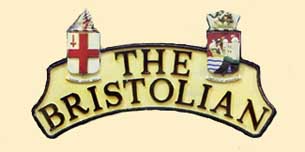 70023 was seen on 'The Bristolian' in September 1952 moving away from Bath, but rather strangely she was seen hauling a goods train down the Midland Main line at Bedford early in 1952! This was a test train double-headed with 70020 'Mercury' with a Dynamometer coach and 1,200 tons of wagons trailing behind, I believe that this was to measure performance as well as braking effort, organized by Rugby Test Station, and at much the same time as the testing with 70005 'John Milton' over the Settle Route.
70023 was seen on 'The Bristolian' in September 1952 moving away from Bath, but rather strangely she was seen hauling a goods train down the Midland Main line at Bedford early in 1952! This was a test train double-headed with 70020 'Mercury' with a Dynamometer coach and 1,200 tons of wagons trailing behind, I believe that this was to measure performance as well as braking effort, organized by Rugby Test Station, and at much the same time as the testing with 70005 'John Milton' over the Settle Route. After moving on to Cardiff Canton (86C), she would have been gainfully employed on such trains as 'The Red Dragon', the 'Capitals United Express' and the 'Pembroke Coast Express', as well as the 'South Wales Pullman', and as usual any locomotive on a London turn would be cleaned like the proverbial 'new pin'.
She could also be seen on West and North train services to Crewe and Manchester, or a Cardiff to Portsmouth turn, as seen in April 1958 at Bathampton, hauling the 09.30am from Cardiff train. Also seen at Newport High Street, dated May 1960, with train headcode '048' going on towards London. 70023 was also spotted in May 1958 hauling the
 'Capitals United Express' at Twyford, with gleaming paintwork, and pulling along 13 chocolate and cream coaches on her way to London Paddington. After all this top-link work 70023 was allocated to Aston MPD in the Birmingham area, during September 1961, and her duties could be varied, but mainly on passenger turns, such as a Summer Saturday holiday express to North Wales, as seen in July 1963, and also in commendably clean condition. This was just before a further move, onto Crewe North, from where she would mainly be seen on the West Coast Main line, with a mixture of passenger, parcel and freight turns, and also subject to a ban south of Crewe Station. In October 1967 she was photographed at Leeds City Station, having arrived on a Manchester to York train; she was without nameplates, of course, but still in reasonable condition, at this rather late stage.
'Capitals United Express' at Twyford, with gleaming paintwork, and pulling along 13 chocolate and cream coaches on her way to London Paddington. After all this top-link work 70023 was allocated to Aston MPD in the Birmingham area, during September 1961, and her duties could be varied, but mainly on passenger turns, such as a Summer Saturday holiday express to North Wales, as seen in July 1963, and also in commendably clean condition. This was just before a further move, onto Crewe North, from where she would mainly be seen on the West Coast Main line, with a mixture of passenger, parcel and freight turns, and also subject to a ban south of Crewe Station. In October 1967 she was photographed at Leeds City Station, having arrived on a Manchester to York train; she was without nameplates, of course, but still in reasonable condition, at this rather late stage.(Below) Another classic shot by Trevor Ermel...'Black Fives' and 'Britannias' featured strongly during his travels in the North-west during 1967, with most of his journeys starting or ending at Carlisle. On 5th August, for example, he headed south behind D1631 to Oxenholme, to await the 11.55 Euston to Carlisle train, steam-hauled from Crewe, with the aim of having his first run behind steam over Shap. Trevor had purchased a North West Runabout Rover ticket between Preston and Carlisle, and after his trip from Preston behind 'Britannia' No 70025 (Western Star) on a Fridays-only Liverpool to Glasgow express, he travelled on the same train two weeks later. This time he joined the train at Penrith with No 70023 (Venus) in charge - and judging from his picture (below) after arrival at Carlisle, not many other enthusiasts made the same journey.
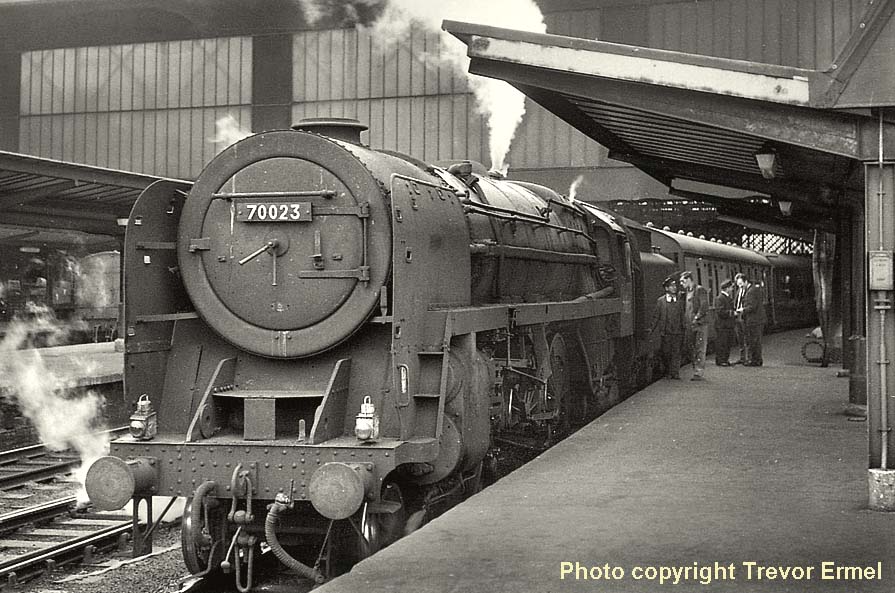
(Above) BR's down-at-heel steam fleet was an all too familiar sight in 1967; a grubby Britannia with no nameplates, no shedcode, sometimes no numberplate, or, as seen here, a false 70023 numberplate. Trevor Ermel's photo is appreciated by me for its historical interest alone; it demonstrates the extent to which the BR Standard Class 7MT locos had deviated from being standard. Looking firstly at the front (item 2); we have a long lamp iron on the left, a short lamp iron (middle) and a Southern Region lamp iron bolted to the lower stay of the nearside smoke deflector, this being fitted by the SR in 1953. There was also a SR iron on the offside, but the stay on that side has been changed (no bolt holes) circa 1961-1962. The front step (item 1) has now been corrected by reverting the support (see 70023 at Newcastle above), and the Exhaust Ejector (item 4) has been repositioned to its original position by Crewe Works during April 1963. No AWS (item 20) was ever fitted to 70023, nor did she receive a speedometer (item 13); this was common amongst the ex-Western Region engines.
Programme authorised 17th November 1949, built at Crewe and completed 6th October 1951 to order E479/220/Swindon 397 costing £20,144 and was withdrawn on the 30th December 1967. The additional part of the order number refers to the fitting of Western Region lamp irons and the Automatic Train Control equipment with in-frame pipework; this raised the cost of construction slightly.
(Below) Ian Turnbull recorded this scene of Plymouth Laira's (83D) 70024 Vulcan at Old Oak Common in London; the driver is waiting for clearance to move towards Old Oak depot with an ECS working. The photo was taken adjacent to the LNWR West London loop line to the east of Scrubs Lane Bridge; just visible behind 70024's front end, the loop is occupied by a train on the rising gradient to gain access to the departure side of Paddington Station. Beyond the reinforced wall in the background is the Grand Union Canal where the water level is about 8 foot above the railway.


(Above-Below) This unusual angle of locomotives in the yard at Cardiff Canton in April 1960, allows us to pick out more detail than normal. BKB Green has used the substantial footbridge to record this scene of BR Standards 70022 Tornado and 70024 Vulcan, along with ex-GWR Castle Class 5095 Barbury Castle, another resident at that time. The partial image of 70024 provides a very good view of the exhaust ejector with added solenoid and lowered from its original position; also the run of the pipework for the ATC from the battery box under the cab along the walkway to the pick-up shoe sited on the front bogie axle. (Below) What a special sight it must have been to view a freshly overhauled Britannia intermingled with Great Western types. This was a regular occurrence throughout the 1950s and early 1960s at Cardiff Canton MPD, where the staff and crew took great care in preparing their allocation of Pacific engines for the prestigious South Wales top-link expresses. Here we see an exceptionally clean and sparkling ten year-old Class 7 No 70024 Vulcan with the boiler and wheels reflecting the low-light, as captured in this May 1961 photograph from the superb Stephenson Locomotive Society archives.
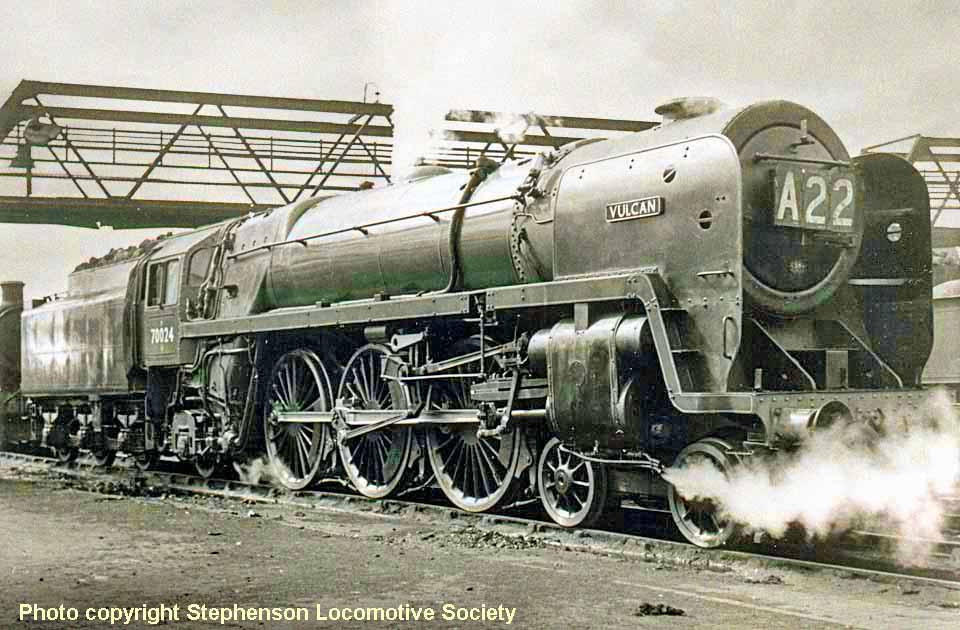
ALLOCATIONS: 70024 Vulcan was the fourth of the five Britannia Pacifics to have worked from Plymouth Laira depot (83D), although the official date of 31st October 1951 reflects the time the engine spent at Crewe undergoing stringent tests and running-in, also at Swindon having the ATC pick-up shoe fitted and tested before being released to traffic in the Southwest. Apart from a month at Exmouth Junction (see Service Record below) the engine spent over five years at Plymouth before joining the other WR Britannias at Cardiff Canton depot (86C) at the end of December 1956, forming a pool of 15 Pacifics. On leaving the WR in September 1961, 70024, in quick succession, was seen to move to Aston (21D); Rugby depot (2A); back to Aston in Birmingham, then to Willesden (1A) followed by a spell at Crewe North (5A) and Holyhead (6J); then back to Crewe North (5A). The next allocation was Crewe South (5B) followed by Llandudno Junction, before returning to Crewe South (5B) where it stayed for just sixteen weeks before transfer to Carlisle Upperby Depot (12B) for a period of four months, then to Carlisle Kingmoor (12A) for the final twelve months.
MODIFICATIONS: 70024 Vulcan was one of the engines to suffer failure of the coupling rods due to axle shift; the Britannia barely had time to notch up 2,000 miles before entering Swindon Works for the modification (item 17) to be carried out. The coupling rods (item 14) were refitted as a mix of types, with a plain type at the front and fluted variety to the rear of the engine; this was the normal treatment, except in 70024's case the rods were not upgraded to all plain rods and remained that way right the way up to withdrawal in 1967. The Britannia found its way to Swindon Works early in 1954 to be fitted with a large upright dome on the tender atop of the water scoop; also the raised sand box lids (item 16) were added, two on each side and the support bracket (item 5) was added to the front regulator operating rod. The flexible cab sheets (item 9) were added when the Britannia visited Crewe Works in February 1955, as were the tender steps (item 10) which were of the LMS type. Later in 1955 70024 entered Swindon Workshops to have the exhaust ejector unit (item 4) - situated just behind the nearside smoke deflector - fitted with a solenoid valve and operating cable running back to the cab. Following transfer to Cardiff Canton depot, 70024 was booked into Crewe Works and received a major overhaul, including a full front step (item 1); the LNER return crank (item 15) was changed to the LMS type; the new type of BR emblem (item 11) added to the tender and the steady bracket (item 7) was added to the rear regulator operating rod. It was interesting to note that the support for the front step was inverted, leaving a sharp edge to encounter; also the tender step was of LMS design, but this later changed to WR style when the tender was swopped with that of 70023 'Venus' from November 1958, prior to entering Swindon Works for scheduled maintenance. During the visit the smoke deflectors (item 3) were changed to type LMR 2, showing two plain cut-outs in each sheet, this being the last Britannia to be so treated; also 70024 had the nearside lubrication operating rod (item 18) shortened and the exhaust ejector unit (item 4) was lowered from its original position, with Swindon citing that the driver's view forward was adversely affected. The engine was not altered in any way for the next two years of service, except for the support to the front step (item 1) being fitted in the correct position, altered by Swindon in April 1961. On leaving the Western Region in September 1961, 70024 'Vulcan' was stripped of the ATC equipment including battery box and all pipework, also the solenoid valve from the exhaust ejector unit (item 4). 70024 never did receive the AWS system (LMR's version), being one of fourteen Britannias untreated, which seemed an unusual omission for an express passenger type; also the engine was not fitted with a speedometer unit (item 13) and in fact only three ex-WR Britannias were seen with a speedometer in service. Power warning plates (item 19) were added by Aston depot (21D) in September 1961, but the Western Region lamp irons remained for a while longer until removed in 1963 and then repositioned later in 1964, when the engine was repainted, but without any lining to its livery (item 12) at all. The lamp irons were a mix of long and short LMS types, while the nameplates were removed during the early part of 1965.
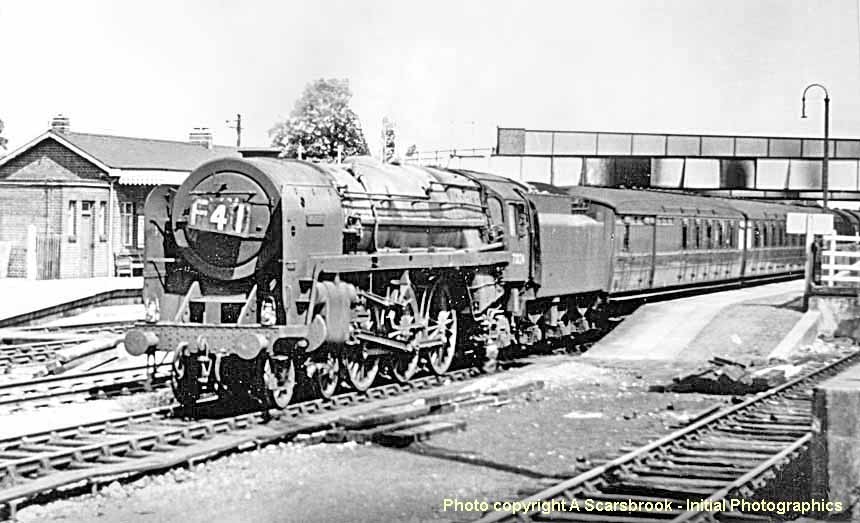
(Above-Below) The gently rising gradient between Reading and Swindon is part of the original GWR Main Line. Here we see 'Britannia' No 70024 Vulcan heading a Paddington-Swansea express through the country station at Challow between Wantage Road and Uffington stations in Oxfordshire; the coaching stock appears to be mostly Gresley dark teak LNER stock, which tended to be seen on the North to West routes. Photo by A. Scarsbrook for Initial Photographics. (Below) We are again grateful to Rod Blencowe for this small piece of history: with its glory days at Cardiff Canton now over, BR Standard Pacific No 70024 Vulcan languishes at Banbury depot (84C) on its protracted journey to Aston MPD in Birmingham during September 1961. The WR have removed the ATC safety equipment and the solenoid from the exhaust ejector just behind the smoke deflector, and allowed the engine to deteriorate rapidly from the splendid condition of just 3 months ago. The locomotive shows signs of the recent use of lubricating oil on the regulator rodding, suggesting some storage time in the open.
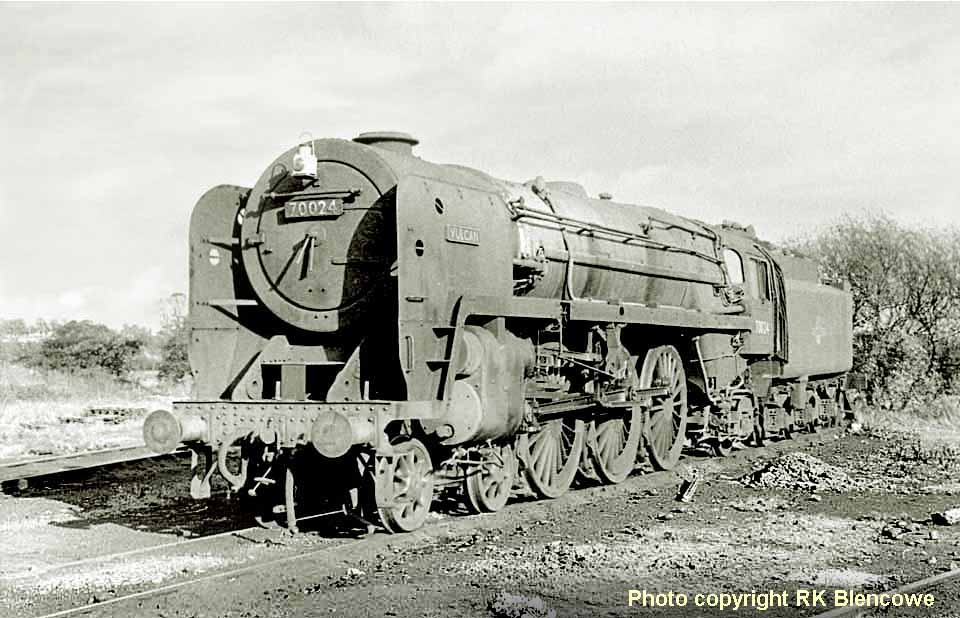
SERVICE RECORD: The new Britannia was tried and tested on the top express turns from the Southwest, including the 'Cornishman' and the 'Cornish Riviera', but was not accepted by many crews, partly because of the fact that the cab layout was set for left-hand drive; this was contrary to WR tradition and made the sighting of certain signals awkward for drivers. It was reported that early in 1952 No 70024 did undergo weld repairs to the horn-guides, which allowed the drive axles to move vertically, however the repair does not appear on the record, but it would seem to be as a result of the previous axle shifting problem. Ironically, 70024 'Vulcan' was one of the Britannias loaned to the Southern Region for a short period to cover for the SR Pacifics which had also to be taken out of service due to suspect axles; 70024 was chosen to operate from Exmouth Junction, which in the event lasted only from 26th May to the 20th June 1953. Also the engine was used quite extensively on the Plymouth to Manchester trains, with engine changes taking place at Shrewsbury. After being transferred to Cardiff Canton depot in South Wales, 70024 was well used on the 'Red Dragon' and the 'Capitals United Express' which ran between Cardiff and London Paddington. 70024 was one of four Britannias to be (unusually) shedded at Rugby depot (2A); the others being 70017 'Arrow', 70022 'Tornado' and 70023 'Venus'. These were to replace four Jubilee class engines on station pilot duties plus they acted as standby locomotives in the event of failures on the mainline services which were diesel-hauled at that time; the active period was from October 1962 until February 1963 in what was then a very long arduous winter, after which time the four engines returned to Aston depot (21D) in Birmingham. The locomotive entered Swindon Workshops on at least six occasions for repairs and was recorded as visited Crewe Works three times for major rectification. Recorded mileages were most definitely low, mainly due to the lack of opportunity while working from Plymouth Laira depot, but this increased after relocation to Cardiff Canton and then dropped back again from 1962 onwards. Highest recorded figure was 63,500 miles for 1959 which covered the ten months from the end of February, following repairs, but the average was 40,000 over the other years up to 1962.
(Below) Aston depot in Birmingham received 80% of the WR Britannia stock and made good use of their first Pacific engines, many of them being utilised on Northwest turns; as captured here by Raymond Keeley. BR Standard 70024 Vulcan passes through Salford Station with a westbound parcels train in April 1962. The engine displays some highlights on the smokebox door, including the (21D) shedcode, reflecting some detailed attention by the shed staff.

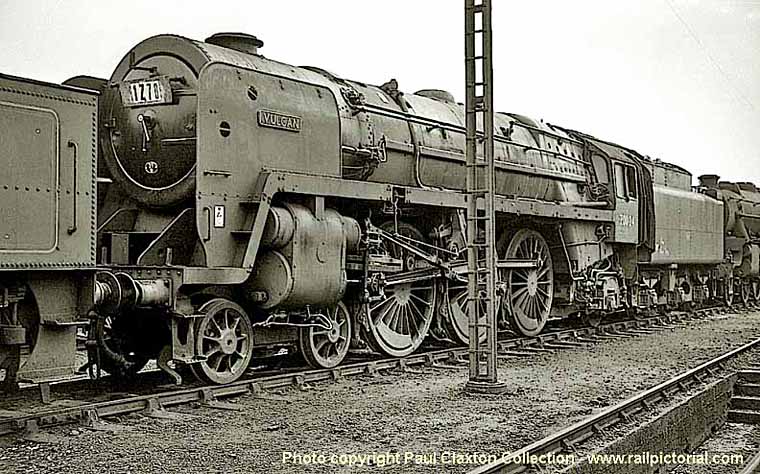
(Above) The dazzling display of illuminations along the seafront at Blackpool have been a star attraction from as far back as 1879; the spectacle literally lights up the Fylde coast's premier resort for 66 days each autumn. Prior to the onset of the motor car into people's lives, many extra trains were rostered to cope with the huge influx of visitors to the resort. Having hauled an excursion from Birmingham in October 1961, BR Standard 70024 Vulcan of Aston (21D) was captured at Blackpool North shed by local photographer Paul Claxton. Click HERE to visit Mike Claxton's brilliant 'Rail Pictorial', a website dedicated to the memory of his brother Paul, who sadly passed away in April 2009. Rarely have I see such quality and in such high numbers on one website…a visit is highly recommended.
 (Inset-Below) SANDING EQUIPMENT: Had it not been for the introduction of steam sanding in 1886, the numerous large single-wheel express engines of that era would not have been able to operate. Early production Britannia engines had two sand boxes on each side of the boiler, but these did not give the desired results. This was due to the type of sand used (apparently) and the fact that the forward box had to deliver to the front of the first and second axle, involving a difficult route, while the rear sand box was well positioned to deliver to the rear of the middle axle (for
(Inset-Below) SANDING EQUIPMENT: Had it not been for the introduction of steam sanding in 1886, the numerous large single-wheel express engines of that era would not have been able to operate. Early production Britannia engines had two sand boxes on each side of the boiler, but these did not give the desired results. This was due to the type of sand used (apparently) and the fact that the forward box had to deliver to the front of the first and second axle, involving a difficult route, while the rear sand box was well positioned to deliver to the rear of the middle axle (for 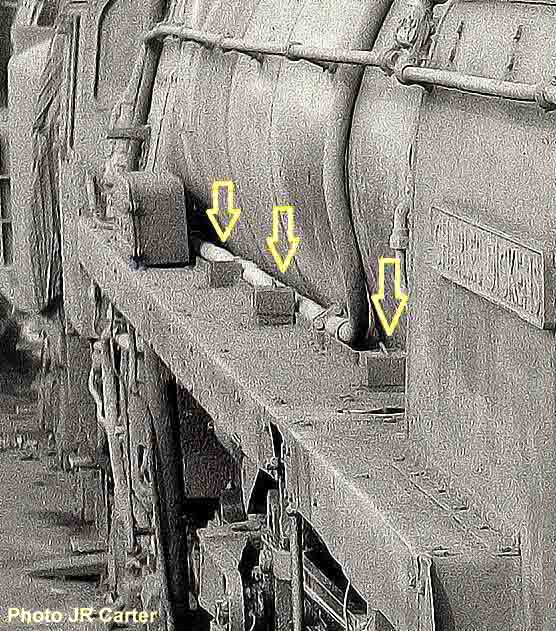 reverse running) and to the front of the third drive axle. Three sand boxes were therefore fitted from No 70030 onwards giving better routing and better results. Also all the lids were raised to show the distinctive square box finish on new production locos, while most of those already in service were modified to show two raised boxes each side.
reverse running) and to the front of the third drive axle. Three sand boxes were therefore fitted from No 70030 onwards giving better routing and better results. Also all the lids were raised to show the distinctive square box finish on new production locos, while most of those already in service were modified to show two raised boxes each side. Of the first fourteen Britannias only 70004 had the changes applied, while the lids of Nos 70000-70003 and 70005-70013 remained level with the boiler walkway throughout their service history, thus setting these engines apart from the rest of the class.
To sum up; thirteen engines had no raised sand boxes; twelve began without, but were modified from 1953 to show 2 raised versions; five were built with 2 raised boxes and the remaining 25 engines were all constructed with 3 raised sand boxes each side. The only further change to the norm was No 70027 Rising Star which Swindon modified with a metal surround to each of the four raised lids, presumably to retain any spillages, and this remained in place until May 1961. The alignment of the third raised sand box lid in relation to the other two can be seen in this shot (insert right) of 70033 Charles Dickens.
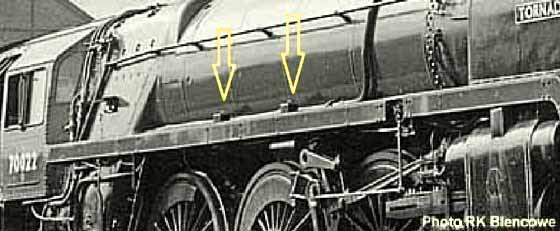
SIGHTINGS: No early views have emerged, but 70024 Vulcan was pictured hauling a Penzance to Plymouth local train (Sundays) across Isambard Kingdom Brunel's Royal Albert Bridge spanning the River Tamar at Saltash in April 1954, the driver having just handed over the single line key. In May 1955, Blackford Viaduct near Cornwood in the Plymouth area of Devon was the scene for 'Vulcan' hauling a lightweight Penzance to Paddington express made up of six carriages, child's play for the powerful Britannia. After moving to Cardiff, 70024 Vulcan became a regular on the 'Red Dragon' and was viewed in the delightfully picturesque setting of Sonning Cutting near Woodley, just east of Reading. The tree-lined embankments presented cameramen with an ideal backdrop to photograph the chocolate and cream coloured coaches being hauled by a resplendent Britannia, caringly prepared by the staff at Canton depot. 70024 was also seen ready to leave Paddington Station with the 'Red Dragon' express for South Wales, still sporting the original smoke deflectors and carrying the ornate headboard along with the train identification number of '173' where the figure '1' indicated the train was from London. During April 1959, the Britannia was photographed at Stockley, near Devizes in Wiltshire, hauling the 'Red Dragon' yet again, but on this occasion the immaculate engine was showing a train identification number of '066' whereas the usual number for the 'up' express was '720' with the figure '7' representing a train from South Wales, also the smoke deflectors had been modified to LMR 2 type. A little over two years later 70024 was viewed at the head of the 'Capitals United Express' leaving St. Mellons West, between Cardiff and Newport. The headboard was a large affair with the English and Welsh emblems prominent on either side of the title and the train identification number was 'F55'. In the summer of 1964, 70024 Vulcan was overhauled at Crewe Works and seen shortly after at Kirkham on the Preston-Blackpool route with a train from Chilvers Coton, close to Nuneaton in the East Midlands. The engine had no speedometer or AWS equipment fitted, but the topmost lamp iron had been repositioned for the safety of crews when working in the vicinity of overhead wires on the WCML and the exhaust ejector unit was still in the lower position. 70024 was also seen hauling a parcels train towards Yorkshire on the Micklehurst Loop from Stalybridge to Diggle in May 1966. Then nearing its final days, and looking in a considerably poor state, the nameless 70024 was captured on the climb to Shap at Thrimby woods at the head of an afternoon southbound freight.
(Below) Extensive work began on the modernisation of London Euston Station in the summer of 1962, so at the time this photograph was taken of 'Britannia' 70024 Vulcan in November 1963, many platforms were out of use and broken up completely. The locomotive was now a resident of Crewe North depot and is showing a 'light engine' headcode prior to moving off platform 8 to be serviced at Willesden; Camden 1B had closed two months prior.
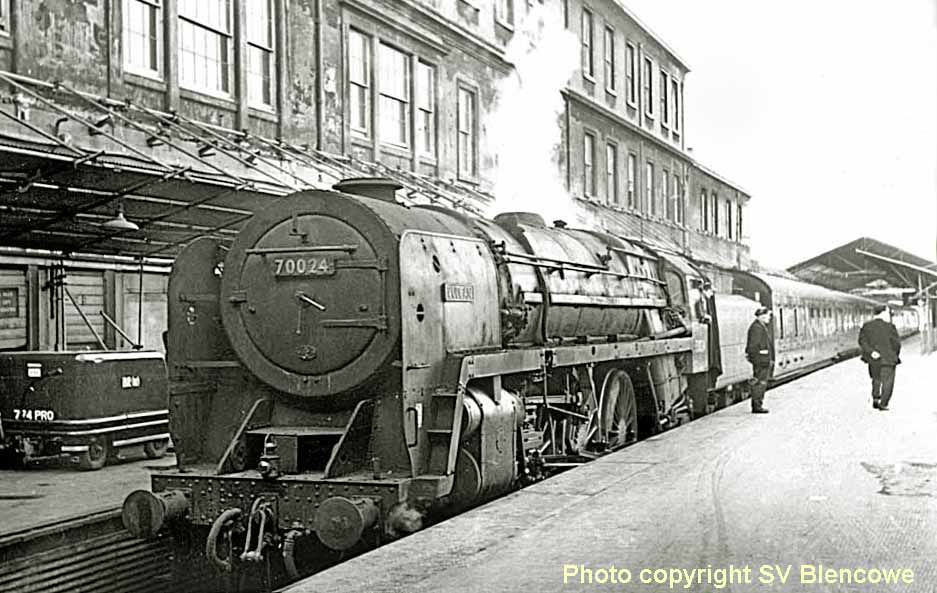

(Above) Colin Stacey's photo of Carlisle Upperby shed yard in July 1966 shows a distinctly soot-encrusted Britannia Pacific No 70024, formerly named 'Vulcan', coaled and ready for another day's work, but having just six months left in service. Three items of note; no cab sheet fitted; no AWS attached and still showing a mix of coupling rods, one plain and the other fluted. The ex-Scottish Region depot was formerly an eleven track straight shed which was later replaced by a concrete open roundhouse structure in 1958.
DISPOSAL: Withdrawal took place on Saturday 30th December 1967 from Speke Junction; the engine was stored until March 1968, and then transferred to T.W.Ward of Killamarsh for cutting up in April 1968. (Under construction)
1. FRONT STEP; 2. LAMP IRONS; 3. SMOKE DEFLECTORS; 4. EXHAUST EJECTOR MOD; 5. FRONT REGULATOR ROD SUPPORT BRACKET; 6. DOME COVER; 7. REAR REGULATOR ROD SUPPORT BRACKET; 8. REVERSE ROD RETURN SPRING COVER; 9. CAB SHEET MOD; 10.TENDER STEP; 11.NEW BR TOTEM; 12.LIVERY; 13.SPEEDOMETER; 14.COUPLING RODS; 15.LNER-LMSR RETURN CRANK; 16.SANDBOX LIDS; 17.AXLE; 18.LUBRICATION PUMP OPERATING ROD; 19.POWER WARNING FLASHES; 20.ATC/AWS and 21.VACUUM PIPE.
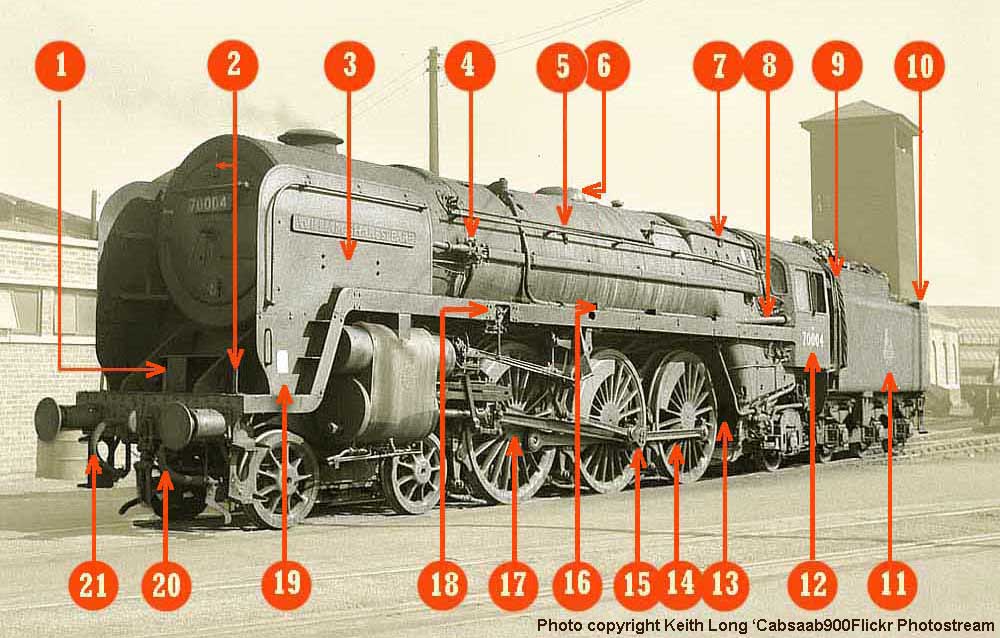
(Below) In all fairness to 'Rail Camerman' Keith Long, here is the original photo of 'Britannia' Class 7MT No 70004 William Shakespeare at Willesden shed on 16th September 1961. Built at Crewe Works and delivered in March 1951, 70004 was exhibited at the Festival of Britain, then allocated to Stewarts Lane until 1958; she worked the 'Golden Arrow' on a regular basis and continued to carry the fixing bolt holes for the ornamental arrow in her smoke deflectors until early in 1965 when accident damage to the offside smoke deflector meant that a new sheet and stays were fitted at Darlington Works. After leaving the SR she spent time at Trafford Park, Willesden, Crewe North and Stockport until been allocated to her final shed at Kingmoor in 1967. Withdrawn in December 1967 she was scrapped at TW Ward of Inverkeithing in April 1968...check out Keith Long's superb 'Rail Camerman' Page 47 on the left-hand menu.
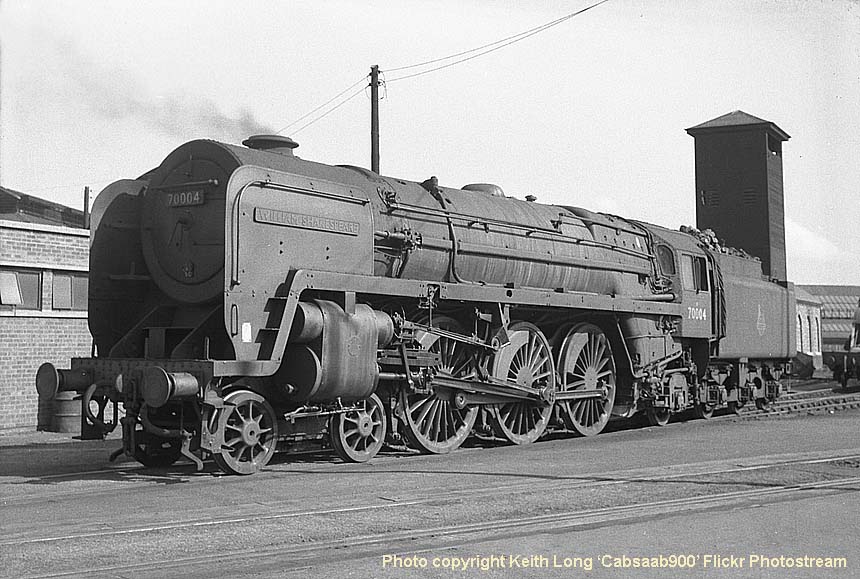
This page also features photographs supplied by Stewart Blencowe, who has a superb archive of black & white postcard-sized photographs of locomotives from both the pre-Grouping and 'Big Four' eras. Many pictures are from his own negative collection and can only be purchased direct from him, either by visiting his website HERE or via selected railway book fairs, auctions and Open Days…Stewart has more than forty years of successful trading in all manner of railway items from secondhand books, photos and timetables to ephemera and railway minutia, relics, tape recordings models and miscellania. Postcard size prints can be ordered at £1.50 each including packing and postage.
Stewart's email address is - stewart.blencowe@btopenworld.com - Please note this is not a 'clickable' link via Outlook Express...you will have to email manually.
This page also features a number of BR Class 7 'Britannia' photographs selected from the superb photographic archive of Initial Photographics - the contact address is shown below…
Initial Photographics (C Stacey) 25 The Limes, Stony Stratford, Milton Keynes, MK11 1ET
The superb Transport Treasury collection of railway photographs is a privately owned archive of images comprising over 300,000 photographic negatives and transparencies and is operated by Barry and Janet Hoper who provide railway, bus, and tram photographs for publishers and enthusiasts. The company produces traditional photographs, hand-printed in a conventional darkroom. The Transport Treasury's huge archive of high-quality original negatives and slides are entrusted to the company by like-minded railway and transport enthusiasts…a visit to the superb website HERE is highly recommended.
Colour-Rail is one of the premier sources of high quality images of road and railway transport, available in a range of formats including online downloads, high quality photographic prints, duplicate slides and in large format pictures for gifts. The Colour-Rail archive contains photos of steam, diesel and electric trains as well as buses, trams and trolleybuses in both colour and black & white, from 1900 to the present day. Click HERE to visit the Colour Rail website containing photographs of stations, signal boxes, tunnels and bridges as well as glimpses of contemporary cars and fashions…a priceless record of times gone by.
The 'Rail Photoprints' photographic archive is of primary interest to railway enthusiasts, but you'll be surprised by what you will find, with some images dating back to 1923 in the files. All photographs are reproduced using modern digital 'wet' production processes on Fuji crystal archive paper. The images are scanned to an image size of A4 (roughly 12ins x 8ins) at 300dpi suitable for both photo and traditional print production. Click HERE to visit the 'Rail Photoprints' website.
Several railway photos on this page were taken by the late Paul Claxton. They are reproduced here courtesy of Mike Claxton, proprietor of www.railpictorial.com. This is a superb site created by Mike in memory of his younger brother Paul, who sadly passed away in April, 2009. I'm sure Paul's photos will connect with everyone and a visit to Mike's site here is highly recommended.
Meanwhile, I continue to seek photos of BR Standard Class 'Britannias' to illustrate this page. All photos published will be treated with the utmost respect and include a copyright notice identifying the owner. If you have suitable photos for this page please contact the email address at the foot of the page.
Other links to the excellent websites which have contributed to this page...
Railwayana.net.....................................click here
Polite notice: All text and photographs are protected by copyright and reproduction is prohibited without the prior consent of the © owners. If you wish to discuss using the contents of this page the email address is below. Please note - this is not a 'clickable' mail-to link via Outlook Express. You will have to email manually.
britclass7@hotmail.co.uk
dheycollection@ntlworld.com




